
- Best Hikes In The World
- Appalachian Trail
- European Hikes
- Nepal Hikes
- Patagonia Hikes
- See All Hikes
- Mount Kenya
- Mount Kilimanjaro
- Mount Toubkal
- See All Mountains
- South Africa
- New Zealand
- Switzerland
- United Kingdom
- Packing Lists

Annapurna Circuit – Nepal’s Classic Circuit Trek
Asia , Hikes , Nepal
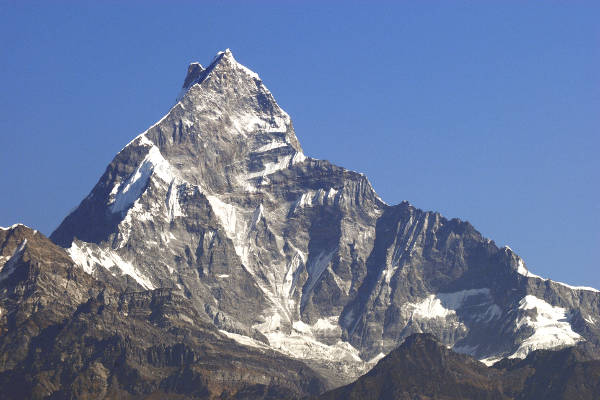
The Annapurna Circuit is one of the most popular and most epic treks in Nepal . This classic trek meanders through Himalayan foothills and over high passes, offering picturesque mountain views along the way.
Annapurna Circuit Trek
Route overview.
The Annapurna Circuit is one of the greatest treks in Nepal, if not the world.
Although road construction over the past two decades has severely impacted the trekking experience (more on this later).
Note: if you are a mountain biker, the road on the western side makes for one of the most exhilarating and scenic mountain biking experiences!
Where Does The Annapurna Circuit Start and End?
The trek begins at Besisahar (which is a 7-8 hour drive from Kathmandu) and concludes in the Kali Gandaki Gorge – the disputed highest gorge in the world that separates Dhaulagiri (8,176 meters) in the West and Annapurna (8,091 meters) in the East.
The circuit is traditionally followed on an anti-clockwise trail – for acclimatization reasons – that circumvents the Annapurna Massif. It takes trekkers through the Annapurna, Manang and Mustang region of central Nepal.
Route Details
At its pinnacle, the trek crosses the Thorung La Pass (5,416 meters) before descending down to the town of Muktinath. From here the road construction activities (2004 -2008/09) have had a measurable impact on the Annapurna Circuit trekking experience.
The Nepalese government have realized that the road on both the Western (Pokhara-Muktinath) and Eastern (Chame-Manang) side of the circuit has had a negative impact on trekking tourism. Thus, they have created a number of New Annapurna Trekking Trails (called NATT-trails).
These NATT-trails, marked blue and white or red and white, take trekkers away from the dusty and unpleasant roads. The alternative routes provide a much more pleasant trekking experience.
How Long Is The Annapurna Circuit?
The Annapurna circuit typically takes between 16-20 days to complete. This is depending if you decide to tack on a diversion to Annapurna Base Camp and the Annapurna Sanctuary ). It covers between 150-240 km depending on when you decide to end the tour or use transportation vehicles.
Scenery and Landscape
The scenery on the Annapurna Circuit is extraordinarily beautiful. Trekkers pass through rice terraced paddy fields, subtropical forests, and glacial environments.
You will see a number of major mountains including the Annapurna Massif (I-IV), three 8,000 metre peaks – Dhaulagiri (8,176 meters), Manaslu (8,156 meters) and Annapurna I (8,091 meters). There are numerous other peaks of 6,000 to 7,000 meters.
Please Note: The Annapurna Circuit is situated in the Annapurna and Mustang regions of central Nepal. It is home to the Annapurna Massif. The schematic below illustrates Nepal’s trekking regions (not to scale).
Annapurna Regional Map
The Annapurna Circuit is situated in the Annapurna and Mustang regions of central Nepal. It is home to the Annapurna Massif. The schematic illustrates Nepal’s trekking regions (not to scale)
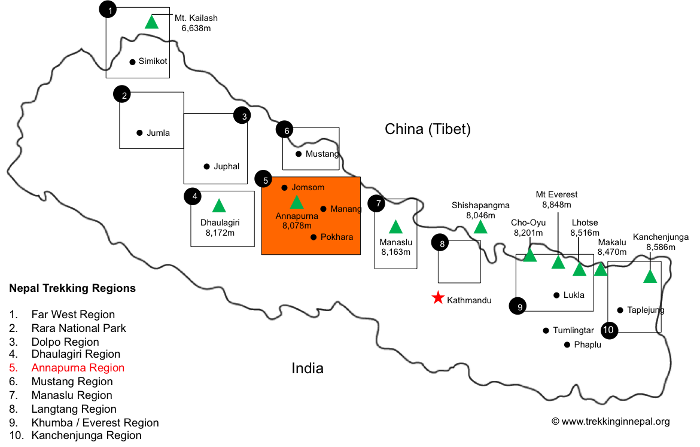
Annapurna Trek Altitude Profile
The schematic diagram below shows the route altitude profile for the Annapurna Circuit.

Annapurna Circuit Itinerary
Below is a detailed Annapurna Circuit itinerary. Where possible we have highlighted the NATT-Trails that can be used to avoid the road. Please note that this is a typical Annapurna Circuit itinerary. Some tour operators offer variations on this route.
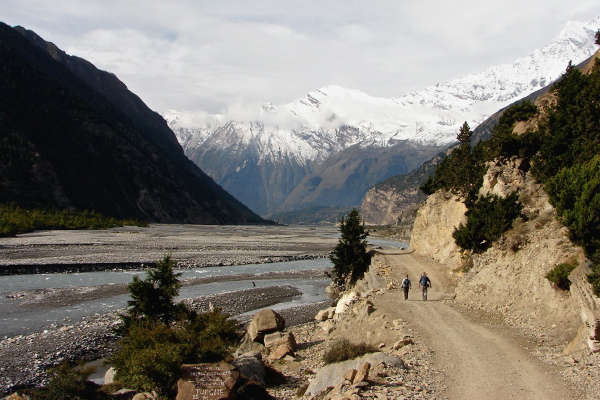
Day 1-2: Arrive Kathmandu (Drive to Besisahar / Fly to Pokhara)
Arrive in Kathmandu, usually spend a day sightseeing in the capital city.
See more in our guide on what to do in Kathmandu .
Drive from Kathmandu (1,300 meters) to Besisahar / Khudi (circa 800 meters) via bus. The trip takes between 7 and 8 hours, meandering through countryside villages.
The Annapurna Circuit typically starts at Besisahar, an hour’s trek from Khudi. Some operators may drive you to Khudi and commence the trek from there.
Day 3: Trek from Besisahar (820 meters) to Khudi and onto Bahundanda (1,310 meters)
Trek from Besisahar (820 meters) to Khudi and onto Bahundanda (1,310 meters). This traditional route has been impacted by the road construction so some operators have started using new trails that bypass the road. Instead, you go to the village of Sikrung (2,200 meters).
The latter is a fairly steep climb to a rather high altitude. But it does offer a more untainted Annapurna trekking experience. Expect to trek between 6-7 hours.
Day 4: Trek from Bahundanda (1,310 meters) / or Sirung (2,200 meters) to Jagat (1,300 meters) or potentially Chamje (1,410 meters)
Trek from Bahundanda (1,310 meters) / or Sirung (2,200 meters) to Jagat (1,300 meters) or potentially Chamje (1,410 meters). If on day 4 you followed the traditional route to Bahundanda, you will trek to Ghermu (1,130 meters) and onto Jagat. You might stay the night here or take a steep hour-long trek up to Chamje (1,410 meters).
We recommend staying the night at Chamje instead of Jagat, which is a dirty and crowded village. If on day 4 you stopped at Sikrung, you will likely follow a route via Syange (1,100 meters) to Jagat and up to Chamje.
Expect to see great rice terraced landscapes and views of the Manaslu Range during early stages of this day’s trekking.
Day 5: Trek from Jagat / Chamje (1,300 / 1,410 meters) to Dharapani (1,960 meters)
Trek from Jagat / Chamje (1,300 / 1,410 meters) to Dharapani (1,960 meters). Continuing north into the Manang region, you will trek through agricultural fields of corn and potatoes and then forests of rhododendrons.
Eventually reach the quaint village of Tal (1,700 meters). From Tal you will trek for another 6 kms (circa 3 hours) via Karte to the village of Dharapani (1,960 meters).
Day 6: Trek from Dharapani (1,960 meters) to Chame (2,710 meters) via Bagarchap and Danakyu, and then either along the lower trail or upper trail to Koto (2,640 meters)
Trek from Dharapani (1,960 meters) to Chame (2,710 meters) via Bagarchap and Danakyu, and then either along the lower trail or upper trail to Koto (2,640 meters).
From Koto you trek a further hour to the busy village of Chame. Some trekkers and operators prefer an overnight stay in the quieter village of Koto. On this rather steep trekking day you will get some great views of Annapurna II and IV, as well as Lamjung Himal.
Day 7: Trek from Chame (2,710 meters) to Pisang via Bhratang (2,850 meters) and Dhukur Pokhari (3,240 meters)
Trek from Chame (2,710 meters) to Pisang via Bhratang (2,850 meters) and Dhukur Pokhari (3,240 meters). From Dhukur Pokhari the trail splits and you may either trek to Upper Pisang (3,310 meters) or to Lower Pisang (3,250 meters) for an overnight stay.
If you take the latter to Lower Pisang we highly recommend re-joining the upper trail on day 8. This provides arguably the best views of the whole Annapurna Circuit.
Day 8: Trek using the upper trail from Pisang (3,310 meters) to Manang (3,450 meters) via Ghyaru (3,730 meters), Ngawal (3,680 meters), Humde (3,330 meters and Bhraga (3,450 meters)
Trek using the upper trail from Pisang (3,310 meters) to Manang (3,450 meters) via Ghyaru (3,730 meters), Ngawal (3,680 meters), Humde (3,330 meters and Bhraga (3,450 meters).
The mountain views on this portion of the Circuit are exceptional, as are the quaint villages along the trail. A visit to Barge monastery is worthwhile before the final stretch to Manang.
Day 9: Acclimatization day in Manang
Manang is one of the main towns on the Circuit. Many trekkers take this opportunity to spend a rest acclimatization day in the town.
Short excursions to the Gangapurna Lake and Bhojo Gompa (a Buddhist ecclesiastical fortification of learning) are common among trekkers. There are also day trips around the town. You might want to consider visiting the offices of the Himalayan Rescue Association for a talk on high altitude risks.
Day 10: Trek from Manang northwest out of the Marshyangdi Valley and up to the small village of Yak Kharka (4,110 meters)
Trek from Manang northwest out of the Marshyangdi Valley and up to the small village of Yak Kharka (4,110 meters). If you haven’t started feeling the effects of altitude yet, you might start doing so from today. Some trekkers continue onto the tiny village of Letdar (4,200 meters). Teahouse accommodation is limited in both these villages.
Day 11: Trek from Yak Kharka (4,110 meters) to High Camp (4,850 meters)
Trek from Yak Kharka (4,110 meters) to High Camp (4,850 meters). This is a fairly tough and steep day. Some tour operators will stop for the night at Thorang Phendi (4,450 meters). This is a good idea if trekkers are struggling with the altitude.
However, continuing on to High Camp is, in our opinion, preferable. This is because it makes the next day’s treks to Muktinath (3,800 meters) a lot shorter and easier. Accommodation facilities and amenities in Thorang Phendi and High Camp are both good. Please note: continuing onto High Camp means sleeping at high altitude, which is not advised if you are suffering from acute mountain sickness (AMS) symptoms .
Day 12: Trek from High Camp (4,850 meters) across the Thorung Pass (the highest point on the trek at 5,416 meters) and then back down to Muktinath (3,800 meters) via Charabu (4,230 meters)
Trek from High Camp (4,850 meters) across the Thorung Pass (the highest point on the trek at 5,416 meters). You then go back down to Muktinath (3,800 meters) via Charabu (4,230 meters). Prepare for a tough, icy-cold day of trekking. The descent from Thorung Pass is steep and trekking poles come in handy. Muktinath, although an important pilgrimage site for both Hindu’s (see the Vishnu Temple) and Buddhists (see the Monastery), is a rather characterless village. Depending on your operator, you will likely stay overnight in Muktinath. For independent trekkers, the Bob Marley Guesthouse in the center of town is a great shout!
Day 13: Trek from Muktinath (3,800 meters) to Marpha (2,665 meters) via the awesome village of Kagbeni (2,800 meters)
Trek from Muktinath (3,800 meters) to Marpha (2,665 meters) via the awesome village of Kagbeni (2,800 meters). From Kagbeni to Jomsom we recommend taking a jeep to avoid the unpleasant dusty roads.
Once you get to Jomsom you can join the ne NATT-trail (which is 2 hours longer than the road option) to Marpha. Marpha is famous for being the centre of the apple region in Nepal. Do try the apple brandy if you get a chance.
Day 14: Trek from Marpha (2,665 meters) to Kalopani (2,530 meters), via Chokhopani, and continue to Kokhethanti to avoid the road
Trek from Marpha (2,665 meters) to Kalopani (2,530 meters), via Chokhopani, and continue to Kokhethanti to avoid the road. Some trekkers grab a jeep from Marpha all the way to Tatapani (see day 15).
Day 15: Trek from Kolapani (2,530 meters) to Tatapani (1,200 meters)
Trek from Kolapani (2,530 meters) to Tatapani (1,200 meters). Using a new NATT-trail (marked in red and white), you can avoid the road and follow a trail that climbs steeply before joining a path that will take you through the towns of Kopochepani, Rupsechhahara, Dana and finally Tatapani.
Day 16: Trek up from Tatapani (1,200 meters) to Ghorepani (2,870 meters)
Trek up from Tatapani (1,200 meters) to Ghorepani (2,870 meters), via the towns of Ghara, Sikha and Chitre. You will most likely stay overnight in Ghorepani in preparation for an early start the next day.
Day 17: Trek from Ghorepani (2,870 meters) up Poon Hill (3,870 meters) and back down to Tadapani (2,710 meters)
Trek from Ghorepani (2,870 meters) up Poon Hill (3,870 meters) and back down to Tadapani (2,710 meters). You will start this days trekking early so as to get up Poon Hill for the impressive sunrise. First light illuminates surrounding rice terraces and Annapurna and Dhaulagiri massifs. The classic Annapurna Circuit trek then descends to Tadapani for an overnight stay.
Note: we have heard that instead of heading up Poon Hill, the hill opposite in the direction of Chomrong provides an equally impressive (if not better view) without any crowding issues.
Day 18: Trek from Tadapani (2,710 meters) to Naya Pul (1,070 meters) via Gandruk and then catch a short bus ride back to Pokhara
Trek from Tadapani (2,710 meters) to Naya Pul (1,070 meters) via Gandruk and then catch a short bus ride back to Pokhara. This is the end of the Annapurna Circuit and an extraordinary 18 days!
Note: It is possible to follow the old Annapurna Circuit from Ghorepani to Phedi via Landruk, although this takes an extra 2 days compared to the direct exit from Ghorepani to Naya Pul.
Please Note: From Muktinath onwards the classic Annapurna Circuit has been severely impacted by the road that joins Jomsom to Muktinath. If you choose to trek this route be prepared for an unpleasant and dusty experience, as jeeps wiz by you. Thankfully there are alternative options via the New Annapurna Trekking Trails (NATT-trails).
Suggested route options from Muktinath
If you are not on a set tour we suggest the following route:
- Trek to the charmingly wonderful town of Kagbeni (2,800 meters) for an overnight stay. We recommend taking the high trail out of Muktinath via Jhong, as this offers better mountain views
- From Kagbeni to Jomsom take a jeep as dust driven from the common winds in this region and the constant flow of vehicles on the road make for unpleasant trekking
- From Jomsom take the new NATT-trail (marked in red and white) to Marpha (2,665 meters) where you can stay overnight and then continue following the route set out from Day 13 below
Also Note: As the road starts in Muktinath, you can cheat and catch a truck all the way to Jomsom. Continue your trek or catch a flight to Kathmandu if you need to shorten your trek (we highly recommend not skipping Kagbeni though). You can also get a bus from Muktinath all the way back to Pokhara if you have run out of time. If you are a mountain biking fanatic you can rent a mountain bike to take one of the most amazing rides down and out of Muktinath – this area of Nepal is fast becoming mountain biking Mecca
Annapurna Route Variations
There are a number of route variations on the Annapurna Circuit. Here are three worth mentioning.
If you don’t have much time in the Annapurna Circuit you may want to consider the Poon Hill Trek , The Royal Trek or the Ghorepani Poon Hill Trek (also called the small Annapurna Circuit). Nepal is heaven for trekkers and has some of the best thru-hikes in the world .
- Annapurna base Camp Trek
- Naar-Pho Valley
- Tilicho Lake
It is possible to include a five day diversion to Annapurna Base Camp onto the Annapurna Circuit trek. This involves continuing north from Tadapani so as to join the old Annapurna Circuit at Landruk.
Read more about the Annapurna Base Camp Trek
A variation to the Annapurna Circuit that has been growing in popularity since opening to foreigners in 2002 is the Naar-Pho Valley.
The route begins near Koto (on day 5/6 of the classic Annapurna Circuit) and follows a trail via two distinctly Tibetan villages – Phugaon and Naar – which are both located at over 4,000 meters. After nine days trekking the route exits via the Kang La Pass (5,300 meters) to Ngawal, where you re-join the Annapurna Circuit on your way to Manang. The detour via the Naar-Pho Valley in effect adds seven days to the traditional Annapurna Circuit as you would have spent two days trekking from Koto to Ngawal and on to Manang had you stayed on the main track.
A special permit, which can only be organised through a trekking agency, is required to enter the Naar-Pho Valley. You will also need to take a guide as tourist infrastructure is poor. Most trekkers opt for the traditional camping style of trekking with porters, tents and cooks.
A 3-4 day trek to Tilicho Lake (4,920 meters), one of the highest lakes in the world, has become a relatively popular diversion on the Annapurna Circuit.
The trek starts in Manang, and follows a path on the northern side of the valley to Khangsar (note: there are maps that show a path on the southern side of the valley but we recommend avoiding this as it is in poor condition and prone to landslides).
From Khangsar there are two paths that leave the town – the lower and upper path. Take the upper path, as it is safer, until you reach Shree Kharka where you can overnight at one of the two teahouses there.
From Shree Kharka walk about 45 miuntes until you reach point where the path splits into a lower and upper trail. Make sure to take the lower trail (the upper trail is marked ‘Danger’). A further 3 hours trekking and you will arrive at Tilicho Base Camp where you can stay overnight at one of the teahouses.
Depart Tilicho Base Camp early the next morning to avoid the high winds and clouds that roll in by mid-morning. The trek up to the lake is steep and tough. It takes about 3 hours and can be very cold due to the altitude, so dress warmly. The descent follows the same path back to Base Camp (approx. an hour) or to Shree Kharka (4 hours from the lake). Overnight at Shree Kharka.
The next day take a trail (which is signposted) directly to Yak Kharka via Old Khangasar, where you re-join the Annapurna Circuit.
Recommended Guidebook

Need an up-to-date guide book with maps that include the NATT-Trails? We recommend either Andrées de Ruiter and Prem Rai’s guide, Trekking the Annapurna Circuit , or Sian Pritchard-Jones and Bob Gibbons guide, Annapurna: A Trekker’s Guide .
Annapurna Circuit FAQ
How much does it cost to hike the annapurna circuit.
The cost of an Annapurna Circuit varies depending on which route variation you take. It also depends when you trek (out of season tends to be a little cheaper) and whether to trek with a local or western trekking agency, or indeed independently.
We have provided a detailed Annapurna Circuit Cost article here but in summary you should budget for the following key expenses:
Visa, Vaccinations, Insurance etc: ~$300-$500
Equipment (buying and hiring): ~$500-$800
Flights to Kathmandu: ~$1,000
Tour Agency: ~$1000 for a cheap local agency to ~$3,000 for a pricey Western trekking agency. You could do an independent trek for ~$700 employing a local guide
check out our list of Nepal trekking companies recommendations .
Tips: ~$200-$300
Misc (additional food, unplanned travel / hotels ect): $200
Total Costs: $2,500 – $5,000
Do I need a permit for the Annapurna Circuit?
Yes. An Annapurna Conservation Area Project permit and Trekker Information Management System registration are required for the Annapurna Circuit trek.
If you are joining an organised tour, these will be arranged for you. If you are looking to go it alone you will have to bring four passport-sized photographs and go to the offices of the Nepal Tourism Board in Kathmandu to apply. We recommend bringing copies of your passport and insurance policy. The offices follow government working hours and days, and are not open on Sunday.
When is the best time to hike the Annapurna Circuit?
The best time to trek the Annapurna Circuit is either in the Spring (March to Mid May) or in the Autumn (mid / late September to December). Unfortunately these also happen to be the busiest times of the year as they are the best time for Nepal trekking ..
Towards December the weather starts getting particularly cold and the routes get distinctly quieter. If you are a hardened trekker a winter Annapurna Circuit (late December through February) can provide a very authentic Nepal trekking experience.
The main challenge of a winter trek, apart from the cold, is the snow and ice that often obstructs the higher trails and the Thorung Pass. During bad winter seasons these trails may be closed.
Unlike the Everest region that gets very wet during the rainy monsoon season, the Annapurna and Mustang regions stay relatively dry, making June through September, a relatively good time to trek as well.
Here’s a detailed article on weather on the Annapurna Circuit .
Is altitude sickness a risk on the Annapurna Circuit?
Yes, some trekkers do suffer from altitude sickness on the Annapurna Circuit as it is a high altitude trek. At its highest point, Thorung Pass, you will reach an altitude of 5,416 meters (17,769 feet).
Fortunately because of the circuits length the opportunities for appropriate acclimatisation are good. Hence, the prevalence of moderate or sever altitude sickness is low.
Nonetheless, it is important to have a detailed understanding of the risks associated with high altitude trekking and how the body acclimatises.
We recommend you read our detailed article on Altitude Sickness and Acclimatisation .
How difficult is the Annapurna Circuit hike?
The Annapurna Circuit trek is challenging. You will be trekking for 4-7 hours a day for over two weeks, so you will need to be peak physical condition. The best way to prepare is to get as many kilometres under foot on hikes in your home country.
What do I need to pack for the Annapurna Circuit trek?
Trekking in the Annapurna region requires a number of essential pieces of trekking clothing and equipment. AC is a long and tough trek. You will be exposed you to a range of altitudes where temperatures fluctuate dramatically between night and day.
Many pieces of equipment can be rented or bought in Kathmandu or Pokhara. Even so, we recommend bringing the most important pieces of gear with you.
We've written a detailed Annapurna hiking packing list .
Insurance Information
Trekking insurance is a must in Nepal. This is particularly the case in the Annapurna Region, which at stages is very remote. If an accident should occur that requires medical assistance and evacuation you will definitely want trekking insurance that can cover the costs of air ambulance and treatment.
Moreover, it is prudent to have insurance that covers you for any travel related risks. insurance should cover stolen, damaged or delayed baggage; flight delays and interruptions; and tour operators default.
This article on travel and trekking insurance in Nepal provides detailed information on what type of insurance you need.
About the author
Mark Whitman
Mark has trekked extensively in Asia, Europe, South America and Africa. He founded Mountain IQ in 2014 with the sole aim to be the best online information portal to some of the most popular mountain destinations around the world. When not writing for Mountain IQ, Mark is out exploring the outdoors with his wife!
Leave a Reply
Your email address will not be published. Required fields are marked
Thanks for the useful information. Really helpful!
Hi Mark, this is a really nice blog with very comprehensive information!!
I'd like to do the trekking on my own, as an independent trekker, but I've heard that there are some new regulations comming for this year (2023) and that a local guide or agency is mandatory to do the central part of the annapurna circuit. Also, that the TIMS can not be got by independent trekkers but only if you hire an agency. Would you have any up to day news about it?
Hi Daniel, thanks for checking in. I’m not aware of the new regulations, but it is definitely possible. Nepal authorities have been talking about this for years. Here’s the latest from the Guardian: https://www.theguardian.com/travel/2023/mar/30/nepal-imposes-ban-on-mountain-trekking-without-a-guide
We work with local guides to offer great value adventures at unbeatable prices

The Annapurna Circuit Trek Itinerary: the ultimate guide
This post offers you the ultimate Annapurna Circuit trek itinerary. The Annapurna Circuit trek was once the most popular tea house trek in Nepal . In about a month it was possible to walk around the Annapurna mountain peaks. This trek was famous for its ethnic villages, natural beauty and easy access from Kathmandu or Pokhara.
But the Annapurna Circuit trek has changed tremendously in recent years. There was a time that the further up you went, the more isolated the villages were. It took people days on foot to reach the nearest city, the nearest school or the nearest health care post. For tourists, this remoteness was part of the charm.
Ongoing road construction now connects most villages on the Annapurna Circuit with the outside world. Jeeps drive up and down on dusty roads, changing the landscape for better and worse. Tourists planning a trek in Nepal are wondering whether the Annapurna Circuit trek is still worth it.

Why choose the Annapurna Circuit trek
Despite the new roads going up the Marsyangdi and Kali Gandaki valleys, the Annapurna Circuit trek is still very much worth it. Although many things have changed with the new roads, a lot of things also remained the same. People are just as friendly, the villages just as authentic and the mountain views just as spectacular.
In short, it is still a very beautiful trek with a huge variety in landscapes, villages and people. The road itself is nothing more than a dirt track and actually carries relatively little traffic. In addition, there are plenty of alternative side trails to bypass them all together. The NATT trails set up by Prem Rai and Andrees de Ruiter are well marked and follow the traditional circuit, but avoid the road as much as possible.
The Annapurna Circuit trek requires a certain amount of time, but most of the hike is easygoing. Gradual climbs and well marked trails with frequent restaurants and lodges to take a break. What makes it challenging is the tough day you climb the Thorung La Pass and the altitude after Manang.
To prevent altitude sickness it is important to give yourself enough time to acclimatize. Don’t go up too fast and take some days to rest. The better your body has adjusted to the height, the easier the climb up to Thorung La will be.
This was my first trek in Nepal and even though many others followed such as the Langtang Trek , Poon Hill trek and The Gokyo lakes trek , I still consider myself an amateur hiker. Thorung La was difficult, but I made it. If I can do it, you can too, as long as you prepare well.

Annapurna Circuit trek itinerary
The classic Annapurna Circuit trek itinerary started in Besisahar where you climbed up the Marsyangdi valley towards Manang, crossed the Thorung La Pass, visited Muktinath and Jomsom and then walked down the Kali Gandaki valley towards Beni. This took about 20 – 30 days
The roads give you more flexibility in where to start or end the trail as well as how much time you take. Jeeps go as far up as Manang on the Marsyangdi valley side and Muktinath on the Kali Gandaki valley side.
Clockwise or anti Clockwise ?
The Annapurna Circuit Trek is a loop with different starting and end points. The first thing to decide is whether you hike clockwise starting at the Kali Gandaki valley or anti clockwise starting at the Marsyangdi valley.
The general advice and also my recommendation is to hike anti clockwise from east to west. This is the easier and safer direction to go. The Marsyangdi valley offers a more gradual climb and Manang is a great village to acclimatize well, before attempting Thorung La.
The Thorung La Pass is at 5416 meters high and altitude sickness is a serious risk. From Manang to Thorong La, there are several more villages like Yak Kharka (4020 m) and Letdar (4230 m) to stop and acclimatize or get help if you do suffer from altitude sickness. Thorung Phedi (4450 m) and High Camp (4850 m) are the last lodges before the pass.
From west to east the last village is Muktinath (3750 m) and a few basic lodges at Charabu (4210 m). After the last lodge it is a very long and steep ascent to Thorung La with nothing in between. Taking this approach is not only more difficult and requires you to be very fit, it is also potentially dangerous. You go high quickly and without proper acclimatization small things like bad weather or an injury can become very problematic.

How much time?
The roads have made it possible to do the Annapurna Circuit trek in much less time than the original 30 days. Still, the Annapurna Circuit trek is an area where slow travel is very rewarding. The villages on the way are very interesting and a destination in their own right. Furthermore, there are lots of side trips to escape the crowds.
Another reason to take it slow on the Annapurna Circuit Trek is again the altitude. Yes it is possible to take a jeep all the way to Manang (3520), but you will not only miss out on lots of beautiful scenery, you will also increase your risk of getting altitude sickness.
Looking at the distances and trekking times, it looks possible to trek from Manang to Thorong La in less than two days, but again, this would be very foolish. Experts advise to not ascend more than 300 – 400 meters per day once you are above 3000 meters high.
On the Annapurna Circuit trek this advice translates in at least one acclimatization day in Manang and another acclimatization day in Letdar before spending the night at Thorung Phedi. I followed exactly this advice and still struggled with the altitude when crossing the Thorung La pass.
Even if you are short on time, you need to acclimatize. You could do the Annapurna Circuit trek in 2 weeks if you decide to fly from Jomsom back to Pokhara. If you have more time, walking down the Kali Gandaki valley is definitely worth it. Although road construction has had a big impact here, I still enjoyed the villages of Marpha and Tukuche as well as the scenery from Tukuche to Letdar and Ghasa.

Where to start the Annapurna Circuit trek
With jeeps now going all the way to Manang, where to start the Annapurna Circuit trek has become a big question. I already mentioned that going straight to Manang isn’t the best idea for several reasons. In fact, my favorite trekking days were from Chame to Pisang and Pisang to Manang.
Some trekkers still decide to follow the original Annapurna circuit trek itinerary and start at Besisahar. Because I had recently done the Poon Hill trek through the lower foothills of the Annapurna’s I decided to take a jeep up to Syange.
Others start at Bhulbhule or Chame. To help you decide, it is maybe good to know that the road is most busy between Besisahar and Bhulbhule although there is an alternative NATT trail as well.
From Kathmandu there are direct buses all the way up to Bhulbhule. The direct bus is a great option if you like to start in Bhulbhule. If you prefer to start later on, it is better to take a bus to Besisahar and then change to local jeeps that go all the way to Syange, Chame or even Manang.
My personal advice is to start no further than Chame. The scenery after Chame is very beautiful.
Where to end the Annapurna Circuit
A lot of hikers end their Annapurna Circuit trek in Jomsom from where you can fly back to Pokhara. A comfortable option if you are short on time, but you will miss out on the beauty of the Kali Gandaki valley.
Marpha and Tukuche are very scenic traditional villages worth a visit. Furthermore, the hike from Tukuche to Lete and Ghasa is very beautiful. I hiked in the Kali Gandaki valley twice. The first time I ended my hike in Tatopani. A small village with warm water pools. The second time I ended my hike in Ghasa.
From both towns it is possible to take a jeep down to Beni. There you can change on a bus to Pokhara.

My Annapurna circuit trek itinerary
In this Annapurna Circuit trek itinerary I mention every day the amount of time it took me from start to finish. I am a slow hiker though. I like to take frequent breaks to enjoy the beautiful views. If you are a fit hiker, you can probably do it in much less time
Day 1: Bus from Kathmandu to Besisahar/Syange
I started my Annapurna Circuit trek itinerary from Kathmandu where I took a bus to Besisahar. The original start of the trail. After a long and bumpy bus ride of 8 hours in a crowded bus I was happy to arrive for a late lunch.
I was curious about the new road all the way up to Manang. As I had recently done the Poon Hill trek I already saw the lower foothills of the Annapurnas in all its beauty and decided to skip the first two days of trekking by taking a jeep to Syange.
At the jeep station I quickly found a jeep that was slowly filling up. Jeeps leave mostly in the early mornings. It was already late in the afternoon and now it took at least two hours before the jeep had enough passengers and cargo.
It is only 30 kilometers from Besisahar to Syange, but the jeep journey took over 3 hours. I soon regretted my decision not to walk. The first part to Bhulbule was quite ok, but after that the road got really bad and scary.
I am glad I had a careful driver that knew what he was doing and took it slow. Not all drivers are like that in Nepal. There was even an extra person that frequently got out to check the road or to remove stones. Just as it got dark I saw the lodges of Syange.
Logistics : Direct buses to Besisahar (7 – 8 hours) and Bhulbule (8 – 9 hours) leave everyday from the Gongabu bus station (new bus park or Machapokhari) in Kathmandu. Get there early as it is a chaotic bus station and buses leave between 6 – 8 AM in the morning. It is best to reserve your tickets a day in advance at the bus station or at a travel agency in Thamel.
For destinations further up the trail (Syange, Ghermu, Chame, Pisang, Manang) take a bus to Besisahar. Jeeps leave from the jeep bus station in Besisahar. There is a dual price system with foreigners paying slightly more.
Personally, I would start walking in Bhulbule and certainly not go much further than Syange by jeep. After Bhulbhule the road is not in a very good condition and the journey will be adventurous to say the least.
Day 2: Syange – Tal
16 kilometers, 8 hours
I always feel excited on my first day of hiking. Being in the mountains with the fresh air feels invigorating. After an early breakfast I left Syange and immediately entered a narrow gorge where I shared the road with porters carrying chickens and goats.
Walking on the jeep road wasn’t as bad as I had imagined and there was little traffic. The scenery was nice with waterfalls on the other side of the road and the Marsyangdi river below.
The Marsyangdi river kept me company for the rest of the day. I had lunch in Chamye after which it was a steep climb over boulders up to Tal.
Insider tip: there is an alternative NATT trail from Ghermu to Jagat that bypasses the road. It is much longer and I heard the path is very narrow and close to the edge. With my fear of heights I decided to stay on the road.

Day 3: Tal – Danaque
11 kilometers, 5 hours
From Tal you can choose to make it a long day to Chame (20+ kilometers) or split it up in two days and spend the night somewhere in between.
I left Tal to see how far I would come that day. Till Dharapani the trail was very quiet and scenic with several waterfalls. At Dharapani the trail joined the road again. Both Dharapani and Bagarchap are nice villages with lots of restaurants.
At Bagarchap I had my first Annapurna views and I stopped for lunch. I already knew Chame would be too far for me, but I could still hike a bit more and decided to continue to Danaque. A nice village with a Mani wall and prayer wheel.
Insider tip : It is possible to take an alternative NATT trail from Dharapani to Bagarchap up to the village of Odar. It adds 2 hours to your trekking time and is a steep 200 meter climb up and down again.

Day 4: Danaque – Chame
12 kilometers, 6 hours
Today started with a steep and long climb through the forests from Danaque to Timang. A difficult beginning, but the rewards were beautiful mountain views once I reached the top. After Timang the ascent became more gradual and passed the occasional village.
I noticed more and more Buddhist influences like mani walls, prayer wheels and chortens. The mountain views too became more beautiful as I approached Chame. A lively village right next to the Marsyangdi river.

Day 5: Chame – Pisang
14 kilometers, 7 hours
The part from Chame to Pisang was simply spectacular. Panoramas on the snow capped peaks of the Annapurna’s all day as I hiked along the Marsyangdi river. The increase in altitude is also visible as pine forests give way to open fields with sweeping views.
This was one of my favorite days on the Annapurna Circuit trek. Parts of the road were carved out of the side of the mountain and high above the river. With my fear of heights this was a bit of a challenge, but I made it.
When I arrived in Pisang it was tempting to stay in lower Pisang. I heard the views are much better from Upper Pisang though and so they were.

Day 6: Pisang – Manang
18 kilometers, 8 hours
Pisang to Manang was another beautiful day on the Annapurna Circuit trek. The trail is a gentle climb with beautiful views all around you. I enjoyed every minute of my hike, but also started to feel the effects of the altitude.
From Pisang to Manang you can choose to hike the easier lower trail or a more spectacular higher trail. Because I woke up with a slight headache I didn’t want to add 3 more hours to my hiking trail and choose the lower option on the road.
I am sure the higher trail offers even better views, but for me it was a good decision to take it easy. By the time I was in Manang (3540 m) I was having mild symptoms of Altitude sickness.

Day 7: Manang acclimatization
In Manang I had a much needed acclimatization day. My first night in Manang was a night of insomnia, vivid dreams and a mild throbbing headache that got only less in the early hours of the next day. Mild symptoms of altitude sickness.
Manang is a small village, but there are lots of side trip possibilities. The strenuous hike to the ice lake is very popular, but I did not feel fit enough. Another popular hike is to Chongkor viewpoint where you can see a glacial lake. There are also several gompa’s in the area you can visit.
I went to the Chongkor viewpoint to see the lake and then visited the excellent information session about altitude sickness from the Himalayan Rescue Association. They give this for free every day at 3 pm.

Day 8: Manang (3540) – Yak kharka (4020)
10 kilometers, 5 hours
My second night in Manang I slept well. I therefore decided to continue to Yak Kharka. An elevation increase of 500 meters.
The climb was hard. Although the obvious symptoms of altitude sickness were gone, I was more easily out of breath and every step seemed to take a lot of energy. The next village, Gunsang, was only 3 kilometers away but I took a long tea break.
With a cup of tea and the sun warming me up in the chilly morning air I still felt so lucky to be here. The views on the Annapurnas and the flocks of birds flying by were all so beautiful.
After Gunsang the landscape changed again to high altitude fields with shrubs and grazing goats. The trail climbs slowly to over 4000 meters high. Technically, the path is very easy, but my body was struggling more than ever.
I was glad to see the cluster of lodges at Yak Kharka. Yak Kharka translates as yak pastures and therefore it was no surprise to see a few yaks wandering around.

Day 9: Yak kharka (4020) – Letdar (4230)
2 kilometers, 2 hours
I slept well at Yak Kharka and woke up full of energy. However, after only 20 minutes of hiking I felt tired and out of breath. Luckily I had already made the wise decision to stay in Letdar.
Letdar is less than 2 kilometers from Yak Kharka and it is a very easy hike, but I can feel my body needs an extra night to adjust to the altitude.

Day 10: Letdar (4230) – Thorung Phedi (4540)
6 kilometers, 4 hours
With an extra night at Letdar I felt more prepared to continue to Thorung Phedi (4540). It was an easy hike except for a scary part where there is a risk of landslides. Thorung Phedi is right after that.
It is possible to continue to High Camp (4850). The last lodge before Thorung La, but the general advice is not to sleep here, because of the altitude. It does make for a great afternoon hike to help acclimatization

Day 11: Thorung phedi – Muktinath
15 kilometers, 10 hours
The day you cross Thorung La will be the most beautiful, but also most difficult day on the Annapurna Circuit Trek.
Most people start early as the weather is less windy in the morning. I started around 4 AM. The ascent to high camp was difficult and I definitely felt the altitude. At High Camp I was in doubt whether I should stay one more night here before attempting the pass.
After a quick cup of tea I pushed myself on to continue. It was difficult. Every few steps I was out of breath and had to stop. My head started hurting again and I felt very tired. There were many false summits and I started to wonder whether I should turn back.
After 4 hours I finally saw the bundle of prayer flags that is Thorung La at 5416 meter. I felt pure joy that I made it, but at the same time absolutely miserable because of the altitude. After a quick selfie I did not even want to stop for a cup of tea. All I wanted was to go to a lower altitude.
The first hour I happily hiked down and started to feel better by the minute. Then I realized that the 1600 meter descent to Muktinath is actually more difficult than the ascent. My knees started hurting, my muscles trembling.
It was a very long day. Looking down I could see Muktinath in the distance. Ít just didn’t seem to come closer. After 4 hours I arrived at a cluster of lodges called Charabu. If they weren’t full I would probably have stayed here.
After a quick dahl bath I had to continue to Muktinath. The last bit was the most difficult. I stumbled into the first lodge I saw, had dinner and went to bed.

Day 12: Muktinath – Kagbeni
12 kilometers, 4 hours
In Muktinath I woke up feeling all my muscles from the steep and long descent yesterday. Slowly I got out of bed. This is my third time in Muktinath. A small village home to an important Vishnu temple popular among Indian and Nepali pilgrims.
As jeeps now go all the way from Pokhara to Muktinath, it is a busy town and a culture shock after the desolate stretch of barren rocks that I walked through yesterday. I brought a short visit to the temple and then walked straight to Jharkot.
Jharkot is a traditional village with mud and stone houses. The signs of animist religions that predate Hinduism and Buddhism give a clue to its old age. Rather than just passing by I would recommend to take a look and wander through the narrow streets for a bit.
After Jharkot, it is a beautiful hike down to Kagbeni. Another traditional village that is at the border of Lower and Upper Mustang. Mustang was once an independent kingdom that played a big part in the salt trade between Tibet and Nepal.
Beyond Kagbeni lies Upper Mustang. A remote region that remains isolated and protected from mass tourism by expensive permits. Kagbeni is as far as you can get and gives a good sense of the unique culture of Upper Mustang that is still very close to that of Tibet.
Kagbeni is an interesting mix of new hotels and restaurants catering to tourists as well as medieval monasteries and ancient fortress ruins. The 15th century red monastery stands out between the whitewashed mud homes.
The Red House Lodge was one of the most interesting places where I stayed. It has its own 350 year old buddhist chapel and the best dried yak meat (yak sukuti).

Day 13: Kagbeni – Marpha
17 kilometers, 6 hours
The hike from Kagbeni to Jomsom follows the riverbed of the Kali Gandaki river. The Kali Gandaki valley lies in the rain shadow of the Annapurna mountains and therefore the landscapes are quite unique.
Barren desertlike mountains that differ in color. Different shades of brown, gray and yellow contrast sharply with the deep blue sky, white snow capped peaks and green farm fields.
South of Kagbeni starts Lower Mustang. An area home to the Thakali people that also played an important role in the salt trade. Between Kagbeni and Jomsom there is not much but spectacular landscapes.
Jomsom is the first Thakali village. Because of its airport it is very well developed and touristic. This is where most people end their Annapurna Circuit trek and take a plane back to Pokhara.
If you do decide to continue on foot it is much better to stay in Marpha. A more authentic Thakali village with an old monastery and the so-called apple capital of Nepal. I was not a big fan of the local dried apples, but the apple pies here were delicious.

Day 14: Marpha – Tukuche
7 kilometers, 3 hours
I thought Marpha was one of the most interesting villages on the Annapurna Circuit trek. Marpha alone is a reason why you should not stop at Jomsom.
Marpha is a true Thakali village and you can see that people have done much effort to preserve their traditional architecture and culture. Iconic are the flat mud roofs that are used to store stacks of firewood. The roofs are also used to dry the apples and other food items.
Rather than leaving in the morning to start hiking, I spent some time exploring the village. There is a monastery in the center of the village as well as above the hill with beautiful views. You can also visit the apple gardens and taste apple products at the apple distillery.
The Thakali people are famous for their cuisine. Tibetan dishes like Thukpa (noodle soup) and Tsampa (barley porridge) are popular. But most famous are the Thakali sets. A more luxurious version of dahl bath with all kinds of extras like fermented spinach (gundruk) and pickles (aachar). I couldn’t resist having one for lunch before hitting the trail again.
Tukuche is only 7 kilometers away, but another picturesque Thakali village that is very well worth the detour from the main road. When I arrived they were filming a Nepali movie song and it seemed all the children of the village were out and about to see what was happening. I also enjoyed the show and decided to stay in Tukuche for the night.

Day 15: Tukuche – Ghasa
20 kilometers, 9 hours
After Tukuche the landscape started to become more green again with trees and bushes. Tukuche was the last lively Thakali village on the trail. The other villages were small with just a few lodges. They seemed rather empty and not that inviting.
I decided to hike all the way to Ghasa. It was a long day, but because it was downhill it was not that difficult. Right before Ghasa is a hanging bridge high above the river. I knew it was coming and with my fear of heights a scary experience.

Day 16: Ghasa – Tatopani
15 kilometers, 6 hours
This was going to be my last day of hiking on the Annapurna Circuit trek. Back to the lower altitudes of the Annapurna’s, the landscapes reminded me a lot of the Poon hill trek . Lush and green and also more warm and humid.
Yesterday’s day was maybe a bit too long for my liking, but the last kilometers of today I felt sad it would be over soon. Tatopani has several warm water pools annd they felt like a great reward after 17 days on the road.

Day 17: Tatopani – Beni/Pokhara
From Tatopani I took the jeep to Beni. The road became more busy and there were not a lot of ways to avoid it. It is also possible to hike to Ghorepani and connect with the Poon Hill trek .

The Annapurna Circuit Trek Travel tips
Annapurna circuit trek permits.
For the Annapurna Circuit trek you need two permits.
TIMS card : The Trekkers information management card is necessary for almost all treks in Nepal. You can get your TIMS card at the Tourism Board office at Bhrikuti Mandap in Kathmandu. Bring your passport and two passport size photos. The TIMS card costs 2000 nepalese rupees.
Annapurna Conservation Area permit : For the Poonhill trek you also need a national park entrance permit. I recommend you to get it as well at the Tourism Board Office at Bhrikuti Mandap in Kathmandu. This costs 3000 nepalese rupees.
Do I need a guide on the Annapurna Circuit?
The Annapurna Circuit trek is moderately difficult, but easy to do without a guide. The trails as well as the NATT trails are well marked. Unless you go off season there will be enough other hikers on the trail to keep you company.
I hiked the Annapurna Circuit alone and did not experience any problems. When hiking alone I always make sure not to hike after sunset and listen carefully to my body. At Manang I did feel mild symptoms of altitude sickness and took two acclimatization days as well as an extra night in Yak Kharka and Letdar.
If you are alone and not that experienced, you might want to consider joining a guided trek or hiring a guide, porter or porter guide.
In Nepal there is a clear distinction between a porter and a guide. A guide shows you the way and can tell you more about the history and the culture of the places you visit. A porter will only carry your luggage. Despite their heavy burden they often walk far in front of you and might have reached the lodge when you are only midway. A porterguide is less common, but does both.
In Pokhara I can recommend the 3 sisters adventure trekking that works to empower women and trains women to become trekking guides in Nepal.
Update April 2023 : The Nepal Tourism Board issued a press release that trekking without a guide is no longer permitted from 1 April 2023 onwards. Trekkers planning to hike in Nepal’s National Parks where you normally need a TIM’s card should have a government licensed guide that is registered with the official Trekking Agency Association of Nepal (TAAN) . It is unclear yet how this rule will play out in practice. Everest issued a press release stating that they will not enforce it. Other areas do. However, there are no guidelines on how they are going to implement the ban on solo trekking .

Accomodation on the Annapurna Circuit
Along the Annapurna Circuit trek there is plenty of accomodation and teahouses to choose from. They are basic and can’t be booked online beforehand. There is a first come first serve basis and some lodges are fully booked by big tour groups.
There are enough lodges that there will always be a bed for you somewhere. I trekked the Annapurna Circuit twice in spring and in November and never had any problems finding a place to stay.
The prices of accomodation is incredibly cheap, sometimes even free, but they do expect you to order dinner and breakfast at their establishment. Things like hot showers and WIFI are getting more common, but are sometimes at an extra cost.

Food on the Annapurna Circuit
The good thing about tea house treks in Nepal is that however basic lodges might be, the food is often quite good if you stick to Nepali cuisine . Yes, many lodges try all kinds of international dishes to attract tourists, but in my opinion often not the best choice.
When trekking in Nepal I eat Dahl bath at least once a day. This national dish of rice with lentils knows a huge variety in how it is prepared. Different vegetable curries from fermented spinach to roasted cauliflower and different pickles to spice it up. Not one dahl bath is the same. Other Nepali foods to try are Tibetan bread, Thukpa and Momo’s.
The Annapurna’s are a multicultural area with local foods as well. In Kagbeni it is possible to find yak meat on the menu. Marpha is the apple capital and has the best apple pies as well as dried apples. In the south are the Gurungs with specialities like dried meats (sukuti) and fermented leaf curries (gundruk).
When to hike the Annapurna Circuit
The best time to go trekking in Nepal is Spring and autumn.
January and February are too cold with lots of snow on the trail. The Thorung La Pass will be closed due to heavy snowstorms and a risk of avalanches. By March/April the pass reopens again, but you can still expect snow at the higher altitudes.
April and May are the warmer months before the monsoon and a very good time for the Annapurna Circuit Trek. The blooming flowers and rhododendrons are a highlight in this period. At the lower altitudes it can already become hot, dusty and humid while the higher altitudes are comfortable.
June, July and August are the monsoon months. The Marsyangdi valley up to Manang sees lots of rainfall. The trails will be muddy with lots of leeches, but the landscapes will be lush and green. The Kali Gandaki valley is in the rain shadow and sees much less rain.
September, October and November are the most popular months for trekking. Autumn brings clear blue skies and mild temperatures before the cold sets in in December. Autumn is also a festive season with the celebration of Tihar and Dashain. Nepal’s biggest festivals .
Regardless of the seasons, the weather conditions at Thorung La can change rapidly and there is always a chance of unstable weather, cold and snow storms. It is important to check the weather forecast before crossing Thorung La. A freak storm in October 2014 killed several trekkers as they got stuck in bad weather and snow.

Altitude Sickness on the Annapurna Circuit
The Annapurna Circuit trek involves a serious risk of altitude sickness. Crossing the Thorung La Pass at 5416 meters high requires proper acclimatization. To allow yourself enough time to do so, it is best to trek anti clockwise from east to west.
Experts advise to not ascend more than 300 – 400 meters per day once you are above 3000 meters high. Pisang (3310) is the first village above 3000 meters and that is why it is not wise to take a jeep straight to Manang at 3540 meters high. Those first days of walking at the lower altitudes are not only beautiful, but helps your body adjust to the increasing altitude.
For the Annapurna Circuit trek, the general advice is to spend at least one acclimatization day in Manang and another day in Letdar before spending the night at Thorung Phedi. I followed exactly this advice and still struggled with the altitude when crossing the Thorung La pass.
The key to prevent altitude sickness is to take it slow, give your body enough time to adjust to the height and to drink enough water. Diamox is a medicine that might help your body to acclimatize, but will not cure altitude sickness once you have severe symptoms. In that case, the only remedy is to go down to a lower altitude as soon as possible.
Mild symptoms may include being tired and more easily out of breath. More severe symptoms of high altitude sickness are headache, dizziness, trouble sleeping, breathing problems, loss of appetite, nausea and vomiting.
Severe symptoms indicate you are developing high altitude cerebral edema (HACE) or high altitude pulmonary edema (HAPE). Both conditions are fatal if you do not get to a lower altitude on time.
Take these symptoms seriously and watch out for symptoms in others, even in your nepali guides or porters. It is a misconception that they cannot get altitude sickness. The health clinic in Manang gives daily information sessions about altitude sickness that I can highly recommend.
The Annapurna Circuit Trek Books and Guides
Cicerone and trailblazer both have excellent and comprehensive guides about treks in Nepal with detailed guides about the Annapurna. Another option is the Lonely Planet’s trekking in the Nepal Himalayas guide.
The Himalayan Map house published the guidebook from Prem Rai and Andrees de Ruiter who developed the NATT trails on the Annapurna Circuit trek.
The Annapurna Circuit Trek packing list
If you need to carry your own gear on a multi day trek the advice is to bring as little as possible. The Annapurna Circuit trek is not a difficult trail. There is no need to bring a tent or food. Below a few things to consider
Sun protection : no matter what time of the year you will need to bring protection against the sun. Sunscreen and a hat are a must. There are stretches with little shadow
Rain protection : there is always a risk of rain. I brought a poncho along that protected both me and my backpack from the rain.
Sturdy shoes : There is no need for proffesional hiking boots. However, there are some rocky trails so do bring sturdy shoes that fit you well. It’s important you don’t bring brand new shoes. Make sure your shoes are tested and comfortable to prevent blisters.
Hiking socks : Besides good shoes, good hiking socks are key to prevent blisters. Merino wool socks are lightweight and dry quickly. Wrightsocks are specially designed with double layers to prevent blisters. Decathlon has good merino wool socks too.
Layers : there can be a big difference in temperatures during the day and night. The best way to deal with this is to wear layers. As a base layer I bought merino wool tshirts at Decathlon. They are lightweight and dry quickly. I had a fleece vest as a midlayer and as the upper layer I had a windproof jacket.
Backpack : Your shoes and backpack are two things that will have a big influence on the comfort of your multi day trek. I recommend to go to an outdoor store to get some good advice to buy a backpack that fits your torso length and that is comfortable when you wear it. I own the Osprey Fairview trek 50 that I am very happy with.
Reusable water bottle : to prevent plastic waste I always bring a reusable water bottle with me and a water filter or steri pen.
Sustainable Travel on the Annapurna Circuit Trek
The Annapurna Circuit trek is very popular. The trails become more crowded and pollution is a growing problem. Traveling sustainably to the Himalayas is essential to minimize your environmental impact and preserve the area’s natural beauty for future generations.
Support the local community : You can support the community by purchasing goods and services from local vendors. It is better to try Nepali Cuisine that uses local ingredients rather than imported foreign foods. Nepali food is vegetarian friendly and it is very easy to follow a vegetarian or vegan diet.
Stay in small scale sustainable hotels : It is also better to stay in locally-owned guesthouses or homestays to support the local economy directly. These accommodations often have a more positive impact on the environment compared to large hotels.
You can try to look for guesthouses or homestays that prioritizes sustainable practices. That said, environmental awareness is still low. It’s up to you to use water sparsely, turn off lights, air conditioning, and heating when leaving your accommodation.
Leave no trace principle : When hiking the Annapurna Circuit Trek, stick to designated trails to protect the fragile alpine ecosystem. Straying off the marked paths can cause soil erosion and damage to plant life. If you are lucky enough to spot wildlife, observe quietly from a distance to prevent disruption to their habitats and help maintain their natural behaviors.
I encourage you to take all your trash back with you and dispose of it responsibly. In other words, leave no trace of your visit. Even better is when you bring something to pick up any of the trash that other people left behind.
To avoid single-use plastics, invest in reusable items. For example, you can bring your own water bottle with a filter. At last, use biodegradable and eco-friendly personal care products to minimize pollution of water sources.
Respect the culture : Besides environmental concerns it is also important to be sensitive of the community’s way of life. Nepal is a multicultural country and on the trail you will encounter different ethnic groups.
People will appreciate it, if you dress modestly. Learning a few basic phrases in Nepali, can go a long way in building meaningful connections and to learn more about the local culture. Not everybody is happy to have their picture taken. When in doubt, ask permission.
Disclaimer : This post with a travel guide about the Annapurna Circuit trek in Nepal contains affiliate links. If you buy any service through any of my links, I will get a small commission at no extra cost to you. These earnings help me to keep Backpack Adventures alive! Thanks for your support!

2 thoughts on “The Annapurna Circuit Trek Itinerary: the ultimate guide”
I found your post incredibly useful. I appreciate the time and effort you took in gathering and posting all of this information. Thank you!
I have enjoyed looking at your photographs and reading your description of villages and landscape, food, and people. My husband and I lived in Marpha from 1981 to 1983! My husband was with the Food and Agriculture Organization and was helped develop a vegetable seed program with the farmers. Back then there was no electricity, no cell phones, and no road. We’re sorry to learn of the modernization which detracts from the experience of being geographically isolated and more dependent on using inner resources to survive. However, a lot of the new changes are beneficial to the villagers who require easier access to medical care. Back in he day, a porter with a wooden chair strapped to his back was the ambulance service. The sick person was strapped in and the porter ran all the way to Pokhara. Thanks for your interesting update on life along the Kali Ghandaki River.
Leave a Reply Cancel reply
Your email address will not be published. Required fields are marked *
- Kale by LyraThemes.com.

Annapurna Circuit Trek
Planning to trek the annapurna circuit in nepal a great decision here's everything you need to know before your annapurna trek, including trekking permits, hiking solo vs in a group, what to pack, when to go, and all the money matters..
Annapurna Circuit Trek is a popular classic trek of Nepal. Each year, more than 60,000 trekkers come for this trek from all around the globe. In this trek, you encircle the Annapurna massif and cover between 110-130 miles by walking.
The Annapurna Circuit trek usually takes about 14–21 days, leaving from Kathmandu with a stopover in Pokhara before returning to the capital. The trail is moderate to fairly challenging and makes numerous river crossings over steel and wooden suspension bridges.
Our 19 days Annapurna Circuit Trek begins from Besisahar. You begin your trek alongside Marshyangdi river all the way to its waterhead beyond Annapurna range. You then enter into Manang, cross the famous Thorong La Pass (5,416 m) and go down to the restricted region of Mustang.
After visiting some popular settlements of this semi desert-like region, you travel a few hours in a bus and trek to Poon Hill viewpoint.
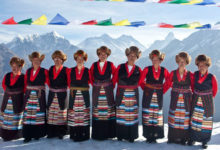
Annapurna Circuit Itinerary has often been voted as the best long-distance trek in the world, as it combined, in its old full form, a wide variety of climate zones from tropics at 600 m asl to the arctic at 5416 m asl at the Thorong La pass and cultural variety from Hindu villages at the low foothills to the Tibetan culture
There are two types of trekking permit required by anyone wishing to do the Annapurna Circuit trek. No matter when or how you’re hiking the Annapurna Circuit, you’ll need to organise both a Trekking Information Management System (TIMS) permit, and an Annapurna National Park Permit (sometimes also known as the Annapurna Conservation Area Permit).
As of 2019, the permits should set you back about USD $50 total: the APC Permit is USD $30 / NPR 3,000 per person, while the TIMS Permit is USD $20 / NPR 2,000 per person.
Since the trail opened in 1977, most trekkers have followed an Annapurna Circuit itinerary that begins in Besishahar and heads in an anti-clockwise direction over the Thorong-La Pass and down into the Jomsom Valley.

Special Note for Annapurna Circuit Trek
Facts about annapurna circuit trek:, annapurna circuit trek highlights.
- The peaceful and pristine nature trip.
- Witness stunning views of Annapurna, Lamjung Himal, Dhaulagiri, Nilgiri and more.
- Stay in tea-houses of small villages.
- Cross highest pass – Thorong La Pass(5,416m).
- Visit Muktinath, other holy temples, and monasteries.
- Explore beautiful villages of Braga, Manang, Kagbeni, Jomsom, and Marpha.
- Gaze at the breathtaking Annapurna range from Poon Hill.
- Natural Hot spring at Tatopani.
- Enjoy the lively evening of Pokhara.
- International & domestic airport transfers as per the itinerary.
- 2 nights accommodation in Kathmandu with Bed and Breakfast plan.
- 2 nights accommodation in Pokhara with Bed and Breakfast plan.
- 18 breakfast, 14 Lunch, 15 dinner during the trip.
- Kathmandu Sightseeing by professional English speaking tour guide.
- Kathmandu – Pokhara – Kathmandu domestic flight.
- Pokhara – Jomsom – Pokhara Flight.
- 3 meals a day during the trip (Breakfast, Lunch & Dinner) as mention in itinerary.
- Accommodation while trekking in twin sharing basis in guesthouses.
- Annapurna conservation area permit and TIMS card.
- Upper Mustang Restricted area permit fee.
- Professional government license holder English speaking trekking guide.
- Sleeping bag and duffel bag during the trek. (Refundable after finish the trip)
- Medical supplies (first aid kit will be available).
- 1 farewell dinner in Kathmandu
- All government and local taxes.
- All entrance fees for sightseeing places
- Alcoholic, hot and cold drinks.
- Your international flights
- Nepal visa fees & airport taxes
- Personal travel insurance (strongly recommended)
- Gear or equipment for your trek
- Personal expenses along the trek
- Tiji Festival Camara fees, and other donation
- If you would like to ride on pony
- Tips for your city guide, drivers, hotels, restaurants, etc.
- Extra night accommodation then mention plan
How difficult is the Annapurna Circuit Trek?
Is annapurna circuit dangerous, do i need a sleeping bag for annapurna circuit, is there any luggage limit for porter, do i need vaccinations for this trip.
When to Go Annapurna Circuit
Monsoon season in Nepal is June through September. That’s when most of the rain falls and when rock and mudslides are most likely to occur. The spring, between mid-March and mid-April, is when the rhododendron forests bloom, but the weather is still wet this time of year and the leeches are a nuisance at lower elevations.
The best time to do the Annapurna Circuit is October, thanks to reliably pleasant weather (80°F and humid at 2,000 feet; 20°F and dry at 17,000 feet) and clear skies.
Annapurna Circuit Trek Difficulty
The path reaches its highest point at Thorung La pass (5416m/17769 ft), touching the edge of the Tibetan plateau. Practically all trekkers hike the route anticlockwise, as this way the daily altitude gain is slower, and crossing the high Thorong La pass is easier and safer.
To be very blunt about it, Annapurna Circuit Trek difficulty level is quite challenging. What make the Annapurna Circuit trek difficulty level so tough is the high altitude that the route covers. The trekking route takes you as high as 5416 m, which is the height of Thorung La, the highest altitude pass in the region.
Accommodation, Food And Drink Facility
All guesthouses have blankets you always can ask for an extra one or two if it’s really cold. You had light summer sleeping bags but most of the time slept without them under the blankets. Even at Thorung Phedi where it will quite cold, you sleep in warm clothes under two blankets.
The facilities at higher altitudes e.g. Thorong Phedi and High Camp are more basic no power outlets in the room, no or very poor wi-fi, no hot shower, etc., to charge your phone or to use wi-fi you pay extra.
All guesthouses are more or less the same there are no fancier hotels to stay on the route like in Pokhara or Kathmandu. Rooms are very basic usually they have two single beds, blankets, sometimes a table and a chair.
Most of the time hikers sit in the dining area it’s the warmest place in a guesthouse; people drink tea, play cards, talk, etc. You go to your room only at night.
Nepal Annapurna Circuit Trek | Documentary
Getting travel insurance
The Annapurna Circuit is a high altitude trek through remote and difficult to access areas of Nepal having travel insurance is highly recommended. In fact, it’s required for getting the hiking permit. Nobody has ever asked us to show our insurances but when you fill the form they ask you to provide the name and the phone number of your insurance company.
There are many insurance company but we’d recommend using one that has experience in covering outdoor activities and working in the region like World Nomads. Nepal is one of their top hiking destinations with thousands of people buying World Nomads insurance policies for trekking here so they know local specific.
Book with Local Operator
Whether it’s a cultural tour, gentle walking holiday or strenuous trek, our holidays in Nepal are led by professionally-trained English speaking leaders. They have an intimate and expert knowledge of the history, culture and nature of Nepal and will make your trip a memorable experience. Thus hurry up and reserve your place to Annapurna Circuit Trek.
Kulendra Baral
Let's stay updated, subscribe my newsletter for new blog posts, tips & new photos., pokhara sightseeing tour, annapurna region, related articles.
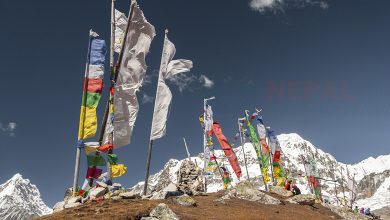
Langtang Valley Trek
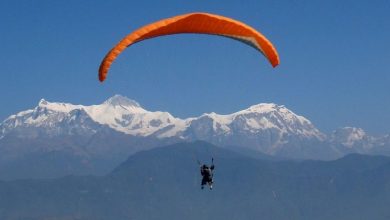
Paragliding
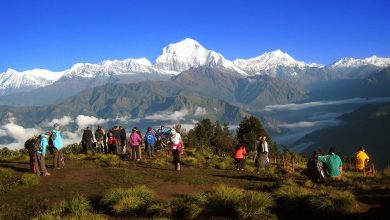
Ghorepani Poon Hill & Ghandruk Trek – 9 Days
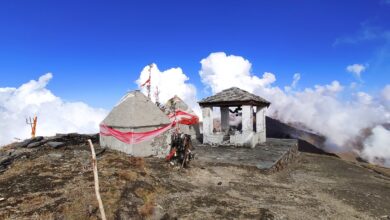
Khaptad National Park Trek
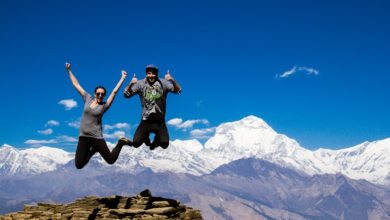
Honey Hunting Nepal
Leave a reply cancel reply.
You must be logged in to post a comment.
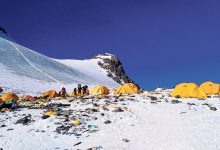
We’re on the road right now – join in on the fun and follow @thebrokebackpacker on IG!
- Meet the Team
- Work with Us
- Czech Republic
- Netherlands
- Switzerland
- Scandinavia
- Philippines
- South Korea
- New Zealand
- South Africa
- Budget Travel
- Work & Travel
- The Broke Backpacker Manifesto
- Travel Resources
- How to Travel on $10/day
Home » Asia » Nepal » The Annapurna Circuit and Beyond: Ultimate Guide to Hiking in Nepal (2024)
The Annapurna Circuit and Beyond: Ultimate Guide to Hiking in Nepal (2024)
Until 1951, Nepal was off-limits for foreign travellers; a secretive, isolated kingdom kept under wraps from outsiders…
But a change of regime gave birth to a new era of travel, and Nepal has remained a magnet for intrepid adventurers for over 70 years.
It was the summiting of Annapurna I – before that of Everest – that captivated the world of mountaineering and turned the spotlight on Nepal as an outdoor-lover’s haven in the Indian subcontinent.
This guide will offer everything you need to know to explore the majestic Annapurna region and get to grips with experiencing Nepal on foot. There’s a magical culture of generosity and kindness to discover, against a backdrop of some of the most impressive peaks to be found anywhere on earth.
There are three main routes we’ll cover here – the Annapurna Circuit , the Annapurna Base Camp ( Sanctuary ) trek, and the Mardi Himal Trek . These are each superb journeys in their own right, and escape the much heftier permit fees that visits to some parts of the Annapurna Conservation Area require.
Read on for all you need to wander your way through the Annapurna massif.
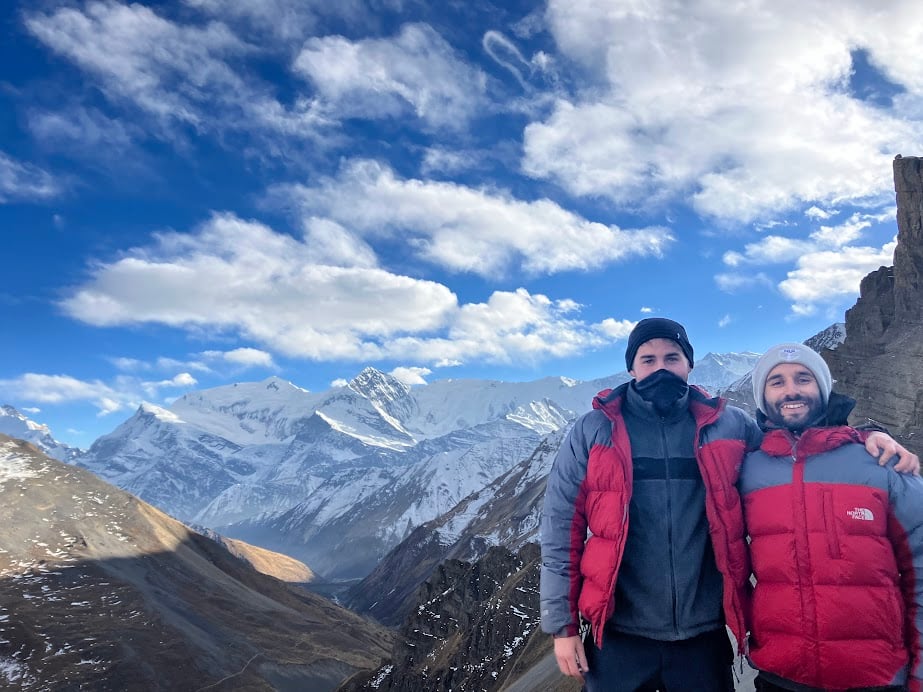
Do You Want to Travel FOREVER??
Pop your email in below to get a FREE copy of ‘How to Travel the World on $10 a Day!’.
Where is the Annapurna Region?
A household name when it comes to backpacking Nepal , the Annapurna Conservation Area covers nearly 3000 square miles of stunning terrain, and spans five districts in the central part of the country.
This includes the Annapurna massif, a monstrous range of mountains home to thirty peaks over 6000m. Here you’ll find Annapurna I , the tenth-highest mountain in the world, and the first over 8000m on earth to be summited.
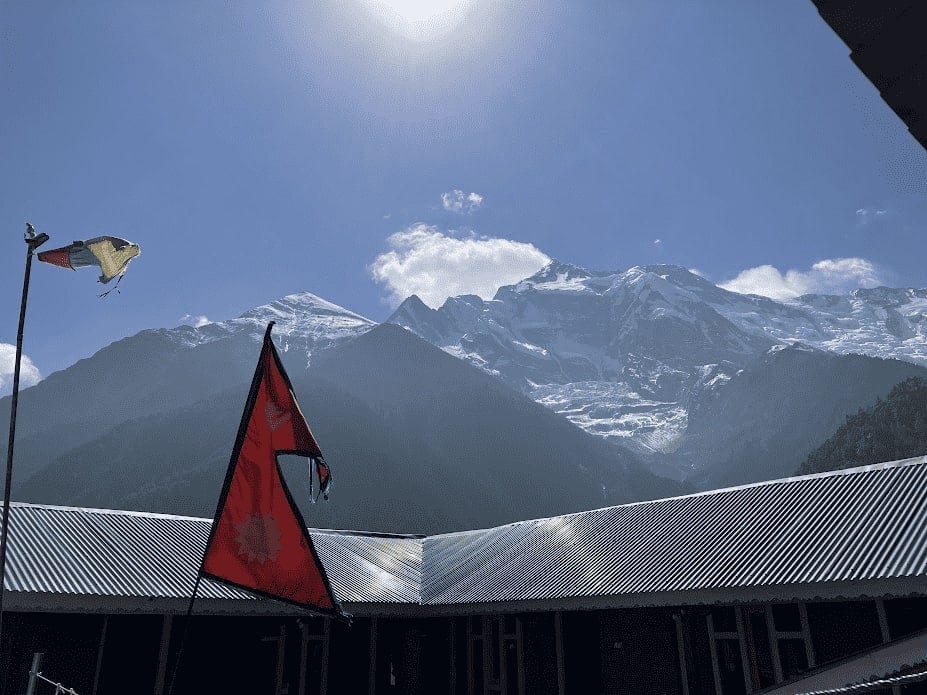
If that’s not enough, the Khali Gandaki gorge – which the Annapurna Circuit weaves through – is believed by many to be the deepest gorge in the world . Across the gorge lies Dhaulagiri , the world’s seventh-highest peak at 8167m.
As you’d expect, it’s a ridiculously impressive and unique part of the world that feels almost ethereal at times.
The starting points for most treks in the area are easily reached from Pokhara . This backpacker hangout is also an ideal place to sort your stuff. Shop for nearly-genuine but well-made outdoor equipment for your foray into the mountains, and stash any surplus travel gear while you’re away.
When is the best time to visit the Annapurna Conservation Area?
There are two main trekking seasons in Nepal: Autumn and Spring .
The Autumn season includes September, October and November , when clear skies should permit superb panoramic views of the jagged skyline. Temperatures are typically quite mild and the chances of heavy snow are relatively low. The trail and teahouses may well be quite lively. Across October, you’d also catch the festivals of Dashain and Tihar , giving rise to an abundance of kites, lights, and bamboo swings.
The Spring season covers March , April and May . As it melts, the preceding snowfall breathes new life into the rhododendrons (Nepal’s national flower), and, like Autumn, the temperatures should be manageable. The weather can be changeable, however. For example, this year, a relatively dry and mild February gave way to heavy snow and extremely nippy weather throughout March. Pack wisely, whatever season you’re aiming for.
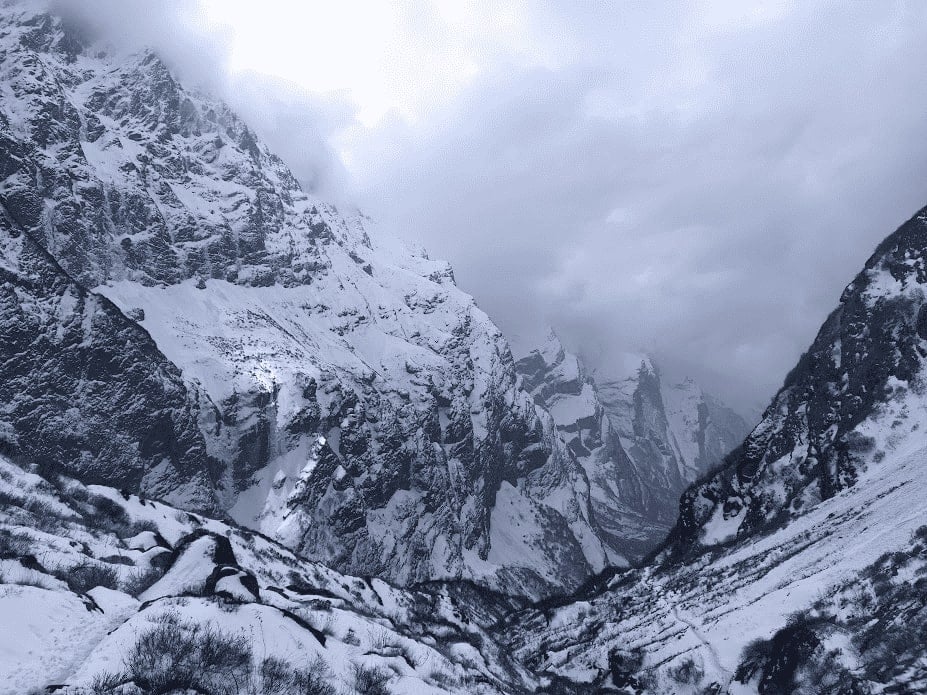
Trekking in Winter is less common, but certainly possible: December, January and February can be uncompromisingly chilly. We’re talking lows of minus 20 degrees Celsius. On the Circuit, be prepared for the possibility of days spent in teahouses waiting for the pass to reopen, and invest in a proper winter sleeping bag (read on for the low down on gear).
But there are enough teahouses that remain open to take on the treks discussed here, and your resolve will be rewarded with clear views of snow-capped peaks and a relatively empty trail.
Last and least appealing, is the monsoon season ( June, July and August) . The rains obscure the views, the trails become sodden and mudslide-y, and the leeches come out to nibble. (If you want to trek in the summertime, you’re better off heading to the Karakoram Mountains of Pakistan , the Indian Himalayan region, such as Ladakh or Himachal Pradesh, or Nepal’s Upper Mustang which is protected from the rains.)
Introducing the Routes…
I would urge you not to overthink which trek to do: the main thing to consider is time, as something like the Circuit takes a good chunk of the calendar, and it’s better not to be rushing around. Each route has its charms and challenges, which are likely to change on each and every journey on foot. Read on and see which takes your fancy.
1. The Annapurna Circuit
The Annapurna Circuit Trek is one of the most renowned and cherished trekking routes in the world, found on many travellers’ bucket lists.
First opened in the late 70s, the circuit takes you high into the Annapurna massif and right to the edge of the Tibetan plateau, crossing the Thorong La Pass at 5417m. This is one of the highest mountain passes in the world . Not too shabby.
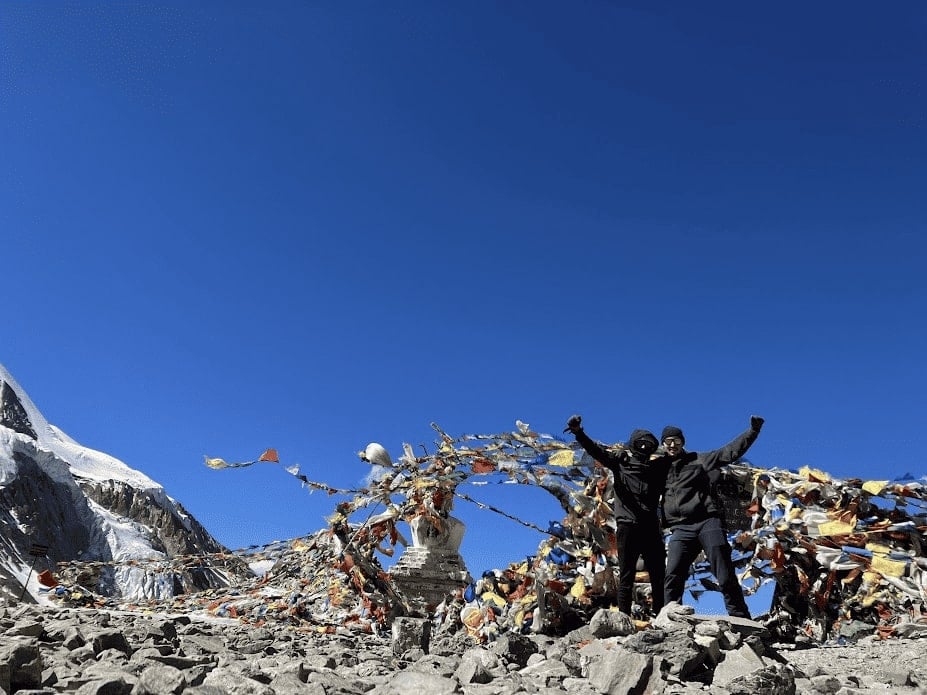
The circuit is a significant undertaking. Completing the full route usually takes around three weeks. However, this can be shortened by taking a jeep up and down the valleys either side of the pass for some of the way…
If you have time, it’s certainly worth going all in by starting in Besisahar and finishing in Nayapul. It’ll be better for both the body and gaining respect from hippie-trail hikers who did it back in the day…
Get ready for a stunning stroll: the Annapurna Circuit is a classic for a reason.
How many days does the Annapurna Circuit trek take?
The full circuit takes around 20 days, while variations on the route can massively reduce the distance covered and time taken to around 10 days.
It may be tempting to skip walking parts of the ‘road’ section, but to be honest, the traffic is usually minimal on the track and the views are still excellent so don’t be too quick to hop in a 4×4. Climbing from the original start point of Besisahar or nearby will pay dividends in terms of acclimatisation.
Suggested Annapurna Itinerary and Notes
The trail is well supplied, with teahouses scattered relatively frequently along the path. The below table contains a suggested itinerary but can also be used to plan your own, using the village names, altitude and distances between them.
Keep things flexible on your trek, both by stretching, and building in some leeway in case you need an extra day of acclimatisation (or just don’t fancy leaving the hot springs in Tatopani).
How do I visit Tilicho Lake?
On the Annapurna Circuit, you’ll have the option for an out-and-back trip to Tilicho Lake, the highest glacial lake in the world !
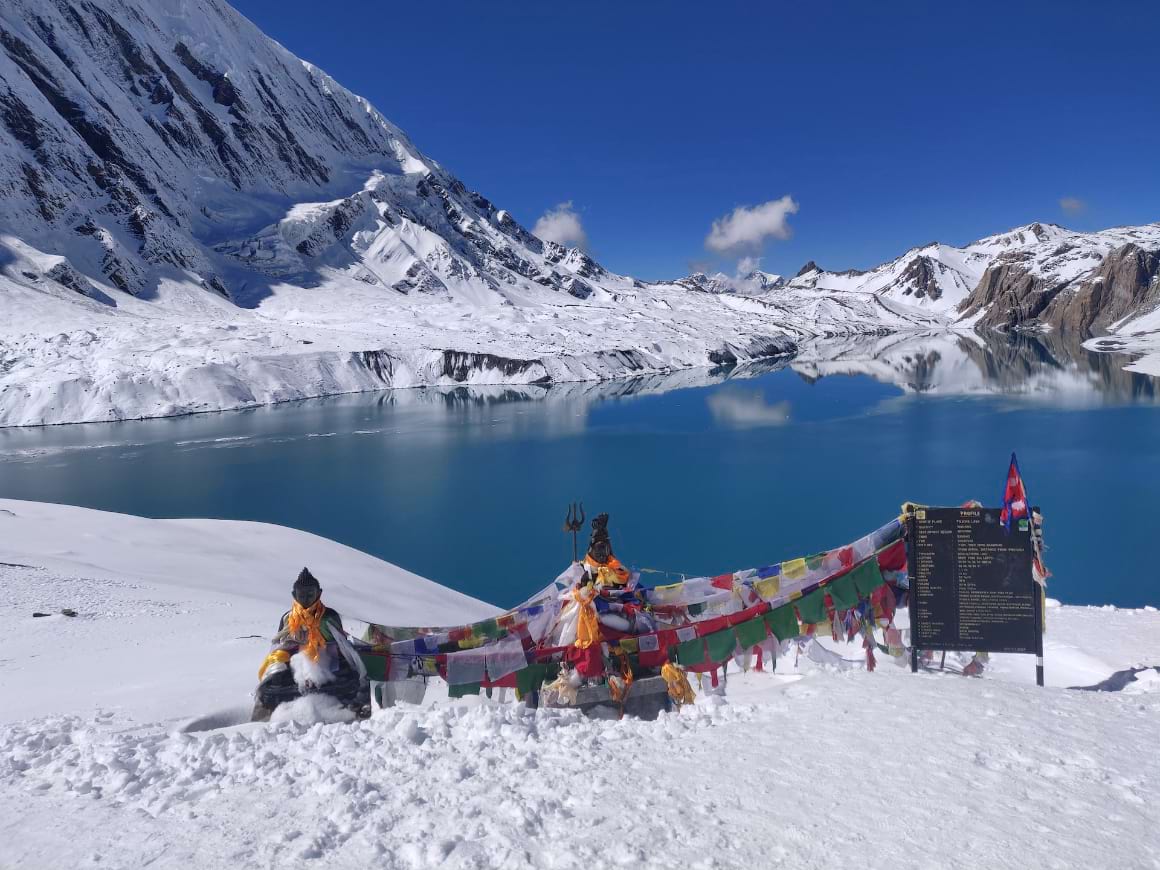
It’s not an easy side-quest. You’ll start from Manang at 3519m, and climb up to above 4900m to reach Tilicho, usually over two or three days. Along the trail you’ll find Shree Karka and Tilicho Base Camp for overnighting, as you can’t stay at the lake itself.
In winter, don’t be too surprised or disappointed if the water is frozen…it’ll still be a wicked couple of days out.
2. Annapurna Base Camp (Annapurna Sanctuary)
The Annapurna Base Camp lies right in the heart of the ‘Annapurna Sanctuary ’ which is a protected area but not an official Nepali national park .
The full trek can be completed in around a week, covering 100km and reaching 4130m, although route variations can be made.
This place is something special, both physically, and culturally. Held as sacred by the Gurung people, this glacial basin is only accessible via a thin pass between the peaks of Hiunchuli and Machhapuchhre .
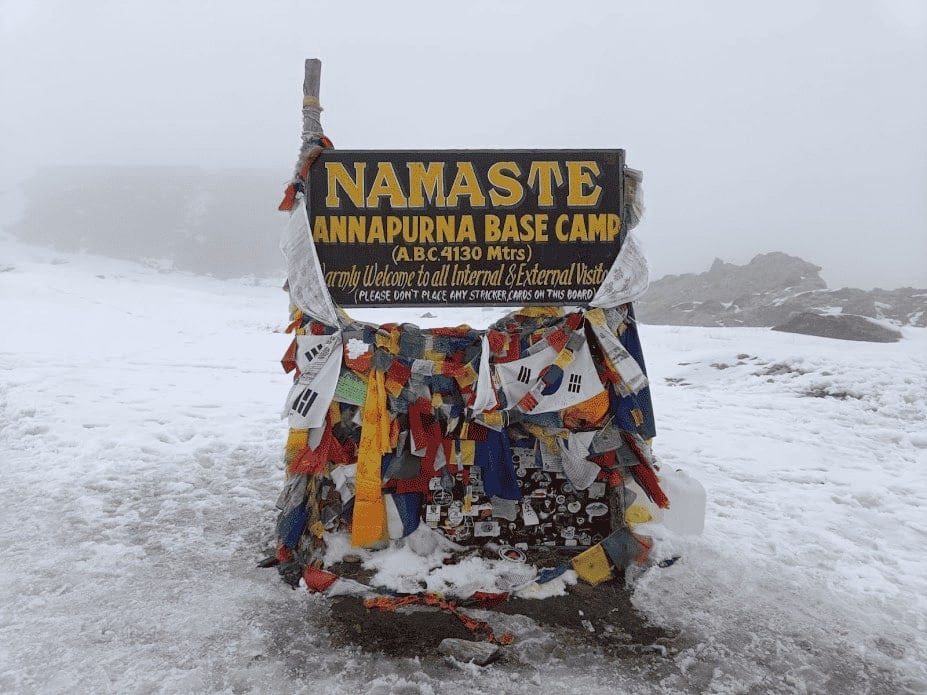
The Base Camp itself can feel quite bizarre. You’ll find statues of climbers lost on epic expeditions in years gone by, yet today, you might wake up to skiers and wedding parties being dropped off by helicopter to catch the morning sun…
However, you’ll sip your chai with a sense of satisfaction having reached this surreal spot on foot and braving the weather. Watching the sunrise hitting the dramatic skyline is a just reward for taking on this outstanding Nepali adventure.
How many days does the Annapurna Base Camp (Sanctuary) trek take?
The Annapurna Base Camp trek can take between 7-10 days, depending on fitness, whether you’ve previously acclimatised to the altitude, and route options. See the suggested itinerary below for inspiration, but don’t be afraid to use the list of villages to create your own plan (being mindful of altitude gain).
Suggested Itinerary and Notes
It would be very difficult to get lost on the Annapurna Base Camp trek, as all villages tend to lie on the single trail leading to the basin. A list of places to stay can be found below.
Popular ‘linkages’ include adding on a day at Ghorepani for a sunrise at Poon Hill, or joining the Base Camp route at Ghorepani having completed the Annapurna Circuit anti-clockwise.
These options are noted on the table below.
3. Mardi Himal
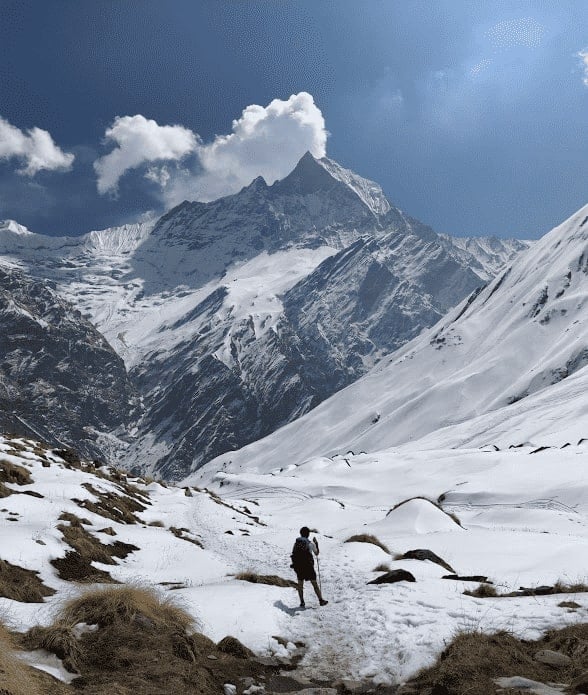
Mardi Himal is a relatively new trekking route, and it’s an absolute cracker.
On the Annapurna Base Camp trek, you look across the valley at an imposing landscape that appears unattainable. This is where the Mardi Himal route takes you.
Passing through rich rhododendron forests, you’ll eventually reach the High Camp teahouses, which seem to be dotted precariously on the ridgeline. It’s a truly remarkable place , and the final push to Mardi Himal Base Camp is equally majestic.
Plus, if you’re short on time, the trek can be completed in well under a week, and the Himalayan views are up there with the very best to be found.
What’s not to like?!
How many days does the Mardi Himal trek take?
The Mardi Himal trek is usually completed in 4 days. The elevation gain is quite fierce if you head straight from Forest Camp to High Camp, so if you’re struggling at all with fitness or the altitude, add in an extra sleep at Low Camp.
For the immersion in the mountains you’ll be rewarded with, this it’s a superb shorter trek option that’ll take you up to 4500m.
Like with the other routes discussed, you can use the following list and a paper map to devise your own plan, however, you can’t sleep at the Base Camp, so sleeping at High Camp is certainly the best option.
The itinerary for the way back just depends on personal preference and speed, but don’t go so quick you miss savouring the views.
After an early out and back to Mardi Himal Base Camp, you can then stay again at High Camp.
Alternatively, there’s certainly time to continue back down the trail towards Low Camp, or even get a 4×4 back to Pokhara that same evening from Sidhing (public bus from Lumre) if you’re speedy.
Beware, in the depths of winter or otherwise, if the snow is thick, it may well be that reaching the Base Camp isn’t possible and that the Upper Viewpoint stops you in your tracks. The trail can easily disappear in the snow and clouds, and it can become unclear what is solid ground and what is the edge of a steep drop.
Don’t take stupid risks at this point in trying to push on. Even if the viewpoint is the furthest trekkable point, it’s still super exciting being up on the ridgeline freshly covered in snow.
The Mardi Himal Trek is gaining in popularity, and rightly so. It almost feels as though you can reach out and touch Machhapuchre (‘fishtail’) from the upper reaches of the trail, while the dense forest below provides some cool variation in terrain.

We’ve tested countless backpacks over the years, but there’s one that has always been the best and remains the best buy for adventurers: the broke backpacker-approved Osprey Aether and Ariel series.
Want more deetz on why these packs are so damn perfect? Then read our comprehensive review for the inside scoop!
A Few Other Options in Annapurna Region…
Here’s a quick overview of some other trekking routes in the region to consider. There are so many ridiculous spots in this area, grab a map and head somewhere – it’s likely to be a winner.
4. Manaslu Circuit
An epic 12-14 day excursion over the Larke Pass, reaching 5100m . This route is more expensive than the Annapurna Circuit, as additional permits are required.
These include the Annapurna Conservation Area Permit (needed for the ABC, ACT and MH treks too), the Manaslu Conservation Area Permit (MCAP), and a Restricted Area Permit (RAP). During the Autumn season (September to November), the RAP is $100 for the first week and then $15 for each extra day in the restricted area.
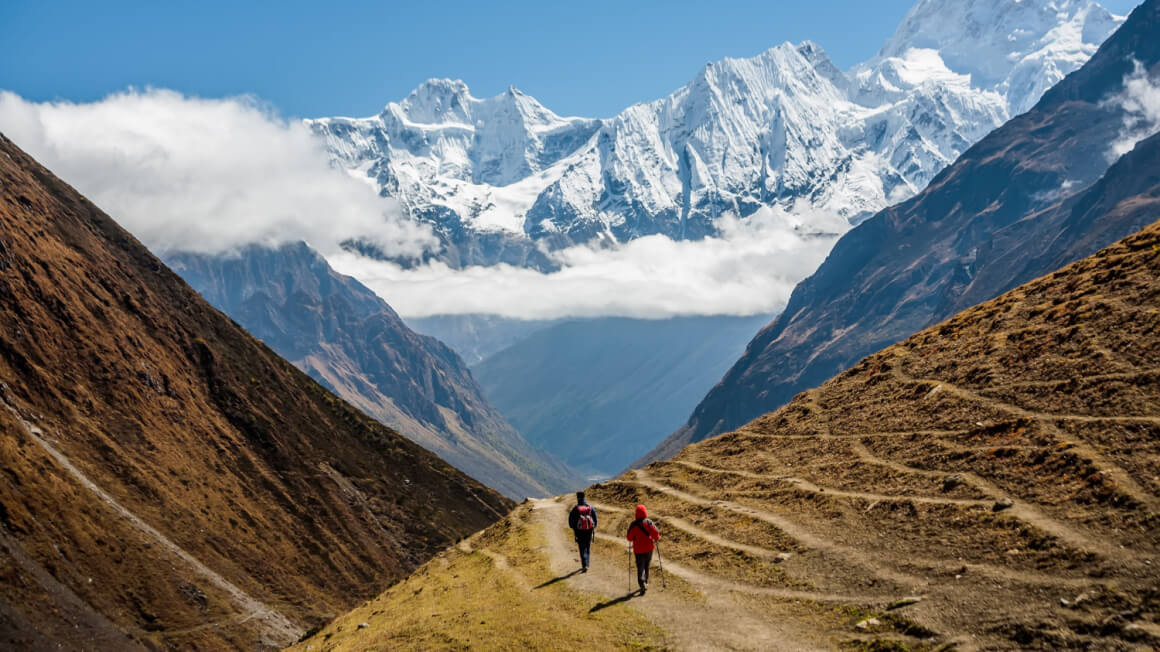
These figures are lowered to $75 and $10 for the rest of the year. It’s also rightly essential to take a guide on this route – this was always the case, well before the recent rule changes, due to the area being restricted and more remote than other routes.
If you’re able to shell out for the permits and guide, this beast of a trek is guaranteed to be a grand adventure.
5. Poon Hill
Poon Hill is an introductory-level trek, over 3 or 4 days. The climax is waking up early in Ghorepani to witness sunrise at Poon Hill, offering panoramic views of both Annapurna and Dhaulagiri.
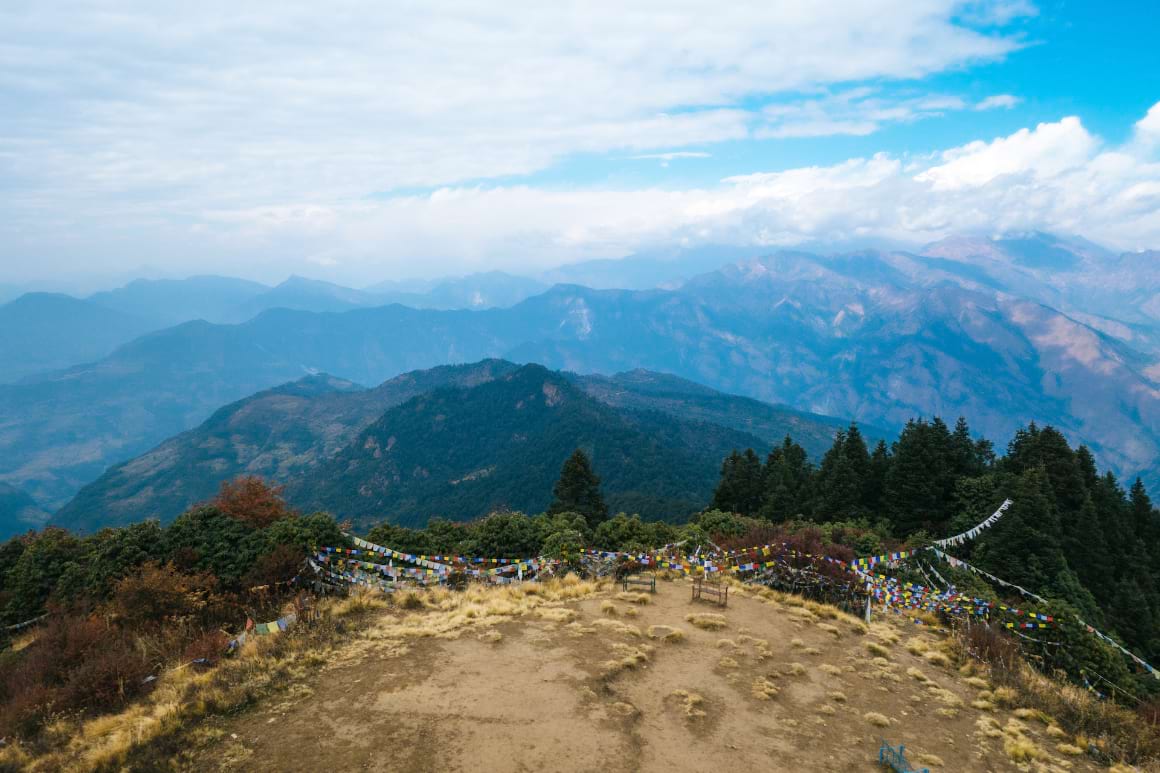
Be ready for a chunky number of stairs on the first day from Nayapul, and some potentially busy trails: this route can become quite a highway in busy season. But if you’re short on time or new to trekking, the reward/effort ratio is strong as the views are still spectacular.
6. Mohare Danda
A fantastic alternative option for a short trek, just outside the Annapurna Conservation Area, which requires no permit or guide! The route is much more off the beaten path than the likes of Poon Hill, which means quieter trails, more peace and lower costs. It is outside the Annapurna Conservation Area, but still affords enviable views of the Himalayan ranges.
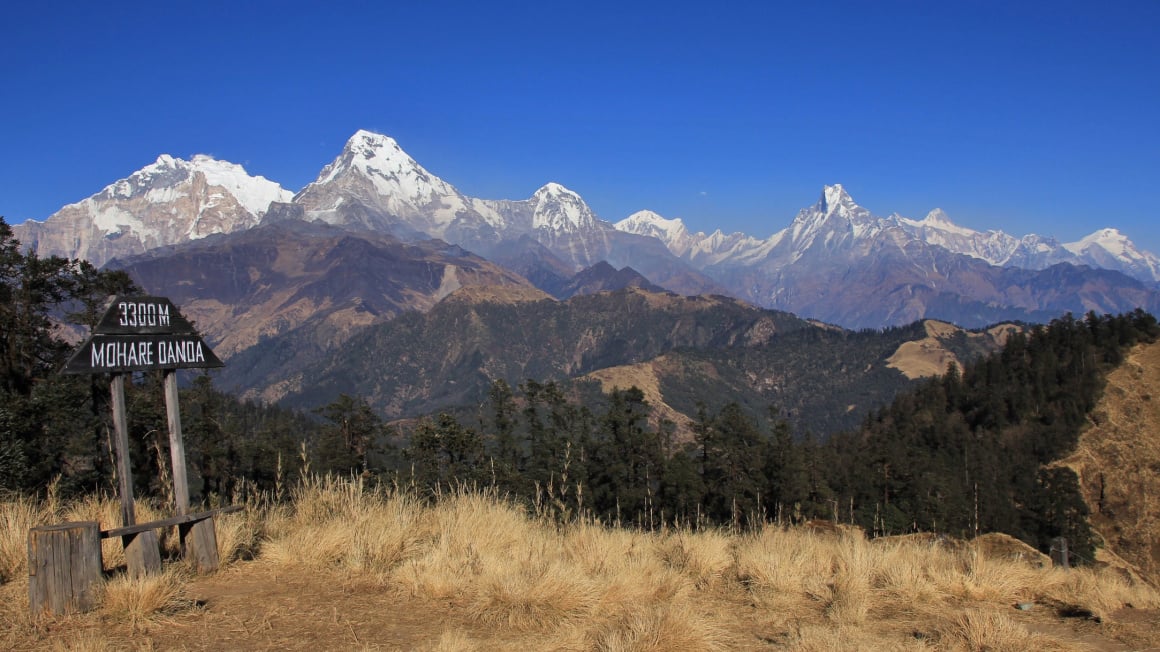
This 3-4 day route is reached from Pokhara by taking a bus to Beni. The trek peaks at the 3300m station of Mohare Danda (‘Danda’ is equivalent to hill in Nepali) for a scenic sunrise across Annapurna and Dhaulagiri. Finish in Tiplyang (buses run back to Pokhara).
This local outing should not be overlooked!
Once you’ve got the hang of it, why not try and construct your own route? Be mindful of the permit zones – this is easier outside of the Annapurna Conservation Area – but don’t be afraid to head to places off the tourist trail.
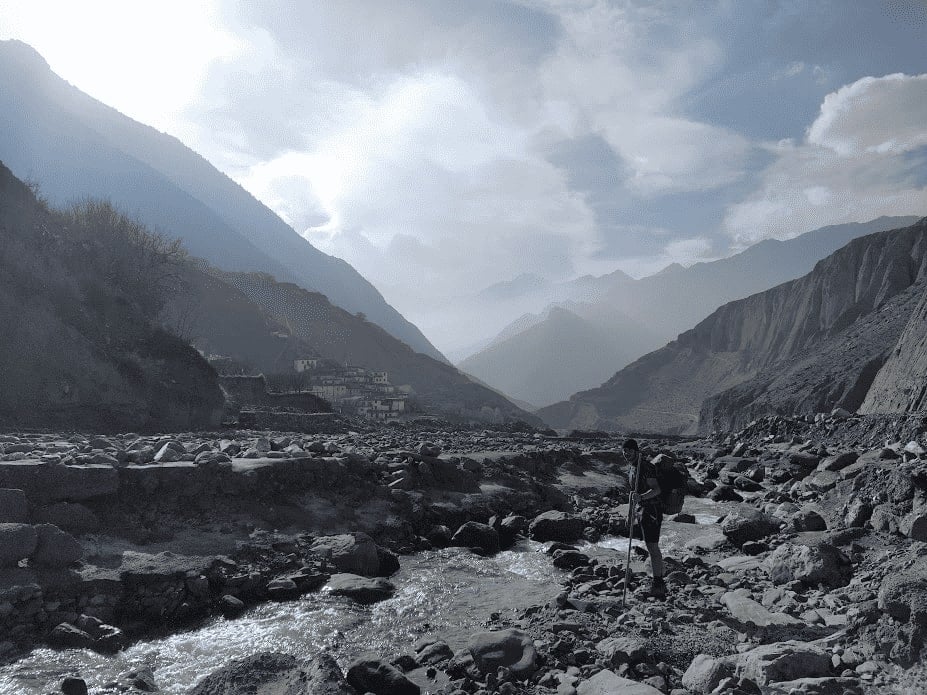
Spending 10 days on foot in the mid-hills between Pokhara and Kathmandu was one of the best travel experiences I’ve ever had. The kindness of Nepali villagers means you’ll be treated like family, and after your trip, longing to return soon!
Permits, Rules and Regulations
In April 2023, new rules were introduced that compel all trekkers to hire a guide when undertaking treks in the Annapurna Conservation Area. This decision was made citing (reasonable) safety concerns for FITs (‘free independent trekkers’), but remains controversial. This means there are three things to sort out for the routes covered in detail here: a TIMS card , an ACA permit , and a guide .
On the usual trekking trails, there are ‘checkpoints’ in certain villages, where you’ll have your ACAP permit checked and stamped (this has always been the case, before the new rules were introduced).
You must obtain this permit before starting the trek, at the Immigration Offices in either Pokhara or in Kathmandu (opening hours are reduced during off-seasons; check on the door in advance of your trek). This is also where you’ll grab your TIMS card. Take your passport, insurance policy details, and passport photos if you have some (if not, you can usually get them taken in the office for free).
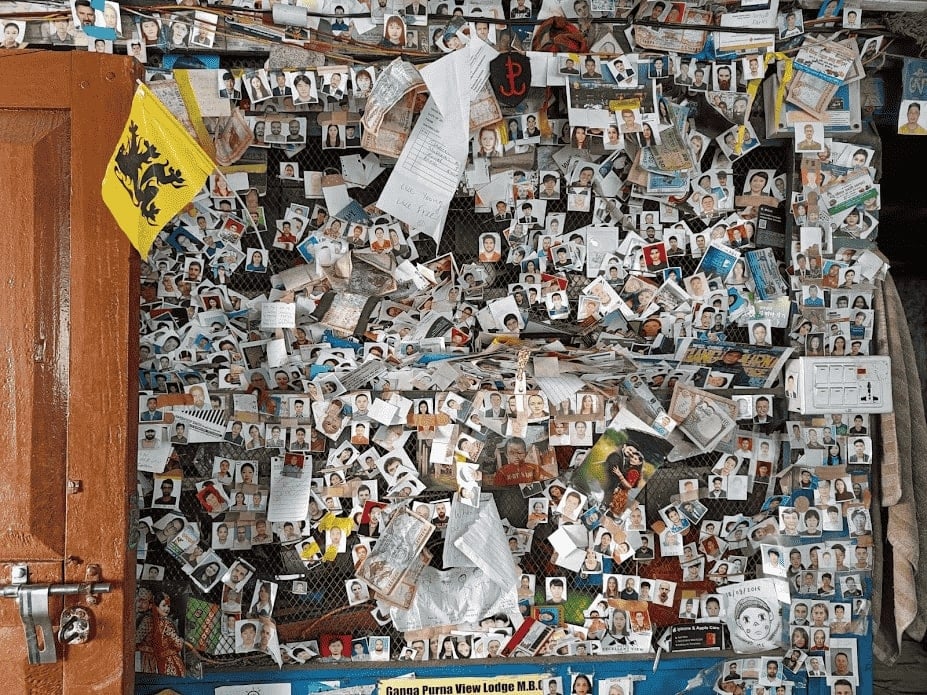
The ACAP costs 3000 rupees and the TIMS card 2000 rupees, for a total set-back of around $38.
In addition, hiring a guide can cost between $20-40 per day, meaning the new rules add greatly to the backpacker’s budget.
On one hand, the news rules seem to benefit trekking agencies. On the other hand, many teahouses and local restaurants are concerned less FITs will lead to reduced income for their businesses and families.
However, some trekkers have recently been completing the circuit independently, and reported having no issues at all when getting their permits checked, despite being guideless. This is obviously not guaranteed, and the situation is likely to evolve over the coming months and seasons.
The Annapurna Circuit Trek group on Facebook is a useful source for the latest deets on what’s happening week-by-week .
Here are some commonly raised pros and cons of hiring a guide:
- You’ll gain added insight into Nepalese culture and history.
- You’ll have experience and expertise on hand for navigating more risky areas like the Thorong La Pass.
- Guides will usually help organise permits and the trekking itinerary – less admin for you.
- Significantly increases daily costs (extra $20-40 per day).
- Limited flexibility on schedule in case of altitude sickness or individual preference (particularly if in a group).
- Guides often have deals with tea-houses that may limit your choice.
Preparing for your Annapurna Trek
Preparing for a big trek may seem like a daunting task. There are things to prepare, like gear, route-planning and some permit-related admin.
Fortunately, you don’t need to be a sponsored athlete, master orienteer or avid form-filler to swiftly get your ducks in a row and be ready to head high into the mountains.
Aside from gear, it’s also extremely important to be aware of weather conditions before hitting the trail or even starting the trek. On 14 October 2014, a record-breaking storm dumped nearly 1.8 meters of snow in the Annapurna region which led to a series of devastating avalanches that resulted in the deaths of at least 43 people, 21 of these trekkers.
While mountain weather can change quickly, I highly recommend having a satellite device with you, and to ensure you get updates on conditions at each teahouse you stop at.
What should you pack for Annapurna trekking?
Firstly, if you’re reading this on the bus and realise you’ve left something at home on the bed, rest assured you can find all you need for trekking at the shops in Pokhara or whilst backpacking Kathmandu .
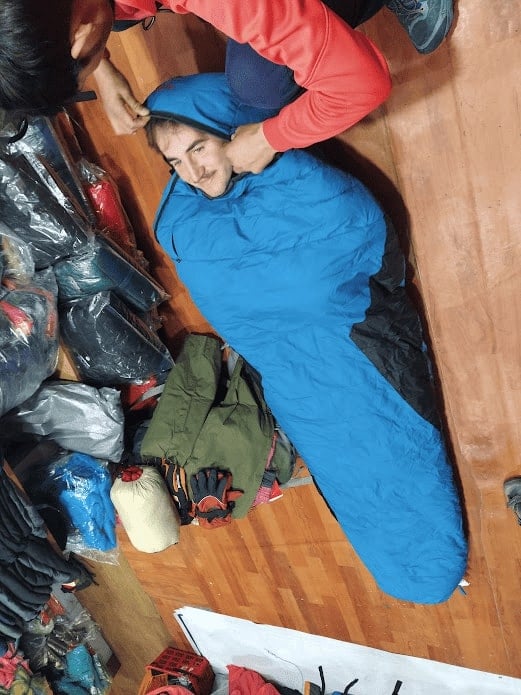
What to pack exactly will depend on personal preference and weather. Use the list below as a checklist.
A word of warning/comfort: don’t pack a different t-shirt for every day, there’s simply no need.
If desired, you can hand-wash items along the way and dry them above the fire in a teahouse, but nearly everyone stinks to high heaven by around day eight, so don’t overly stress. You’ll be in good – probably nose-blind – company.
If you’re looking to make a long-term investment in some clothing for multi-day hiking, check out merino . It’s a breathable, temperature-regulating and odour-resistant blessing for backpacking in colder climates.
There’s usually a healthy supply of gear circulating in the hostels on Lakeside, with backpackers selling, trading or giving away items after finishing their treks. Kiwi Backpackers Hostel on 5th Street is a hub of backpacker activity, and one of the best hostels I’ve ever stayed in.
What to Pack for an Annapurna Trek:
Here’s exactly what you should bring on any trek in the Annapurna Region.
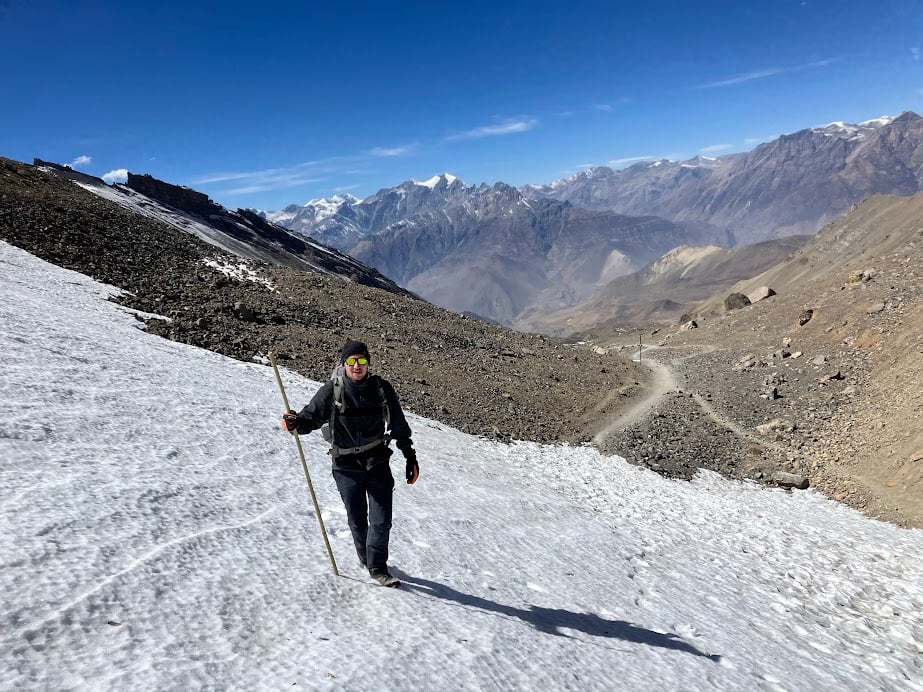
- Osprey Aether Backpack : Sturdy and comfy, with good support and a rain cover. It’s truly the best pack out there.
- Clothing : (Ideally) lightweight, quick-drying shirts, trousers, and shorts.
- Base layers : It can be numbingly chilly at the high points of each route.
- Mid Layer(s) : Go for fleece or soft shell.
- Arc’teryx Beta AR Jacket : Or hiking poncho (good for keeping cool).
- Waterproof Trousers : Ideally can be put on over shoes.
- Patagonia Down Sweater Hoodie : Like a portable hug.
- Hat and Gloves : Sun hat if desired; warm beanie and gloves for higher elevations.
- Abaco Sunglasses : Protect your eyes!
- Water Bottle(s) : At least two litres of capacity.
- Marmot Never Summer Sleeping Bag : Rated at 0F and -18 C, you can’t be better prepared than with this epic bag.
- Water Treatment : Purification tablets or a water filtration system (like the Grayl Geopress).
- First Aid Kit : Grab basic medications and blister treatment from a pharmacy before leaving. Consider Diamox (see altitude section).
- Lip Balm : Chops may otherwise become drier than a moth sandwich.
- Headtorch : With spare batteries/ charger. A real adventure isn’t complete without one.
- Sunscreen : High SPF for sun protection.
- Hanging Toiletry Bag : Toiletries themselves are cheaper in Pokhara than on the trail.
- Physical Map : Found all over the place (shops, hostels, etc).
- Micro Fibre Towel : Compact, dries fast and gets the job done.
- Footwear : More to follow…
- Black Diamond GTX Gaiters : Particularly if wearing low-rise walking shoes or trail runners.
- A good travel camera : The scenery justifies the extra weight.
- Black Diamond Carbon Trekking Poles : Can be an absolute boon on uphill sections. Alternatively, pick up a sturdy bamboo stick en route, with which you will become inseparable.
- Kahtoola Microspikes : ‘Micro-spikes’ can be found cheaply in Pokhara. Highly recommended in Winter.

Wanna know how to pack like a pro? Well for a start you need the right gear….
These are packing cubes for the globetrotters and compression sacks for the real adventurers – these babies are a traveller’s best kept secret. They organise yo’ packing and minimise volume too so you can pack MORE.
Or, y’know… you can stick to just chucking it all in your backpack…
Can I rent rather than buy gear for my Annapurna Trek?
Yes ! The trekking shops on Lakeside in Pokhara and Thamel in Kathmandu will allow you to rent all sorts of gear without breaking the bank.
A down jacket and sleeping bag will each cost around 150-200 rupees to rent per day ($1.15-$1.50), and if you want to stay out in the mountains for longer than planned, you can usually just pay the difference on returning. (Just in case, take photos of the condition of the gear you hire as you leave the shop.)
What footwear is best for Annapurna trekking?
A hotly debated topic.
What type of footwear to go for is largely down to personal preference, within the reasonable bounds of frostbite prevention.
Hiking boots are the most popular choice, as they provide top-notch ankle support, superior weatherproof protection in case of snow, and shielding from rocky ground beneath. Be sure to wear them in advance though, to prevent a blistery first few days on the trail.
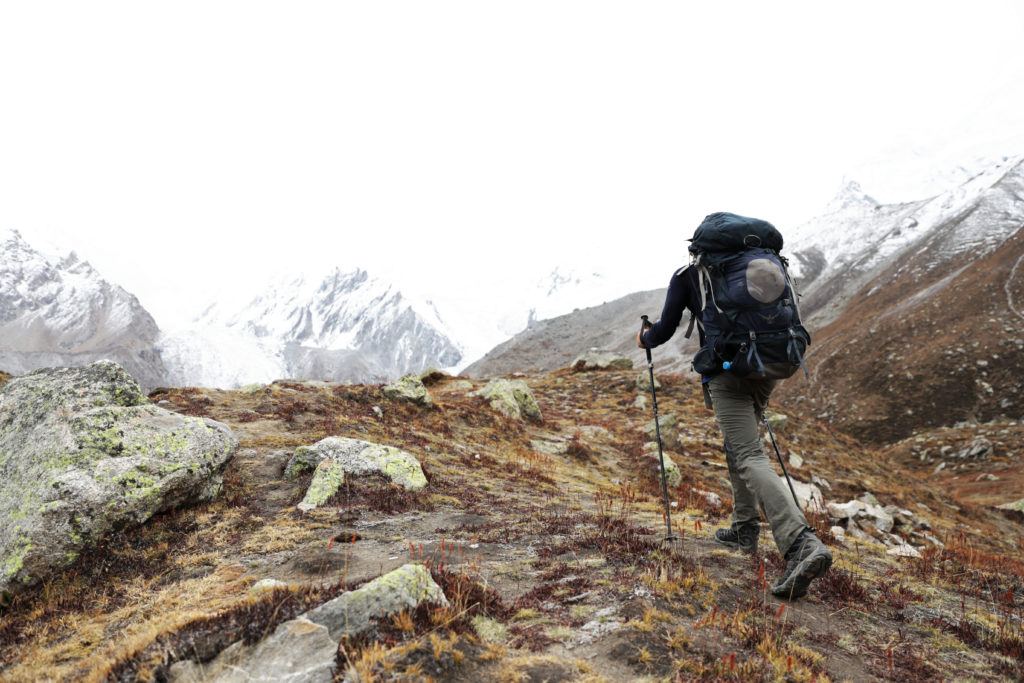
Boots are a shrewd choice. However, they can feel clunky, and you may find yourself hankering for something more nimble.
An increasing number of trekkers are using trail running shoes, when not in the depths of winter. A pair of waterproof (look for Gore-tex) trail running shoes can provide solid support while remaining light and agile. You’ll want a pair with deep treads (grip) on the sole and a sturdy construction. Combine with a pair of gaiters in case of snow.
Chuck in some flip-flops/ jandals/ slippers for downtime in the teahouses. Your feet will be eternally grateful.
Why You Should Travel With a Water Bottle
As travellers, we have a joint responsibility to reduce the environmental impact of our excursions, and plastic waste is one of the biggest problems facing Nepal’s Annapurna Region.
Travelling with a filtered water bottle is a wise move. There’s no better option than the Grayl Geopress: this water bottle and filter system removes all manner of threat, including viruses and heavy metals – no mean feat. This bottle is a popular choice amongst trekkers and backpackers in Asia.
It’ll last for years, reduce plastic waste, and save you money. The Grayl Geopress is a sound investment for anyone taking on some Annapurna trekking.

Drink water from ANYWHERE. The Grayl Geopress is the worlds leading filtered water bottle protecting you from all manner of waterborne nasties.
Single-use plastic bottles are a MASSIVE threat to marine life. Be a part of the solution and travel with a filter water bottle. Save money and the environment!
We’ve tested the Geopress rigorously from the icy heights of Pakistan to the tropical jungles of Bali, and can confirm: it’s the best water bottle you’ll ever buy!
Life on the Trail
Are there places to stay on an Annapurna Trek?
On all treks discussed in this guide, there are a plethora of accommodation options available. This means you won’t need a tent or shelter to take on these Annapurna treks. Luxury!
These are in the form of teahouses – some large, some small – and you’ll find them in the villages along the trails, plus some extras dotted in between.
What’s more, your room for the night is usually offered very cheaply or even for free, provided you eat dinner and breakfast at the teahouse where you stay. Here are a few things to keep in mind when choosing your residence for the night:
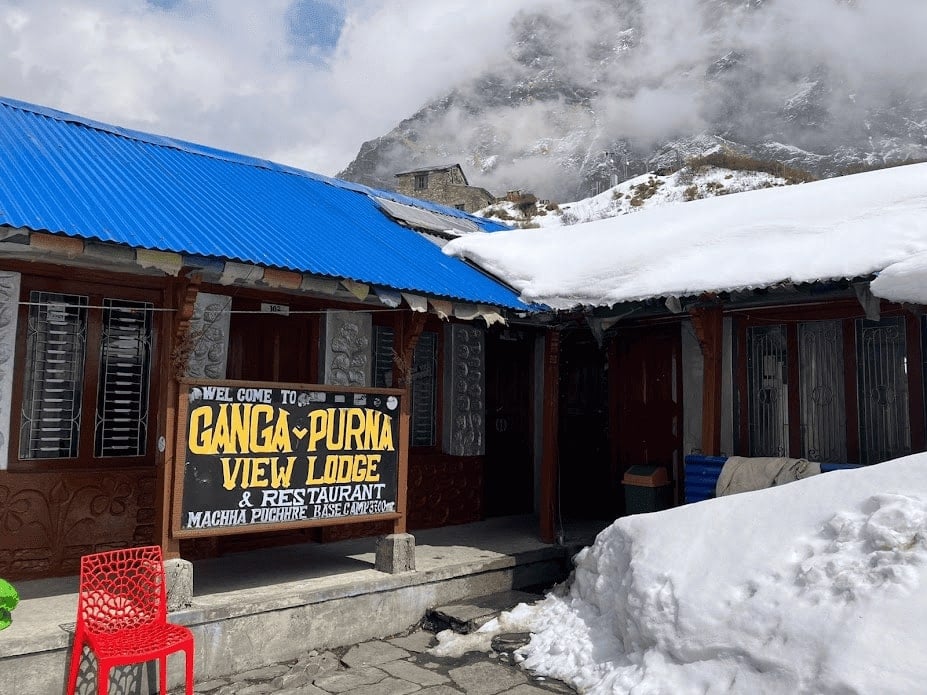
- Check out the views for sunrise and sunset!
- Ask if using a hot shower, wi-fi and e lectricity is available and included in the rate agreed, or whether you’d have to pay extra. You can often strike a ‘package deal’ if you chat to the owner.
- If it’s cold, a fire to sit around is an unrivalled treat. (Even if it’s a yak dung inferno..)
- Of course, the price !
You’ll be given a simple private room for the vast majority of stays, which come with beds, blankets and pillows.
You’re more likely to get a plug socket at lower altitudes. Otherwise, there’ll probably be a shared extension cable in the kitchen area but you may have to pay.
Gas-heated showers can be found throughout the treks, except near the highest points of each route. Toilets are a mix of squat style toilets and Western designs, but take your own loo roll! It grows crushingly expensive further up the hillside, and splashing your behind from a bucket of icy shards in the early hours might not be ideal.
Sitting round the table in a teahouse after a long day’s trek is a quintessential part of a Nepali trekking experience; playing cards and sharing tales with locals and fellow travellers is sure to leave lasting memories to treasure.
What food is available while trekking in the Annapurna Region?
The Nepali word ‘Annapurna’ can be translated as ‘everlasting food ’, which certainly seems fitting when it comes to Dal Bhat.
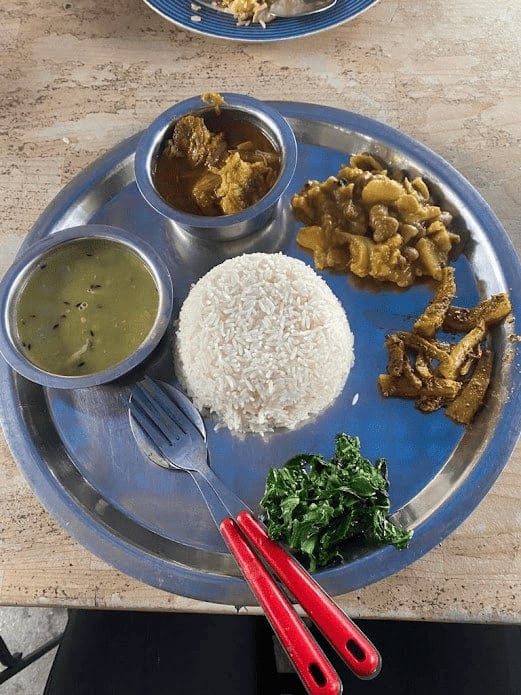
This national dish is a staple for people all across Nepal, and is likely to become a dearly treasured feed when trekking in the Annapurna region.
Dal bhat consists of steamed rice paired with dal (cooked lentils or other pulses), accompanied by a varying array of saag (spinach cooked in spices), papad (poppadom), vegetable tarkari (seasonal vegetables) and pickle amongst other things. You can order small bowls of meat to go with it too.
And, in very healthy news for us lovers of value, most elements of dal bhat can be replenished at no extra cost!
You’ll also find things like fried rice, noodle soup, curry and even some surprisingly good pizza, cooked on a stove. Try thukpa, a classic Nepali noodle soup with a warm broth.
Porridge, omelettes and toast are all usually there too. At least once, give ‘Tibetan bread ’ (or ‘Gurung bread ’) a go, with honey. For breakfast, this is an absolute triumph.
Food is expectedly more pricey than in Pokhara but not outrageously so. See an example menu below, typical of those found on the Annapurna Base Camp trek. For reference, one US dollar is currently equal to around 130 Nepalese rupees.
Dealing With the Altitude While Trekking in Nepal
Trekking in the Annapurna region naturally means you’ll be dealing with some serious loftiness.
For example, Thorong La – the pinnacle of the Annapurna Circuit – is just about the highest mountain pass in the world .
The sub-par oxygen levels found here are likely to have some kind of effect on all trekkers, and the severity of its impact doesn’t seem to be linked to physical fitness. Your gym-obsessed mate could find themselves back of the pack, being overtaken by heavy smokers flying up the hills.
While it’s a bit of a lottery in that sense, there are things you can do to reduce your risk of feeling groggy or worse, which I’ll cover here. Altitude sickness is not something to mess about with, and one of the most dangerous aspects of Nepal , so here’s a breakdown of some key tips and information surrounding AMS , HACE , and HAPE .
What is altitude sickness?
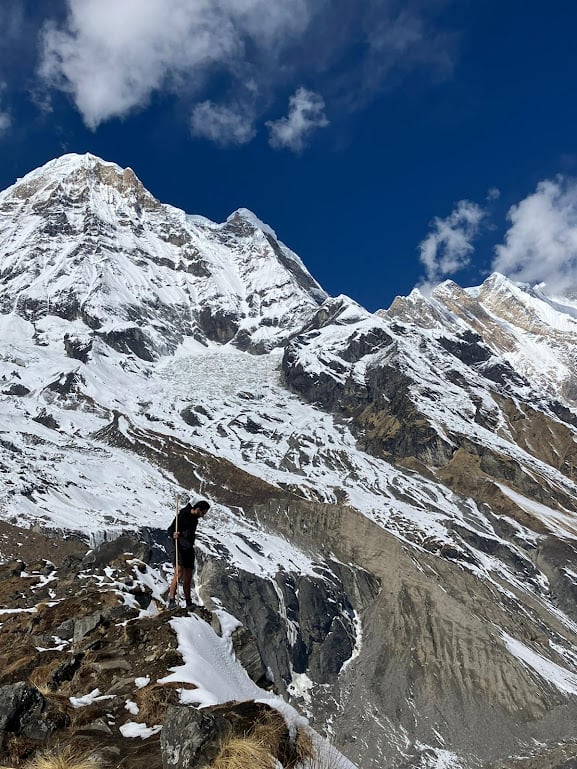
Altitude sickness essentially refers to the ill effects on the body of being exposed to lower levels of oxygen.
Acute mountain sickness (AMS) is the mildest form of altitude sickness, but should certainly not be ignored. Symptoms include:
- Nausea/vomiting
- Loss of appetite
If these crop up, it’s important to STOP ascending. Acclimatisation and rest can give the body sufficient time to adjust to the conditions, before continuing with care.
On the other hand, the more serious high-altitude pulmonary edema (HAPE) and high-altitude cerebral edema (HACE) require rapid descent, and are life-threatening emergencies. HACE refers to fluid buildup in the brain, while HAPE refers to fluid buildup in the lungs.
Symptoms of HACE include:
- Severe weakness
- Acting drunk
- Personality changes
- Balance issues
Symptoms of HAPE include:
- Pink sputum
- Breathlessness at rest
Keep an eye on each other and report any symptoms to mates and locals at teahouses. HAPE and HACE require immediate attention. Descend down the mountain right away, while limiting physical exertion as much as you can while doing so.
How to Minimise Risk of Altitude Sickness:
As mentioned previously, developing symptoms of altitude sickness when trekking is seemingly unrelated to overall fitness. However, there are things you can do to reduce your risk. Here are some tips for trekking in the Annapurna region:
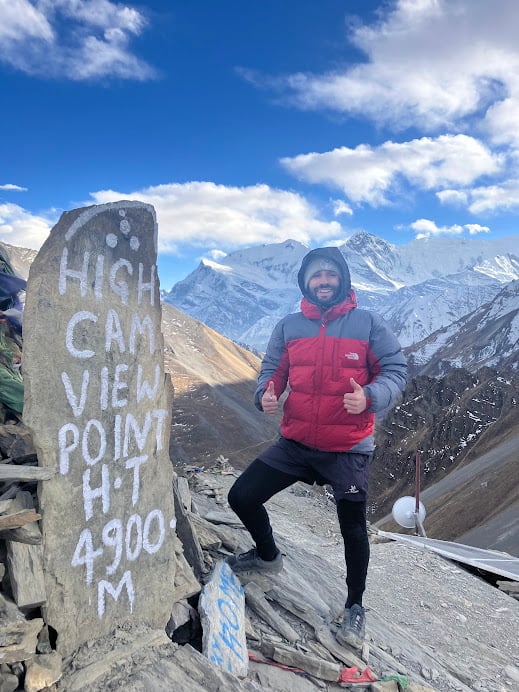
- Limiting daily ascent when above 2500m is the best way to reduce your risk. Ascending no more than 500m a day is optimal, while more may be manageable for some. It’s quite common for trekkers to climb more than this in a day on occasion , but be careful in doing so, and be sure to stop and rest for a day or more if you develop symptoms.
- Drink loads of water ! Increase your intake as you ascend.
- Consider using Diamox (acetazolamide). This is by no means essential, but taking Diamox a day or two before ascending to high altitudes can speed up acclimatisation. (If you have any other health conditions, check with your doctor before doing so). Side effects can include tingling fingers and lips – a quite odd, but not particularly troublesome sensation.
- Keep plans flexible to build in any acclimatisation days that become necessary.
- Walk high, sleep low ! Walking to a new ‘high point’ but sleeping below it when possible can be great for your body.
- Look after your mates ! Check in on one another and keep an eye out for anyone struggling or showing changes in personality.
Getting Insured BEFORE Trekking Annapurna
Altitude sickness is no joke. Make sure you’ve got some good travel insurance before heading up there!
ALWAYS sort out your backpacker insurance before your trip. There’s plenty to choose from in that department, but a good place to start is Safety Wing .
They offer month-to-month payments, no lock-in contracts, and require absolutely no itineraries: that’s the exact kind of insurance long-term travellers and digital nomads need.

SafetyWing is cheap, easy, and admin-free: just sign up lickety-split so you can get back to it!
Click the button below to learn more about SafetyWing’s setup or read our insider review for the full tasty scoop.
How Much Does it Cost to Complete an Annapurna Trek?
This will greatly depend on whether you opt for a ‘package tour’ or not.
For broke backpackers, going without a tour is certainly the more budget-friendly option, and you can easily meet trekking mates on the route itself, or in hostels before setting off.
Without a package tour, a decent budget is around $25-30 per day , excluding the cost of hiring any gear and a guide . Rooms are very cheap ($2-3 per night) or even free when you eat there, so the main daily costs go on calories and any toiletries.
A guide costs around $20-35 a day, which can be shared amongst a group.
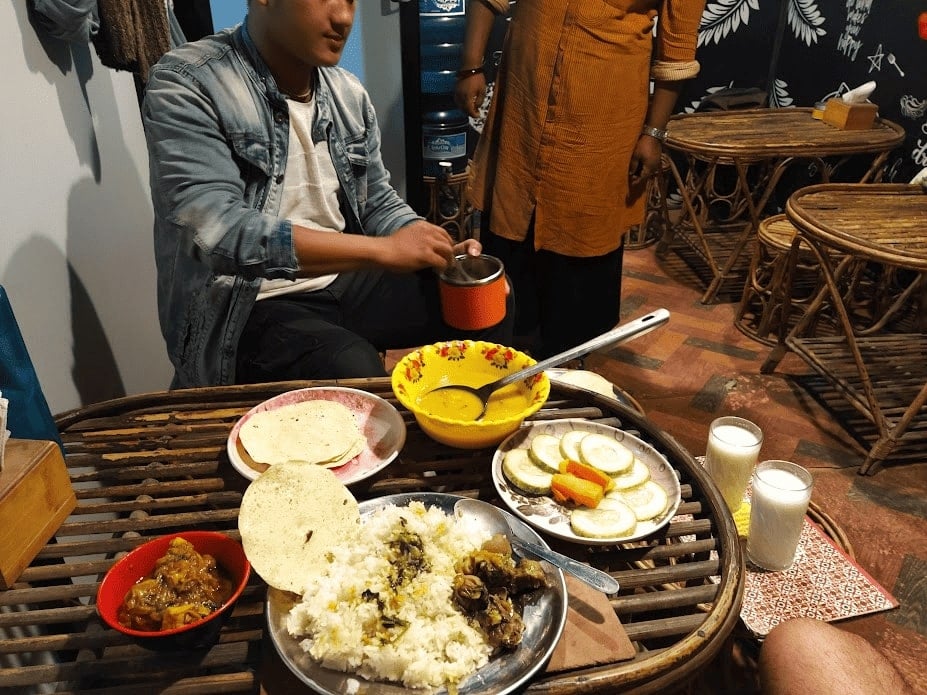
There are no ATMS on the circuit – take more cash than you think you’ll need! You never know if you might need an extra day of rest due to altitude, or fancy the occasional beer. (My mate and I didn’t heed this advice, got addicted to Snickers, and ended up with a budget of $7 each for the last couple of days, which was far from ideal.)
Another key money-saving tip: take your own loo roll! Its price seems to rise exponentially with the trail.
Overall, trekking in the Annapurnas isn’t a great deal more expensive than backpacking in other parts of Nepal, largely thanks to the generous portions of Dal Bhat served up of an evening.
Nepali Customs and Phrases
Travelling in Nepal is an immense privilege. Along with some introductory Nepali to get to grips with, here are some tips to help you remain a conscientious rambler.
- Order food together , and if asked, make breakfast choices the night before. This will reduce the amount of fuel needed to heat food.
- Minimise plastic waste! Take a filter bottle instead of buying water as you go.
- Ask before taking photos of anyone.
- Reduce your meat intake, as most is not fresh and carried up the mountains from lower villages.
- Learn some lingo!
Nepali is not a particularly difficult language to learn for English speakers, especially for a handful of essential phrases. Make an effort and it’ll be hugely appreciated!
- Namaste = hello/ greetings (polite).
- Dhanyabaad = thank you.
- Kasto cha = how are you?
- Ramro cha = it is nice/ beautiful/ good.
- Baya tira = leftwards.
- Daya tira = rightwards.
- Bhaato = ‘path’ or ‘way’.
- Mitho = tasty/delicious.
- Deraye = very (e.g. Deraye mitho = very tasty).
- Pheri bhetaula = see you again.
- Kukhura ko maasu = chicken meat.
- Bhaisi ko maasu = buffalo meat.
- Pani = water.
- Tarkari = vegetable curry.
- Shauchalaya = toilet.
- Kati tadha = how far?
- Tapaaiko nam ke ho ? = what is your name?
- Mero nam —– ho . = my name is ——.
- Bhetera khoosi laygo = nice to meet you.
Final Thoughts on Trekking the Annapurna Circuit
Stuck in a rainy city, fantasizing about booking that travel extravaganza, your mind might conjure up images of pristine beaches and pina coladas. ‘Landlocked’ may not seem conducive to your dreams of a blithe, hostel-hopping existence…
But trust me: central Nepal is as laid back and inviting as anywhere on the planet, offering a simply unrivaled combination of its superb lakeside hostel scene and the best mountainous scenery around. The fact this guide is full of “ Xth biggest/longest/tallest in the world ” says enough in itself.
Memories forged on the trails over endless portions of dal bhat and games of cards are bound to be precious, as are any moments spent in the company of the ever-hospitable Nepalese people. The routes featured in the guide have been found on backpackers’ bucket-lists for generations, for very good reason.
Backpacking has changed greatly in many places in recent years, as mobile data and online bus booking systems abound. Traveling on foot through the mountains, with an actual, physical, paper map is a uniquely gratifying experience that no technological advancement can replace.
Trekking in the Annapurna Region -whether you choose the classic Annapurna Circuit or one of the other majestic options – is guaranteed to be an epic adventure that you should not think twice about booking!
Just don’t forget to wear in your boots first…
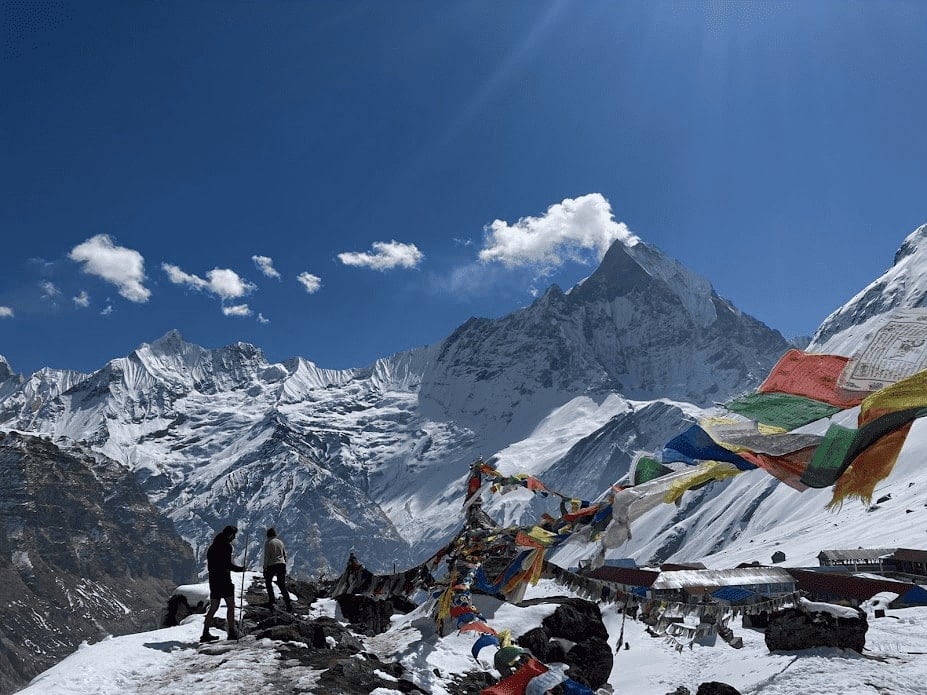
And for transparency’s sake, please know that some of the links in our content are affiliate links . That means that if you book your accommodation, buy your gear, or sort your insurance through our link, we earn a small commission (at no extra cost to you). That said, we only link to the gear we trust and never recommend services we don’t believe are up to scratch. Again, thank you!
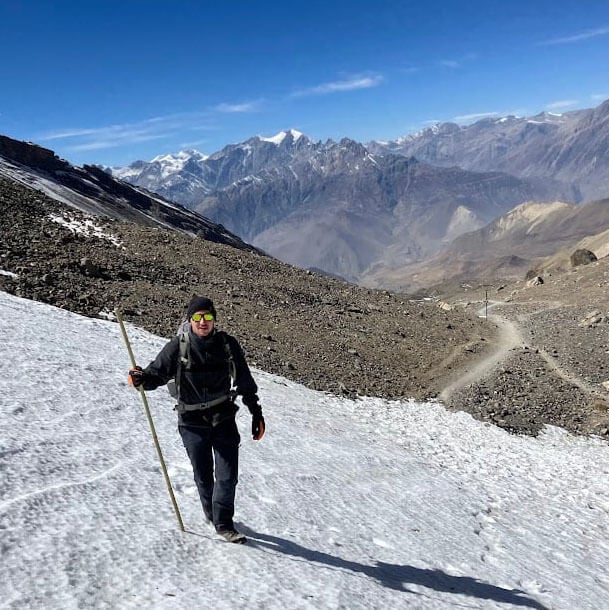
Share or save this post

Leave a Reply Cancel reply
Your email address will not be published. Required fields are marked *
Save my name, email, and website in this browser for the next time I comment.
Notify me of followup comments via e-mail.
Himalayan Odyssey Nepal Trek
Best Himalayan Trekking Agency | 2024
Registration No: [74407/067/068]
Write a review on [Tripadvisor]
+977-(986)096-4103
[Available On: WhatsApp & Viber] Please feel free to contact us 24/7 !
Welcome Traveler's
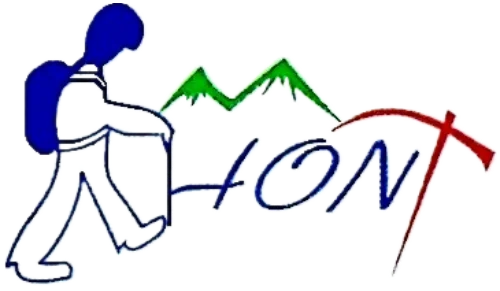
Annapurna Circuit Trek
Annapurna circuit trek | 2024.
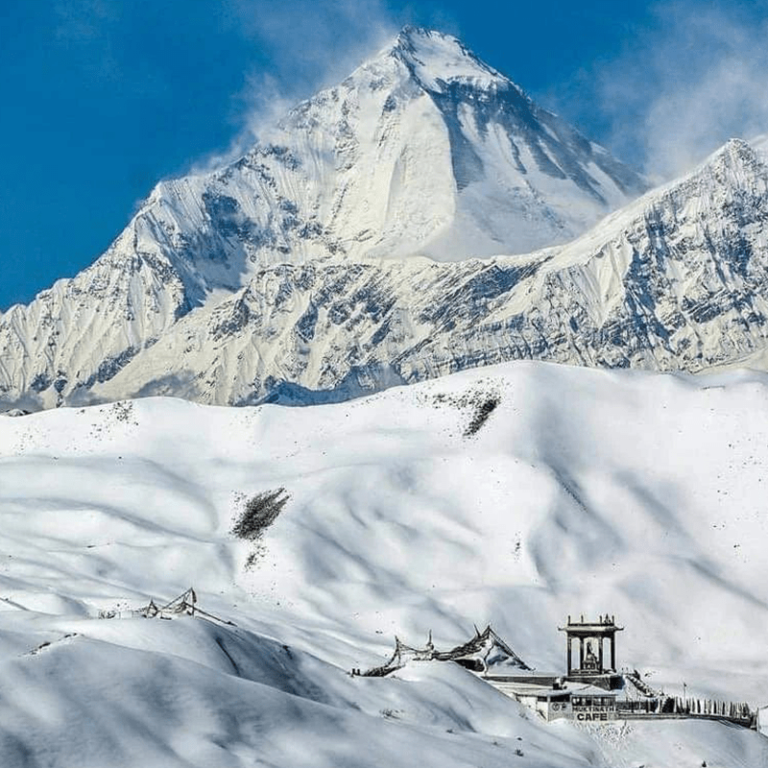
- Trip Duration: 12 Days
- Altitude: 5,416 m / 17,769 ft
- Best time: Feb-May, Sep-Dec
- Grade: Challenging
- Trek Type: Tea House
- Meals: Included
- Accommodation: Hotel & Tea House
Overview of the Annapurna Circuit Trek
The Annapurna Circuit Trek is undoubtedly one of the most extraordinary and unparalleled experiences a trekker can avail themselves of. With an extensive length of 160–230 km that covers four distinct districts, comprising Lamjung, Myagdi, Manang, and Mustang, this trekking route stands out as the most preferred circuit through the diverse natural vegetation, cultural beliefs, landscape, altitude, trail, pristine little settlements, culturally affluent tribal groups, and religious sects.
The trek begins in Jagat. As we gain altitude, the landscape and vegetation change, and rugged alpine terrain appears. The challenge of the trek is to cross the highest pass, Thorong La (5,416 m). The splendid snow-capped Himalayan views from the peak of the Thorong La Pass are just amazing and beyond expectation. Then we follow the trail to Muktinath temple, the temple of God Vishnu, the god of preservation. And the windy Jomsom, and just ahead we pass through the deepest gorge along the Kaligandaki River between Mt. Annapurna and Dhaulagiri. We then trek to the famous Gurung village, Ghorepani, and the famous Poon Hill viewpoint.
Highlights of the Annapurna Circuit Trek
- One of the most classic and oldest treks in Nepal,
- Thorang La Pass is the highest navigable pass (5,416 m) in the world,
- Descend into one of the deepest gorges in the world, the Kali Gandaki,
- Poon Hill is a hill station,
- Traditional Gurung, Tibetan, and other ethnic villages,
- Muktinath is a holy temple of God Vishnu,
- The natural hot spring of Tatopani.
Outline Itinerary of the Annapurna Circuit Trek
KTM ) Arrival in Kathmandu city, transfer to the hotel
Day 01 ) Drive to Jagat (1,300 m) (8/9 hours)
Day 02 ) Trek to Dharapani (1,860 m) (5/6 hours)
Day 03 ) Trek to Chame (2,620 m) (6/7 hours)
Day 04 ) Trek to Pisang (3,200 m) (6/7 hours)
Day 05 ) Trek to Manang (3,540 m) (5/6 hours)
Day 06 ) Acclimatization Day
Day 07 ) Trek to Yak Kharka (4,018 m) (6/7 hours)
Day 08 ) Trek to Thorong Phedi (4,560 m) (5/6 hours)
Day 09 ) Trek to Muktinath (3,767 m) via Thorang-La Pass (5,416 m) (7/8 hours)
Day 10 ) Drive to Jomsom and Tatopani (1,190 m) (6/7 hours)
Day 11 ) Trek to Ghorepani (2,874 m) (6/7 hours)
Day 12 ) Early morning hike to Poon Hill, trek to Ulleri (2 hours) and drive to Pokhara (3 hours)
PKR ) Drive or fly back to Kathmandu
KTM ) Departure to your home
Not satisfied with this itinerary?
Annapurna Circuit Trek: Detailed Itinerary
Ktm) arrival in kathmandu city, transfer to your hotel.
- Meals: Breakfast
- Accommodation: Hotel
- Altitude: 1,400 m, Kathmandu
At Kathmandu Tribhuvan International Airport, you will be received by a Himalayan Odyssey Nepal Trek guide/staff and transferred to your hotel. Stay overnight at the hotel.
Day 01) Drive to Jagat from Kathmandu via Besisahar (1,300 m) (8/9 hours)
- Meals: Breakfast, Lunch, Dinner
- Accommodation: Lodge
- Altitude: 1,300 m, Jagat
We take a drive from Kathmandu to Besisahar by tourist bus. We have breakfast and lunch on the way. The route takes us out of the Kathmandu valley along the picturesque Trishuli River to Besisahar. As we reach Besisahar, we drive towards Jagat by Jeep, following the Marshyangdi River. We will pass several beautiful villages, green paddy fields, and forests until we reach Jagat. Stay overnight at the lodge.
Day 02) Trek to Dharapani (1,860 m) (5/6 hours)
- Altitude: 1,860 m, Dharapani
We are walking on a rocky path next to the Marsyangdi River. We see beautiful waterfalls, green plants, and animals. The path goes up to a village called Tal. We keep going up the valley, using stone stairs, until we get to Dharapani. Stay overnight at the lodge.
Day 03) Trek to Chame (2,620 m) (6/7 hours)
- Altitude: 2,620 m, Chame
The path goes up along a river called Marsyangdi, going through trees like pine and fir. We’ll get to see great views of the mountains Annapurna II (7,937 m), Mt. Manaslu (8,156 m), and other peaks before reaching Chame. Stay overnight at the lodge.
Day 04) Trek to Pisang (3,200 m) (6/7 hours)
- Altitude: 3,200 m, Pisang
After breakfast, we will follow the Marsyangdi Trail to Bharatang. We will see Annapurna II (7,937m) up close from there. Next, we will climb a steep hill where we will see many oak, fir, pine, hemlock, and maple trees. We will have a great view of the Pangida Danda. Then, we will cross a suspension bridge, go up for a while, and then down to the valley floor. We’ll see dry, grazing land and reach Dhukure Pokhari. After walking for about half an hour, we will reach Pisang. Stay overnight at the lodge.
Day 05) Trek to Manang (3,540 m) (5/6 hours)
- Altitude: 3,540 m, Manang
We will start our day by walking on a dry trail where there is little rainfall and many beautiful landscapes. Two paths will take us to Mungi. We can take either of those two. The path that goes through Ghyaru, or Hongde, Ghyaru village on the harder path is especially attractive because of its lovely stone houses surrounded by fields of wheat, barley, buckwheat, potatoes, and beans. We will continue our journey to Ngawal, a village that has an old building called a gompa and ancient juniper trees. Next, we will follow a trail that will take us down to Mungji, where we will meet the other path. From there, we will go to the famous village called Manang. Enjoy looking at the beautiful Annapurna mountain range. Stay overnight at the lodge.
Day 06) Acclimatization Day
Today is the acclimatization day for our body to cope with gaining altitude and avoid any kind of high-altitude sickness. We will take a higher-elevation hike either to the ridge near the Gangapurna glacier or walk up to the cave above Manag village. We will visit the village and native people and gain insight into their lifestyle and culture during our acclimatization day. Stay overnight at the lodge.
Day 07) Trek to Yak Kharka (4,018 m) (6/7 hours)
- Altitude: 4,018m, Yak Kharka
The day starts with an ascent to Tengki, which is the last permanent settlement below the pass. We will walk upward until we reach Gunsang. The trail then turns northwest towards Jharsang Khola Valley. We walk on scrub juniper and alpine grass, which brings us to Yak Kharka. Stay overnight at the lodge.
Day 08) Trek to Thorong Phedi (4,560 m) (5/6 hours)
- Altitude: 4,560 m, Thorong Phedi
After having breakfast, we move towards the Thorong Phedi. We walk for about an hour and reach Churi Leder. We then descend to the river and cross it over the wooden bridge. The trail then becomes challenging as you climb upstream of Jharsang Khola on the ridge of the cliff and finally reach Thorong Phedi. Stay overnight at the lodge.
Day 09) Trek to Muktinath (3,767 m) via Thorang-La Pass (5,416 m) (7/8 hours)
- Altitude: 3,767 m, Muktinath
Today, we will walk through the highest point of the entire Annapurna Circuit. We will head towards the Thorong-La Pass (5,416 m) early in the morning and begin the ascent. The trail is steep and narrow, but if we walk uphill for about 4/5 hours, we’ll get to the top, which is 5,416 m. From there, we can see beautiful mountain ranges like the Annapurna range and the Dhaulagiri range. There are also some chortens and colorful flags that celebrate our hiking success. After taking some photos and enjoying the scenery, we will walk downhill over a rocky area and then through some green fields until we reach a place called Muktinath. Stay overnight at the lodge.
Day 10) Drive to Jomsom and Tatopani (1,190 m) (6/7 hours)
- Altitude: 1,190 m, Tatopani
In the morning, we’ll go to Muktinath Temple and then take a local bus to Tatopani. The ride might be bumpy because the road goes through deep gorges. We’ll go from dry land to green forests. Tatopani is well-known for its hot springs. The hot spring water is believed to be helpful for skin problems. Stay overnight at the lodge.
Day 11) Trek to Ghorepani (2,874 m) (6/7 hours)
- Altitude: 2,874 m, Ghorepani
Today is a long day of walking to Ghorepani. After continuously descending for some days, you will climb today. The trail first crosses the bridge over the Kaligandaki River, which leads us to the junction where we can follow the trail either to Beni or Ghorepani. We will follow the trail, as our destination is Ghorepani. Ghorepani, being a popular destination for both national and international tourists, offers spectacular views of Dhaulagiri and Manaslu Himalayas and the opportunity to hike the most famous viewpoint of the entire Annapurna Region, Poon Hill. Stay overnight at the lodge.
Day 12) Early morning hike to Poon Hill, trek to Ulleri (2 hours) and drive to Pokhara (3 hours)
- Altitude: 822 m, Pokhara
Today is the last day of the trek. We will hike to Poon Hill early in the morning to have magnificent 360-degree panoramic views of the Annapurna and Dhaulagiri ranges with a splendid sunrise view. After spending some time on the hilltop, enjoying the fabulous moments, and keeping a lifetime memory, we will retrace our steps back to the lodge at Ghorepani. After having breakfast, we will head towards Nayapul, which brings the end of the Annapurna Circuit Trek. We will take a vehicle service from here to reach Pokhara, where you can hang around the lakeside area to enjoy your evening. Stay overnight at the hotel.
- Airport pickup and drop-off for arrival and departure
- A total of two nights’ accommodation in Kathmandu (Bed and breakfast) after the arrival and after the trek
- Annapurna Conservation Area Permit (ACAP) fee
- Trekkers Information Management System (TIMS) card fee
- All government, local taxes, and official expenses
- A government-licensed, experienced trek leader (guide), an assistant trekking guide for 8 or more trekkers, and porters to help trekkers with luggage ( *1 porter for two trekkers; the maximum luggage limit per trekker is 14 kg. )
- Guides and porters costs, which include meals, insurance, salary, lodging, transportation, and other necessary equipment
- One-night accommodation in Pokhara (Bed and breakfast) after the trek
- Kathmandu to Besisahar by tourist bus or microbus
- Private transportation: (From Besisahar – starting point of the trek) (From the ending point of the trek – Pokhara)
- All accommodations during the trek
- Three meals a day (Breakfast, Lunch, and Dinner) during the trek
- Arranging rescue operations in cases of complicated health conditions (funded by travel insurance)
- International flight airfare
- Domestic flight airfare (Pokhara-Kathmandu)
- On Arrival Visa Fee at Entry Points: [15 days: USD 30, 30 days: USD 50, 90 days: 125 USD]
- Extra nights’ accommodation and meals in Kathmandu and Pokhara due to early arrival, late departure, or an early return from the trek
- Lunch and dinner in Pokhara
- Personal expenses (shopping, snacks, bottled water or boiled water, hot (tea, coffee) and cold drinks, hot shower, alcohol, Wi-Fi, telephone call, battery recharge fee, extra porters, etc.)
- Personal clothing and gear
- Tips for guides and porters
- Additional costs due to delays caused by circumstances outside company control like landslides, weather conditions, itinerary modifications due to safety concerns, illness, changes in government policies, strikes, etc.
Client Inquiry Form
[natural habitats of the annapurna region].
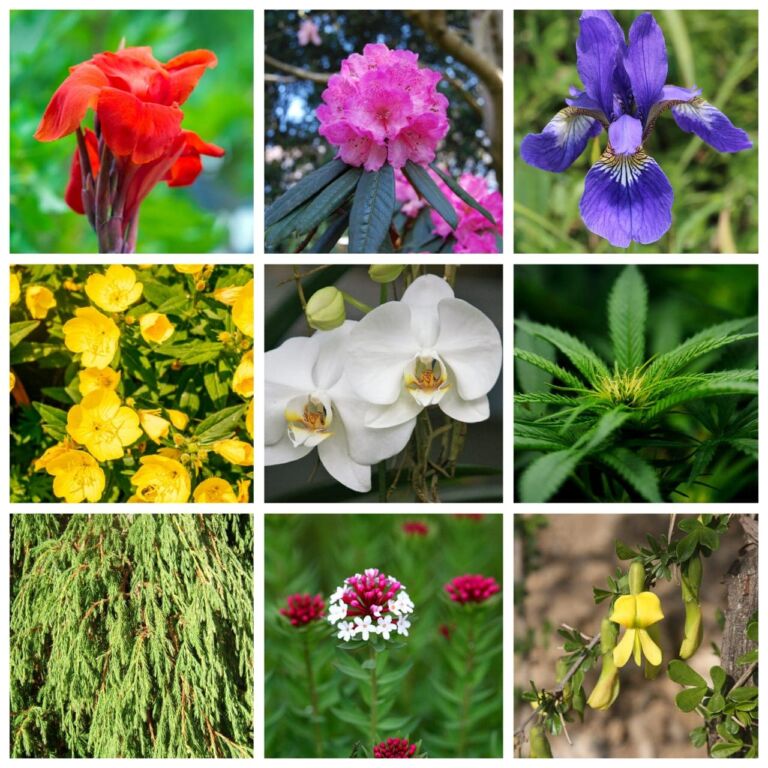
Flora found in the Annapurna region
Row 01: Canna lily, Rhododendron, Iris Row 02: Yellow primrose, White orchid, Marijuana Row 03: Juniper bush, Stellara, Caragana brevispina

Fauna found in the Annapurna region
Row 01: Bharal (Blue sheep), Snow leopard, Himalayan wolf Row 02: Gray langur, Leopard, Jungle cat Row 03: Red fox, Himalayan marmot, Red giant flying squirrel
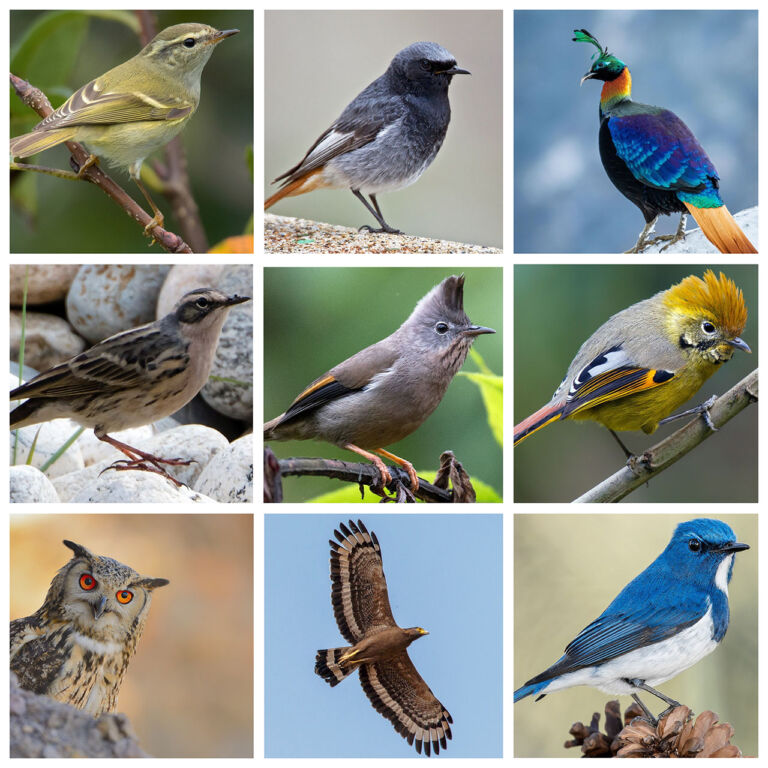
Birds found in the Annapurna region
Row 01: Hume's leaf warbler, Black redstart, Impeyan pheasant Row 02: Rosy pipit, Stripe-throated yuhina, Chestnut-tailed minla Row 03: Rock eagle owl, Crested serpent eagle, Ultramarine flycatcher
Travel Information
All trekkers must provide a copy of their comprehensive travel insurance policy certificate to the Himalayan Odyssey Nepal Trek before starting the trek.
[Note:] The policy must cover medical and emergency repatriation, including helicopter rescue and evacuation expenses at high altitudes.
Trekking permit requirements Two permits are required for the Annapurna Circuit Trek : 1) a TIMS (Trekkers Information Management System) card 2) an entry permit for the Annapurna Conservation Area Project permit
The difficulty of the Annapurna Circuit Trek is challenging (grade IV). While you’ll start the Thorong La Pass Trek at around 1,000 m above sea level, you’ll reach as high as 5,416 m at Thorong La Pass. That’s pretty high. There is a chance of getting altitude sickness.
Safe drinking water is easily available during the trek. You should carry a water bottle so you can refill the water that is available in every lodge. It will be better to bring purifying tablets for safe drinking during the trek.
Coughs and headaches are normal in the mountains. However, if you suffer from a high-syndrome illness, you have to make your way backward. Visit our Altitude Sickness page for more information.
Yes, cellular networks can be found on the trekking trails of the Annapurna Circuit Trek. However, in some places, there might not be reception available.
The standard length of the Annapurna Circuit Trek is about 160–260 kilometers. It could take 10 to 21 days to complete the circuit, but the distance can differ depending on your itinerary or where you start and end the trek.
Ask a question ...
Trekking map of annapurna circuit trek: 12-days itinerary.

Nar Phu Valley Trek
Duration: 9 Days

Tilicho Lake Trek
Duration: 11 Days
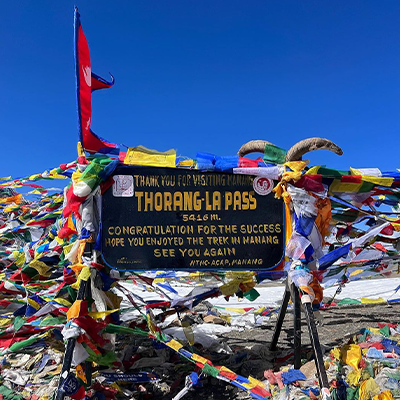
Thorong-La Pass Trek
Duration: 12 Days
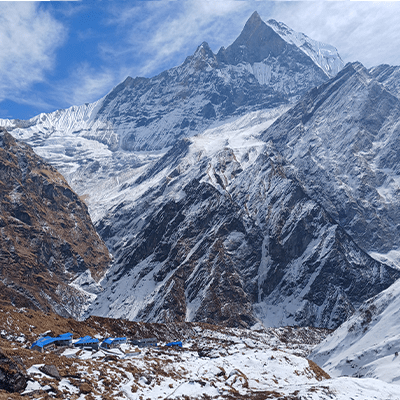
Annapurna Base Camp Trek
Duration: 7 Days
Manaslu Circuit
Himalaya Trail
Facts About Mt. Everest
Trek to Everest Base Camp
Best Time to Visit
Weather & Climate
Kathmandu Airport Guide
Top Destinations in Nepal
One Week in Nepal
Tipping Guide
Getting Around
Top Things to Do in Nepal
Complete Guide to Kathmandu
Top Things to Do in Kathmandu
Top Things to Do in Pokhara
Sacred Sites
Amazing Festivals
Top National Parks
Must-Try Food
Annapurna Circuit
How to Trek Nepal's Annapurna Circuit
Hike the most beautiful route in Nepal
:max_bytes(150000):strip_icc():format(webp)/Becker1-5b734a56c9e77c0025caddbd.jpg)
DANNY HU/Getty Images
Although small in stature geographically speaking, Nepal is a county that is blessed with an overabundance of adventure travel opportunities. Whether you're hiking or climbing in the mountains, spotting wildlife in Chitwan National Park , or whitewater rafting on a raging river, there are numerous activities that are guaranteed to get your heart pumping. Of course, most travelers that visit the Himalayan country come for the amazing trekking, with the hike to Everest Base Camp standing out as a true bucket-list achievement amongst veteran adventurers. But as iconic as that journey is, it may take a backseat to another Nepali trekking route that is even longer, more challenging, and more beautiful.
Stretching for up to 145 miles through the snow-capped Himalaya, the Annapurna Circuit is the standard by which most other trekking routes around the world are measured. It is easily amongst the best hiking routes in the world, but before you commit to exploring it yourself, here's what you need to know.
What Is the Annapurna Circuit?
Located in central Nepal, the Annapurna Circuit is a long-distance trekking route that begins in the town of Besisahar and ends in Birethanti, encircling much of the Annapurna Massif along the way. The trail's namesake mountain is amongst the tallest in the world, standing some 8091 meters (26,545 ft) in height. This beautiful and majestic peak looms large over numerous sections of the trail, providing a spectacular backdrop for a hike that is already well known for its natural beauty.
The trail first opened to hikers back in the late 1970s, but truly gained its legendary status amongst adventure travelers in the '80s. It was around that time that development in the area started to take off, making it easier to travel to and from the Annapurna region. The city of Pokhara also blossomed into a mecca for backpackers, serving as a gathering point for those looking to hike the Himalayan route.
Today, the Annapurna Circuit is amongst Nepal's most popular trekking trails, drawing thousands of hikers on an annual basis. Most come for the spectacular beauty that can be found along the route, which includes small villages spaced out every few hours with accommodating tea houses offering good food, thirst quenching drinks, and a warm, cozy place to spend the night.
Location & Orientation
As with all adventures that take place in Nepal, the journey begins and ends in the country's capital –– Kathmandu. The city is noisy, chaotic, and colorful, with plenty of attractions to keep visitors busy in its own right. The historic temples, famous markets, and eclectic restaurants are certainly worth a look.
Once trekkers are ready to hit the trail however, they'll most likely fly to the city of Pokhara in central Nepal, which is located close to the start of the Annapurna Circuit. From there, they need to book ground transportation to nearby Besisahar to begin the trek. Alternatively, travelers can take a bus directly to Besisahar from Kathmandu, skipping Pokhara altogether. The ride is about seven hours in length, but offers some great views of the Nepali countryside while en route.
Best Time to Go
There are two distinct hiking seasons in Nepal, with one coming in the spring and the other in the fall. The absolute best time to hike in the Himalaya is in October and November, shortly after the annual monsoons have subsided. Typically, the weather is warm, with clear skies, and few rain showers at that time of the year, although evenings can be on the chillier side. Because of this however, it is also the busiest time of the year too. That means the trail can get crowded and tea houses will sell out quickly. If you're visiting during the peaks season, be sure to book your guide and accommodations well in advance.
The second best time to hike the Annapurna Circuit is in April and May. By that time of the year, spring has typically arrived, ushering in warmer temperatures and less snowfall. It is a quieter time on the trail, but the weather conditions can be a bit less predictable with a higher chance of rain or clouds. Still, it is generally a lovely time to be in the Himalaya, with good visibility and excellent hiking on most days.
From June to September, Nepal finds itself in the midst of monsoon season, which brings torrential rain to many parts of the country. But most of the Annapurna Circuit falls in a rain shadow and isn't often hit with heavy downpours. This makes the summer months a surprisingly good time to hike the route, as there are generally very few people traveling in Nepal during that time of year. The downside is that it can be quite warm and muggy on certain segments of the trail, making it an uncomfortable time to be in the mountains.
Some adventurous hikers will trek the route in the winter, as the trail is usually all-but deserted at that time of the year. The trade-off is that snowstorms can strike at any time, temperatures can get quite cold, and there is a higher chance of avalanches closing the trail. Only the most experienced backpackers should hike in the Himalaya at that time of the year, as conditions can actually become life-threatening, particularly if you're unaccustomed to the winter conditions.
How Long Does It Take to Hike the Annapurna Circuit?
Hiking the classic Annapurna route through the Himalaya generally requires about 18 days to complete end-to-end. Some trekkers are able to travel a bit faster, shaving a few days off of that time, while others will move at a slower pace or make side trips, extending the journey a bit longer. The majority of guided treks will stick closely to the 18 day schedule however, which doesn't include travel time to and from Nepal. Add on a few days in Kathmandu at the beginning and/or end, and an Annapurna trek will likely take the better part of three weeks to finish.
What Should I Expect on the Trail?
The Annapurna Circuit is a well marked and maintained trekking route that is easy to follow. It passes through numerous small villages along its length, giving hikers plenty of options to grab a bite to eat, relax with a drink, or find accommodations for the night. Tea houses are plentiful and small restaurants and shops are not uncommon either.
The trail itself features plenty of altitude gain and loss along the way, with a starting point located at 2690 feet in Besisahar and reaching its highest point at Thorung Pass, which tops out at nearly 17,770 feet. It is a slow, but steady climb up to that point, with some — steep, but manageable — ascents at various points throughout the hike. Go slowly and allow yourself to acclimate to the altitude, particularly in the early days of the trek.
There are also quite a few river crossings along the route, most of which are accomplished with the help of a suspension bridges. This adds to the sense of adventure, as some of those bridges are built high above the water, making for some very scenic views and photos. But those who aren't particularly fond of heights will want to keep their eyes focused ahead while moving at a steady pace. While completely safe and well maintained, the bridges can be a bit unnerving on the first crossing or two.
One of the reasons why the Annapurna Circuit is much-loved by trekkers is that it seems to only get better with each passing day. The beautiful and dramatic scenery can be incredibly breathtaking, and just when you think it can't get any better, the next day completely surpasses the one before. If you're looking for a hike that will provide plenty of sights to see, it's difficult to find a route that will tops this one.
As mentioned, the traditional Annapurna Circuit begins in Besisahar and ends in Birethanti. In between, the trail wanders through Khudi, Jagat, Manang, Marpha, Tatopani, and numerous other villages and towns, providing a real sense of what it is like to live in the Himalaya. This is part of its appeal as well, giving trekkers a chance to immerse themselves in the mountain culture that has existed there for centuries.
There have been some travelers who have lamented the fact that a busy road now runs through much of the Annapurna region, with cynics saying that it has ruined the trekking route forever. While it is true that a road now exists there, much of the path still stays well away from it and some portions have been rerouted to avoid the traffic as well. At the end of the day, this is still one of the best hikes in the world and most adventure travelers won't come away disappointed.
Do I Need a Guide?
Whether or not you hire a guide for your Annapurna Circuit excursion comes down to personal preference. If you are an experienced backpacker who enjoys going it alone, and are looking to save a bit of money, then a guide isn't really necessary. The trail is easy to follow, it's hard to get lost, and there are plenty of places to resupply along the way. For those that know what they are doing, it is a fairly straight forward trek.
On the other hand, if you're looking to get the full experience, a guide can come in very handy. Not only will he or she ensure that you stay safe on the trail, they'll also be able to answer questions for you along the way. They can also help translate conversations with locals, offer insights into the best places to stay and eat, and help you to avoid potentially sticky situations. From time to time trekkers can meet less-then scrupulous individuals along the trail and a good guide can help smooth over those encounters.
What to Pack
A long trek through the Himalaya can require plenty of gear to keep you warm, dry, and comfortable throughout the trip. If you've booked the hike with a guide service, be sure to ask them for a packing list before setting out to ensure that you have everything you'll need. During the two most popular trekking periods –– October through November and April through May –– the days are typically warm, while the nights can be quite cool. That means you'll want to dress in layers, bring a warm sleeping bag, and pack versatile gear that can be used in a variety of environments.
If you're trekking independently, you'll find a number of Annapurna Circuit gear lists online. Use these as guide for knowing what to pack for the trip and what to leave at home. Keep in mind however, you'll be carrying your backpack at high altitude, so packing light may be of benefit.
Do I Need a Permit?
The Nepali government requires that all trekkers hiking the Annapurna Circuit carry two permits with them at all times. Those permits are required to even enter the Annapurna Conservation Area and there are multiple checkpoints along the route where authorities will request to see them again.
Both the Annapurna Conservation Area Permit (ACAP) and the Trekkers Information Management System (TIMS) card can be obtained in Kathmandu or Pokhara prior to the start of the hike. The ACAP costs about $18/person, while the Green TIMS card, which is for independent travelers, is priced at $20/person. A Blue TIMS card for group travelers sells for $10/person.
If you hire a guide they will typically handle all of the paperwork and obtain the permits for you.
Do I Need Travel Insurance?
Nepali regulations require all travelers who are climbing or trekking within the country to have travel insurance prior to setting out on their adventure. Hiking and mountaineering at high altitude comes with some inherent risk, and it is not uncommon for travelers to have to be evacuated or receive medical treatment. Having the proper insurance can help alleviate those costs and can help organize an evacuation or medical transfer should the need arise.
Beyond that regulation however, it is just a smart idea to purchase travel insurance when undertaking any adventurous itinerary. You never know when a situation might arise where you might need it, including covering the expenses of lost bags, cancelled flights, unexpected medical expenses, or evacuations. Those are all things you hope to never have to deal with, but the right insurance will limit the impact it has on your trip and wallet should anything unexpected happen.
How Fit Do I Need to Be?
The Annapurna Circuit can be a challenging hike, even for those who are already quite fit. In order to enjoy the trek to its fullest, travelers are encouraged to be as physically prepared as possible prior to starting out. Some days are more strenuous than others and altitude is always a concern of course, but the trek will be a more enjoyable one if you have trained a bit prior to traveling to Nepal.
Who Should I Travel With?
As mentioned, you can hike the Annapurna Circuit completely on your own, or hire a guide when you arrive in Nepal. But if you'd rather have all of the logistics taken care of for you and book a guide service prior to your departure, there a plenty of companies that offer treks along the route. Here are a few that we recommend:
- G Adventure 18-Day Annapurna Circuit Trek
- Trekking the Annapurna Circuit Region with Intrepid Travel
- Annapurna Circuit by Exodus Travel
- Annapurna Circuit From World Expeditions
- Annapurna Sanctuary Trek by REI Adventures
Five Amazing Hiking Routes Among the High Mountains of the Himalayas
How to Go Teahouse Trekking in Nepal
How to Trek Nepal's Manaslu Circuit
The Best Time to Visit Nepal
The Best 12 Hikes in Nepal
The 15 Best Hiking Destinations in Asia
The Best Countries in the World for Adventurous Travelers
The Top 15 Destinations in Nepal
The World's Highest Places and Attractions That You Can Visit
The Top 20 Things to Do in Nepal
Nepal's Great Himalaya Trail: The Complete Guide
Nelson Lakes National Park: The Complete Guide
15 of the Most Beautiful Sacred Sites in Nepal
The Top 9 Things to Do in Pokhara, Nepal
How to Go Hiking With Your Kids
One Week in Nepal: The Ultimate Itinerary
Annapurna Circuit Trek
15 days | challenge yourself to trek the mighty annapurna circuit in nepal..

Trek through the incredible Annapurna region and be awed by the Nepalese Himalayas. These snow-capped peaks, mist-shrouded valleys, isolated communities and remote monasteries will inspire those with a bold spirit and a yearning for a definitive nature experience. Reach altitudes of more than 5000 metres, discover the ancestral traditions of the local people and immerse yourself completely in the spectacular mountain wilderness of the Annapurna Circuit. This is a challenging trip, but the sense of accomplishment will leave even the most seasoned trekker with some unforgettable memories.
Trip overview
- Ascend to the clouds and reach an altitude of 5416 metres as you cross the Thorung La Pass along the Annapurna Circuit. Testing your mind and body, this is one hell of an accomplishment.
- Uncover a different side of the Himalayas, trekking past terraced rice fields, oak and rhododendron forests, there’s a diverse array of nature that awaits in the Annapurna region.
- Learn about life in Nepalese mountain communities, get to know locals and meet other trekkers while you stay in teahouses in the small communities along the way.
- Discover Nepal’s compact capital in Kathmandu. With a limited amount of time spent here to discover its bazaars and temples, why not extend your stay beforehand to get a real feel of Nepalese culture.
- Spend time in the peaceful haven of Pokhara after your trek has finished. Relax with your small group on the banks of Phewa Lake and take in the mountainous surrounds that you have conquered!
- By travelling on this trip, you’ll directly support our Intrepid Foundation partner, Sagarmatha Next. Donations help them remove waste responsibly and turn rubbish into art in the Everest region.
- This trip involves an 11-day trek at high altitude (up to and above 5000 metres) – precautions and acclimatisation are undertaken, but be aware of the effects altitude can have. An excellent level of fitness is required on this trip, with treks of up to 9 hours a day at high altitude. See our guide to trekking in the region here to help decide if this trip is what you are looking for in a holiday: https://www.intrepidtravel.com/adventures/annapurna-circuit-hiking-guide
- Due to the nature of outdoor travel, please be aware that this trip will operate on an amended itinerary in high risk weather conditions. Please note that Thorong La Pass is occasionally closed in winter months due to heavy snowfall. Alternative arrangements will be made by your group leader if this occurs.
- Accommodation on this route is in simple teahouses, which also allows you to experience the friendly spirit of the local Nepalese people.
- Please read our packing list for required equipment carefully, and remember that you don’t necessarily have to bring it all with you – you can hire or buy some of it in Kathmandu.
- Trying to decide between trekking in the Annapurna or Everest regions? This might help you decide: https://www.intrepidtravel.com/adventures/annapurna-vs-everest
Namaste! Welcome to Nepal. Your adventure begins with a welcome meeting at 2 pm in Kathmandu, the colourful capital of Nepal. This place is a fascinating blend of traditional architecture and symbols of the 20th century. Its rich artistic and cultural heritage is evident where ornately carved balconies mingle with beautiful shrines and temples. If you arrive early, why not check out Durbar Square with its temples, markets and busy atmosphere. It is also worth the climb to visit the Swayambhunath – the 'monkey temple'. Explore the network of street markets and alley bazaars and Pashupatinath. For those with a few extra days in Kathmandu, the neighbouring towns of Patan and Bhaktapur are also well worth a visit.
- Hotel (1 night)
There are no meals included on this day.
- Kathmandu - Everest Scenic Flight - USD240
- Kathmandu - Panorama Hike Urban Adventure - USD57
- Kathmandu - Spiritual Nepal Experience Urban Adventure - USD68
- Kathmandu - Exploring Patan & Bhaktapur Urban Adventure - USD97
It’s very important that you attend the welcome meeting. Ask reception for more information on where the meeting will take place.
With climate change the weather on the Annapurna Circuit is becoming less predictable, and heavy rains on occasions causes significant damage to the trail even outside of rainy season. Should this occur, and conditions make trekking the circuit unsafe, we will switch to the Annapurna Base Camp itinerary instead. A flight from Pokhara back to Kathmandu on Day 15 will also be included. See for further details: https://www.intrepidtravel.com/au/nepal/annapurna-base-camp-trek-144945
This morning, drive to Besisahar to immediately immerse yourself in the spectacular mountain wilderness that encompasses the Annapurna Range. After lunch you’ll begin your trek straight away, heading to Ngadi. Hit the trail that takes you through Besisahar bazaar leading downstream, followed by a climb up the rocky steps. There are several ups and downs as the trail makes its way through sub-tropical forests and rice paddies of Sera. Further along, traverse a suspension bridge across Khudi Khola and arrive at Bhulbule. Resume on the trail that passes the Marshyangdi River on a long suspension bridge as Bhulbule is left behind. Once the Ngadi River is crossed, the trail gently leads upwards through scrub forests and across landslides for a short distance, which then leads to few teashops and cold-drink stalls located opposite the rice paddies of Lampata, eventually leading to Bahundanda (hill of the Brahmins) – a charming village in the saddle of a long ridge.
At 8091 m, Annapurna I is one of the highest mountains in the world. Its surrounding sister mountains are equally imposing, creating magnificent panoramas from any viewpoint. Throughout this trip’s trekking you’ll come across isolated mountain communities, each with different ancestral customs and traditions, meaning a visually and culturally memorable expedition. You’ll meet warm and welcoming locals herding yaks and goats on the grassy pastures and visit their monasteries and temples, pass waterfalls of melted snow, cross icy rivers, walk along broad plains and hike up high mountain passes.
- Teahouse (1 night)
Trek Distance: 12 km Approximate Duration: 4 hours Ascent: 510 m Descent: 410 m
Keep an eye out for dazzling cascades along your trail today as it makes its way through a deep wooded canyon with a few stretches of steep climbing. Wander through rice paddies, follow winding trails through sub-tropical forest, cross suspension bridges swaying over raging rivers, pass waterfalls of melted snow and climb steep mountain passes. Over the next ten days you’ll come across isolated mountain communities, each with different ancestral customs and traditions. Be prepared to be inspired, mesmerised, challenged and delighted.
Trek Distance: 18 km Approximate Duration: 7 hours Ascent: 1200 m Descent: 800 m
Today’s trek continues through the deep wooded canyon embellished by stunning waterfalls. You’ll be venturing into the Manang district of the mountain range, with much of the trail ascending throughout the day.
Trek Distance: 12 km Approximate Duration: 6.5 hours Ascent: 880 m Descent: 150 m
Marking the end of the great Marsyangdi Gorge, make a steep climb to Timang, then the trail settles into gentler slopes as the vegetation transforms from dense pine forests to drier slopes. The district headquarters of Manang, Chame, is the largest settlement after Besisahar.
Trek Distance: 17 km Approximate Duration: 6 hours Ascent: 730 m Descent: 300 m
A slew of breathtaking scenery is on the cards today as the trail goes through a deep gorge, then past the great sweeping slope of Paungi Danda. On they way to Chame stop at a beautiful apple orchid for a tea/coffee break and perhaps try one of the fresh bakery treats on offer. Today is mostly an easy walk with few ascending stretches of trail dotted throughout the day.
Trek Distance: 15 km Approximate Duration: 6-7 hours Ascent: 720 m Descent: 300 m
Trek the northern trail via upper Pisang and Ghyaru – an area renowned for its spectacular views. It is now drier and you are sure to come across local farmers herding yaks. Here’s a hot tip – Tibetan yaks take a special interest in people wearing red, so choose your gear carefully today!
Trek Distance: 19 km Approximate Duration: 8 hours Ascent: 960 m Descent: 630 m
Spend a day here to acclimatise by doing some high climbing, then return to the lower altitude of Manang for the night. Manang, a village of about 500 flat-roofed houses, offers excellent views of Annapurna II, Annapurna III, Gangapurna and Chulu East.
Trek Distance: 4 km Approximate Duration: 3 hours Ascent: 350 m Descent: 350 m
Today will be a steadily uphill climb into the alpine region of the mountain range. You’ll arrive at Yak Kharka, ready for an easier day of trekking tomorrow to acclimatise to the high altitude.
Trek Distance: 10 km Approximate Duration: 5 hours Ascent: 640 m Descent: 100 m
Due to the altitude, feel free to take the next section of the climb at a leisurely pace, meaning you’ll have time to admire the magnificent views from this part of the route. Once at Phedi, there will be plenty of time to rest and acclimatise to the higher elevations ready for the next part of the climb where you will encounter the Thorung La Pass – the highest point on this Annapurna Explorer.
Trek Distance: 7 km Approximate Duration: 5 hours Ascent: 630 m Descent: 150 m
Setting off very early to cross the Thorung La Pass (5416 m), the trail is steep but easy to follow. After between 4 to 6 hours climbing, reach the Pass's peak, adorned with prayer flags, a traditional stupa (chorten) and stone cairns built by travellers. Stop to admire the stunning views and marvel at how far you've climbed. Further along, the trail descends steeply proceeding towards Chabarbu. From here on, the trail crosses meadows, drops into a deep ravine, climbs out and follows a wide trail into Muktinath – a pilgrimage site held in great reverence by both Hindu and Buddhist populations.
Trek Distance: 14.5 km Approximate Duration: 8-9 hours Ascent: 915 m Descent: 1780 m
Veer off the main trekking trail to make a side trip to an ancient village of Purang. Further up from the village, continue to take the less frequented route going past another village with a medieval feel to it – Jhong. From Jhong, descend to the Jhing Khola (river), following the course which you emerge on to Kagbeni. From Kagbeni we will hop on a public bus back to Jomsom.
- Guesthouse (1 night)
Trek Distance: 11 km Approximate Duration: 4-5 hours Ascent: 110 m Descent: 950 m
Depart early on a 4WD from Jomsom, stopping in Tatopani for an included lunch, opt for a well-earned visit to the Tatopani Hot Springs (especially rewarding after multiple days trekking). After, continue your journey to Pokhara. Pokhara is a peaceful lakeside location which rests beneath the snow-capped peaks of the Annapurna Range. A once vibrant trade route extending between India and Tibet, this is the land of Magars and Gurungs, hardworking farmers and valorous warriors who have earned worldwide fame as Gurkha soldiers. The Thakalis, another important ethnic group here, are known for their entrepreneurship. When you arrive, maybe sip on a cold brew and gaze up at the dramatic pass that you have just conquered. There are plenty of lakeside cafes where you can enjoy international cuisine, while the main street is full of shops and stalls selling a wide range of Nepali and Tibetan souvenirs.
- Tatopani Hot Springs - USD1
Your travel time today will be approximately 8 hours.
Enjoy a free day in Pokhara to unwind, relax and give those muscles a rest after all that trekking. Your leader can advise you of sightseeing opportunities. It is worth taking a boat for a row out on the lake, especially if the weather's fine. The lakeside area has great shopping and cafes. Pokhara has an interesting old area as well as an elaborate Hindu temple and a Buddhist monastery. Perhaps visit the Peace Pagoda, where spectacular views of the mountains await. You can see the Annapurnas from here, and the famous fishtail peak, Machhapuchhare, and back across to Pokhara. You can also visit the fascinating International Mountain Museum to learn some amazing tales of past climbing expeditions.
With no activities planned for today, you are free to leave at any time. Pokhara is a stunning and peaceful lakeside haven, so if you would like to spend more time here, we’ll be happy to organise additional accommodation (subject to availability).
Private vehicle
Guesthouse (1 night), Hotel (3 nights), Teahouse (10 nights)
Dates and availability
Important notes.
1. A single supplement is available if you’d prefer not to share a room on this trip. The single supplement will only be included on Days 1,13,14 (Hotel) and is subject to availability. Please speak to your booking agent for further information. 2. You may be asked to provide 2 passport size photographs for your trekking permit. 3. Due to the demands of travelling at high altitudes a Passenger Self Assessment Form is required for this trip. Please also see here for information: https://www.intrepidtravel.com/au/altitude-sickness 4. With climate change the weather on the Annapurna Circuit is becoming less predictable, and heavy rains have on occasions causes significant damage to the trail even outside of rainy season. Should this occur, and local conditions make trekking the circuit unsafe, we will switch to the Annapurna Base Camp itinerary instead. See https://www.intrepidtravel.com/au/nepal/annapurna-base-camp-trek-126570 for further details. 5. There is a dirt road that stretches from Muktinath to Jomsom and Tatpaoni. When weather conditions allow, we use an alternate track for this portion of the trek to avoid the road as much as possible. Travellers are obliged to walk on the off road in most of the trekking sections until Manang. 6. This trip ends in Pokhara. Intrepid offers a pre-arranged transfer and flight service option back to Kathmandu airport. Enquire with your agent at least 30 days prior to your trip departure. 7. You must bring an emergency fund of USD 500 in cash with you on this trip, which you may need to use in case of delayed or cancelled flights. This is especially important should you choose to opt to take a helicopter as this will be at the travellers expense. 8. As this trip ends in Pokhara, if you wish to transfer your stored luggage from Kathmandu to Pokhara, we can arrange this by a private vehicle. Additional cost is 100 USD. This cost is divided among the interested participants. 9. Please be aware that in the event of an emergency evacuation, Intrepid does not have control over which helicopter service may be used. Some helicopters are not in regular use with Intrepid and have not passed our internal safety auditing.
Want an in-depth insight into this trip? Essential Trip Information provides a detailed itinerary, visa info, how to get to your hotel, what's included - pretty much everything you need to know about this adventure and more.
Filter by rating

Annapurna Circuit Trek in Nepal: The Ultimate Guide
Jackson Groves
Posted on Last updated: October 20, 2023
Categories NEPAL , HIKING
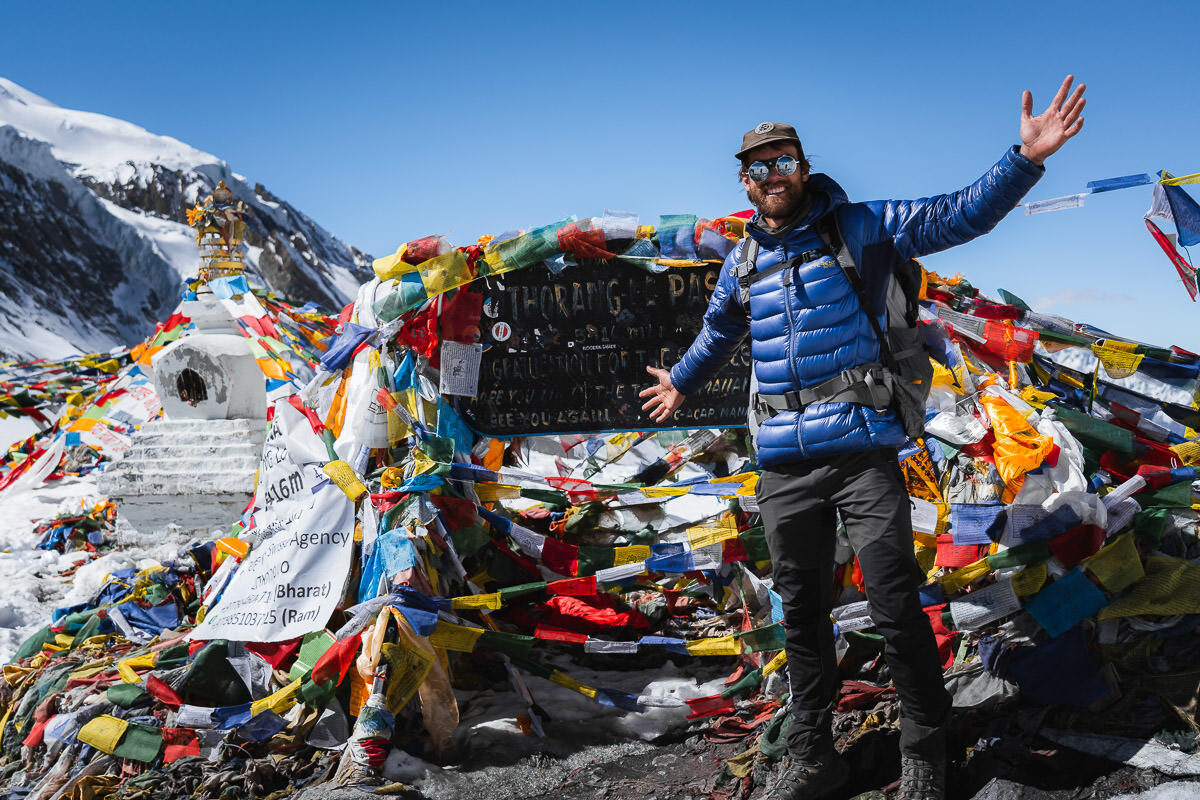
The Annapurna Circuit Trek is one of the most popular expeditions in the Himalayas of Nepal. While Everest Base Camp may be the most well-known trek in Nepal, the Annapurna Circuit Trek is definitely a close second! I’ve done both the EBC and the Annapurna Circuit Trek among many other routes in Nepal.
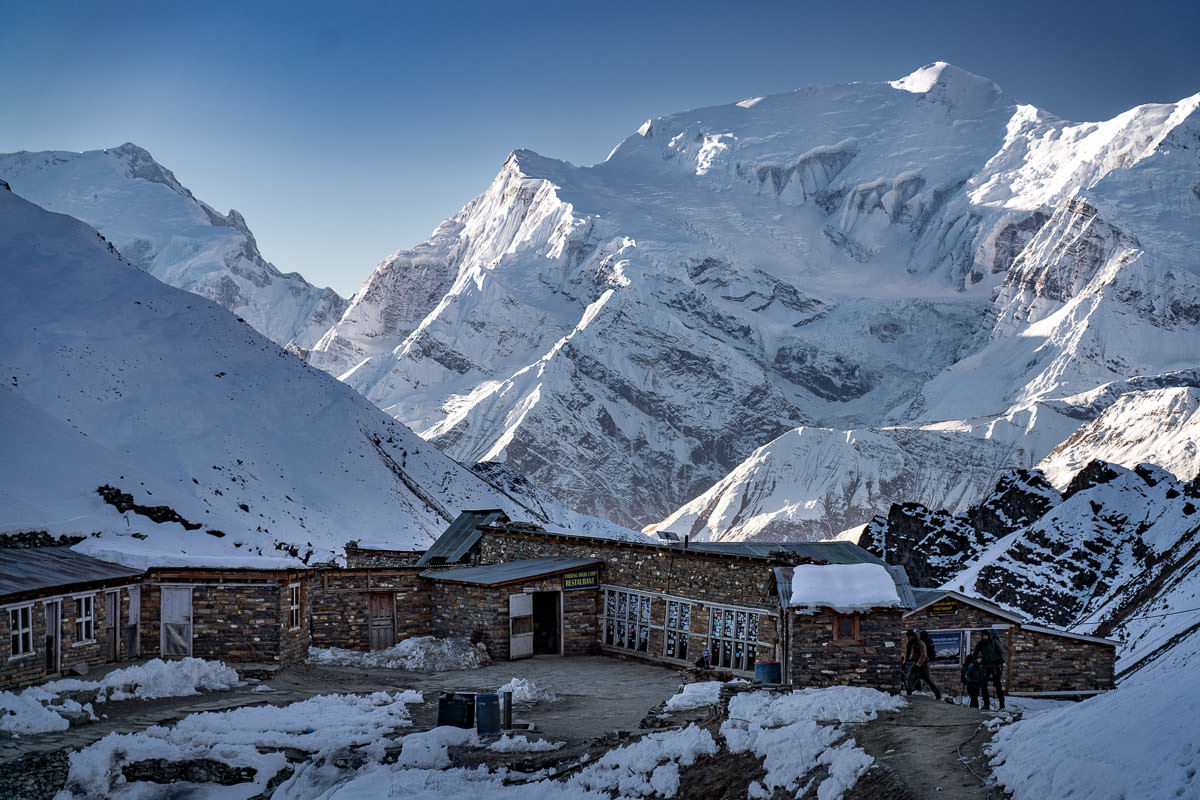
BEST TREKKING COMPANY IN NEPAL
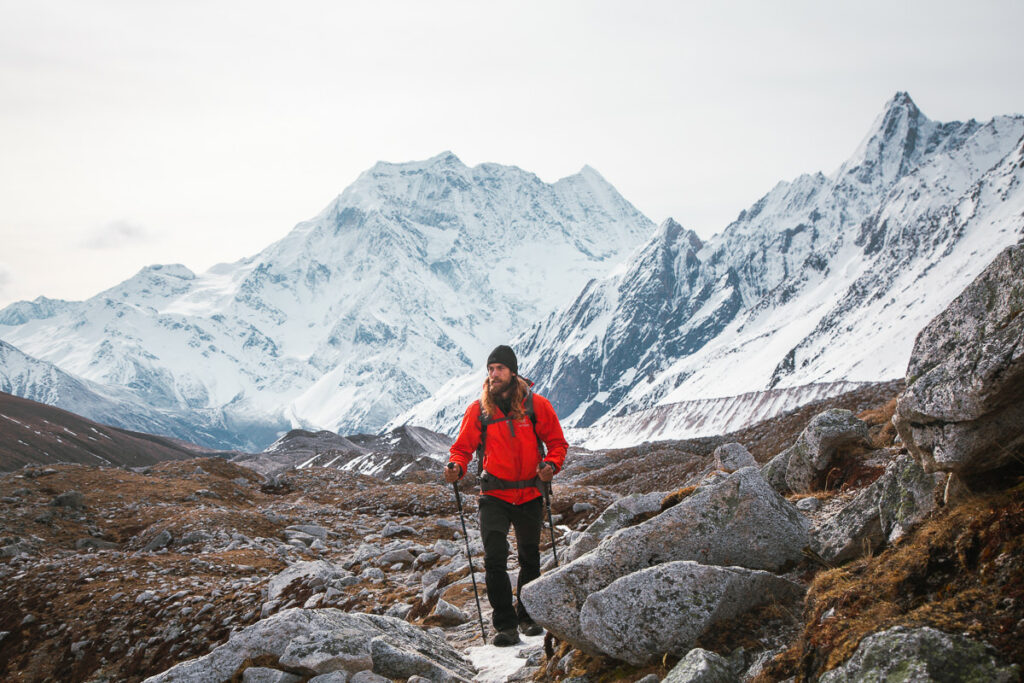
Interested in trekking in Nepal or doing the Everest Base Camp Trek? I recommend booking your trek with Himalayan Masters , which is the company I use for all of my treks in Nepal. Use my code JACKSON5 when you book to receive a 5% DISCOUNT .
In this guide, I will share with you my experience on multiple routes throughout the Himalayas to help prepare you for your trekking experience. Overall I would rate the Annapurna Circuit as the most scenic trek in Nepal from the first day to the last.
We looked at 7000m and 8000m peaks from the first to the last day, had amazing tea house locations, and were blown away by the scenery every single day. However, there are some negatives that modernization and commercialism have brought to the Annapurna Trekking Circuit with roads, infrastructure, and pollution. I’ll cover all aspects of this route to give you an honest insight into what to expect and why you may want to choose this route for your trip.
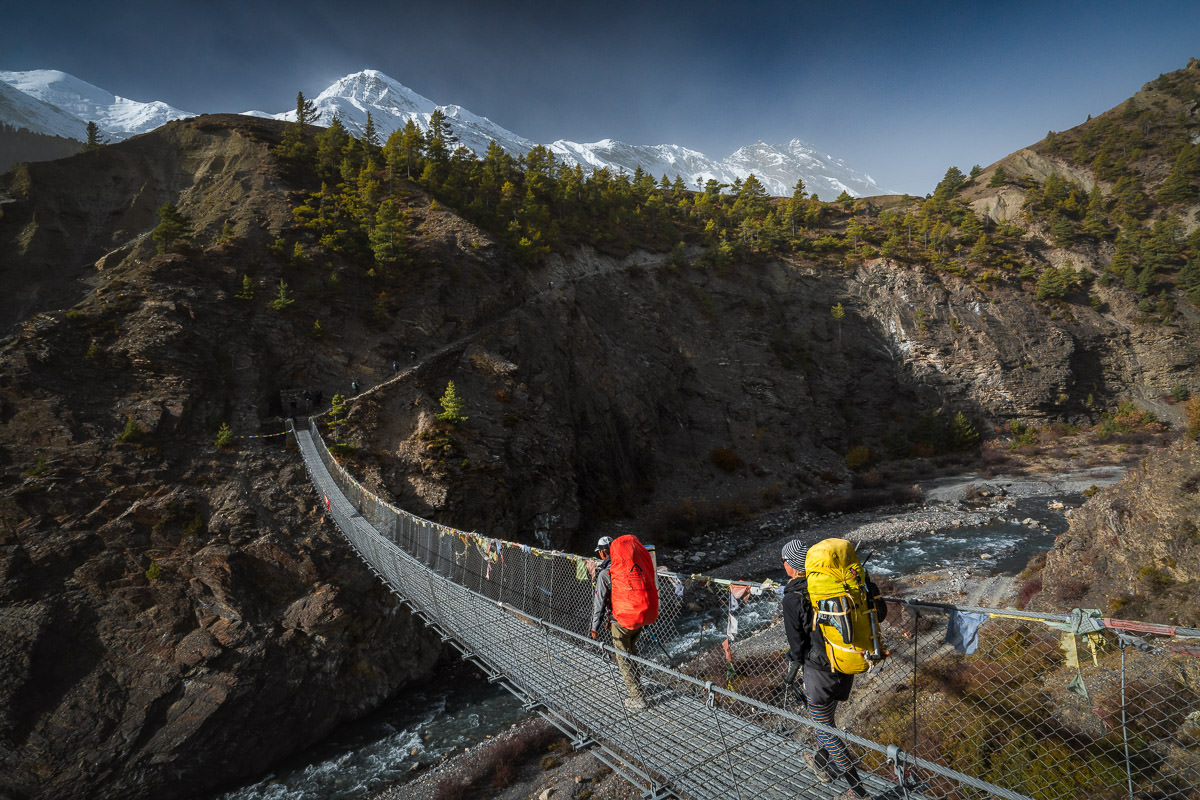
In this blog post, I will cover everything you need to know about the logistics of the Annapurna Circuit Trek. I’ve also created guides for the following treks and climbs in Nepal if you are interested to check those out as well.
- Manaslu Circuit Trek
- Everest Base Camp Trek
- Makalu Base Camp Trek
- Langtang Valley Trek
- Island Peak Climb
- Yala Peak Climb
- Ama Dablam Climb
- Manaslu Climb
- Makalu Climb
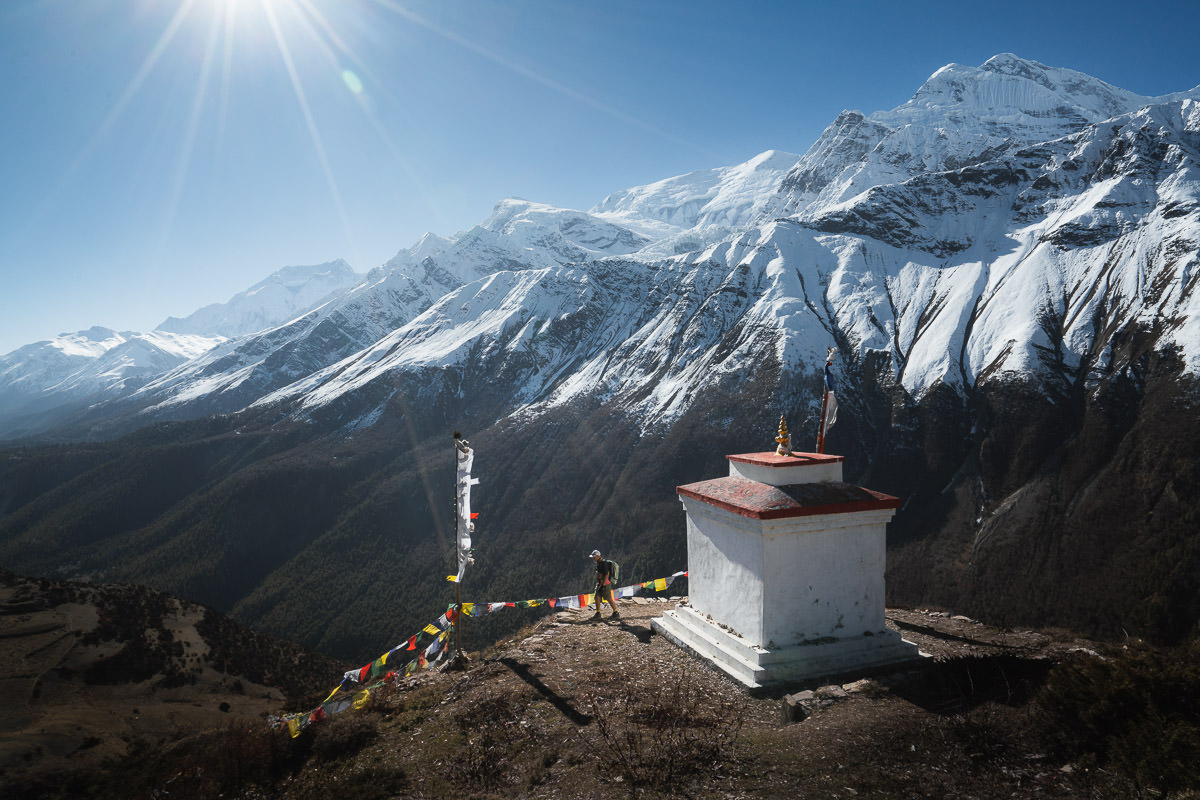
TRY THE 3 BEST TREKS IN NEPAL

Manaslu Circuit : My personal favorite 2-week trek through Tibetan villages and stunning scenery. Less crowded and more authentic.
Annapurna Circuit : The most beautiful & scenic 2-week trek in Nepal although can be crowded at times.
Everest Base Camp Trek : The most iconic 2-week route reaching the famous (EBC) Everest Base Camp at 5,300m.
Table of Contents
A GUIDE TO THE ANNAPURNA CIRCUIT TREK
In this guide, you will find all of the valuable information you need to plan your trek as well as my personal experience on the entire trek including the detour to Tilicho Lake
ANNAPURNA CIRCUIT TREK DETAILS
- Distance : 130km or 80 miles
- Days required : 10-13 days
- Total Incline : 8000 meters
- Total Decline : 7000 meters
- The highest point on the trek : The two highest points on the trek are Tilicho Lake (4,919m) and the Thorong La Pass (5,416m).
- Difficulty : The difficulty of the Annapurna Circuit Trek depends a lot on how many days you have. If you break it up over 12-14 days, it will be similar to the difficulty of EBC. However, we took only one acclimatization/rest day in Manang and the itinerary was quite tough for us given we squeezed into Tilicho Lake. Many days were about 20km of distance with 1000m of incline.
- Permits : You will need a TIMS card and Park Entrance Permit, both can be purchased when entering the park.
- Guide: A guide is not required on this trek. However, the guide manages all of the logistics, distances, directions, and tea houses for your group. I used maps.me to navigate from tea house to tea house and found the paths easy to follow. If it’s your first time trekking in Nepal, I would suggest having a guide.
- Accommodation: Guest Houses, also known as Tea Houses, are available along the way where you will sleep in a comfortable bed and have access to showers (at extra charge) and restaurant facilities. It was very comfortable accommodation and great after a long day of hiking.
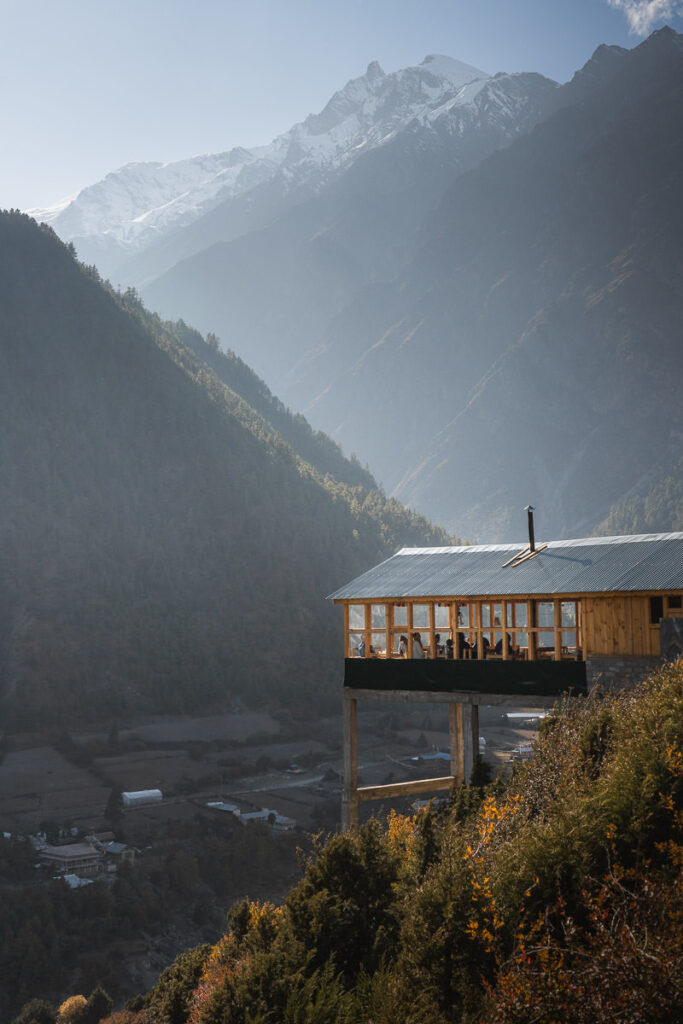
KEY POINTS ABOUT THE ANNAPURNA CIRCUIT TREK
- This circuit is less crowded than Everest Base Camp Trek but still quite busy. Especially around Tilicho Base Camp as many locals just come to trek to the Lake and don’t do the full circuit.
- There are teahouses in each village along the way so each night you get a great sleep in a bed with blankets, have access to showers, eat great meals in a restaurant, and can charge your electronics and cameras.
- The trailhead can be reached by car so there is no need to pay for expensive domestic flights.
- The road reached all the way to Khangsar, which means it isn’t quite as remote, peaceful and natural as you may be expected until the latter stages of the hike. There are side trails most hikers take for better views and to avoid the cars but nonetheless, it can be demoralizing to see a car full of tourists drive past as you eat their dust.
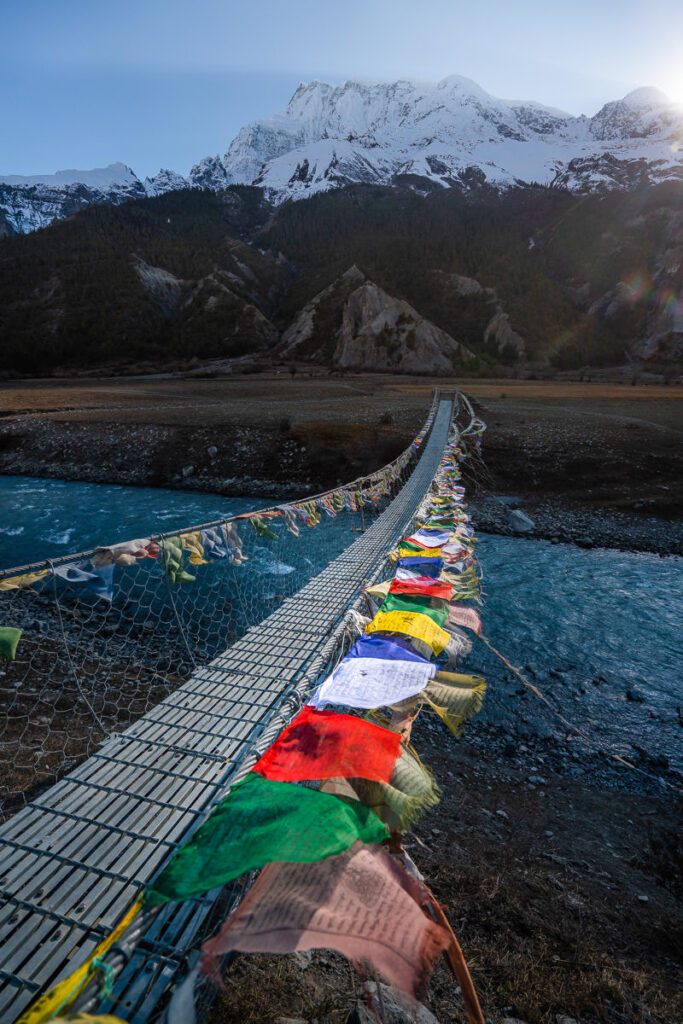
TOP 3 PLACES TO STAY IN KATHMANDU

- Ultimate Luxury: The Dwarika’s Hotel – Luxury, Spa-service, Pool
- Best Value : Aloft Kathmandu Thamel – Swimming Pool, Gym & Great Restuarant
- Budget Choice: Hotel Jampa is easily the top cheap hotel in Kathmandu
BOOKING A GUIDE FOR THE ANNAPURNA CIRCUIT TREK
The Annapurna Circuit Trek doesn’t require a guide but it’s great to have a guide managing the logistics such as directions, tea houses, distances, medical issues, and the overall organization. I’d say 80% of trekkers go with a guide. I did the trek with Himalayan Masters which is one of the top trekking companies when it comes to the Annapurna Circuit Trek.
The trek costs around $1400 USD with Himalayan Masters as of 2022 and includes all transfers, accommodation, meals, drinks, permits, and even the hotel stay before and after the trek at a high-quality hotel. I honestly had a great time on this trek and I can wholeheartedly recommend Himalayan Masters.
You can use my discount code ‘ JACKSON5 ‘ for 5% off the total price of your trek with Himalayan Masters which is a pretty handy saving.
Email: [email protected]
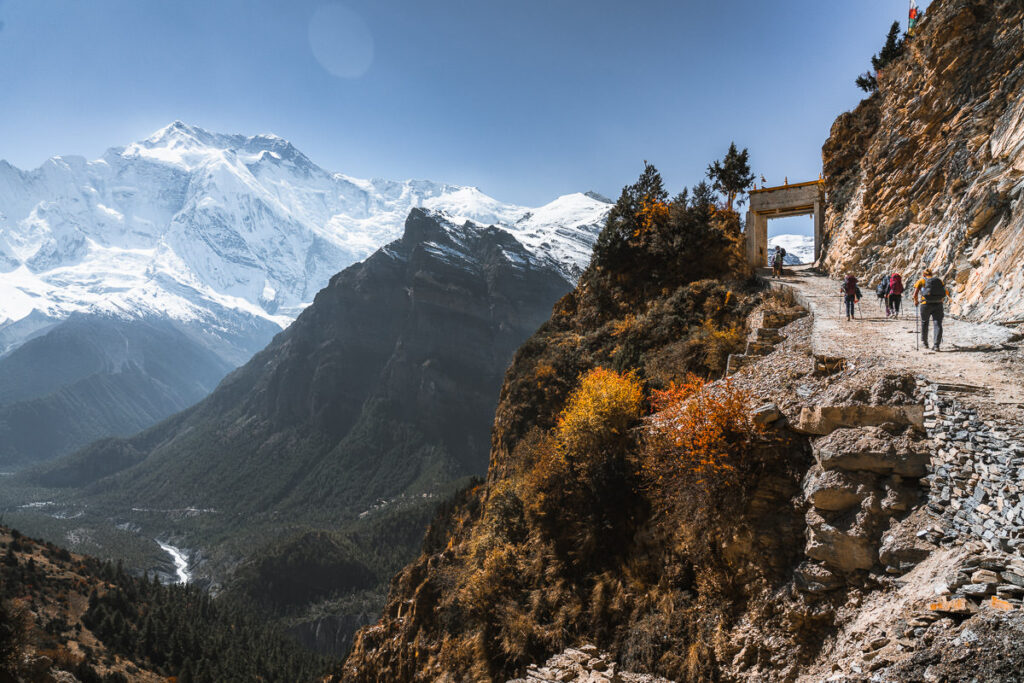
ANNAPURNA CIRCUIT TREK PACKING LIST
I packed pretty light and managed to wash most of my clothes each afternoon/night for the first half of the trip. In the latter stages of the trip, it was pretty cold so we weren’t sweating as much and we wore our warm gear basically nonstop while at the teahouses. There was no real need for multiple outfits.
This is just a guide and it worked quite well for me with no complaints from my set-up. You won’t need a sleeping bag as there are blankets in each guesthouse and when it got cold I just wore my down jacket to bed. This meant I didn’t have to carry a sleeping bag for the entire trek.
- 1 pair of pants that maybe convert to shorts
- 1 pair of shorts
- 1 Warm or thicker pair of hiking pants
- 1 Long sleeve quick-dry shirt
- 1 Long-sleeve thermal shirt
- 2 Short-sleeve t-shirts
- 1 Thermal long underwear
- 4 pairs of quick-dry underwear
- 1 Lightweight down jacket
- 1 Heavy-duty summit down jacket
- 1 Neck Buff
- Hiking boots
- 1 pair of warm summit socks
- 2-3 pairs of regular socks
- Trekking poles
- Water filter
All of this should fit into a backpack no bigger than 50L and should be less than 14kg.
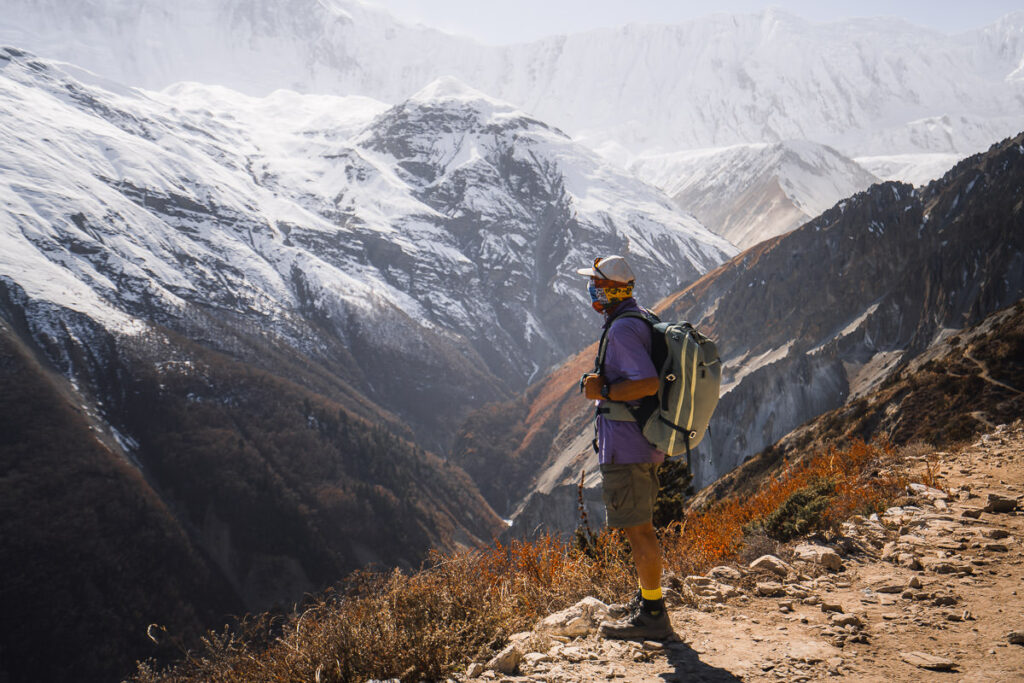
What are my favorite pieces of hiking gear?
There are four pieces of gear that I simply never forget when I go on a hike. These are four items that I using right now and this list gets updated every year! Here are my hiking essentials.
- Arcteryx BETA AR Rain Jacket : This is my go-to rain jacket. It’s super light, folds down into a tiny ball, and protects brilliantly in a storm. This one never leaves my backpack.
- Salomon X Ultra 3 Mid GTX Hiking Boots : For the best ankle support, waterproofing, and durable exterior I’m a fan of tough but light hiking boots like these Salomons for my adventures.
- Black Diamond Head Torch : I can’t tell you how many times, I’ve arrived back from a hike unexpectedly late. I always keep this lightweight but strong headtorch in my bag for the unexpected.
- Darn Tough Socks : These are the most comfortable hiking socks I’ve ever worn and last for years. They also have a lifetime warranty and you just send them in with a hole and they replace it no questions asked.
WIFI/ELECTRICITY AVAILABILITY ON THE ANNAPURNA CIRCUIT TREK
- Wifi: Costs anywhere from $0 to $4 to use wifi at the guesthouses. Buy an NTC Sim before you go. It worked in some spots but after Pisang, the service dropped and it was mostly WiFi until we got across the pass to Muktinath.
- Electricity: You will have to pay anywhere from $0 at low elevations to $5 to charge your power banks, cameras, and phones. I found that most rooms had free electricity powerpoints in the room. The key is to get a big power bank. Pay to charge it then charge everything from your power bank. My power bank lets me charge my phone and four camera batteries before it dies. Most of the places we stayed let us charge our gear for free but when it is busy they usually charge a fee as many teahouses run off gas or solar.
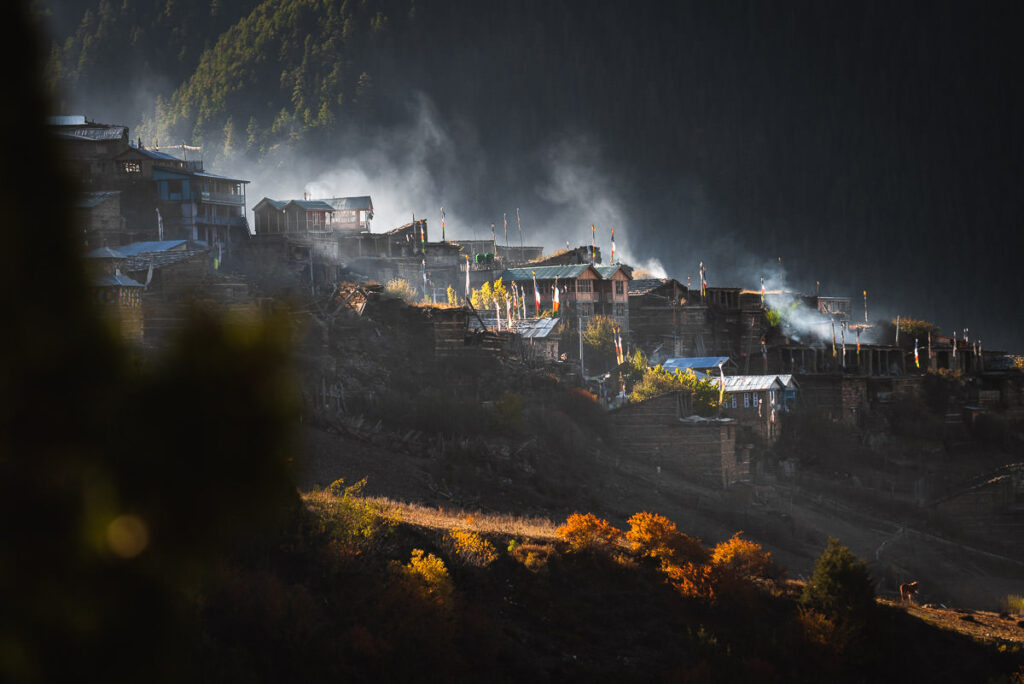
ANNAPURNA CIRCUIT TREK ITINERARY
The below itinerary was the exact journey I did but I would suggest adding in an extra day or two to account for rest days or being able to break up the day when you get up to Tilicho Base Camp. This was quite a strenuous activity. I also recommend not hiking to Dharapani from Besishar as the road is full of trucks and vehicles. Similarly, once you reach Muktinath, I suggest driving to Jomsom as it is quite built up from there with main, paved roads.
- Day 1: Drive Kathmandu to Dharapani (1,960m)
- Day 2: Trek to Chame (2,710m) Duration: 5-6 hours trek
- Day 4: Trek to Pisang (3,300m) Duration: 5-6 hours trek
- Day 5: Trek to Manang (3,500m) Duration: 6-7 hours
- Day 6: Acclimatization Day at Manang
- Day 7: Trek to Tilicho Base Camp (4000m) Duration 6-8 hours
- Day 8: Trek to Tilicho Lake & Trek to Shreekharka (4080m) Duration 10 hours
- Day 9: Trek to Thorong Phedi (4600m) Duration 6-7 hours
- Day 10: Trek to Thorong La & Trek down to Muktinath
- Day 11: Drive to Jomsom
- Day 12: Fly to Pokhara
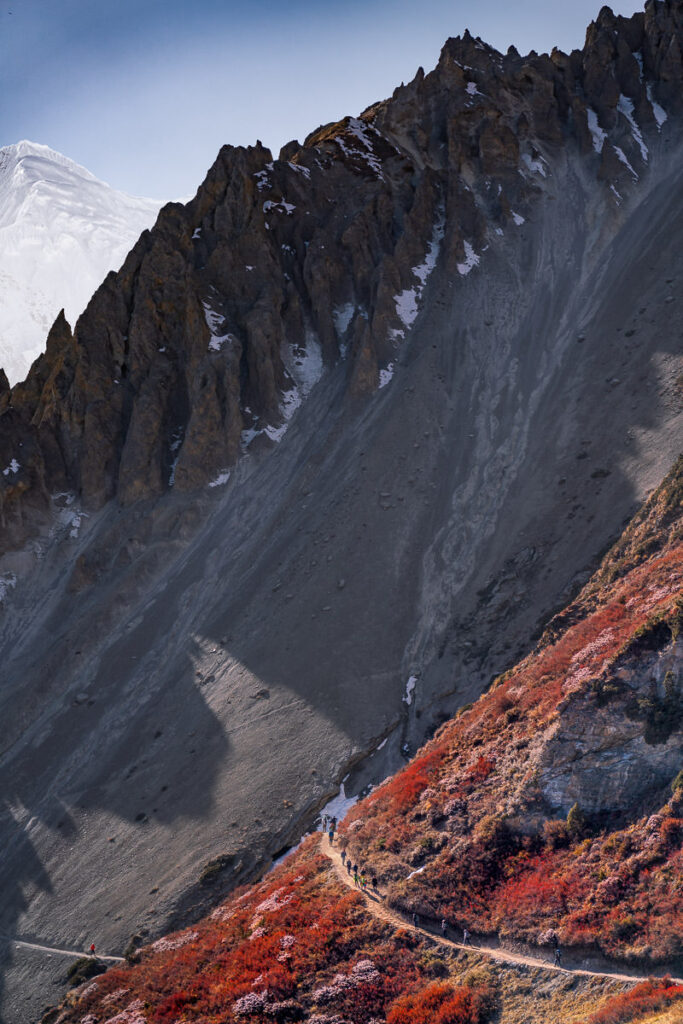
INSURANCE FOR THE ANNAPURNA CIRCUIT TREK
Nepal can be a dangerous place for trekking or hiking because the high altitude can lead to many illnesses, weakness in trekkers, and misjudgments. There is also a risk on trails for falls, avalanches, or other mishaps. Your regular travel insurance probably won’t cover you at high altitudes and won’t cover a helicopter evacuation. There is a solution though .
Need extra protection?
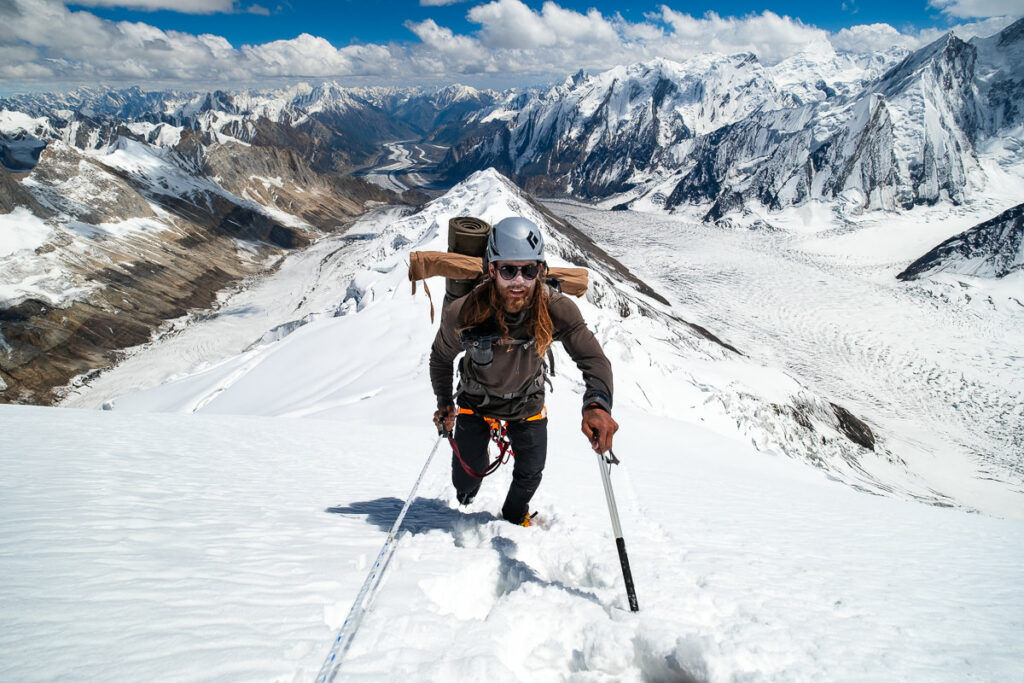
Regular travel insurance is great but won’t cover you for high altitude hikes or for helicopter evacuation. Each year, I purchase a Global Rescue Subscription .
For less than $500 per year or $100 per expedition, you can purchase a Global Rescue subscription and be covered no matter how extreme the hike or how high the climb is.
DRINKING WATER ON THE ANNAPURNA VALLEY TREK
I use the Grayl Ultralight Water Purifier and it is a game-changer for hiking in Nepal, making this super easy and cheap. The Grayl Ultralight Water Purifier removes 99.9999% of viruses of disease-causing bacteria. The best thing about it is it only takes 15 seconds and one press to purify water from any fresh water source. You don’t need to buy bottled water at every tea house contributes to large amounts of plastic waste and costing you $4+ per day.
Along the Annapurna Circuit Trek, we filled up tea houses, rivers, and local village taps. Unlike aqua purification tablets which require you to wait 30 minutes before drinking, you can have rehydrated yourself immediately with the Grayl Ultralight Water Purifier .
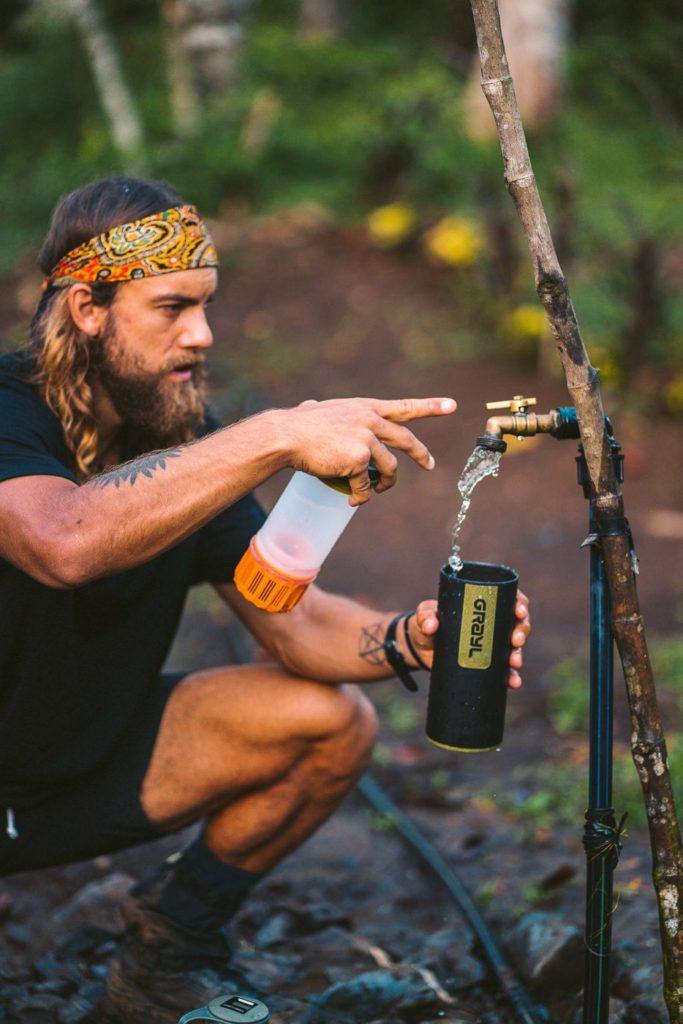
GrayL Water Purifier
- Never pay for water on the trek
- Save 3-4 plastic water bottles a day
- Turns any water into drinking water
BEST TIME AND SEASON FOR THE ANNAPURNA CIRCUIT TREK
The peak season for the Annapurna Circuit Trek is March to April and October to November. The time to avoid this trek is during the rainy season from June to August . Having said that, I often found that off-season or shoulder seasons have been my best (uncrowded) trekking experiences in Nepal
During the winter from December to February, this region gets very cold and there will be snow cover in the higher parts of the trek. Many of the guesthouses actually close up for the winter and re-open in late February to March.
I hiked the Annapurna Circuit Trek in late October/early November and we had 12 days of constant sun. Not a single day with clouds and no chance of rain. Lucky us.
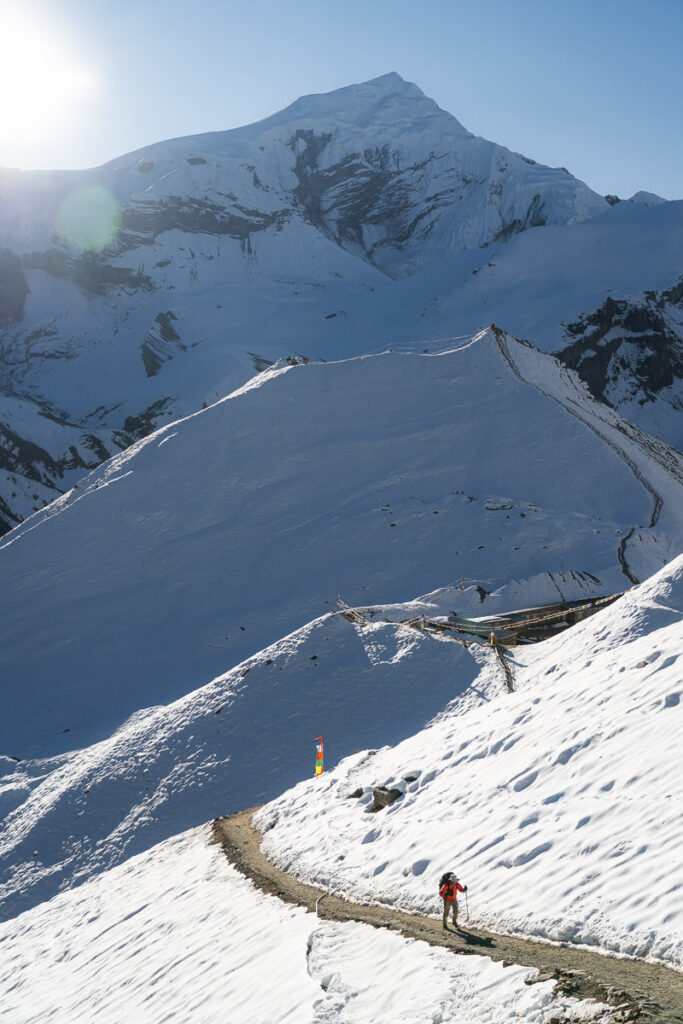
HOW TO GET TO THE ANNAPURNA CIRCUIT TREK
There are two main ways to reach Dharapani, which is the small town at the starting point of the trek. Despite the distance from Kathmandu to Besishar only being 125km, the journey takes a long time due to the traffic and quality of the road.
Jeep: We went by private Jeep organized by our tour company Himalayan Masters. It costs about $180 to hire the vehicle out for the drive so can be split between your group. It’s not cheap but much less brutal than the lengthy bus journey.
Public Bus: The bus costs about $12 USD and can take anywhere from 7-12 hours depending on the traffic and if there are any roadworks or landslides recently. The bus station in Kathmandu is called ‘ New Bus Station ‘.
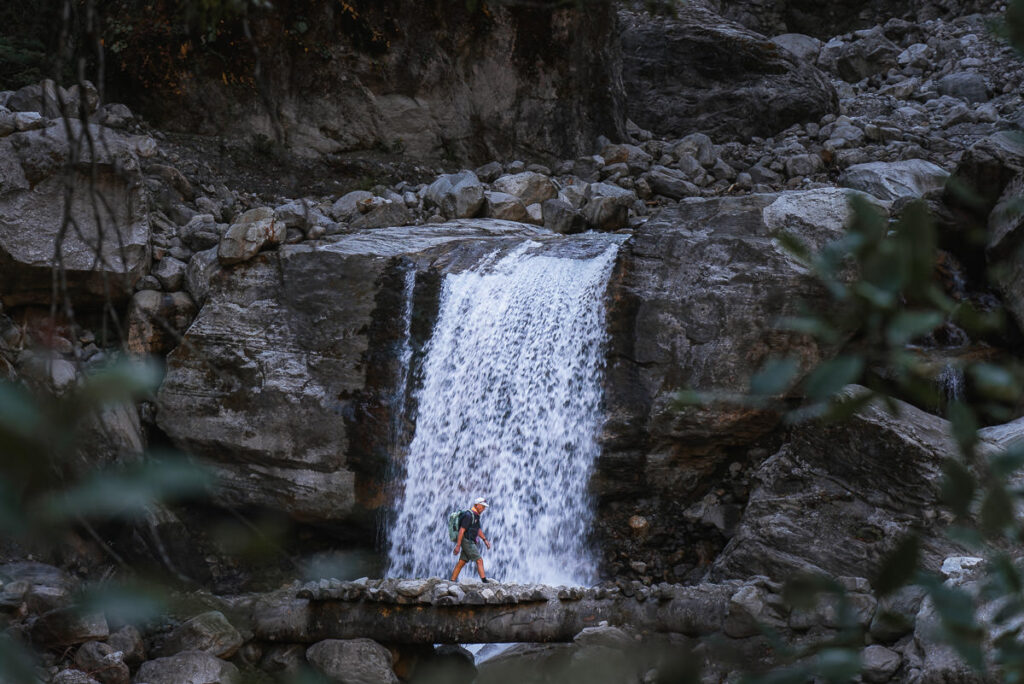
MY EXPERIENCE ON THE ANNAPURNA CIRCUIT TREK
Throughout this section of this guide, I will share my experience with each part of this trek and give my thoughts on the increased level of infrastructure and road access throughout the Annapurna Circuit Trek.
TREKKING FROM DHARAPANI TO MANANG
After surviving the bumpy ride along the cliff-side roads to Dharapani, we spent the night in a small teahouse before beginning our trek the next morning. Dharapani is actually where the Manaslu Circuit Trek finishes, so I had been in this small river-side town on several occasions previously. The trail for the Annpurna Circuit doesn’t overlap with that route at all and actually follows a road for the opening parts of the journey.
The first few days of the Annapurna Circuit Trek, are not the most peaceful or remote. Trekkers will find themselves being overtaken by Jeeps full of tourists driving deeper into the circuit or being dropped closer for a quick summit attempt at Tilicho Lake. I always hate when cars can drive past me while I’m working hard trekking but it’s unfortunately just part of this route now.
Despite trekking on a road for a fair portion of the first day, there are many side trails that quickly immerse you into the natural surroundings. We found ourselves on steep stairs in the forest and walking through small villages as we wound our way on and off of the road throughout the days. The highlights when it came to views early on in the trek was that from the very first morning, we had views of Manaslu (8,163m). This qas quite nostalgic for me and actually pretty incredible to have Manaslu as a constant backdrop given that I’d stood atop the mighty mountain a year earlier.
Chame was our first stop for the night and was probably my least favorite town of the lot. This is often to be expected when you are just getting started on the trail. The second night in Upper Pisang, we had a direct view from the tea house looking towards Annpurna II. They call it the unlucky mountain as it just misses out on being one of the 14 revered 8000ers. At 7,937m, it is an imposing peak, providing an unbelievable view right from the doorstep of the tea house.
Manang was the first town that felt quite remote and had a bit of atmosphere. In Manang there were several bakeries, religious sites, sacred lakes and monasteries. We spent two nights in Manang, as do many trekkers, and used the ‘rest’ day to head up to Chonggen Viewpoint for more incredible views over Manang and the surrounding mountains.
The scenery alongside the trail had become incredible by day three. While cars can still access to Manang, there was much less traffic and that rural, remote feeling had replace the chaotic, touristic vibe from the early moments of the trek.
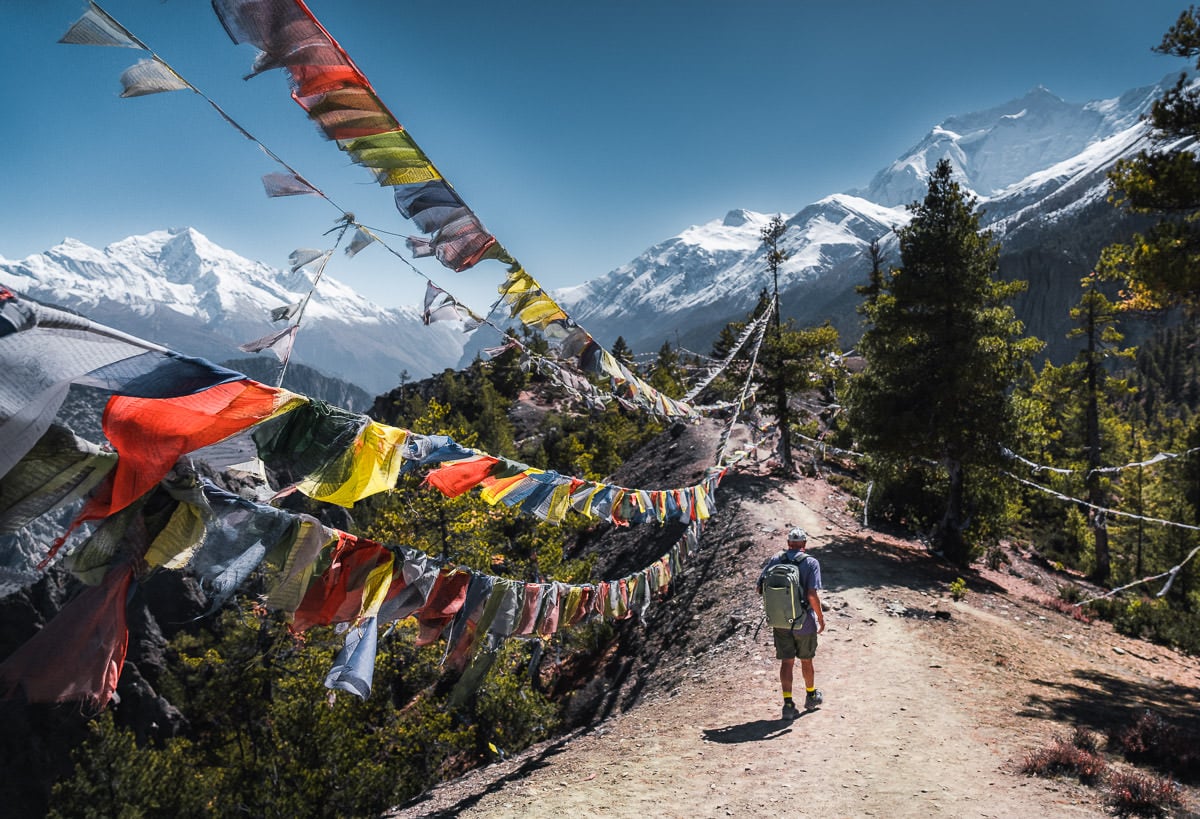
TREKKING TO TILICHO LAKE
After a rest day in Manang, it was time to put in a few ‘big effort’ days as we head some serious distance and elevation gain ahead of us. Many groups head from Manang to Yakharka and continue on to the pass. However, it is possible to make a two-day or preferably three-day detour with a mission of hiking up to Tilicho Lake.
The lake is marketed as the highest lake in the world although given some research, you will find that there are about twenty different lakes that are higher than it such as Lake Titicaca. Others claim it is the highest glacial lake in the world but just across the border at 6,216 meters above sea level is the Changtse Pool in Tibet.
Despite being a bit over-hyped and falsely advertised to pull in more tourism, the lake is an incredible natural site. You might curse me for the extra few days of effort to get there but I think it’s well worth making the detour for a few reasons.
The trek into Tilicho Base Camp was one of the best sections of the entire trail. The vegetation faded away and the terrain began to evolve into an outer-space, moon-like scene. Huge slops of gravel were segregated by rock archways and sharp ridgelines. It was like no other part of the trail.
Once you reach Tilicho Base Camp, you’ll find that it isn’t a town and is an opportunistic collection of tea houses set up to meet the demand of those on a mission to reach the high-altitude lake. Hundreds of trekkers wake early to attempt to climb 900m of vertical gain to almost 5000m for a viewpoint at the rim of the lake. It’s pretty steep and a consistent set of switchbacks make the path a tough route, especially after just a few days at high altitude.
After a few hours, trekkers reach the lakeside to find a small teahouse serving coffee and tea. Taking a seat on the stone wall, it’s truly incredible to look out across the vivid blue water completely surrounded by snowy peaks and ridges.
The tough part about trekking to Tilicho Lake is that it is a 12-kilometer round trip journey with 900 meters of incline to get to the lake and back to base camp. Most itineraries dictate that you will quickly eat lunch and then walk another few hours to Shreekharka. It could be a suggestion to stay another night at Tilicho Base Camp to ease the difficult of the trek itinerary.
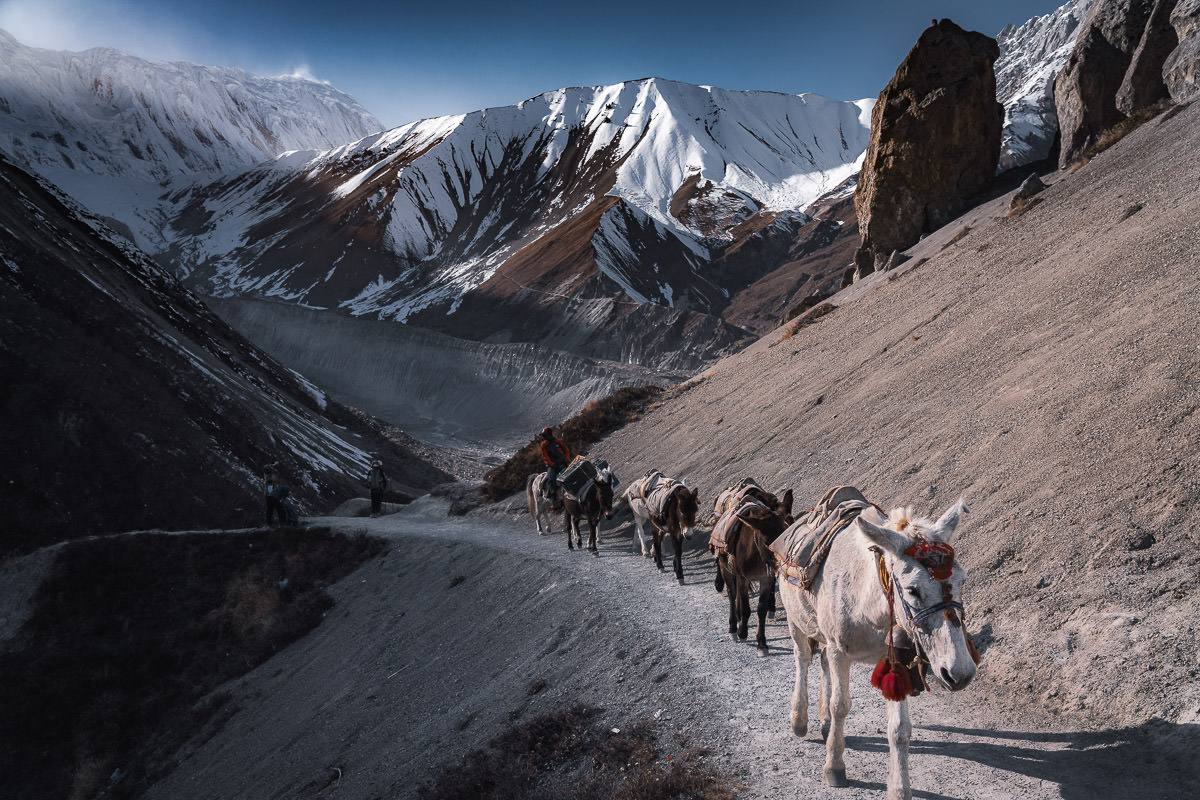
TREKKING ACROSS THORONG LA PASS
The long day up and down from Tilicho Lake and then from Tilicho Base Camp really took it out of us. However, the show must go on and we made a big effort to push all the way through from Shreekharka to Thorong Phedi. This is the base camp for the Thorong La Pass, which is the penultimate point and highest elevation of the trip.
The views continued to be immense on the journey to Thorong Phedi, but a third straight day with a vertical kilometer of incline and 20km of distance took its toll. We arrived late to Thorong Phedi, just before the sunset as you can see in the first image below.
The tea house at Thorong Phedi was buzzing, packed to the rafters. Many groups set off as early as 2:30 am on their quest to cross the path. We decided to bring up the rear and set off an hour before sunrise at around 5 am after a quick breakfast in the tea house.
The journey across the path begins with about 500m of elevation gain while ascending up relentless switchbacks. You can see the switchbacks from the tea house in the image below. After about 1.5 hours, trekkers reach the ‘high camp’, which is actually where many people stay on their approach to Thorong La Pass. It will make the pass day shorter but the prior day longer. It’s all about preference.
After the high camp, the scenery turns from rock to snow. We are now in a white, winter wonderland as we cross the 5000m mark on our journey across the pass. Up a seemingly never-ending slope, we wind our way around each corner.
Secretly, we are hoping to see the prayer flags of Thorong La but they never come. What we do find is a tea house serving overpriced but highly necessary instant coffee and tea. Here we recharge for half an hour before making our final push to the pass.
About an hour further and we make it up to the pass after about six hours of trekking. My dad and his mates are gassed but glad to be at the highest point of the trip. We hang out, take a few photos and even witness a huge avalanche from the seracs on the right side. Luckily it dispersed down to the side of the mountain and not toward us.
The journey down from Thorong La Pass should be straightforward and is only about eight kilometers. However, with icy conditions and slippery rocks, it was slow-going. It is highly recommended to bring micro spikes for this descent and for the descent from Tilicho Lake. Even though you will only use them twice, they are worth bringing along.
Late in the afternoon, we roll into Muktinath after crossing over into the Mustang region from the Annapurna Sanctuary side. It’s beautiful scenery but we are all just glad to make it to the hotel. It was a pretty tough ‘summit’ day all things being said.
Many trekkers will walk one more day to Jomsom before flying to Pokhara. However, we decided to take a Jeep for about $15 per head. It’s only an hour’s jeep ride to Jomsom.
I’d advise taking the Jeep as the trek looked like it went alongside the road in hot, exposed, dry terrain for twenty kilometers. It’s a brutal and unnecessary section of trail to walk but some purists may like to complete the old ‘original’ circuit. If that is you, make sure you walk all the way to Pokhara, and don’t cheat with any planes from Jomsom!
We spent the night in Jomsom and celebrated with a couple of beers. The next morning, we watched as the light planes flew into the airport. It’s a unique landing strip with an amazing backdrop of mountains on all sides. The planes take off and do a full U-turn immediately before flying up and out of the valley with views of Dhaulagiri (8,167m) on the right.
After a few nights in Pokhara, we flew back to Kathmandu to wrap up an incredible journey on the Annapurna Circuit with Himalayan Masters .
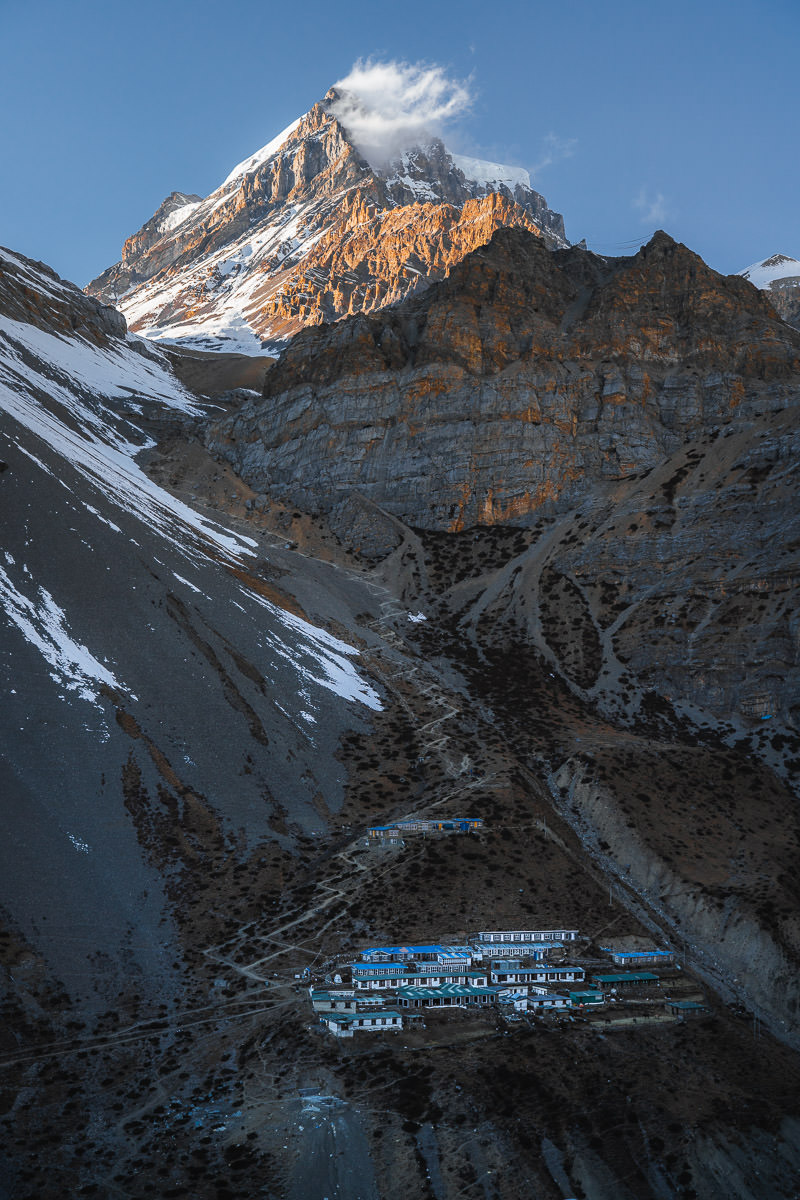
I hope you enjoyed this guide to the Annapurna Circuit Trek in Nepal and have a great experience yourself! To finish up, here is a photo from the epic Jomson airport. Not a bad way to end the trip.
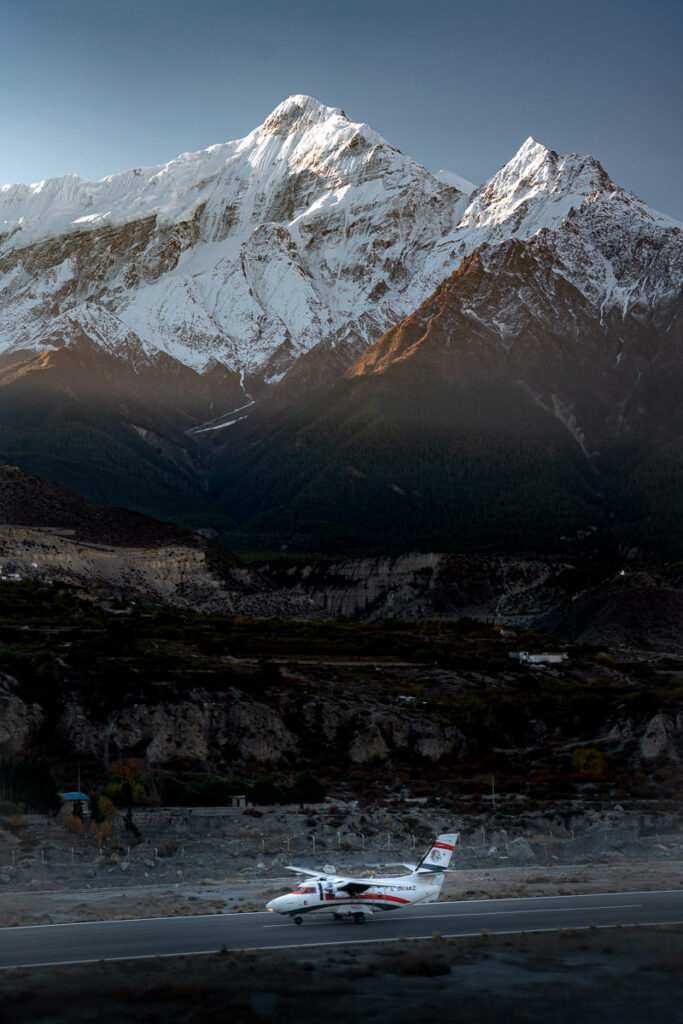
HAVE YOU READ MY OTHER NEPAL BLOGS?
I’ve been lucky enough to have many awesome adventures in Nepal, which you can check out below where I’ve listed some of my favorite blog poss from Nepal.
- The Most Iconic route: Everest Base Camp Trek
- The Most Scenic Route: Annapurna Circuit Trek
- My Favorite Trek in Nepal: Manaslu Circuit Trek
- An Easy Nepal Trek: Langtang Valley Trek
- A great beginner peak: Island Peak Climb (6,165m)
- My Favorite Climb in Nepal: Climbing Ama Dablam (6,812m)
- My first 8000er: Climbing Manaslu (8,163m)
- My toughest climb in Nepal: Climbing Makalu (8,463m)
- Where to stay: 16 Best Places to Stay in Kathmandu

Sunday 11th of June 2023
Hi, I noticed a news that Nepal treks should only be allowed only with a guide, starting from April 2023. Your article seems to be from June 2023. Does it mean that Annapurna Circuit has an exemption? Thanks a lot!
Sunday 2nd of July 2023
Thanks, honestly, this is a reason for me not to even think about Nepal and consider e.g. Patagonia
Sunday 18th of June 2023
Anything above 3000m I believe you need a guide now
Thursday 9th of March 2023
Please tell me more about your photography set up. Camera, lens, gear etc Thank You! :)
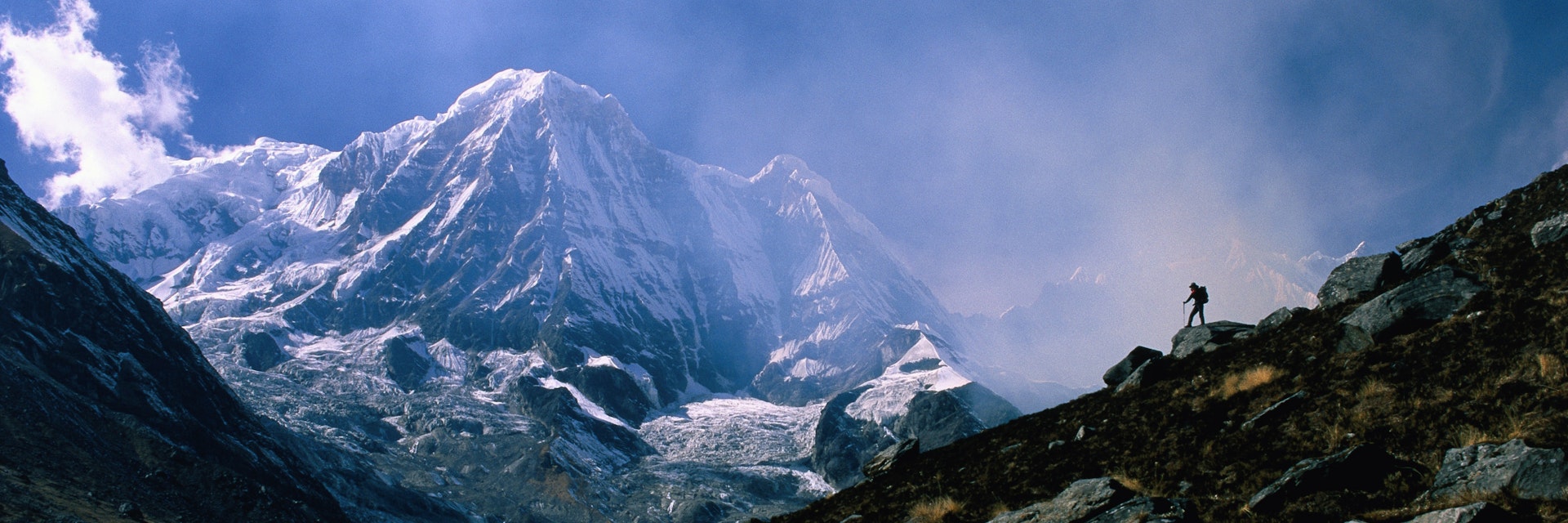
Annapurna Circuit Trek
For scenery and cultural diversity, this has long been considered the best trek in Nepal and one of the world’s classic walks. It follows the Marsyangdi Valley to the north of the main Himalayan range and crosses a 5416m pass to descend into the dramatic desert-like, Tibetan-style scenery of the upper Kali Gandaki Valley.
Leave the planning to a local expert
Experience the real Annapurna Circuit Trek. Let a local expert handle the planning for you.
Plan with a local
Experience the real Nepal
Let a local expert craft your dream trip.
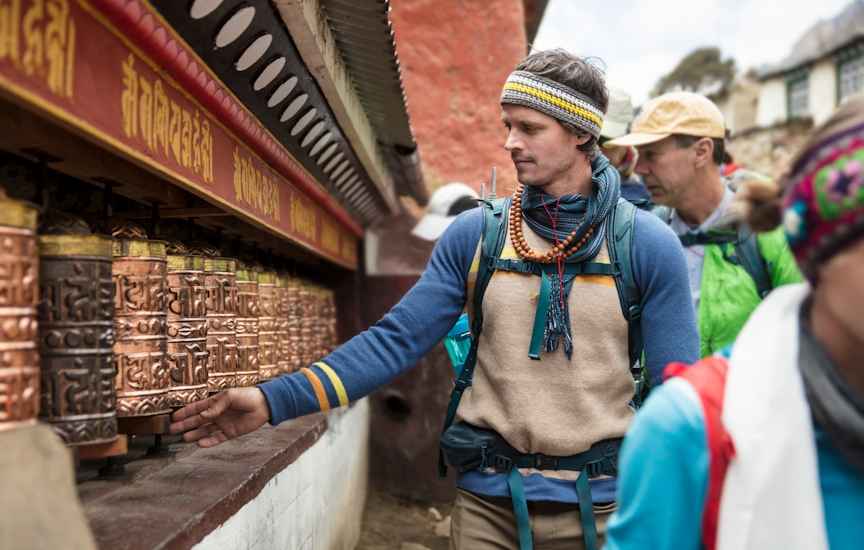
Purchase our award-winning guidebooks
Get to the heart of Annapurna Circuit Trek with one of our in-depth, award-winning guidebooks, covering maps, itineraries, and expert guidance.
Whatsapp/Signal/Telegram 24/7: +9779849697919

Annapurna circuit trek
NTH » Annapurna circuit trek
Based on 70 Reviews
- Trek Duration 10 Days + –
- Accommodation Tea House Trek
- Max Altitude 5416 Meters
- Trekkers Numbers 1-18 but Flexible
- Best Time of Year Spring and Autumn
- Trek Difficulty Adventure
- Price: 750 or + – Quick Inquiry
Overview of the World’s most famous Round Annapurna trek
Annapurna circuit trek 10 Days is the fastest itinerary of the Annapurna circuit trek. Annapurna circuit trek or Thorong la pass trek is one of the world’s most popular hiking trails. Guide books like Lonely Planet have been continuously recommending Annapurna Circuit Trek as one of the best trekking and hiking trails to explore. Every year it welcomes thousands of trekkers across the globe to explore the beauty of the Annapurna Himalayas, local culture, and diversified amazing landscape. Each year, on an average more than 120,000 hikers do Annapurna circuit hiking. On this trekking trail, The scenery changes dramatically from subtropical forests to cone forest and eventually it turns into the Himalayan desert. Annapurna circuit hike allows hikers to enjoy the Annapurna Himalayan Range and Dhaulagiri Himalayan range together.

Annapurna circuit trek is one of the best treks in Nepal. The trek starts at Lamjung then circles the whole Annapurna range clockwise and finishes at Pokhara. This is the reason you would enjoy the spectacular range of the Mountain peaks along the whole Annapurna circuit trek. Annapurna 8,091 Meters is only visible from the top of poon hill but other peaks like Annapurna II, III, IV, Gangapurna and Tilicho with the height of 7940 Meters, 7,555 Meters, 7,525 Meters, 7,4555 Meters, 7,134 Meters, Chulu east, Chulu west, Yak Kawang, throng peak, Dhaulagiri 8167 Meters, Nilgiri South 7061 Meters, Nilgiri North, Dhampus peak, Tukuche peak and many other unnamed peaks. The deepest George, Natural Hot Spring, very colourful landscape, Muktinath temple, Kali Gandaki River bed, Marpha, Poon Hill 3200 Meters are the Major things that you would see on your Annapurna Circuit trek.

Table of contents
- 1. Annapurna Circuit trek highlights
- 2. Annapurna Circuit trek Facts
- 3. Annapurna Circuit trek best time/seasons
- 4. Annapurna circuit trek information
- 5. Annapurna circuit trek preparation
- 6. Annapurna circuit trek map
- 7. Annapurna circuit ice lake Hike
- 8. Annapurna circuit trek Itinerary
- 9. Include in cost
- 10. Exclude in cost
- 11. Annapurna circuit cost for Nepali
- 12. What hike is best for acclimatization
Key Takeaways
- Annapurna circuit trek also known as a Round Annapurna or Thorong la pass trek which circles the Whole Annapurna Range Clock-wise via Thorong la pass 5416 Meters
- Annapurna circuit trek is total 2 weeks trek plan but it can be done even in 10 days if you have a 2 weeks holiday in Total
- On Annapurna circuit trek, you can see 3 mountains (Mt Manaslu, Mt Annapurna and Mt Dhulagiri) which are above 8000 Meters plus many other peaks.
- The landscapes is very difersified, from very low-lands sub tropical to Alpine can be feel during this trek.
- The Annapurna circuit trek goes via Marshyandri river and cross the Thorong la and arrives at Kali Gandaki Valley where trekkers can encounter different types of the people and cultures.
- This is the most popular trekking trails in the world
Annapurna circuit trek facts

Annapurna Circuit trek highlights
- Scenic drive to Besisahar from Kathmandu which is 165 km, you can see the beautiful scenery, rivers and the local settlements.
- Beautiful green hills around the valley before you reach Jagat, after Jagat the valley becomes very narrow and steep, you can see the bamboo bushes around the trek route and the Fast following Marshayndri river.
- View of Mt. Manaslu and Mt.Manaslu North, Himalchuli from Timag and Chame which is very fascinating. Nice hike through the pine forest to the Chame.
- Enjoy the hot springs in Chame with the view of Lamjung Himal.
- Crossing the biggest apple farm of Nepal, where you can enjoy the apple products, bakery and coffee with an outstanding view of Annapurna II 7940 Meters.
- The mesmerizing view of the Mountain ranges through the Dhukurpokhari, Lower Pisang and Upper Pisang.
- Trek via beautiful lakes with the outstanding view of the Annapurna ii 7940 Meters, and from Gyaru, you can see Annapurna III, Annapurna IV, Gangapurna, Tilicho peak and many other mountains peak which is beyond the imaginations. You can see the marvellous valley down below where there are an airstrip and some beautiful villages.
- The sightseeing in Manag village, you can choose either go hiking another side of Manag or set an adventurous journey to ice lake 4600 Meters. On the way, you can see a marvelous mountain ranges Annapurna II, III, IV, Gangapurna and Tilicho with the height of 7940 Meters, 7,555 Meters, 7,525 Meters, 7,4555 Meters, 7,134 Meters and many other peaks. It is the best way to Acclimatize for the Thorong La pass.
- Observations of the culture and traditions of Manag people, their culture, traditions and the monastery around the Manag.
- Pleasurable trek to yak Kharka with the view of the Chulu East and Chulu west peak. Now you can not see the trees, you can see the yak hurdles and the peaks on both sides of the valley.
- Tough walk to the Thorong la pass 5416 meters then down to Muktinath. Muktinath is a holy pilgrimage place for Hindu people.
- The close view of Mt Dhaulagiri 8167 Meter from the Muktinath, The Nilgiri Mountains and the small peak around the border of Mustang and Dolpo. The colourful land of mustang makes the trek even more interesting.
- Driving or trekking through the beautiful Kali Gandaki valley, with the view of Annapurna Himalayan ranges from the Kali Gandaki Valley. You can see the beautiful apple farms around the Kali Gandaki Valley.
- Crossing the deepest George of Dana which is based on the Two tallest mountains Dhaulagiri 8167 Meter and Annapurna 8091 Meters.
- Enjoy the Hotspring of Tatopani Myagdi and trek to the Ghorepani villages via Sikha, Ghara and Chitre.
- A superb panoramic view of the tallest Himalayan ranges from the top of Poon Hill 3210 Meter, from where you can see Dhaulagiri 8167 Meters, Annapurna 8091 Meters
- Ends your fantastic trek in the most peaceful and pleasurable city Pokhara

Annapurna circuit trek cost
Annapurna circuit trek cost/price is 450$, 750$ and 850$ for Bronze, Silver and Gold schemes respectively, for minimum 2 trekkers. Single/solo trekkers cost would be expensive because of sharing cost . The cost also differs as per the transportations because you can use the public transport and private transport such as a jeep in a various place where transportations are required. The public vehicle in Nepal is usually crowded and not convenient to the tourist however if you can adjust then you may save the cost. Base on the pulblic transportation here is the cost for Annapurna circuit hike 10 days with the minimum 2 people basis.
Group Discounted Cost/Prices

Annapurna circuit trek best time/seasons
Annapurna circuit trek can be very memorable if you do it on best time/seasons. It is a very important consideration that you should do before you start your trek, time in Nepal is really matters on your adventure here in Annapurna circuit trek. Look Below what the temperature, the scenery looks like.
1. Spring seasons
This month is considered as a second-best season to trek in Nepal. This is before summertime so it is very hot and humid in the down valley and southern part of Nepal. But it does not impact you because you would go to Mountain. This is also known as a flowering season, elevation from 2000 Meter to 3000 Meter you can see, different types of rhododendron flowers and magnolia, not only this you would also see many plants get the different flower. Generally this time the sky is clear, but sometimes in the evening cloudy. This is also second-best time to visit Annapurna circuit
2. Autumn seasons
This is the very best time to Trek here in Annapurna circuit. The weather at this time is generally the best weather of a year. Most of the days are sunny. It is the main season you will see many tourists along the route. This is also a festival time in Nepal, Down in a valley you would see people they celebrate a festival. In Nepal, this month is also known as neither cool nor hot month
3. Monsoon seasons
This is month is also known as a rainy season in Nepal. It rains a lot, the sky is cloudy, very less chance to see the mountain. Leeches, flood and landslides are common in this month. This is not a good time to do Annapurna circuit trek.
4. Winter season
These months, generally it’s cold months of the year. Most of the tourist doesn’t do any adventure activities. Doing trek on this month is very difficult because of the cold environment snowfall rainfall and sometimes hell-storm as well. The sky is cloudy So you cannot see the beautiful view. For the comprehensive information go to Annapurna circuit trek best time

Annapurna Circuit trek Information
Annapurna Circuit trek Information which is short glance and character of Annapurna circuit trek
- Trek Duration: Annapurna circuit trek 18 days Upon your arrival to departure to your country, 2 Days in Kathmandu, 1 day in Pokhara, 15 Days on Trek
This is 18 Days Annapurna circuit trek, As per your needs Annapurna circuit trek is totally customize-able. We can make it from 10 Days to onward please feel free to customize your trip Customize Trip
- Max. Altitude of trek: Annapurna circuit trek 5416 Meter
- Trek Grade: Moderate trek Grade
- Trek characters : 18 days total time is required, 2 night’s Hotels in Kathmandu, 1 Night in Pokhara with Bed and breakfast plan, 15 days tea house base trek, breakfast, lunch and dinner during the trek is included.
- Annapurna circuit trek fixed departure Nepal Trek Hub can organize this trek any day of the year. If you want to it personalize your trip, you are most welcome. We can organize your private trip on your own style and time
- Equipment hire: Nepal Trek Hub offer you a complete list of equipment after you book the trek If you have not complete gear/equipment or could not manage due to time we are here to help you. You can get gear in Kathmandu, buy or rent both are possible
- Rucksack/Duffle bag: Your luggage/stuff during your trek will be carried by your porter if you wish not to take porter or you can also carry yourself. You should manage duffel or rucksack before you come here, if you don’t have we can provide you with some
- Transportation: From Kathmandu to Besisahar you go on a local bus, from there to onward it is your wish, we will bring you until Ngadi. After you pass Thorong la you will again take the local bus to Tatopani. From Nayapool you take the taxi or private vehicle to finish your trek. From Pokhara to Kathmandu you will have a tourist bus service.
Annapurna circuit trek Preparation
It is very difficult for hikers how to prepare for annapurna circuit trek while you work in your country and don’t have time to manage the things, Here is the things which might reduce your your worries about Annapurna circuit trek
Step-1: Make sure that how many days you want to spent in Nepal
The first step, you should calculate your time, how many days you are going to trek and How many days you will spend your time in the city. This allows your proper planning, such as your itinerary and sight trips like Tilicho lake and Ghorepani Poon Hill Trek also. If you have a sufficient time you can do both of this while you do Annapurna circuit trek.
Step-2: Choose the best flight to Kathmandu
Choosing the best flight is another challenge for the hikers, especially when there is short vacation, you can choose the anyone which suits you very well, for example, people from Europe love Turkish Airlines

Step-3: Know more about trekking
It is very important to take the Information before you start, here is some information which might be very important for you.
- If you are going to trek then you must calculate yourself weather you will be able to do such a big hike or not, you need to know about the trek grade, distance, how much walk should you walk in a day, how much up and down. This is Moderate grade trek. Know about the grade of trek Nepal trek grade
- Get Some Information About altitude mountain sickness, It is very good idea to collect more information about altitude mountain sickness before you go. In mountain there is no internet, so get some information of Altitude mountain sickness
- If you are wondering to get the visa of Nepal, then you can either get in your country or even in Nepal Airport. Here is information about Nepal Tourist Visa
- For Trek you need to bring enough gear, Without Proper gear, you can not do the trek comfortably, or the equipment you bring is unnecessary, then it is only carrying things to you so get the proper equipment from here. Nepal trek packing list
Annapurna circuit trek map
There are many types of Annapurna circuit trek map which you find in market. These maps are published by a different publisher, It also differs as per publisher. If you buy the map in Kathmandu, there are many publishers maps you can find, literally Nepal Map House, Himalayan Map house are two very popular maps in Nepal. If you want to get the big scale map it is little costly than normal. you can choose as per your wish but make sure that proper information on the map, Such as distance in KM, Time in Hours. We advise you to take the float-able map which can go anywhere in the bag or even in the pocket. You can get Annapurna circuit trek map free from us after you book the trip with us. We provide you when you arrive here in Nepal on your trip preparation day.

Annapurna circuit Ice Lake Hike
Ice lake hike should not be left if you do Annapurna circuit trek. Most of the trekkers do the acclimatization in Manag. Manag is located in 3500-meter surroundings with the massive mountains around. Most of the hikers do the hiking around the Manag by going to the other side of the river up to the viewpoint from where they can see the Gangapurna Mountains. This is suitable for most of you but if you want to do something challenging and explore more then you should definitely consider hiking to the Ice lake. Ice Lake 4600 Meters is incredible because you can see the Astonishing view of the Annapurna range including Tilicho peak plus a view of the beautiful lakes in such high elevations. This allows you to acclimatize very properly and you can also enjoy the incredible scenery of Mt Annapurna II, Annapurna III, Annapurna Iv, Gangapurna and many other peaks. You may also see the blue sheep while hiking to the Ice Lake.

Annapurna circuit trek itinerary
Annapurna circuit trek itinerary is here, but on your request we can modify it anytime to fit on your time frame.
- Day 01: Arrival at Kathmandu We welcome you from the airport then bring you to the hotel and brief you about the trek program as well as we also help you to hire the equipment rental.
Early in the morning Around 6:30, the Nepal Trek Hub guide will take you to the Bus park from the hotel. You take the Local Bus to Besisahar, 7-8 Hours journey by bus afterward we take the local bus to Ngadi and stay overnight here.
As our trek begins today it is quite hot to walk in lowland, the rice fields and forest we pass to reach the Bahundanda, Then the trail descend down to Syaange. We do lunch Here. From here to Chamje it takes about 2 hours to reach.
Our day starts with the descent down to the river, crossing the bridge we walk the bank of the Marshyandri river, then the trail climb rocky mountain following the Marsyandi Rivers steadily uphill to Tal at 1675 meter, Tal is the first village of the Manang district. This is a very nice village to do lunch. Now the trail becomes easier because the road keeps continuing up to Karche after Tal village. from here you cross the bridge then continue following the crossing river you reach Dharapani
This is the Junction of two trekking trails. Manaslu and Annapurna trail joins here. We need to walk with Road until Bagarchap. Here in this village people are construction meaning hydropower projects. some farmer has a fishing pond as well. We climb with trekking trail to Timang. this is of mount Manaslu and many other peaks. The trekking trail becomes easier and reaches Chame.
Early In the morning, you can see the view of Lamjung Himal from Chame. After breakfast, the trail is with the road until the Dukurpokhari 3-4 Hours walk. You do lunch here. You can go to either lower Pisang or upper Pisang from here. Overnight at Lower Pisang
First of all, you cross the Marsyandi River. Then there is a small road to Gyaru. We keep walking until there is a river appears. On the way, you can see a small but very beautiful lake. Now you need to climb very steeply which might take 1.30 hours. Here is a small viewpoint from here people can see Annapurna iii, Annapurna ii, Annapurna iv, Gangapurna, and Tilicho lake. Locals are waiting for the trekkers to sell their bread and tea. The trail is now easier as it goes all the way forest to Ngwal. You do lunch here then descend down to valley you will reach Braga and Manag afterward.
This is our acclimatization day. You have many options to hike here to keep your body acclimatize, some hikers hike to Gangapurna Lake and onward, and some hike to Ice Lake. You can choose one of these depending on your wish.
As you check the permit here the Trek goes through the cultivated land of Tanki Manang. A beautiful view of Tilicho Peak can be seen from here. you make the climb steadily through Tenki Manang to Gunsang, leaving the Marsyandi Valley. The trail climbs an ascent of nearly 500 meters to the Yak Kharka. It is located at 4050 Meter.
Today you start your hiking from yak Kharka. A yak pasture the trail gently climbs onwards to Thorong Phedi 4450 Meter. There is some area where you need to very be careful because of stone fall. You can have lunch here or can have a couple of cups of tea and coffee to strengthen your stamina. Now the trail is very steep and full of the moraine, continually hiking 1.30 Hour you can reach Throng High Camp.
The most challenging day of the trek is today. Generally, trekkers start their trek early around 4:00 clock to 5:00 o clock. The early you start the better for you. As you are already on very high land it is quite harder for you to gear up. As you use it, it would be quite easier for you. The way to Thorong is not so steep. the trail climbs slowly but gradually up. On the way to Thorong La pass, you can also take the tea and coffee in the shop. It is generally 3 Hours climb to Thorong La pass. As you arrived at Thorong la pass, it is windy and cold here. You can see the mountain on the mustang side. The trail is now to go down. All the way down to Muktinath. Overnight at Muktinath
As you finish the walk, today you will take the local bus to Tatopani. The bus stop often for local people to come in and go down. You can see the village like Jomsom. Syang, Marpha, Kalopani, Kobang, Ghasa, Dana and finally to Tatopani. It is quite adventure driving because of a local bus. After you arrive at Tatopani you can enjoy the hot spring here.
Leaving the Tatopani, then climbing to Durbin danda is another unique experience you feel today, as you walk down the valley it is quite hot and humid. The view of the green village is awesome, you would see rice field and different types of fruit in the village, this is pretty nice to walk you would cross Sikha, Ghara, Chitre and then finally to Ghorepani.
Early morning today you will trek to Poon Hill 3210 meters to see the splendid view of Mt. Annapurna range, this is one of the best viewpoints of Nepal of mountain panorama. As you come down to Ghorepani you would do breakfast. After breakfast, we trek descent down to Tikhedhunga and drive to Pokhara
The morning we’ll drive back through the scenic countryside and during the route will stop for breakfast and lunch. It takes 7 hours back to Kathmandu. On arrival at Kathmandu, the guide will transfer to the hotel and rest of the day relax or explore the surrounding areas and overnight at the hotel.
- Day 16: Departure from Kathmandu
Annapurna circuit trek cost includes
- Kathmandu international airport transfer by private vehicles.
- Meals on full board: Breakfast, Lunch and Dinner each day during the trekking days
- Guest house basis trekking accommodation while on trekking days
- Tourist Bus transfer from Pokhara to Kathmandu for guest and guide.
- Fully escorted trek with fluent English speaking license holder local guide and each 2 guest 1 Porter basis
- Muktinath To Tatopani Transfer by the local Bus
- Local bus transfer from Kathmandu to Ngadi for the guest and Nepali staff
- Local bus transfer from Hile to Pokhara
- Annapurna conservation Area Project Permits
- Trek Duffle Bag for the guest
- Seasonal Fruits if possible
- First Aid Box
- TIMS Permit
- All land transportation as per written on above itinerary
- Food and accommodation and salary of Nepali trekking staffs
Cost excludes
- Nepal entry visa fee cost US$ 40.
- Lunch and Dinner during the staying in Kathmandu and Pokhara city.
- Any kinds of battery charges, laundry service, phone calls and hot shower during the trekking.
- Personal trekking equipment and Clothing.
- Personal nature expenses, any drinks and bar bills.
- Your travel insurance (it is mandatory in case of emergency).
- Any donation and monuments entrance fees.
- Tips for the crew (Note : TIPS is not compulsory but highly expected)
- Any other things which are not mentioned above
Read our client’s feedback on our service
Excellent annapurna circuit and lantang trek.
Between April and May 2019, I had the pleasure of doing 2 treks with Shreeram the young boss of Nepal Truk Hub Pvt.
I contacted him by email (as well as two other guides by email) a few weeks before my departure for Nepal to explain and validate my project:
1 short trek of 8 days at – 5000m
1 long trek of 18 to 20 days at +5000m
A few requirements: Just a guide and me, no porter and a good level of English.
I met Shreeram the day after my arrival in Kathmandu and the current immediately passed between us on the human, practical and financial levels.
In total we trekked and lived together for 26 days (Langtang Valley & Annapurna )
We spent fabulous moments of discovery, sharing, effort (especially for me…) of complicity and laughter.
Shreeram has a perfect knowledge of the mountain, its history, its fauna, its flora and its risks. During our days and depending on my physical condition, I have always been able to count on his sense of adaptation, his support sometimes (especially to carry my heavy photo box) and his patience.
Shreeram knows how to listen, observe and organize with the sole aim of satisfying you.
He has a serious culture, a desire to share his mountains, his country and he remains very curious about Europeans and our culture.
So I can highly recommend Shreeram!!
Thank you again Boss;) for these excellent moments and unforgettable memories!!
Response from Nepal Trek Hub
Namaste frederic BIEN
We highly appreciate your review and are happy that you are satisfied with our service. It was a very nice time with you and had great moments. We would be very happy to see you again in Nepal
Best Regards
Shreeram and team
Annapurna circuit trek 2019
Just returned from the Annapurna Circuit trek with a group of friends, and the experience has been nothing short of amazing! It would not have been possible without our awesome tour guide, Shreeram, and our two strong porters (who happen to look like Korean twins btw), Dev and Surendra.
Personally, I like to engage a local guide when trekking especially in unfamiliar places (this was our group’s first time in Nepal as well as doing such a long trek!), because I’d like to think that the local guides know the ins and outs of the trail better; making sure safety is the utmost priority while not compromising on the view and experience.
Fortunately for us, Shreeram did exactly what we exp ected of him and far more.
Throughout the 12 days Shreeram always made us feel safe, was observant, caring, and sensitive to our needs. He would advise us on the Do’s and Don’ts throughout the trek, and I am grateful that none of us ran into any major issues (whether general wellbeing/safety/comfort) under his care and guidance. He is also extremely knowledgeable about the Himalayas and the surrounding region, as he patiently answered all our questions and always kept us entertained with little nuggets of information. And added bonus to this all was Shreeram’s unique sense of humour which created a lighthearted vibe within our group, always making us chuckle away.
Not forgetting our porters Dev and Surendra who also did an amazing job, each of them carrying >20kgs over their shoulders every day (with a strap across their forehead to support the load :O ) , never once complaining, and always early to arrive at our destination to secure the best rooms possible for us.
All-in-all, we are extremely grateful to have had Shreeram, Dev and Surendra as part of our trip. While all the above may seem like “small” things, trust us when we say – it makes all the difference and is definitely what separates just “normal” from “GREAT”.
Hello and greetings from Nepal Trek Hub
Thank you very much for your valuable feedback regarding our service. We are very glad to be with you for two weeks and could provide our service. We had a really good time with you people and we never forget your team as well. The time we spent together was too short for us and we did not know that it passed so quickly… but the memories we have is always with us. See you again in Nepal.
Shreeram Thapaliya Managing director of Nepal Trek Hub
Wonderful guide for the Annapurna Circuit!
I used Nepal Trek hub to help guide me and 2 others through a 17-day trek through the Annapurna circuit; from Ngadi to the Thurong La pass, with detours to Ice Lake, Tilicho Lake, Tatopani, and Poon Hill. And I’m so glad we used a guide. Shreeram (or “Ram” as we called him) and his team of experienced porters were indispensable. There was major flooding in 2021 – the year before our trip – and Ram and his team helped us find the remaining undamaged trails and helped us pick the best hotels to stay at for the best prices during the whole trip. He also helped to navigate the rock fall areas and gave us invaluable knowledge of the local environment and culture (and he’s a pretty good Nepali teacher to boot!). There is something about having that local connection that just can’t be replaced. We had the trip of a lifetime and will definitely be using Nepal Trek Hub again next time we come back to Nepal!!
-Brant, USA, Minnesota
Hello Brant
Thank you so much for appreciating our service regarding the Annapurna circuit trek. We are delighted to serve you and see you again in Nepal for another adventure
Best wishes
Shreeram, Nepal Trek Hub
Write a Review
The road construction and annapurna circuit trek.
Recent years, the road has been building in Annapurna region, This has shifted the trekking trail as well as trekking villages as well. To avoid the road trekkers should go through NATT (New Annapurna Trekking Trail) Trail, Road construction has shortened the trek but, you can avoid this using NATT Trail. For Example, there is Lalupate trekking trail that starts from Besisahar and reaches Tal Village. The original taste of trek remains same, yes, of course, sometimes you need to walk through the Besishar-Manag Road which is normal. After road built a lot of mountain riders ride by cycle in Annapurna circuit trail. Mustang and Manag are the best area of Nepal to do Mountain Biking.
How does Annapurna circuit trek go?
Annapurna circuit trek or Annapurna circuit hike generally starts at Ngadi Bazaar. Nowadays there is a road so you can shorten your itinerary up to 10 days which is very minimum. As long as the trek moves on you will enjoy the spectacular view of the Mt Manaslu Range and Mt Manaslu 8,153 M (from Dharapani to Chame). Natural Hot Springs are there on Chame to enjoy. From Chame to Onwards till the Thorong la pass you will see the Mt Annapurna Range Mountains. Acclimatization is very essential for you to acclimatize and you will do it on Manag. After you cross the Thorong la pass you will reach the most unique colourful landscape area of Nepal Mustang. Following the Kali Gandaki River, you will descend down and reach Poon Hill to see the 360 Degree View of the Mt Annapurna and Dhaulagiri Range.
Thorong La pass on Annapurna circuit trek
Many of the trekkers hikers say Thorong la pass trek for the Annapurna circuit trek. The reason is the Annapurna circuit trek crosses the one of the High Pass of the Himalayas that is Thorong la pass 5416 Meters. Thorong la pass is named because the trail passes the base of the Thorong peak 6100 Meters. The Thorong peak is just on the right side of the Thorong La pass. Trekkers need more stamina to pass the Thorong la because it is elevated at the 5,416 Meters. Trekkers can either start from Thorong Phedi 4600 meters or Thorong High Camp 4800 Meters. It takes 4-5 hours to reach the top of the Thorong La pass. The trail to Thorong la pass is not that difficult. It goes accent slowly and gently by crossing the multiple zig-zag and this is the most difficult part of the Annapurna circuit hike.

Frequently asked question Regarding Annapurna circuit trek
Here we have noticed some question from the trekkers before they go to Trek, We have put some answer here, if this does not satisfy your answer please do question us Ask Question
Which is the Annapurna circuit trek best time?
October, November and March, April is the best time to trek here on Annapurna circuit, However May, September and December till 15 You can do, if you are lucky enough, you can see the good view of Annapurna Himalayan Range. For more deatails go through the Annapurna circuit trek best time
How long walk per day and how difficult is walk on Annapurna circuit trek
You are required to walk 6-7 Hours per day, It is easy walk however there is not so much stairs that makes annoy to you while you walk. But the trails has so much ups and down.
What kind of accommodation is available in Annapurna circuit trek
There are normal tea houses, the Himalayan houses has used wood alot for insulation, which is warm, the bed are quite comfortable because they have a foam mattress. For Bathroom you will have a shared bathroom and toilet also shared.
Is there WIFI on Annapurna circuit trek
Now most of the Tea houses they have a WIFI, The wifi works not that fast but you can stay on touch with your friend and family.
Is there Hot Shower Available on Annapurna circuit trek?
Yes, The house organize you hot shower, most of the place they have a gas Shower, which they charge you per person, per time each time you take the shower.
Are there rescue service if there is something happened?
Yes, We do emergency rescue as per your wish and needs, if it is not that bad then we do not rescue.
Are there sufficient hotels on Annapurna circuit trek?
Yes, There are many hotels and tea houses, but in high camp there is one and only guest houses.
Is there water we can buy on Annapurna circuit trek?
Yes, Certainly there is mineral water you can purchase from anywhere, along the trail but we request you to use the your own water purification system, It helps to reduce the number of plastic bottle in environment. Statistics tell there is 2.3 million water bottle that the trekkers consume in Annapurna circuit per year. be responsible to environment.
Can I do Annapurna circuit and tilicho lake together?
Of course, you can do the Annapurna circuit trek with Tilicho Lake and it is very suitable to do. From Manag there is a lower way to go to Tilicho Lake and after doing the Tilicho Lake trek you will arrive near Yak Kharka. For More information of the Tilicho Lake you can visit the Tilicho lake trek or Annapurna circuit with tilicho lake trek .
Is there hospital or health check post on Annapurna circuit trek?
Yes, In Manag there is Himalayan Rescue Association where, you can check up with Doctor
Annapurna circuit cost for Nepali
Nowadays, Nepali also started to trek around the Himalayas and Annapurna circuit trek is their top destinations for the trek. For the vacations with the friends Nepali trekkers go to Annapurna circuit. We have given the itinerary above here which Nepali trekkers can shorten it because they can trek longer. As per our experience, Nepali can do Annapurna circuit in 6-8 days. Annapurna circuit cost for Nepali for 6-8 days cost you around NPR 35,000 to above. If you can minimize the cost it may be a little less to you
What hike is best for acclimatization on Annapurna circuit trek
Acclimatization is extremely important for all of the trekkers while doing the Annapurna circuit trek/hike. Most of the trekkers do acclimatization in Manag. Manag is elevated at the 3500 Meter. 3500 Meter is pretty high for most of you that are the reason it is very important to do acclimatization here on Manag. Most of you may think that it is just a rest day. In Fact, it is not just the rest day. Explorations and hiking to high elevated places and returning in the same place are the main things that you do for acclimatization. This allows you to acclimate properly. Ice Lake 4600 Meters is the best place to hike when you are doing the Annapurna circuit trek. The spectacular scenery of the Himalayas and the colourful Manag valley you can see while hiking to the Ice Lake.
Standard price
Per Pax, Min 2 Person base:
Our Achievements

Read Our Review

Read Our Review on TripAdvisor, We are Ranked 245/1485
Read Our Review on TrustPilot
Read Our Review on Google My Business
No of People : 1 2 3 4 5 6 7 8 9 10 11 12 13 14 15 16 17 18 19 20
Trek Information
- Best time to visit Nepal
- Nepal trek permit and fees
- Nepal trek packing list
- Altitude mountain sickness
- Nepal trek grade
- Tims card nepal
- nepal tourist visa
- Frequently asked question
- Responsible tourism
Why with us
Emphasis on the personal and customize itinerary, You can design your own personal tailored made holiday
Team of local expert guides, customer-focused, grassroots foundation with in-depth knowledge of Nepal.
Pay a fair salary to our team of reliable and experienced people
Guarantee of best value for money, best price and no hidden costs are implicit
Care for each of you individually, providing uncompromising service just for you.
Sensative about environment, we encourage our client’s to avoid mineral water, instead of this drink the own purified water and use chlorine tablet
Nepal Trek Hub has a 90% repeated customer, check our tripadvisior page
Why this trip?
This is one of the short and easy trek in Annapurna Region which gives you opportunity to see the best scenery
Big, Beautiful and peaceful Fewa Lake of Pokhara which is one of the biggest lake in Nepal. Tal barahi temple is located in the middle of the lake Phewa, you can go there by boating
If you are lucky enough, you can see Grey Langur Monkeys, Himalayan blue ship as you pass through the big rhododendron forest
Perfect view of Mt Fishtail (6997 meter) , Annapurna I(8091 meter), Annapurna ii (7995 meter) , Tent Peak(5,663 meter), Annapurna Frank, Gandrava Chuli, Hinchuli Peak and many other peaks
You can see many waterfalls and deep gorge of Modi river, Beautiful terraces, Gurung and Magar people culture and their warm hospitality

Destinations
Trekking type, annapurna circuit trek: how to hike around the annapurnas, by jan bakker.
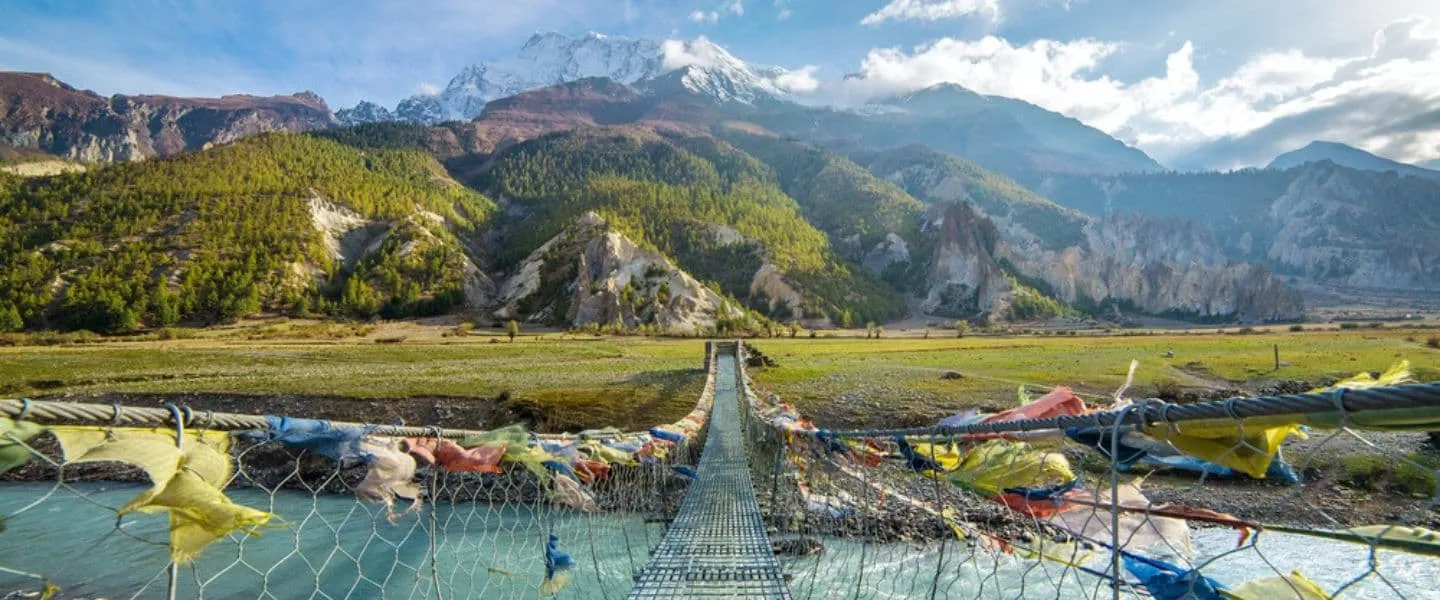
The Annapurna Circuit Trek is the most famous trekking circuit in Nepal. With some of the tallest mountains on Earth, tumbling glaciers and an incredible variety of landscapes, this trek represents everything what trekking in Nepal is about. It takes more than two weeks to circumnavigate the Annapurna Massif while staying in cozy tea houses. Over the last few years, we at Bookatrekking.com have helped hundreds of people to find their way in the Nepali Himalayas and now it's your turn.
My name is Jan and I’ve been lucky enough to hike some of the most spectacular trekking routes in Asia, including the K2 Base Camp trek in Pakistan and the Pamir Trail in Central Asia. In terms of mountain landscapes the Annapurna Circuit remains high up there as one of my favorites. Why is this classic trek so special? Let us tell you why!
Annapurna Circuit Trekking: The Ultimate Trek in Nepal
How difficult is the annapurna circuit trek, the best time to hike annapurna circuit, the dynamics of the annapurna circuit route, annapurna circuit itinerary, how to cross the thorung la, annapurna circuit map, what permits do i need for the annapurna circuit trek, staying in tea houses on the annapurna circuit, how to identify and prevent ams on the annapurna circuit trek, packing list for the annapurna circuit trek, where can i book the annapurna circuit trek.
Let me first tell you a little bit about my own experience. Over the past 20 years I have worked in the mountain tourism industry in various roles. I have written trekking guide books for Tajikistan and Tunisia, I train local hiking guides in Uganda and as a trekking guide I have led groups in the Indian Himalayas, the Karakoram Range in Pakistan, the Pamir mountains in Tajikistan and the Annapurna Circuit in Nepal. First-hand experience is invaluable and for you, as a trekking enthusiast, it’s essential to get advice from someone who has actually done it!
Jan on top of the Thorung La

Annapurna Circuit Trek Accelerated
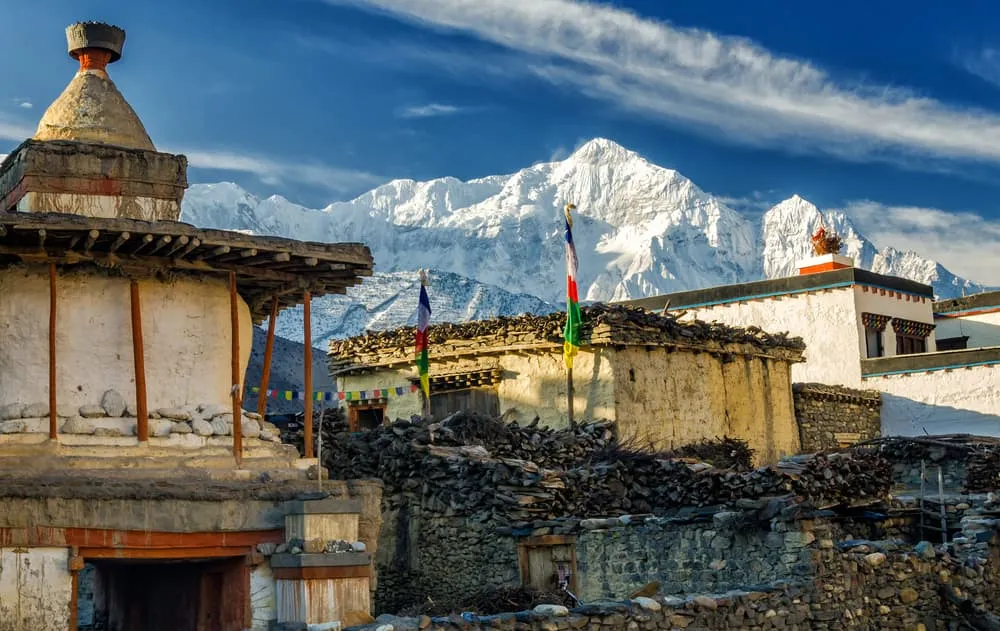
Annapurna Circuit Short
In the late 1970’s, when people started venturing into the Nepali Himalayas, the Annapurna Circuit was one of the first trekking routes to open for foreigners. In those days it took 23 days to hike around the Annapurna Massif. Fast forward to the present day, lots has changed. We’ll talk later about how trekking routes have changed in the past two decades, but one thing is for sure. The mountains of the Annapurna Massif are as stunning as they were 50 years ago.
The Annapurnas are close to Pokhara, about 6 hours west of Nepal’s capital Kathmandu. The small city, located on the shores of the stunning Phewa Lake, is the gateway to the Annapurna Massif. The Annapurna Circuit itself is a tea house trek, which means you stay in local guesthouses on the entire route. From the forested valleys at an elevation of 900 meters you’ll ascend to the Thorung La, the highest point of the trek at a whopping 5416 meter above sea level. The landscape gradually changes as you climb higher up the valley. Each day the giants of the Annapurna Massif reveal themselves a little bit more and your surroundings transform into a rugged alpine environment. The villages counter balance the mountains’ wild character. The tea houses are cozy and warm and you’ll be served endless cups of tea.
After scaling the Thorung La the route drops down into Lower Mustang, a high altitude desert with a completely different landscape. After the town of Jomsom the route continues to the hot springs of Tatopani, where you can soak and relax with fellow trekkers and locals alike. The final highlight of Annapurna Circuit is the climb up Poon Hill from Ghorepani. This is one of the most majestic viewpoints in Nepal, looking out over the entire Annapurna chain and spectacular mountains like Machapuchare and the 8167m high Dhaulagiri.
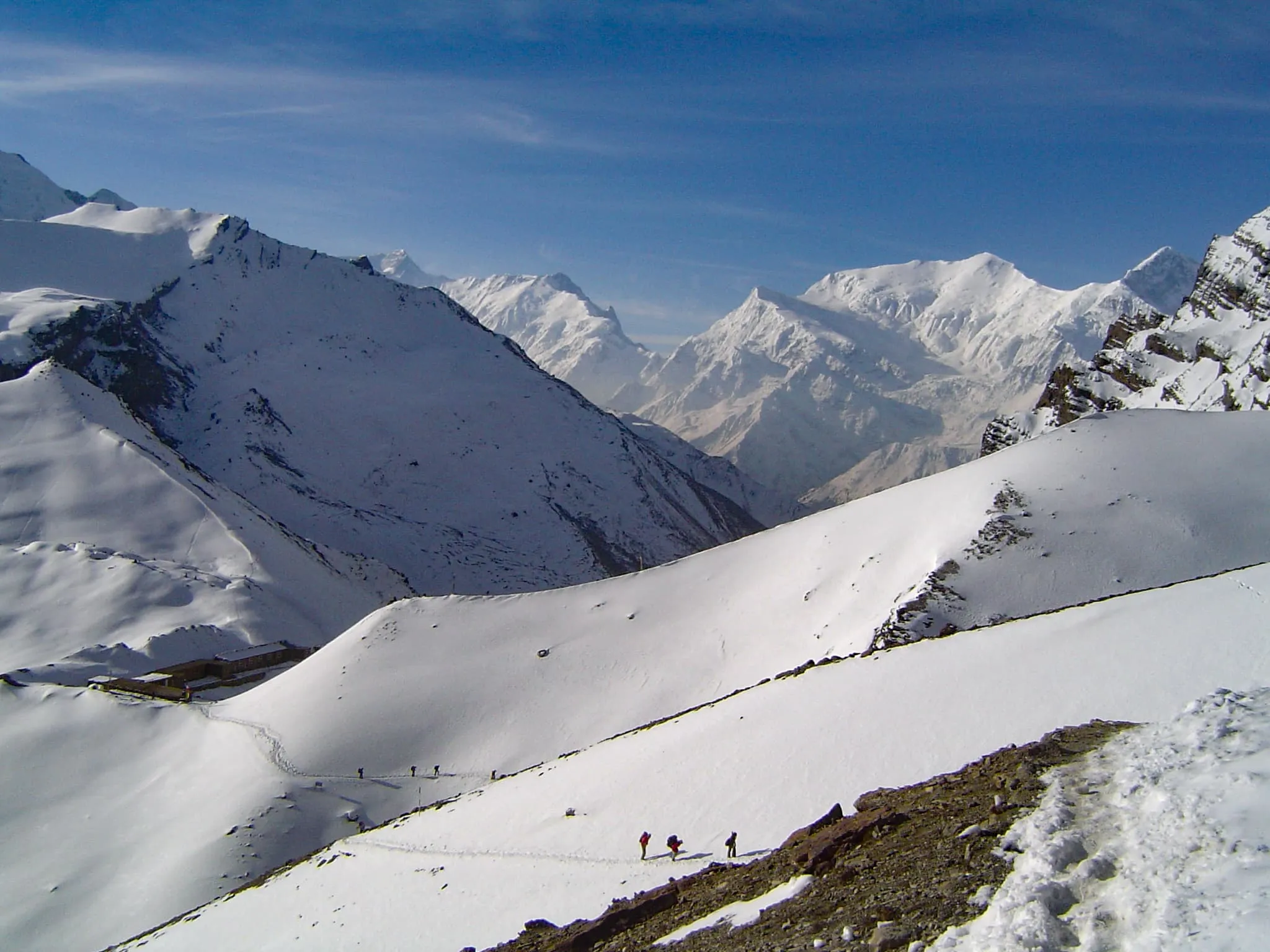
The Annapurna Circuit difficulty is quite low from a technical perspective. It's only walking and I found the path in good condition in most places. It also helps that you stay in a guesthouse each night rather than a tent. You can get a proper rest without having to worry about logistics or getting cold. It really is the Annapurna Circuit altitude that makes the going tough sometimes. After all, it is a trek at high altitude, culminating to an elevation of 5416 meters on the Thorung La. In my experience, the Annapurna Circuit length also adds to the strenuous nature of the trek. The shortest version we offer involves 170 kilometers of trekking. On some days the distances are more than 20 kilometers. Those factors make the trek hard, whether you’re a novice or a seasoned hiker. You feel your body getting tired after a prolonged time on the trail. But maybe because of that, it feels like a true sense of achievement finishing the route from start to end. I am convinced when you do some training for the Annapurna Circuit and set off with the right mindset it is doable for most trekkers.
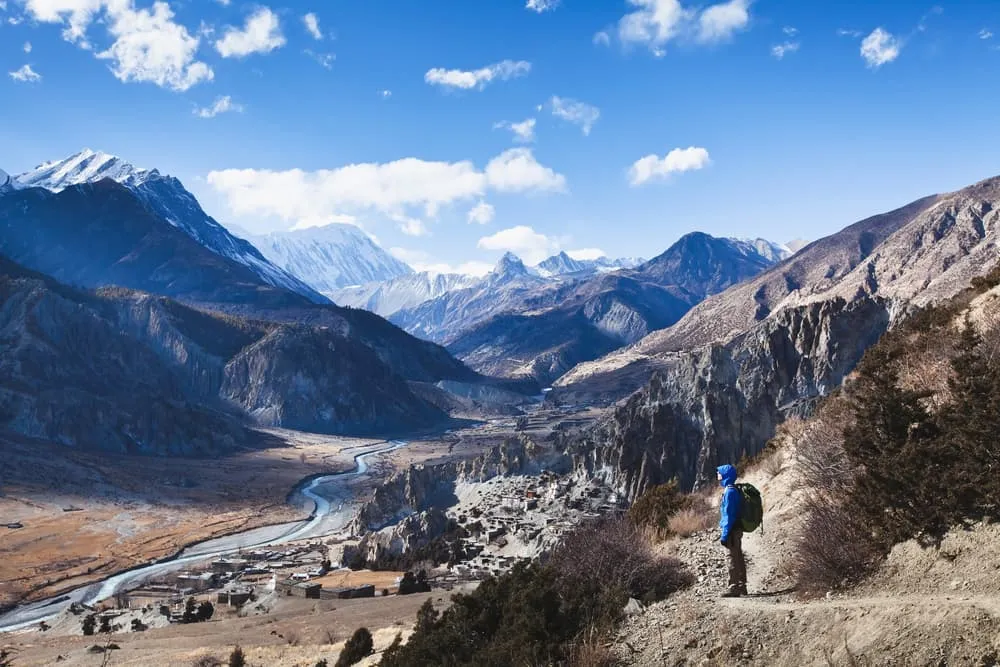
The Annapurna Region, along with most of the other trekking areas in Nepal, has four distinct seasons. Spring, summer, autumn and winter. The months from March to May, pre-monsoon, and from October to early December, post-monsoon, are the most popular for hiking the Annapurna Circuit. Every season offers its own excitement and atmosphere and in principle, you can go trekking year-round. There are good reasons why spring and autumn are considered the trekking season. Below we’ll give you a run-down of what each of the seasons are like.
Spring (March-May) is the high season and trekkers from around the globe come to the Annapurna Region in large numbers. In springtime, the temperature is pleasant, the precipitation is low and the hiking conditions are great. On the trail there’s a lot of excitement and anticipation to cross one of the highest mountain passes in the world for trekking, the Thorung La. It does get busy, but therefore it’s a great time to connect with like-minded adventurers. While temperatures in daytime along the trek are balmy, the temperature around the Thorung La can be very cold in the early morning, when you cross the pass. Check our complete Annapurna Circuit packing list further below in this blog post.
Summer season falls in the months of June, July and August. Summer is the month with higher temperatures and in that sense it is quite pleasant. However, this is also the monsoon season, and it rains a lot. The chance of seeing the mountains around you is smaller as it is cloudy most of the time. The trail will be wet and slippery and there is an increased risk of landslides. And leeches are very active during these months. On the flipside, it’s not very busy on the route and the traditional villages feel more serene.
Autumn in the Annapurna Region (September, October, November) is, like springtime, prime trekking season with similar trekking conditions. There is one difference. The air in spring is sometimes a little hazy due to the dust in the atmosphere. Post-monsoon the air is very clear, allowing for stunning views of the mountains.
Winter season runs from December to February. This period is the toughest time to trek on the Annapurna Circuit. With the Thorung La elevation exceeding the 5000 meters mark, it gets extremely cold. Night temperatures drop to -20 degrees Celsius. Add wind and snowfall and you’ve got yourself a proper winter expedition. Why do we still run the Annapurna Circuit trek in winter? We work with some of the best trekking companies in Nepal. Besides trekking trips they also organize climbing expeditions to some of the highest peaks in the Himalayas. Our partners can keep you safe and comfortable, even in these cold conditions. And you will probably have the entire trail to yourself!
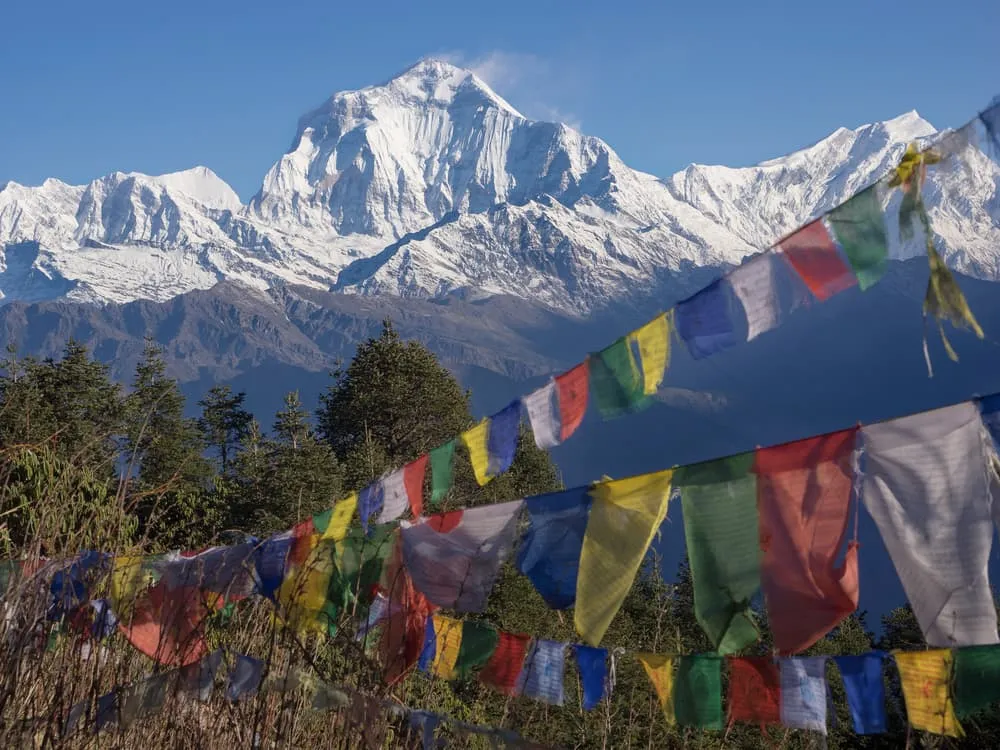
During the last 20 years a lot has changed in the Annapurna Region. In the name of progress, the lower parts of the Marshyangdi Valley have been made more accessible by building. Originally, the Annapurna Circuit route always started in Besisahar. Nowadays some tour operators opt for a start deeper into the valley as a dirt road has been built all the way to the mountain village of Manang. Bhulbhule is our choice to start the trek. From here you can avoid the road and hike on walking paths rather than the road. The biggest change however is the road development on the western side of the route. In recent years, a road has been constructed from Pokhara to Jomsom and extended even to the village of Muktinath. Some parts of the road are tarmac, some are gravel. Regardless, it has had a big impact on the original Annapurna Circuit itinerary. Especially between Jomsom and Tatopani most tour operators cover this section by car, as the alternative would be walking on a relatively busy road. From Tatopani trekkers can follow the original route again towards Ghorepani, Poon Hill and beyond. Having said all this, the Annapurna Circuit remains one of the most spectacular treks in Nepal, simply because the actual landscape and culture hasn’t changed much.
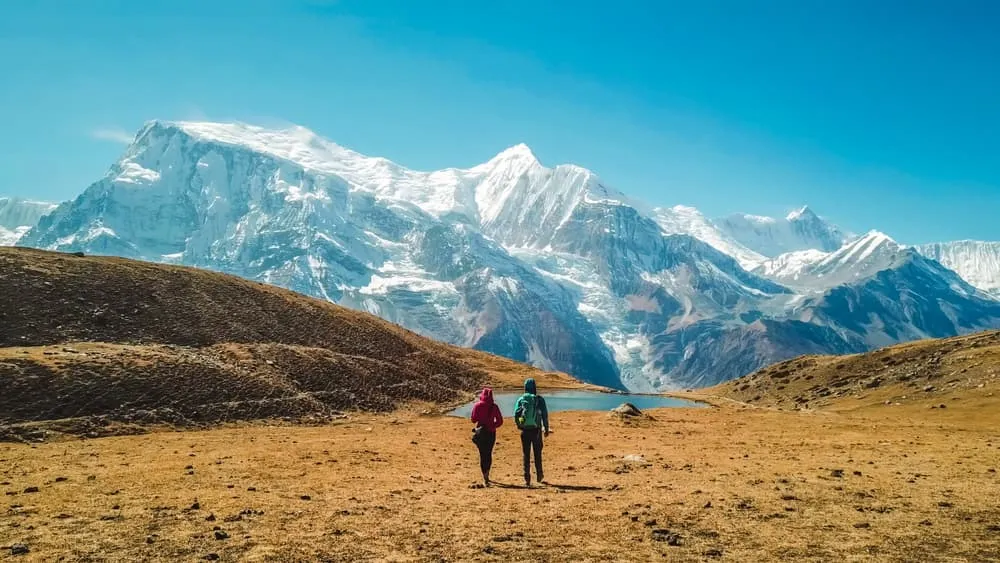
Not sure yet or want to discuss your plans for the Annapurna Circuit Trek with one of our trekking experts? Get in touch today and turn your dreams into memories!
It is best to do the circuit in 15 or 18 days. The 18-day version is old school and only follows the oldest trails. However, more and more people are choosing to do the 15-day version. If you choose the 15-day trek, you are sure to have a short break halfway and can enjoy all the attractions that the Annapurna Circuit has to offer.
Drive to Bhulbhule

Trek to Chamje
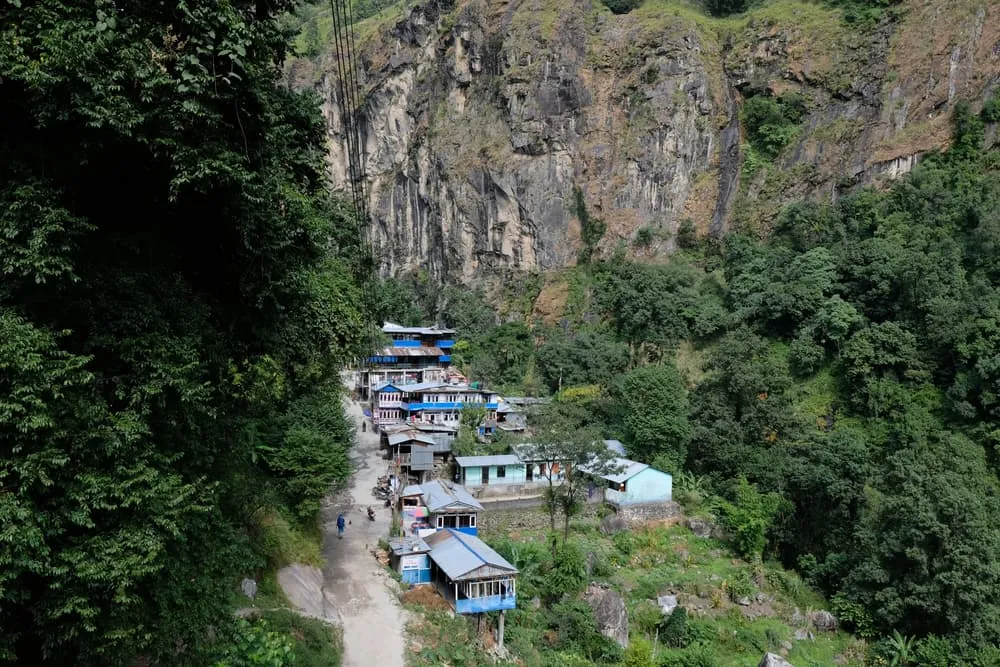
Trek to Bagarchhap
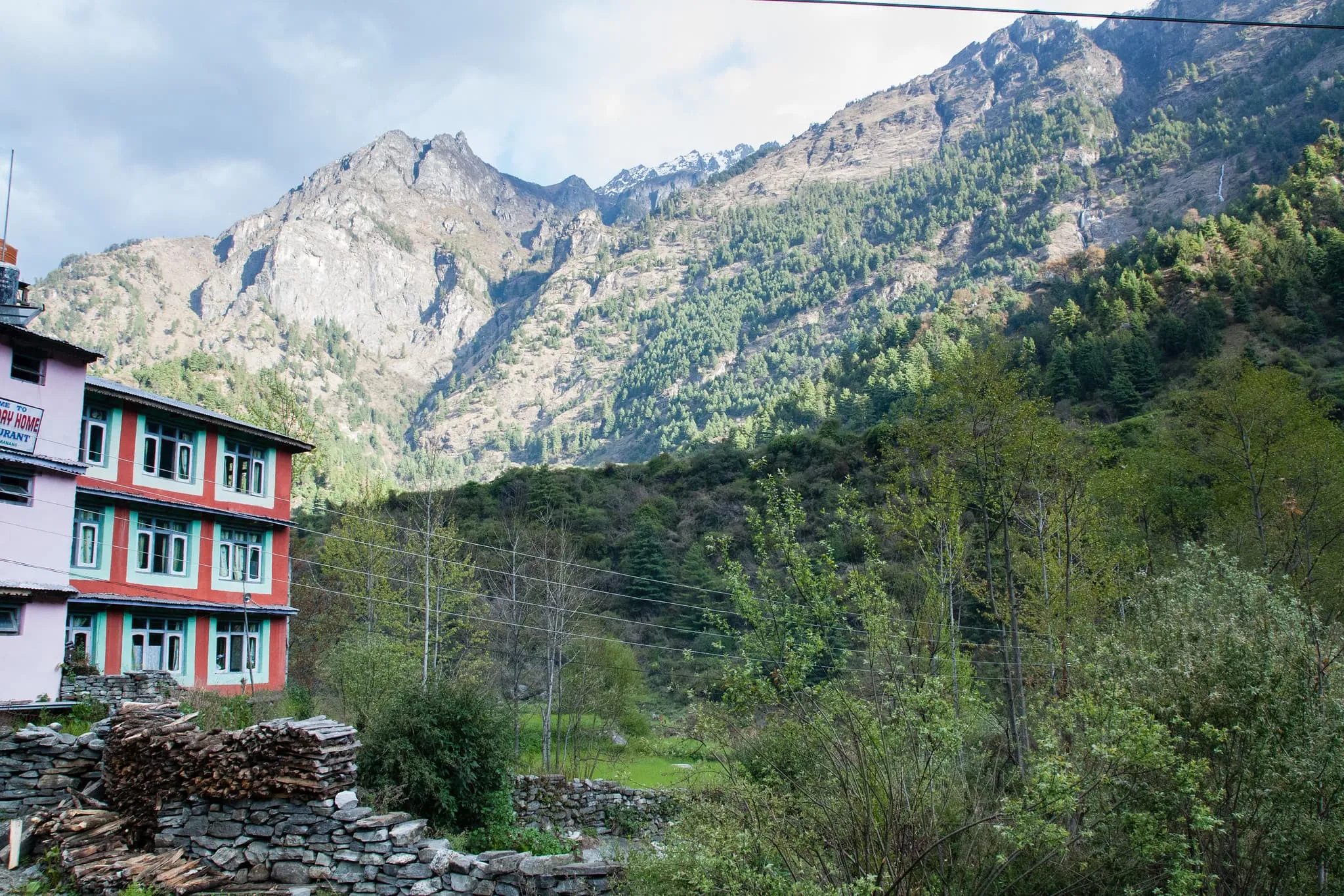
Trek to Chame
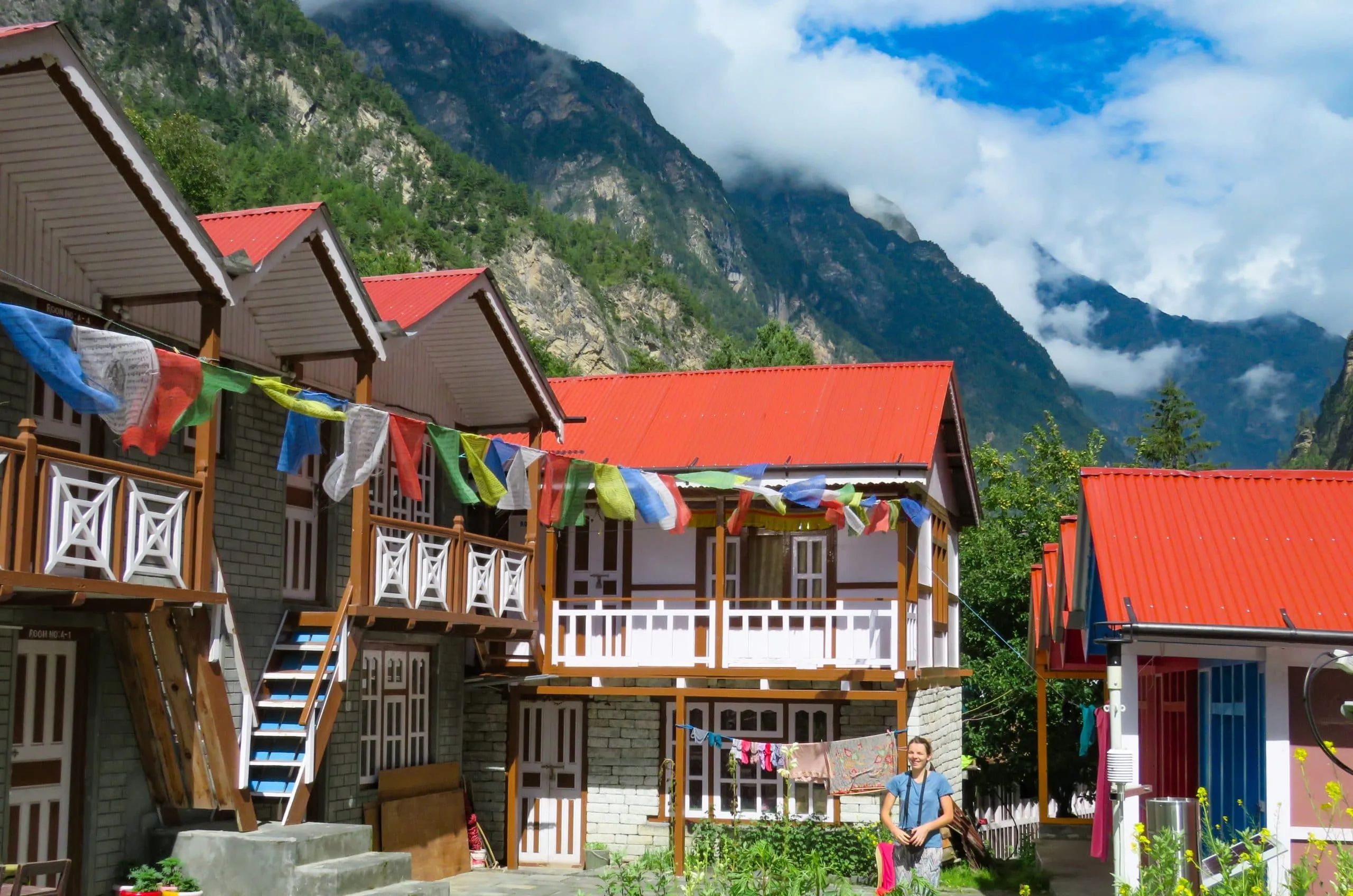
Trek to Pisang
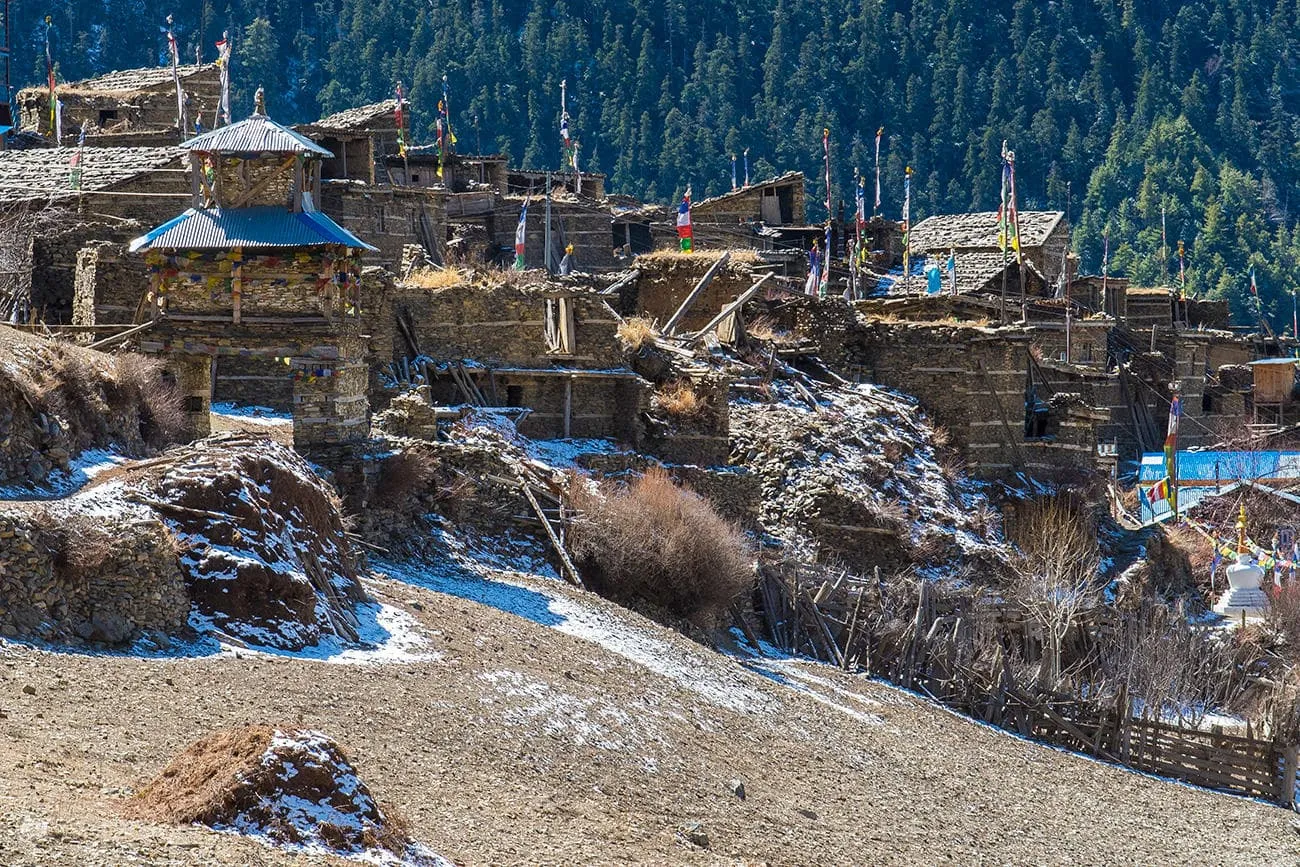
Trek to Manang
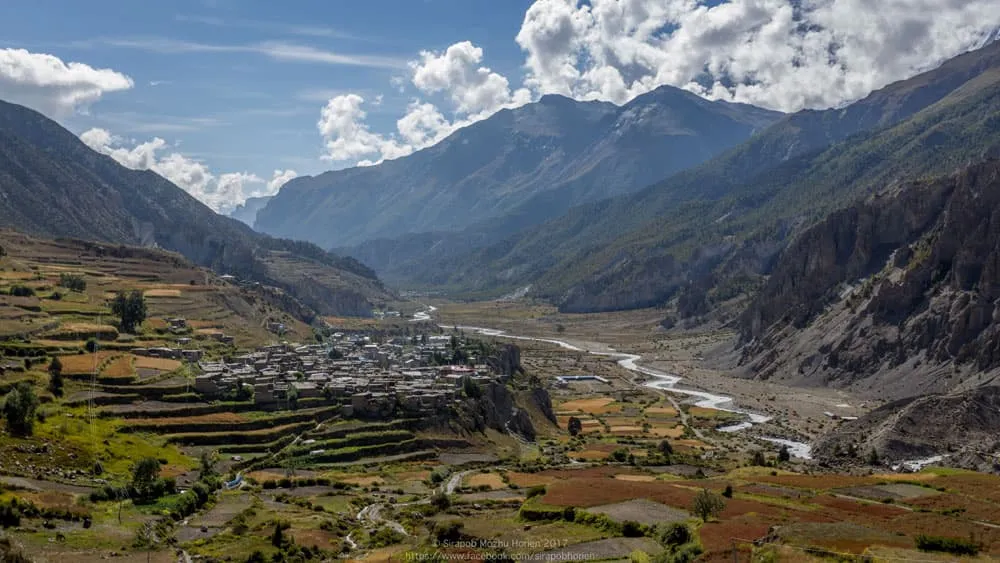
Acclimatisation in Manang
Trek to yak kharka.

Trek to Thorung Pedi
Thorung phedi.
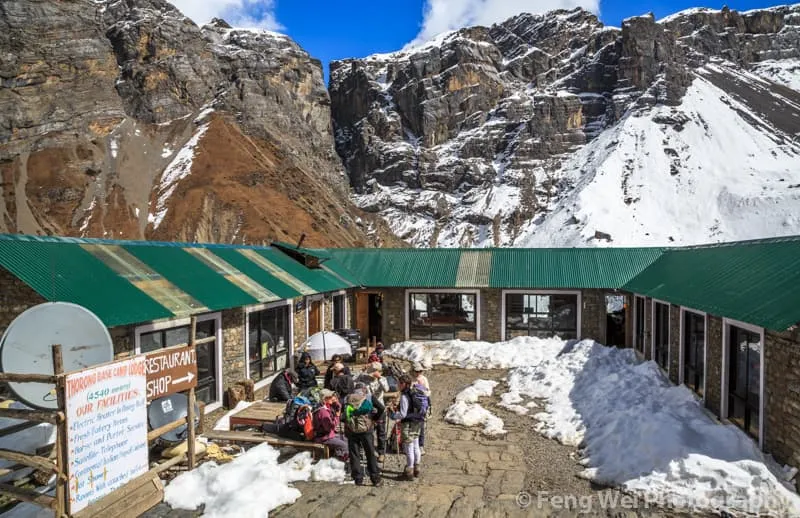
Trek to Muktinath via Thorung La Pass

Trek to Jomsom
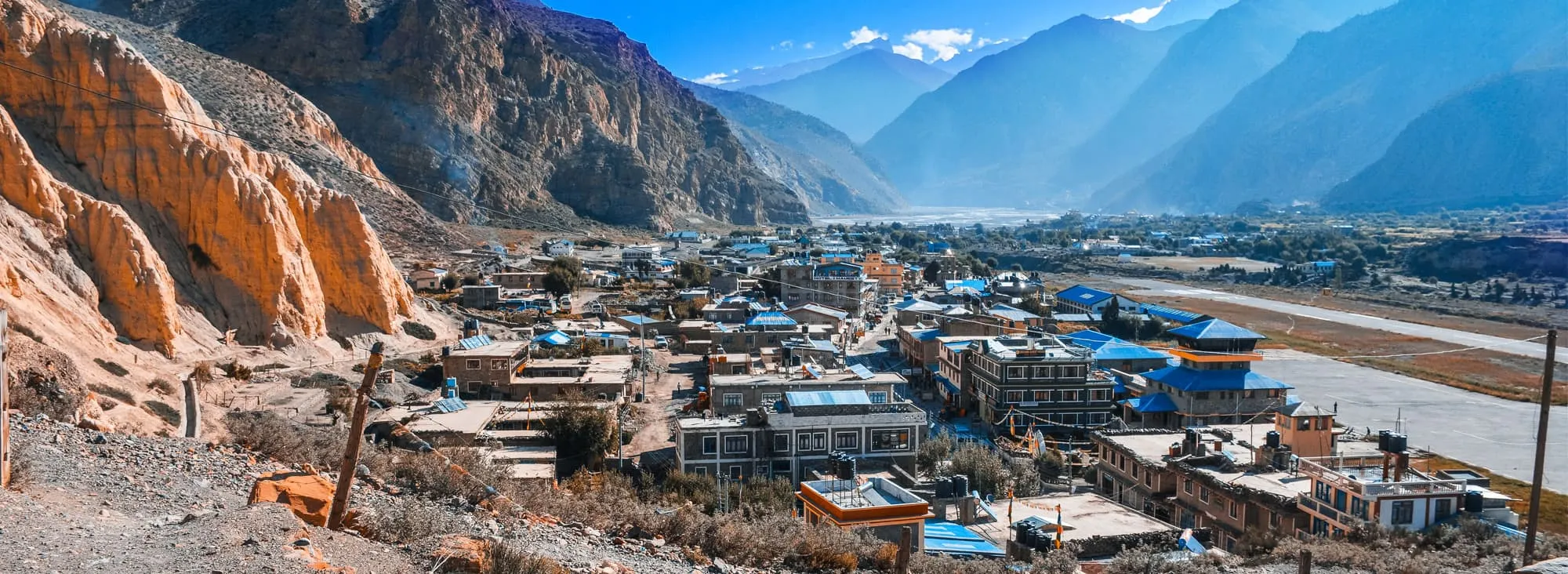
Drive to Tatopani
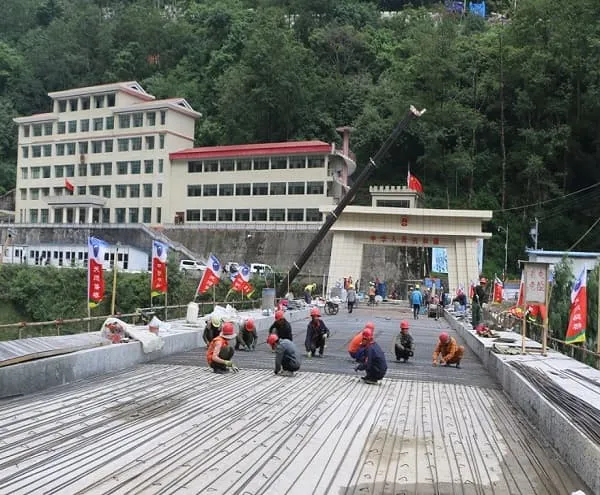
Trek to Ghorepani

Ghorepani – Poonhill – Nayapul
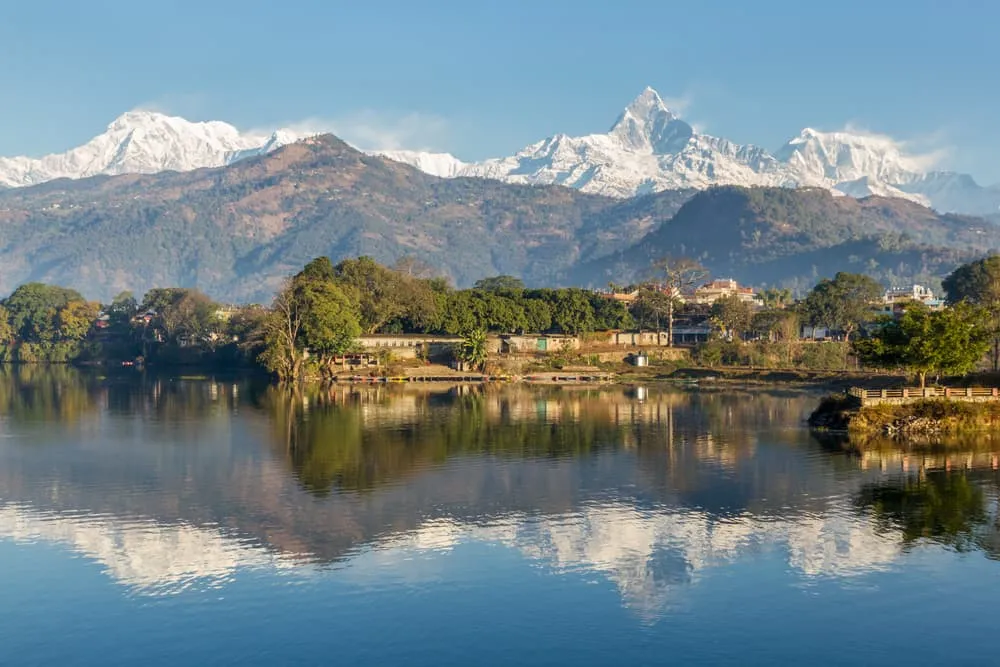
Drive from Pokhara to Kathmandu
The Thorung La is no doubt the crux of the trek. Here, the Annapurna Circuit elevation reaches its absolute max at 5416 meters above sea level. It is an old trading route and connects with Tibet. The altitude of this mountain pass is higher than any mountain in the European Alps including Mont Blanc. In height it is comparable to a big mountain like Mount Elbrus in the Russian Caucasus. Do you need to acclimatize to avoid altitude sickness ? For sure! Do you need special skills to cross the Thorung La? The answer is no. You just need to be fit!
It is a bit like scaling a mountain, but you are walking up rather than climbing. The day starts very early and you basically hit the trail before sunrise. The guides are doing the pacing to make sure you don’t head up too quickly. The path itself is not that steep, but you will feel the thin air at this altitude. From around 5000 meters we were walking on snow, with a good track carved out by the people who had gone before us. The snow really adds to the adventurous feeling of scaling a mountain pass this high. Looking back you can see all the big peaks of the Annapurnas as if you are at the same level with them. Perhaps my most magical moment on the entire trek was just before sunrise while going up the Thorung La. Alpenglow lit all the Annapurna peaks bright pink, with a steel blue sky as a background.
Reaching the Thorung La pass was an incredible, rewarding experience. As a guide I was very proud that each group member made it to the top, although it wasn’t easy. And there was still 1600 vertical meters of descent to go to the village of Muktinath. Despite that, I believe that everybody with willpower, stamina and a sense of adventure can do it.

For trekking on the Annapurna Circuit, you need the following permits:
TIMS (Trekkers Information Management System):
Annapurna Conservation Area Project (ACAP) Permit
An ACAP Permit is obligatory for individuals who wish to explore the trekking routes within the Annapurna region. It is overseen by the National Trust for Nature with the primary goal of safeguarding and preserving the region's wildlife and natural environment. The funds gathered through this permit are dedicated to conservation efforts.
For each individual embarking on a single-entry trek, the cost of an ACAP Permit is Rs. 3000 (roughly USD25), regardless of the duration of the stay. These permits can be acquired in either Kathmandu or Pokhara, and there are designated checkpoints along the trail to maintain your trekking records.
Tea houses are small hotels known as Bhatti. These are small hotels and you can expect a certain level of comfort. However comfort in this high, remote region is relative. Tea houses are comfortable to the extent that you have a roof above your head and that you can enjoy warm, home-cooked meals. They are run by local families who have opened their houses to trekkers passing by.
Trekking in Nepal has become very popular in recent years, and more and more tea houses have popped up along Nepal’s trekking routes. The more popular your route, the better the quality of your tea house is. Hence, the tea houses on the Annapurna Circuit Trek are good value for money. You can expect flush toilets, hot showers and in some cases even wireless internet. The use of these amenities is usually at an additional charge.
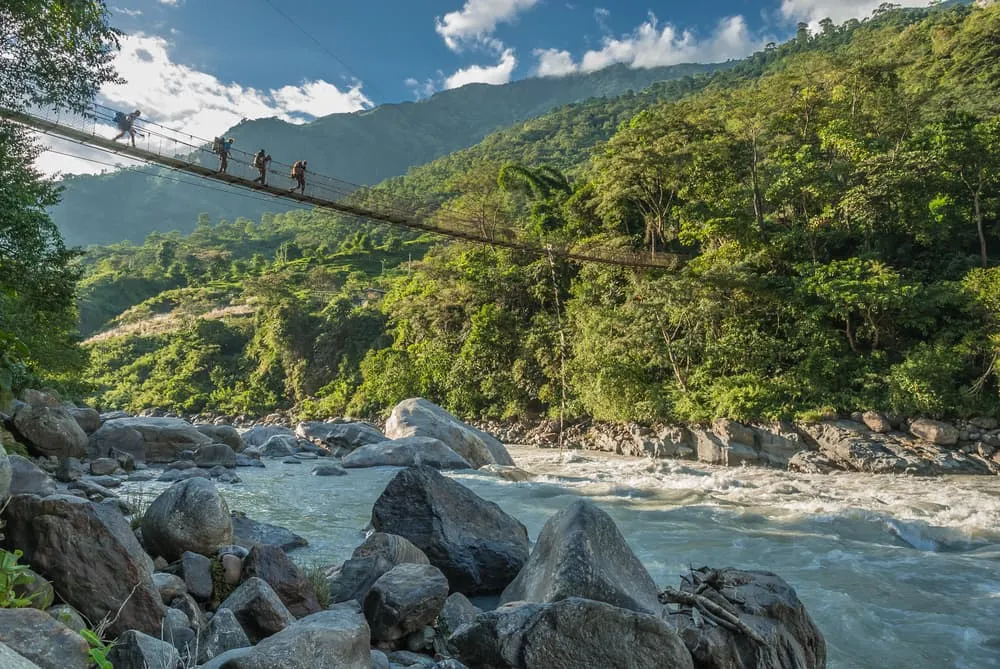
It's essential to understand that altitude sickness can affect anyone, regardless of age, fitness level, or previous high-altitude experience. These days there are several tools to monitor your health at altitude. A widely-used (analog) method is the Lake Louise score card. It ticks the altitude symptoms while keeping the severity in mind. It’s a common tool used by guides. Nowadays, most trekking and mountain guides bring a blood oxygen saturation meter, which also measures the heart rate. These are key indicators whether a person adapts to altitude well or not. AMS can occur when trekking the Annapurna Circuit Trek. Below you can find everything you need to know about altitude sickness.
Acute Mountain Sickness (AMS)
Altitude sickness, also known as Acute Mountain Sickness (AMS) is a health condition that occurs when someone is exposed to low levels of oxygen at higher altitudes. AMS is a serious condition and as the name suggests acute. It needs to be dealt with immediately, as it is potentially life-threatening. Most people will experience some mild symptoms of altitude sickness. It’s important to be aware of these symptoms and act before symptoms become more severe. Below we break down the different forms of AMS and how you can reduce the risk of getting it.
AMS symptoms
It is key to know how to identify altitude illness. You may experience the following symptoms due to the jump in altitude: headache, lack of appetite, breathing difficulties, insomnia, nausea and vomiting. The intensity and severity of these symptoms may increase with altitude and an overall feeling of fatigue will take all your joy away. This may further deteriorate to one of these life-threatening conditions.
High Altitude Pulmonary Edema (HAPE) : HAPE is a condition in which fluid accumulates in the lungs, making it difficult to breathe. Symptoms may include shortness of breath, a persistent cough, chest tightness, and an increased heart rate. It can be a life-threatening condition and requires immediate descent to lower altitudes and, in severe cases, medical treatment.
High Altitude Cerebral Edema (HACE) : HACE is a more serious condition in which fluid accumulates in the brain. Symptoms may include severe headaches, confusion, loss of coordination, and altered mental status. HACE is also a medical emergency and requires immediate descent and medical attention. Below 7 ways of minimizing the risk of AMS:
1. Gradual Ascent
One of the most effective ways to prevent AMS is to ascend gradually. When traveling to high altitudes, try to take several days to acclimatize before going higher. This allows your body to adapt to the reduced oxygen levels. All our treks in Nepal keep sufficient acclimatization into account.
2. Stay Hydrated
Dehydration can increase the risk of AMS, so drink plenty of fluids. Avoid excessive alcohol and caffeine consumption, as they can contribute to dehydration.
Consume a balanced diet with adequate carbohydrates and avoid heavy, fatty meals. Carbohydrates can help your body utilize oxygen more efficiently at high altitudes.
4. Medication
Some individuals may consider taking medication, such as acetazolamide (Diamox), to help prevent AMS. Consult with a healthcare professional before using any medication, and be aware of potential side effects.
Ensure you get enough sleep and rest during your ascent. Fatigue can increase the risk of AMS.
6. Avoid Overexertion
Pace yourself and avoid overexertion. Listen to your body, and if you experience symptoms of AMS, rest or descend to a lower altitude.
7. Descend if Symptoms Persist
If you experience symptoms of AMS, such as headache, nausea, dizziness, or difficulty breathing, it's crucial to descend to a lower altitude. Symptoms should not be ignored or dismissed.
Trekking in Nepal requires good quality and appropriate equipment. Especially the essentials like a good pair of hiking boots and breathable hardshell rain jacket. We highly recommend that you read our suggested packing list to hike the Annapurna Circuit Trek.
Technical Clothing
Accessories.
At Bookatrekking.com you can book this trek and many others. Our guided options come with experts on the ground, and offer you a convenient, stress-free, safe, and educational way to explore the outdoors. Find our offers here . Our easy-to-use platform allows you to browse and compare different trekking options and find the perfect fit for your interests, abilities, and budget.
If you have any questions about a specific trek or need help choosing the right one for you, our team of trekking experts is here to assist you. Simply reach out to us and we will be happy to provide you with personalized recommendations and advice to help you plan the trekking adventure of a lifetime.
Is this not your cup of tea and are you looking for other epic adventures? Check out one of our blog posts:
Summit climbs
- Climbing Kilimanjaro
- Climbing Triglav
- Climbing Island Peak in Nepal
- Climbing Mount Kenya
- Climbing Mount Elbrus
- Climbing Mount Kinabalu
- Climbing Toubkal
- Climbing Rinjani
- Everest Base Camp Trek
- Annapurna Circuit Trek
- Nepal Travel Guide
- Salkantay Trek
- Peru Travel Guide
Kilimanjaro
- Machame Route
- Lemosho Route
- Kili Travel Guide
Self-guided treks
- Tour du Mont Blanc
- West Highland Way
- Camino de Santiago

Also Interesting
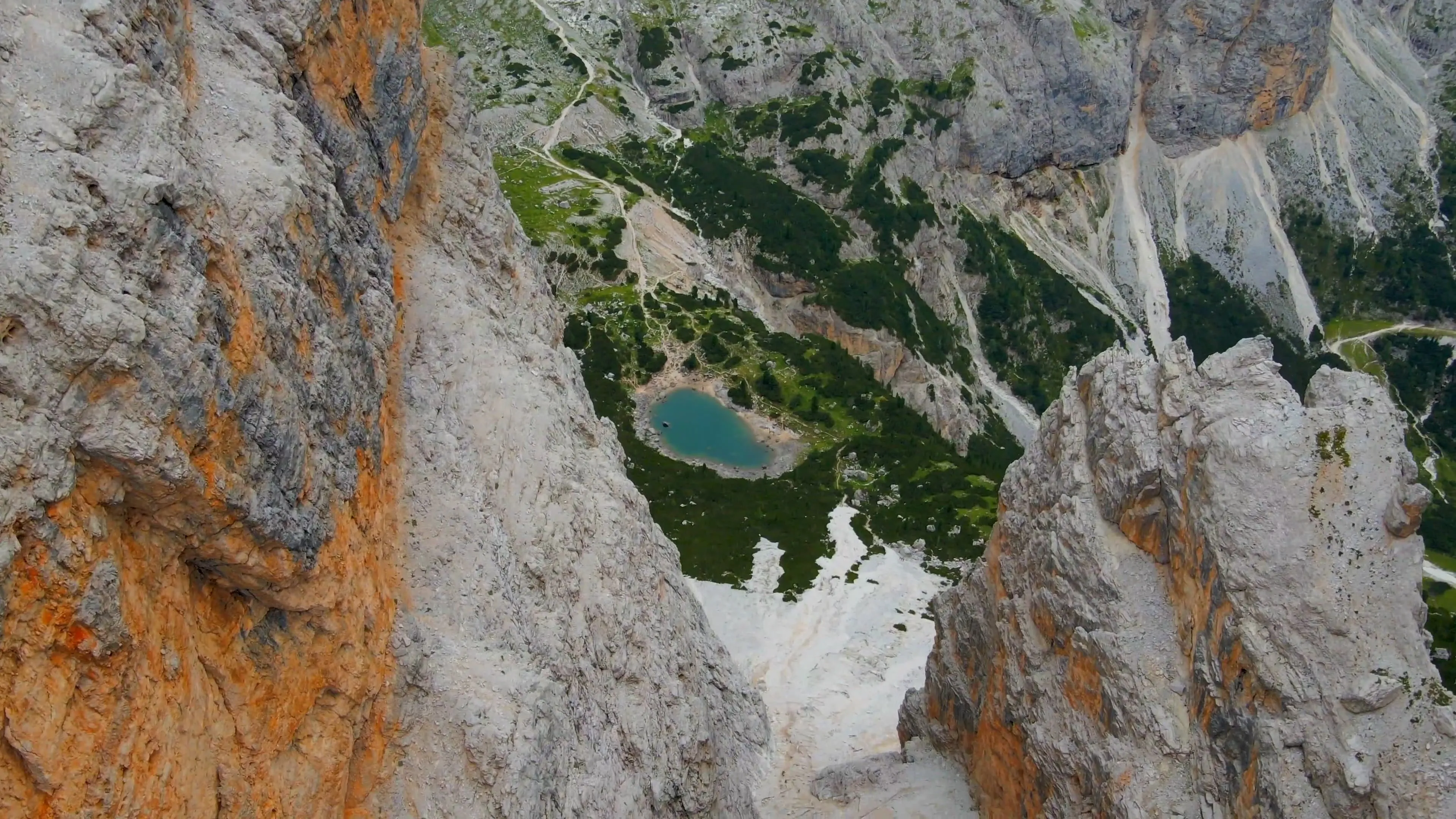
Alta Via 1: Map, Difficulty, and Route on the Italian Dolomites
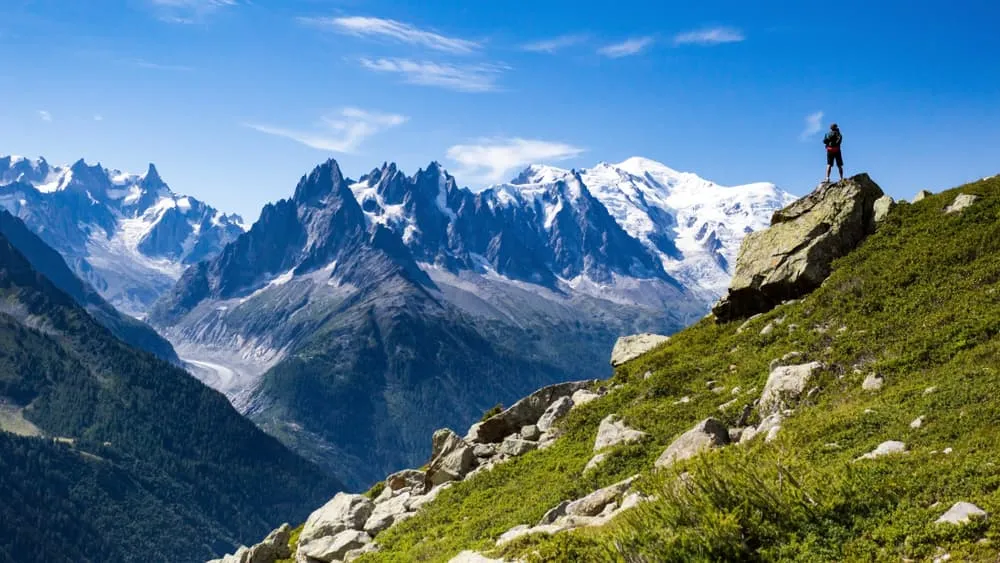
Tour du Mont Blanc: All You Need To Know
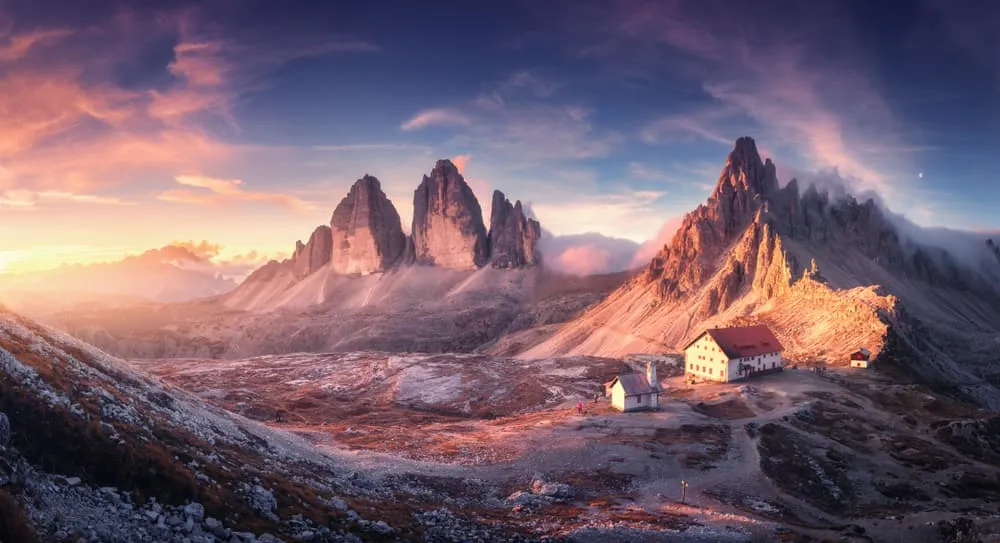
Dolomites Hiking: The 8 Best Options for Hiking Hut-to-Hut in Italy
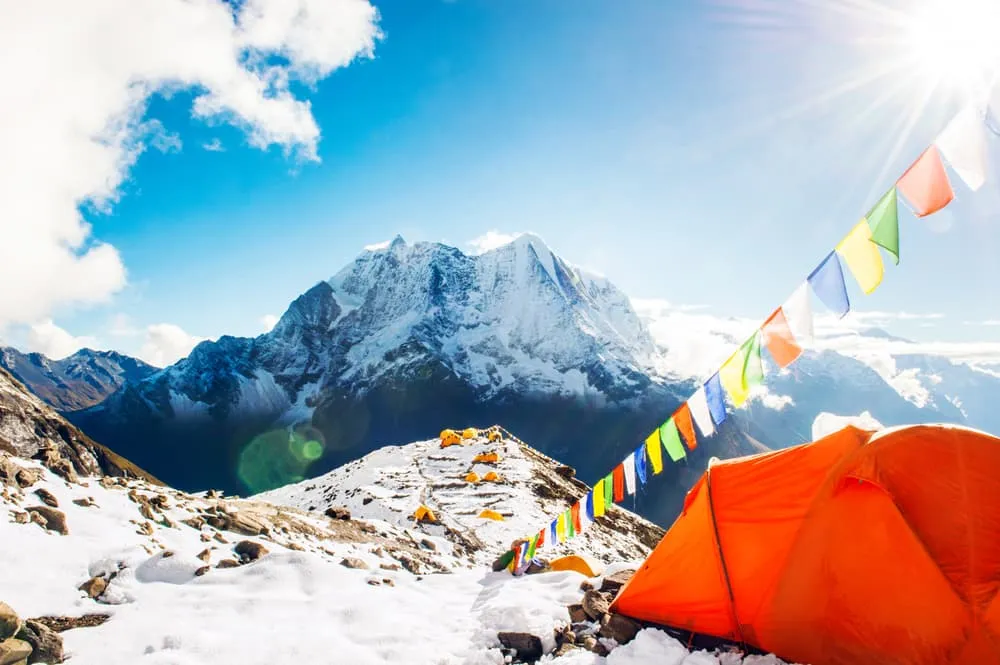
Everest Base Camp: A Trek to The Roof of The World
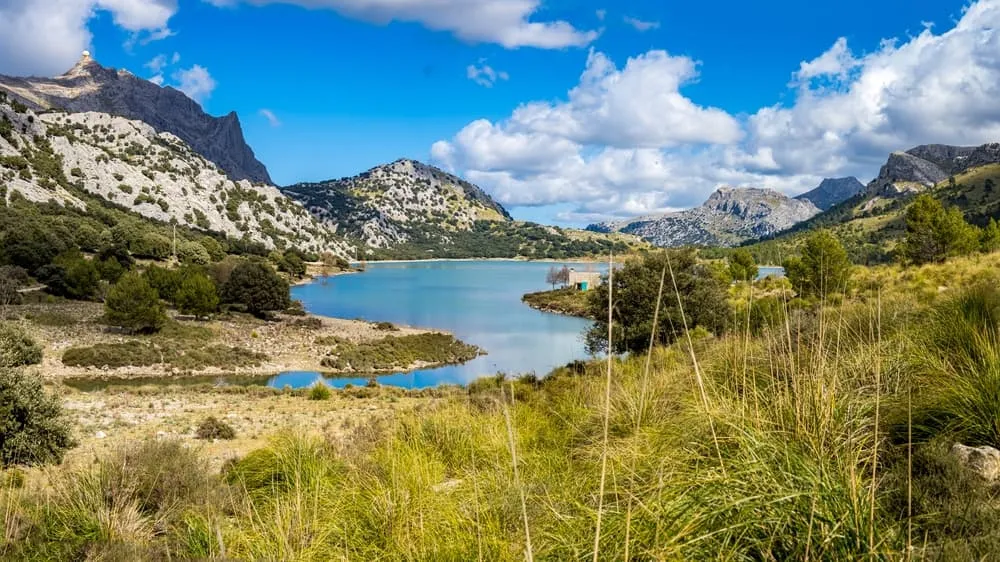
Hiking the GR221 in Mallorca: Everything You Need to Know
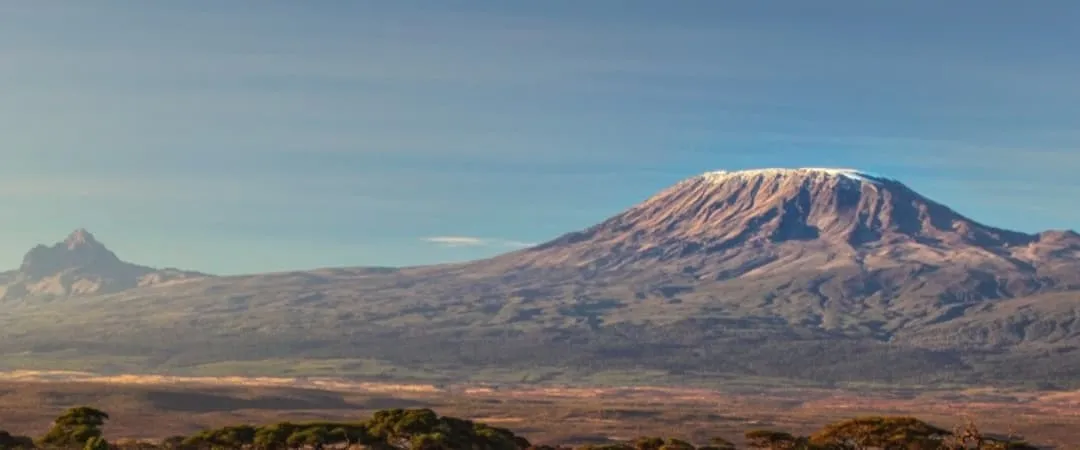
Climbing Kilimanjaro: All You Need To Know For Your Climb
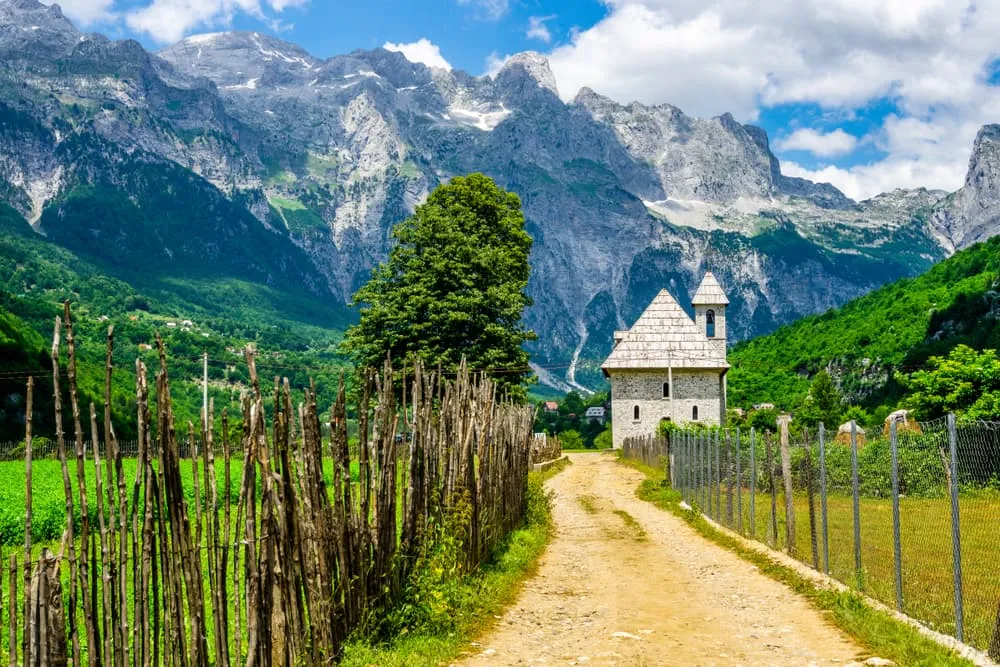
Peaks of the Balkans Trail: All You Need to Know

Hut-to-Hut Hiking in the Pyrenees: The 4 Best Walks
Get weekly inspiration with the best treks.


Annapurna Circuit Trek Itinerary: The Best Trek of Nepal
The Annapurna Circuit Trek is one of Nepal’s best treks ever. Here’s the Ultimate Trekking Guide to conquer the Annapurna Circuit including Trek costs, the best season to visit, what to pack, where to sleep and much more!!!
Namaste from Nepal my wonder friends!!! How have you been? Me? I feel very blessed to be back to one of my favorite countries in the entire world.
And hey, did you know that last year I attempted to do the most important parts of the Annapurna Circuit Trek in less than 9 days?
Well, in case you didn’t know I was extremely short of time after the Himalayan Travel Mart Conference but I wanted to see the BEST views of the Annapurna Mountain Range so I arranged a crazy itinerary of wonders for myself.
Spoiler Alert? Acute Mountain Sickness (AMS) got to me eventually and I had to turn back but trust me, the experience was extremely positive and unforgettable.
Here’s my epic Annapurna Circuit Trek Itinerary of Wonders showcasing both the short and the longer versions of the Trek.
Enjoy my wonder friends and Namaste!!!
Annapurna Circuit Trek Itinerary
Day 1: kathmandu to besisahar (760 m) and the tims & acap permits.
Like usual, all great hiking journeys begin in Kathmandu (check out my article about the Best Day Trips from Kathmandu here !!!), the chaotic yet beautiful capital of Nepal.
And of course, this trek, like most of the popular ones of Nepal, require you to jump through a few hoops of paperwork before you even set one foot on the trail.
So, drink a cup of chai tea with an extra dose of patience and take a taxi (or walk for 15 minutes if you’re in the Tamel area) to the Nepal Tourism Board offices located in Pradarshani Marg.
To do the Annapurna Circuit Trek you basically need to buy two separate permits. First is the Trekkers’ Information Management Systems (TIMS) which will set you back around 10 USD plus the Annapurna Conservation Area Project (ACAP) which will set you back 20 USD.
Yes, in theory you can get both permits via an agent or directly at the start of the trail but it is better to do it directly with the Nepal Tourism Board to avoid paying handling fees and to get it done on the very same day (depending on the number of people waiting it can take from 20 to 60 minutes).
Keep these two papers next to your passport and be ready to present them when asked by the rangers of the Annapurna area!!! Once you’re all set, take a public bus from Kathmandu to Besisahar (8 hours, 7 USD) and get some rest.
Tomorrow the adventure begins!!!

Day 2: Besisahar to Chame (2,650 m)
I hope you’re inmune to nausea my friends because today is going to be a REALLY bumpy ride through the lower mountain areas of Nepal since the jeep will ascend from 760 to 2650 meters.
Early in the morning, just walk towards the jeeps that are in the northern area of the town of Besisahar and wait for it to be filled in order to begin your journey to Chame, the most convenient starting point of the Annapurna Circuit Trek.
Prices will vary depending on the color of your skin, your haggling skills and basically how much the driver likes or dislikes you but I recommend NOT paying more than 20 USD for a one way ride.
So wait, Raphael, why didn’t you trek from Besisahar to Chame?
Well, there’s basically two reasons for that. The first one, is of course, time since you need at least 3 extra days to trek the 65KM from Besisahar to Chame which was time I didn’t have.
The second reason? The road from Besisahar to Chame is REALLY dusty since most of the time you will be trekking alongside the road that the jeeps take plus this section is not even remotely close to being as picturesque as the Chame to Manang trek.
My best advice? Even if you have the time, skip the Besisahar to Chame trek and enjoy more day treks once you’re in Manang.

Day 3: Chame to Upper Pisang (3,300 m)
NOW we’re talking!!! After two days of bureaucracy, traffic and bumpy roads it is time to get your legs moving and start hiking alongside the beautiful Annapurna Mountain Range my friends!!!
Today’s altitude gain will be close to 700 meters but unlike other hikes, this hike will be mostly on a open area (I REALLY dislike those forest claustrophobic hikes) which will make every single second more beautiful than the previous one.
There’s close to 14KM separating Chame from Upper Pisang and the recommended time is 4 to 5 hours although my best advice is for you to start at sunrise, get some well-deserved rest mid-way then continue trekking once the harsh sunlight is gone.
And well, if you downloaded any Nepalese Map (personally, I used Maps Me) or have a physical one you will notice that there’s actually TWO towns called Pisang: Lower Pisang and Upper Pisang.
Despite its name, Upper Pisang is ONLY 100 meters higher than Lower Pisang BUT the extra effort on getting there is well rewarded since the views are not only better but it will help you acclimatize faster than if you chose to stay the night at Lower Pisang.
And yes, you can also enjoy sunsets of wonders such as this one as the sun rests behind the Annapurna Mountain Range and blesses our journey. Pretty rad, uh?

Day 4: Upper Pisang to Ghyaru (3,730 m) to Manang (3,519 m)
On the Annapurna Circuit Trek, you have two options to go from Upper Pisang to Manang: the lower shorter path or the high altitude longer path. Today’s altitude gain is not as bad so I really recommend you to try the longer path.
Other than an easier acclimatization process, the main advantage of the high altitude path is getting to know the many Buddhist Villages (did you know that Nepal is 80% Hindu and only 10% Buddhist? Check out more Fun Facts of Nepal here !!!) on the way of which Gyharu stands out as the most emblematic one.
PS. Is it just me or does the architecture of these Buddhist Tibetean towns reminds you a little bit of Macchu Pichu?
The high altitude longer path from Upper Pisang to Manang via Ghyaru will take you 19.5 KM to complete which translates to about 7 hours although, as I said before, I recommend you that you take it easy in order to fully enjoy the views of the Annapurna Mountain Range.
Trekking isn’t a race and the beauty of the Annapurna Circuit Trek is that there’s no such thing as guest house reservations (more on that later) so you can just spend the night whenever you want if you feel tired.
And yes, I recommend you to always look behind you every 10 to 20 minutes: sometimes THE best views can only be appreciated if you turn back your head!!!

Day 5 Manang to the Ice Lakes (4,650 m) and Back
Manang was my last stop in the Annapurna Circuit Trek because even though I wanted to visit Tilcho Lake and conquer the Thorung-La Pass I was short on time and I didn’t acclimatize properly in my rush to see the best Annapurna viewpoints with my limited time.
Was I sad to not be able to complete the Annapurna Circuit? Not at all! During each day of the journey I had this mantra playing on a loop inside of my head:
“Raphael, be the best version of yourself you can be. This isn’t a challenge of you against others, it’s a challenge of the old you versus the new you” .
And yes, on my way to the 4650 meters above sea level Ice Lake near Manang (which is a very good option to get acclimatized if this is your first encounter with high altitude treks and can be done as a day trip from Manang), I fainted.
Truth be told, if it wasn’t for this friendly dog (whom I nicknamed Vishnu in honor of the Hindu God of Preservation) that came to lick my face I don’t know how long I would have spent there on a day where no other trekker attempted this off the beaten path day trip (that’s what I get for traveling in low season with no guide or trekking partners I guess).
In the end, just 2 kilometers away from the Ice Lake, my head began to hurt…A LOT. Breathing got harder and harder. It was time to make a choice: turn back or go ahead and take my chances….
I’m not ashamed to say that I chose to turn back.
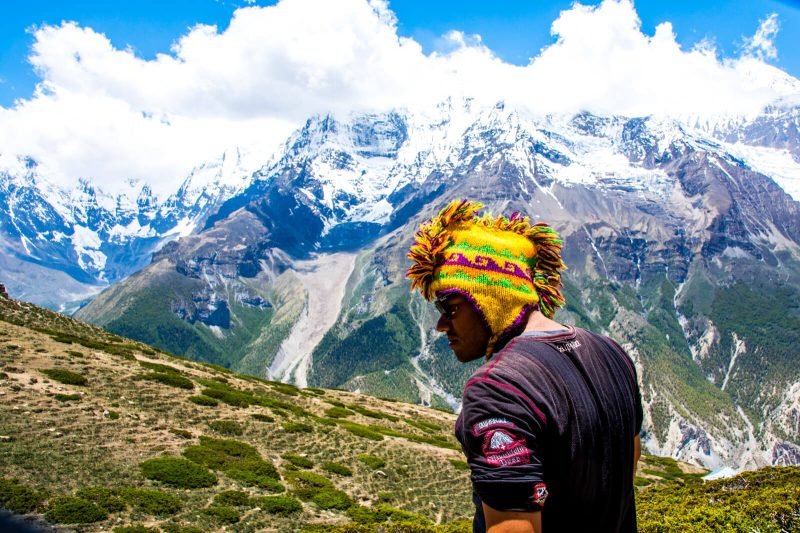
Day 6: Manang to Besisahar (760 m)
My original plan to rush trough the Annapurna Circuit Trek in order to finish in Kagbeni and take a jeep back to Pokhara via Jomsom (complete itinerary included below) had failed and without the privilege of having extra acclimatization days in Manang, I had no choice other than to turn back the very same way I came from.
Luckily, it IS possible to book a jeep from Manang to Besisahar (in theory you can do the opposite by jeep but where’s the fun in that?) for 50 USD, you just need to go to the parking lot at the exit of Manang the day before in order to reserve your seat.
If you’re traveling in low season, you MIGHT have to wait a few days (or pay the driver for a private transfer) and if you’re in a bad weather season the road might be REALLY dangerous for any sane driver to challenge.
And trust me, if you thought the road from Besisahar to Chame was bad enough, the road from Manang to Chame (and then Chame to Besisahar) isn’t really better despite being mostly a straight line so if you have a good responsible driver, be ready to spend close to 10 hours inside a very slowly moving jeep.
After all, safety should always come first so even though I heard it IS possible to be able to catch the last bus from Besisahar to Kathmandu on the very same day you descend from Manang, it is wise to make the assumption that you will have to spend a night in Besisahar and depart to Kathmandu the next morning.
The road from Besisahar to Kathmandu is more curvy than a Mexican Lady so you don’t really wanna drive there by nighttime anyways!

Day 7: Besisahar to Kathmandu (1,400 m)
Finally, it was time for my journey to end and on the long bus ride back to Kathmandu I had time to actually reflect on what happened on that fateful trek from Manang to the Ice Lakes.
You see my friends, there are more important things that pride, hubris and blind ambition…sometimes giving up is the best way to move forwards in order to reach higher goals.
A defeat is nothing more than a motivation in order to win the next time: the mountains might have won this battle but the war is still ongoing.
I have now become the best version of myself that I can be in this specific moment in time and even though this journey ended in a bittersweet note, it has also motivated me to find the endurance to always keep trying and trying even though the first dozen attempts end in a pyrrhic victory.
This 2018 I set myself to goal to embark on as many multi-day treks as possible and even though my Everest Base Camp Trek in Nepal got cancelled due to bad weather, I already made myself the promise to come back this October in order to conquer more mountains of wonders.
Endurance is what will bring you closer to your goals my wonder friends and remember: always aim to be the best version of yourself that you can be.
And I’m proud to say that right now I am.

How to Continue the Annapurna Circuit Trek from Manang Onwards
If you have additional days and you feel comfortable with altitude gains, you can continue from Manang to Tilicho Lake (4,918 m), camp there one night then return to Manang (1 night, 2 days) from which you can continue the Annapurna Circuit to reach the Western Side of it finishing in Pokhara:
- Annapurna Circuit Itinerary Day #6: Manang to Tilicho Lake (4,918 m).
- Annapurna Circuit Itinerary Day #7: Tilicho Lake to Manang (3,519 m).
- Annapurna Circuit Itinerary Day #8: Manang to Yak Kharka (4,035 m).
- Annapurna Circuit Itinerary Day #9: Yak Kharka to Thorong Phedi (4,540 m).
- Annapurna Circuit Itinerary Day #10: Thorong Phedi to Muktinath (3,710 m) via Thorong-La (5,416 m).
- Annapurna Circuit Itinerary Day #11: Muktinahth to Kagbeni (2,804 m).
- Annapurna Circuit Itinerary Day #12: Kagbeni to Pokhara (1400 m) via Jomsom (2,743 m).
However, be warned that THE best views of the Annapurna Mountains Range lie on the Eastern Side of the Annapurna Circuit (Chame to Manang) so adjust your expectations accordingly.

When is the Best Time to Do the Annapurna Circuit Trek
Because of Monsoon season (normally June to August but it can either start earlier or finish later), Summer is definitely NOT the ideal time to attempt the Annapurna Circuit Trek leaving Spring and Fall as the two most popular seasons.
Winter, as it is usual, will be very beautiful because of the snow however some trails might end up being closed so plan accordingly. When I did the Annapurna Circuit Trek it was the end of May/beginning of June and I encountered 0 rain with an amazing visibility during the entire trek.
This year, however, Monsoon started earlier so late Spring is always a risk. My best advice? Do it in the Autumn. You can thank me later!
And yes, I would say that no matter which season you end up choosing, waking up to this view of the Annapurna Mountain Range from my guest house in Manang was one of THE best moments ever.
When exploring a city I can understand waking up at a normal time since everything opens relatively late…but if you don’t wake for sunrise when you’re in the wilderness then you’re doing it wrong.
See you in the Autumn my Himalayas of Wonders!!!

What to Pack for the Annapurna Circuit Trek
No matter how sunny and hot it is during the day, you NEED a windproof jacket (you can buy a North Fake for 15 USD in Kathmandu) in order to be comfortable at night and also to fight off those rare but powerful mountain winds.
Since this was my FIRST multi-day trek I made the mistake of buying SUPER HEAVY trousers thinking that it was going to be always cold. In hindsight, I should have gotten some light rainproof trousers plus thermal leggings, feel free to check out my Torres del Paine W Trek Guide to see how I learned from my mistakes.
When it comes to items to pack, all I took with me for my week on the Annapurna Circuit Trek was a small 25 liter day pack, two walking poles and a tripod (to take photos of myself duh).
What’s inside the bag you ask me? 4 shirts, 6 pairs of underwear and socks, deodorant, toothpaste, toothbrush, my camera and my laptop (workaholic, I know).
No need to pack food since you HAVE to buy it at the tea houses (more on that later) but feel free to bring some chocolate bars or fruits from Kathmandu.
Unless you’re carrying a sleeping bag or a tent (but then again, WHY would you?) there’s absolutely no need for big backpacks that will only slow you down my wonder friends.
During my Annapurna Circuit Trek I even encountered a traveler that had hired a porter to carry her HUGE backpack. What was inside you ask? Clothes, clothes and more clothes!!!
My best suggestion? Leave most of your heavy stuff at Kathmandu (most hotels and hostels can do it for a small fee or even free) and do laundry at Manang (the middle of the Annapurna Circuit Trek) instead of carrying a week’s worth of clothes.

The Free Trehouses of the Annapurna Circuit Trek
Wait, what? Accommodation is free on the Annapurna Circuit Trek? Well, yes and no.
You see, ALL tea houses have an in-house restaurant and the deal is that as long as you buy dinner OR breakfast off them, you get to sleep in their guest house’s dormitory (sometimes even a private room!!!) for FREE.
Each meal will set you back around 5 USD but the portion is going to be so HUGE that you might feel temped to skip lunch altogether and just wait until dinner.
In total, you can do the ENTIRE Annapurna Circuit Trek spending as little as 10 USD per day (plus transportation from Kathmandu to Besisahar to Chame and Kagbeni to Jomsom to Pokhara and 30 USD of the 2 Permits) making it one of the cheapest treks in the world.
The entire Annapurna Circuit Trek is super easy and well marked so you don’t need neither a guide nor a porter so in total you can do the Annapurna Circuit for LESS than 200 USD.
Crazy how some companies can charge up to 1000 USD uh?
Last but not least, don’t forget to use our Booking.com Affiliate Link of Wonders for making hotel reservations in Nepal and all over the world (except in the teahouses of course!!!).
Same price for you and a small pocket money commission for this website of yours.
Sweet deal, uh?
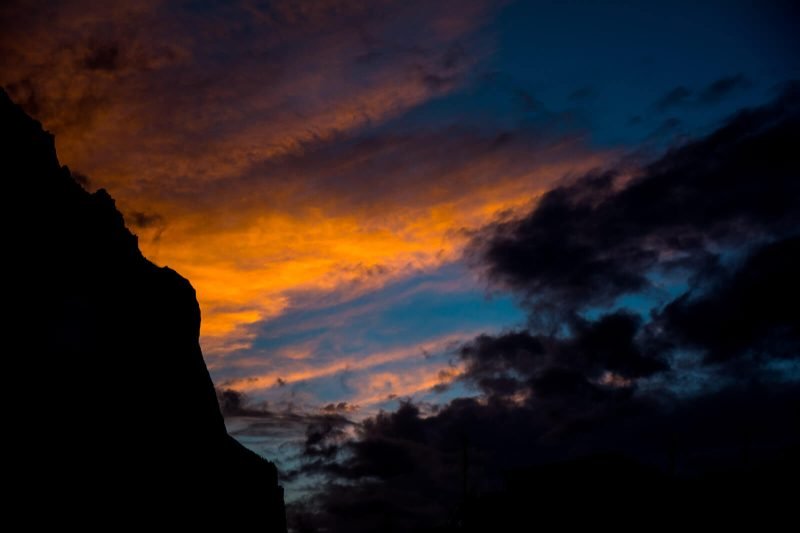
I hope you have enjoyed this article about the Annapurna Circuit Trek. Don’t forget to subscribe in order to get more awesome updates and tips straight to your e-mail!
Have you ever done the Annapurna Circuit Trek? Would you like to? What are some of your best favorite hikes? Share your thoughts and let me know what you think!
Until next time, my friends!
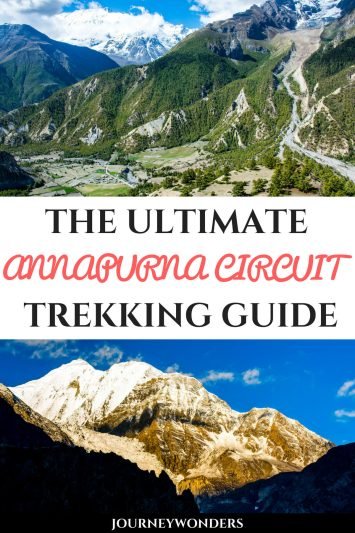

Annapurna Circuit

ACTIVITY LEVEL
Kathmandu, nepal.

Learn more about our Annapurna Circuit trip:
Embark on the annapurna circuit in nepal, j oin the explorer’s passage for one of the most extraordinary treks on the planet: the annapurna circuit. stay at local tea houses as you follow this ancient himalayan trade route, climbing through jungle-like terrain and rice fields, past canyons and waterfalls, and trekking among snowy peaks at thorung la pass (17,768 feet / 5,415 meters in elevation). from the bustling streets of kathmandu to the serene mountain villages of the gurung people, this adventure offers diversity in culture and landscape, and the opportunity to meet other adventurers from across the globe. the annapurna circuit is truly a must for any serious trekker., read below to review trip details and highlights, a sample itinerary, trip customization options, accommodations, photos, and more, trek the annapurna circuit with t.e.p., we take care of everything.
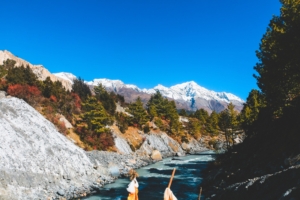
W e go above and beyond our competitors in handling every detail of your Annapurna Circuit trek, so that you can focus exclusively on experiencing all that Nepal and the Himalayas have to offer. Our trips are all-inclusive, crafted with the intent of providing you with an unforgettable adventure travel experience. All you have to do is show up at the airport in Kathmandu!
Expert guides.
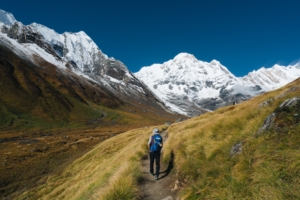
E xperience the Annapurna Circuit with the finest trekking guides in Nepal. Our knowledgeable guides have been leading adventures in the Himalayas for over thirty years, and are some of the pioneers of trekking in the Annapurna region. Many of our guides are also local to the Khumbu region of Nepal, which is home to the Sherpa community.
Responsible travel and sustainability.
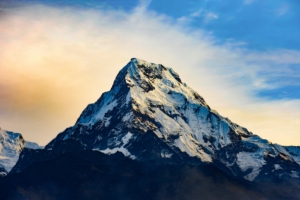
T he Explorer’s Passage is a member of Sustainable Travel International, a partner/supporter of the Leave No Trace Center for Outdoor Ethics, as well as a supporter of the Center for Responsible Travel (CREST). We very proudly incorporate the principles of these organizations throughout your trip to Nepal.
Trip highlights.
- Explore the busy streets of Kathmandu, including a guided tour of UNESCO World Heritage Sites, the Pashupatinath and Boudhanath stupas.
- Follow an ancient trade route on one of the oldest treks in the Himalayas.
- Trek over the challenging Thorong La pass (17,768 feet / 5,415 meters), the highest point on the Circuit, and be rewarded with views of stunning, snow-capped peaks.
- Rest your feet at mountain tea houses in villages along the trail, where you can share hearty, memorable meals with fellow adventurers and local Sherpas.
- Travel over diverse terrain, including lush lowland forests of rhododendron trees, open meadows and pastures, rice fields, waterfalls, rivers, glacial lakes, rocky and rugged paths, and humbling mountain landscapes.
- Visit the sacred temples of Muktinath, a holy place for Hindus and Buddhists.
- Meet other explorers from around the world on this incredible journey of a lifetime.
From $4,295 USD per person
*More info. on pricing
Pricing starts at $4,295 USD per person
Single Supplement for Hotel: from $795 USD
More questions? Read more about pricing here
START DATES
Custom Dates Available
*To inquire on a custom date, please contact us !
2023 Group Trip Dates below:
- September 15, 2023
- October 2, 2023
- October 7, 2023
- November 3, 2023
2024 Group Trip Dates below:
- March 15, 2024
- April 12, 2024
- May 3, 2024
To inquire on a custom date, please contact us!
18 Day Itinerary
Trekking duration is 9 days. For more information about itinerary options, please review the section about trip customization on this webpage.
ACCOMMODATIONS
Various Options*
In Kathmandu, Besisahar, and Pokhara, choose between 3-Star or 5-Star hotels. While hiking the Annapurna Circuit, everyone stays in tea houses, which are comparable to many other mountain lodges/huts in other parts of the world.
*Read about accommodations in Nepal
MAX. GROUP SIZE
( Private groups: 20 people)
Advanced* Activities: multi-day hiking on the Annapurna Circuit.
Elevation: Start: 2,493 feet / 760 meters; End: 17,768 feet / 5,415 meters
Daily trekking distance: ~4 to 12.4 miles / ~ 6.4 to 20 kilometers per day
Total trekking distance: ~79 miles / 127 kilometers
*Please refer to our Trip Activity Level Guide for more information
Please Note – the Trip Activity Level Guide is for guidance only and provides a general sense of what you should expect on our trips. Actual times, distances, and elevation can be outside the ranges outlined below.
Trips designated “easy” are perfect for first-timers, or travelers looking for a mild physical challenge. hikes, treks, and horseback rides are short and terrain is typically flat, at an elevation not exceeding 5,000 feet. on paddling trips, river currents move swiftly, thus minimal paddling is required..

“Moderate” trips are more active and require a bit more endurance. Hikes, treks, and horseback rides includes occasional steep ascents. Elevation can occassionaly reach up to 15,000 feet. River currents are moderate and some stretches include Class 1-2 rapids.

Trips marked “Advanced” require strong physical stamina, as we’re often active for 8+ hours per day. Hikes, treks, and horseback rides include traversing more rugged and mountainous terrain, at elevations that can reach up to 15,000 feet. Rivers currents are moderate to swift and often include paddling white water through Class 1-3 rapids.

TEP’s most physically demanding trips fall into the “Explorer” category. Expect 8+ hours of activity per day. These trips are demanding, yet attainable for those seeking the challenge. Hike, trek, and horseback ride on rugged and mountainous terrain with frequent steep ascents. Elevation may exceed 15,000 feet. Rivers currents are moderate to swift and often include navigating white water through Class 1-3 rapids.

More Questions? Speak to one of our Adventure Consultants at 855-208-6800 to determine if this is the right trip for you OR Read more about the Trip Activity Level Guide

SAMPLE TRIP ITINERARY
18 day / 17 night trip daily overview, day 1: arrival in kathmandu, nepal.
Namaste , and welcome to Nepal! Upon arrival in Kathmandu, transfer to your hotel. In the evening, enjoy a welcome dinner where you will meet your guide and perhaps a few fellow travelers.
Day 2: Drive to Besisahar
Start your first full day in Nepal with a long, winding drive. As you leave Kathmandu, the route curves through the hills, following rivers and climbing higher and higher through rural Nepal until you reach Besisahar, the gateway to the Annapurna Circuit.
Day 3: Drive to Manang
Buckle up – today you will board a 4-wheel drive vehicle and travel the bumpy road to Manang on a nine hour tour through mountain villages, taking in stunning views of waterfalls and jagged, snowy peaks. Stop at the large village of Chame to explore the shops and teahouses before continuing up to the plateau, where you will stay at your first guest house.
Day 4: Day in Manang; Optional Hike to Gangapurna Glacier Lake
Spend today in Manag getting accustomed to the high elevation. Wander the streets of historic Manang or opt for a practice hike to view Gangapurna Glacier Lake or the surrounding monasteries.
Day 5: Acclimatization Hike to Ice Lake
After breakfast, begin your acclimatization hike to the Ice Lake (Kicho Tal). Due to its high elevation in the Manang valley, it is often frozen, hence its name.
Day-hike distance: approximately 9 miles/14.4 kilometers (7-10 hours).
Day 6: Start the Annapurna Circuit; Trek to Tilicho Base Camp
Today you officially embark on the Annapurna Circuit. Begin by walking through Manang’s western gates, then down to the river, through coniferous forests, past villages and a monastery, until Tilicho Peak comes into view.
Daily trekking distance: approximately 12.4 miles/20 kilometers (7-8 hours).
Day 7: Trek to Tilicho Lake
Tackle the initially steep climb to Tilicho Lake in the early morning, accompanied by yaks and deer that graze along the path. Your destination is Tilicho Lake, where it is said the events of the Hindu sacred text the Ramayana were originally told. After spending time at the lake you will return to Tilicho Base Camp.
Daily trekking distance: approximately 6 miles/9.7 kilometers ( 5-6 hours).
Day 8: Trek to Leder
Today your trek will take you past the villages of Sri Kharka Village and Tenki, through pastures and juniper forests, and to Gunsan, a village of flat, mud roofed houses, until you at last reach the open meadow of Leder.
Day-hike distance: approximately 11.5 miles/18.5 kilometers (5-6 hours).
Day 9: Trek to Thorong Phedi
Your goal today is Thorong Phedi, the village at the foot of Thorong La pass. The terrain on this part of the trek is rugged and otherworldly – much different from the lush forests at the start of the trek. Here you’ll find the best views of Mt Gundang, Mt Syagang, Thorong Peak, and Mt Khatungkan.
Daily trekking distance: approximately 4 miles/6.4 kilometers ( 3-4 hours).
Day 10: Trek through Thorong La Pass to Muktinath
Today you’ll face the most challenging day of the trek as you hike Thorong La Pass, one of the highest passes in the world. Your reward? Breathtaking views of the Himalayas in the morning light. Afterward, descend to Muktinath to visit the temples there.
Daily trekking distance: approximately 10 miles/16.4 kilometers ( 5-6 hours).
Day 11: Muktinath Temple and Tatopani
Start the day at Muktinath temple, a holy temple for Buddhists and Hindus, followed by a four hour drive to Tatopani, where you can rest your feet in the lodge and soak in the waters of the natural hot springs.
Day 12: Trek to Ghorepani
After yesterday’s rest, it’s time to lace up your boots again and continue the circuit. As you ascend to Ghar Khola valley you’ll pass through terraced farmland, the ethnic Thakali villages of Sikha and Chitre Ghorepani, and lush forests of birch and magnolia trees. If you’re lucky, the magnificent rhododendrons will be in bloom. Spend the night in the village of Ghorepani, located at the top of the ridge.
Daily trekking distance: approximately 10 miles/16 kilometers ( 5-6 hours).
Day 13: Trek to Poon Hill and Tadapani
Before dawn, climb the steep trail to Poon Hill to catch the sunrise over the Himalayas and see for yourself why this viewpoint is the most popular destination of the Annapurna region. Return to Ghorepani for breakfast, then head east, climbing a ridge then descending through rhododendron forests and passing waterfalls. Spend the night at Tadapani.
Daily trekking distance: approximately 6.9 miles/11.2 kilometers ( 5-6 hours).
Day 14: Trek to Ghandruk
This is your last day trekking the Annapurna Circuit. Today the trail descends through a dark and dense rhododendron forest; by afternoon, you’ll be greeted by cherry blossoms on the opposite slopes of the ravine. In the stone-house village of Ghandruk you’ll enjoy close-up views of the impressive Fishtail, Annapurna South, and Hiunchuli mountains.
Daily trekking distance: approximately 6 miles/9.7 kilometers (6-7 hours).
Day 15: Drive to Pokhara
It’s a four hour drive today from Ghandruk to the lakeside village of Pokhara, where you can enjoy a hard-earned rest and reflect on your remarkable journey.
Day 16: Return to Kathmandu
Day 16: return to kathmandu, nepal.
Say goodbye to the beautiful lake city of Pokhara and start the eight hour drive to Kathmandu. Upon arrival in Kathmandu the rest of your day is free.
For dinner you could seek out an authentic thali . With variations common to much of South Asia, it is a warm curry dish of rice, lentils, meat, and vegetables. You’ve certainly earned a hearty meal after so many days of trekking!
Day 17: Explore Kathmandu, then Farewell Dinner
Day 17: explore kathmandu.
Today is our final full day together. In the morning you’ll take a guided tour of Pashupatinath and Boudhanath stupa. Afterward you might consider seeing some live music in Lazimpat, or visiting the Newa Chen house in northern Lalitpur to experience a 350 year-old Newari home, restored to its original beauty. We can also provide additional recommendations for destinations and activities.
Day 18: Final Day in Nepal
Congratulations on an awe-inspiring journey! It’s time to say farewell to Nepal and its amazing people, mountains, and nature. On your way home you will have plenty of time to plan your next adventure in this wonderful country. Until next time!
Please contact us for a complete detailed itinerary.
Are you interested in another activity or destination in Nepal that isn’t listed above? Planning to spend extra time in the region, or interested in specific travel dates? No problem. As experts in tailored trip planning, we can weave your interests and your timeframe into our customizable itineraries so that every detail of your extraordinary trip unfolds just the way you want it to.
Contact us today to get started customizing your dream trip to Nepal!
Ready to book call us, learn more below, traveler testimonials, read what people are saying about their once-in-a-lifetime travel experiences with the explorer’s passage:, allison (england):, “i had such a great time in nepal with tep. it was the best thing i have ever done”, adam (u.s.a.):, “everything went beyond smooth. it felt like there was a guardian angel over our shoulder the whole time. trip of a lifetime”.

↑ Click the logo to visit our TripAdvisor reviews page, and see why travelers trust our team with organizing their global adventures!
Accommodations in nepal, before and after your annapurna circuit trek you can enjoy a comfortable stay at hotel marshyangdi. alternatively, a 5 star hotel option can be reserved instead – contact us for more details. during the trekking portion of the trip you will stay overnight at tea houses along the route. learn more about these trip accommodations below:, hotel marshyangdi in kathmandu, hotel marshyangdi | kathmandu, nepal.
Located in the attractive Thamel District and close to many city attractions, Hotel Marshyangdi is owned and operated by a family from Manang. Manang is a mountainous region of Nepal, and Marshyangdi means ‘raging river’ in the local Manangi dialect.
All rooms are air conditioned with en-suite bathrooms and internet available. The property also features a relaxing courtyard restaurant, a bar, and a café. Finally, breakfasts at the hotel are included during your stay.
Hotel website
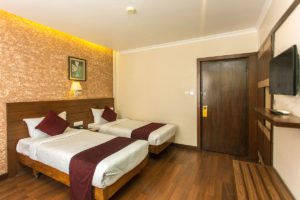
Gateway Himalaya Resort
Gateway himalaya resort | besisahar, nepal.
Gateway Himalaya Resort in Ghanpokhara features 4-star accommodation with a terrace, garden, and a bar. Each room offers air conditioning, free WiFi, and a private bathroom.
Hotel Barahi
Hotel barahi | pokhara, nepal.
Named for the island temple of Barahi the hotel offers fine Nepali hospitality and luxury. Four room types (Deluxe, Super Deluxe, Executive Deluxe, and Suites), each include a buffet breakfast, air conditioning, wifi, and some offer a private balcony with mountain or city views. Visit the onsite dining room, courtyard cafe, or bar for local and international cuisine. After your long trek, relax in the outdoor pool or spa.
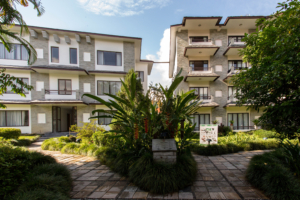
Accommodations on the Annapurna Circuit
Accommodations on the annapurna circuit: tea houses.
During the trekking portion of the adventure, the accommodations will be in tea houses that offer dormitory-style rooms with single and double bunk beds, comparable to many other mountain lodges/huts in other parts of the world.
The tea houses are typically equipped with running cold water and shared bathrooms in a separate section. At most of them, there are propane-fueled hot showers available to use for a small fee (typically $5-10 USD equivalent). It is usually possible to charge personal electronic devices in the common/dining areas, however they also charge a small fee for this (typically $5-10 USD equivalent).
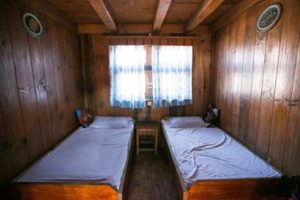
What Sets Us Apart
Personal attention before your annapurna circuit trek.
There is no other operator in the travel industry that will provide the same level of personal attention before your adventure in Nepal. We get very involved with our travelers before each trip, by offering a series of pre-planning calls in the months and weeks before departure. This provides you with an opportunity to hear directly from us on preparation, trip experience, as well as training. It also gives you the platform to ask questions about any aspect of the trip.
Staff Support
Our knowledgeable support staff take care of the details of your in-country transportation, lodging, meals, cultural tours, and activities. We’ve even scheduled in a bit of free time for you to explore, relax, shop, or eat on your own. When you travel with The Explorer’s Passage, we ensure that every detail is handled.
Sustainability and Responsible Travel
The Explorer’s Passage is a proud member of Sustainable Travel International, a partner/supporter of the Leave No Trace Center for Outdoor Ethics, as well as a supporter of the Center for Responsible Travel (CREST). In addition to ‘Leave No Trace’ principles, the concepts of sustainability and responsible trekking are at the forefront of our Himalayan journeys. As part of this commitment, we: minimize single-use plastic; intentionally stay at smaller tea houses/lodges along the trekking route (they are generally more sustainability-oriented and less wasteful); minimize disruptions to wildlife and local Nepalese communities (this includes noise moderation near homesteads and villages); do not allow collecting of plants, rocks, or other items from the trail; and we only use authorized paths to prevent erosion and damage/disrespect to local sites.
Ready to Book? Contact Us
Annapurna circuit trek photos.
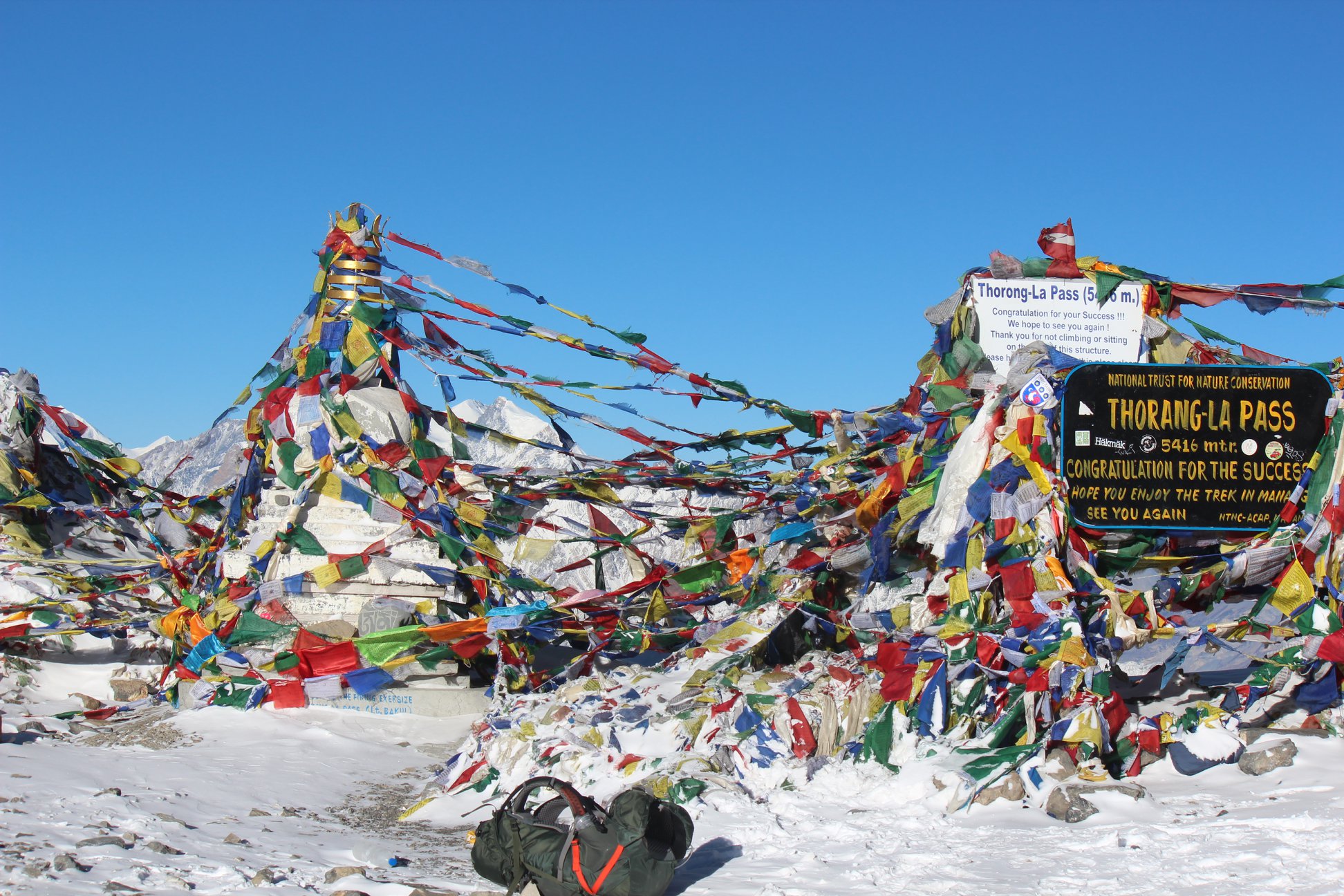
More Trip Inspiration
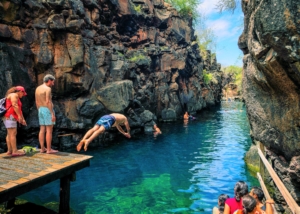
Galapagos Safari Camp
Galápagos Safari Encounter flora and fauna seen nowhere else on Earth on islands famed for their biodiversity EXPLORE Ecuador | Days: 6 | From: $5,995
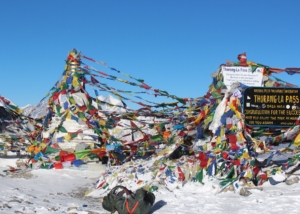
Annapurna Circuit Trek
Annapurna Follow an ancient trade route through the Himalayas on this challenging trek EXPLORE Nepal | Days: 18 | From: $4,295
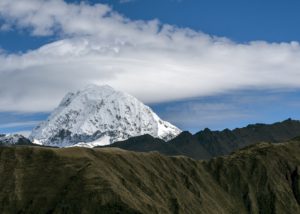
Salkantay Trek
This route is your chance to stray off the beaten path and witness one of the most dramatic corners of the Cusco Andes.
- +9779851276377
- 977 01 5348594
- [email protected]
- Follow us on:
Annapurna Circuit Trek
Manang village, on the way to yak kharka, thorong la pass, you can also, things to know before trip, trip introduction.
The Annapurna Circuit Trek in the western region of Nepal is one of the best trekking trails in the world. This provides an opportunity to immerse oneself in its unmatched natural beauty and gain insights into Buddhist and Hindu culture. During our Annapurna Circuit Trek, we encircle the whole Annapurna Himalaya passing through beautiful forests, picturesque landscapes, striking waterfalls, deep gorges, shining glaciers, diverse cultures, and pristine lakes with awesome views of the snow-capped Himalayas all the way.
A special Trekking Permit will be arranged to enter the Annapurna Conservation Area , where we discover unique flora and fauna. The route of the Annapurna Circuit Trek involves crossing Thorong La Pass at 5,416m/17,770ft which is a great challenge and will provide rewarding memories that will last forever.
Overview of Annapurna Circuit Trek
We embark on Annapurna Circuit Trek after you enjoy some sightseeing around the culturally rich Kathmandu valley . Initially, we take a drive from Kathmandu to Dharapani via Besisahar on a newly constructed road. Then the Annapurna circuit trekking starts as we ascend from Dharapani toward Chame. The trail passes through the Annapurna conservation area surrounded by picturesque mountains with a vast glacial plateau in the center. As we gain altitude, the vegetation around us slowly changes from dense forests to small shrubs; finally, we arrive at a point similar to a Tibetan plateau called Manang. There we can get insights into Tibetan-influenced culture and traditions and also acclimatize for a day.
Thorong La Pass – the highest point on the Annapurna Circuit
Depending on your fitness level and physical capabilities, our trek leader will decide whether to stop at Thorong Phedi or push onwards towards the high camp for an overnight stay. We will then cross Thorong La Pass at an altitude of 5,416 meters. Thorong La Pass blesses us with stunning views of Annapurna, Kali Gandaki Valley, Dhaulagiri, and other peaks as never been seen before. This is the highest pass in our Annapurna Circuit Trek itinerary.
Muktinath, Red Monastery Kagbeni and Tatopani Hotspring
The trail leads us to Muktinath, the pilgrimage site where we can see a perfect amalgamation of Hinduism and Buddhism. We then visit the Red Monastery at Kagbeni where we can view the golden book of the Dalai Lama . Then we descend towards Marpha, the apple kingdom famous for local apple products. We will then take a dip at Tatopani, a natural hot spring for relaxation.
Ghorepani Poon Hill and Ghandruk
Towards the end of our Annapurna Circuit Trek, we get the flashback of all Annapurna Himalayan ranges from Poon Hill Viewpoint which is famous for the best sunrise views. We trek down towards the Gurung -inhabited village of Ghandruk and get back into Pokhara. In this way, our trek ends and we drive or fly back to Kathmandu.
Who can join Annapurna Circuit Trek and How?
The Annapurna Circuit Trek is suitable for any travel enthusiast if you have a passion for walking, learning, and exploring the nature and culture of Nepal. Physical fitness plays a vital role in making this trip a success. Regarding the best seasons, we highly recommend the autumn and spring months.
Join Annapurna Circuit Trek on your next vacation with Nepal Mountain Trekkers for an unforgettable Annapurna experience. Simply fill out the Booking form and let us know about your interest. Or you can contact us directly by sending us an email to join this short and easy trek in the Annapurna Region .
If this itinerary doesn’t suit your requirement or if you want to customize it, please feel free to contact us. This trek could be customized as per your required time-frame and budget limits.
- Day 1 Arrival in Kathmandu [1,300m/4,264 ft]:
- Day 2 Kathmandu: Sightseeing and Trek Preparation:
- Day 3 Kathmandu to Dharapani[1,860 m/6,102 ft] via Besisahar [760 m/2,493 ft]: 9 - 10 hrs drive:
- Day 4 Dharapani to Chame [2,710 m/ 8,891 ft] : 5 - 6 hrs:
- Day 5 Chame to Pisang [3,300m/10,824ft]: 5 – 6 hrs:
- Day 6 Pisang to Manang [3,540m/11,614 ft]: 6 – 7 hrs:
- Day 7 Manang: Acclimatization Day:
- Day 8 Manang to Yak Kharka [4,110m/13,484ft]: 3 – 4 hrs:
- Day 9 Yak Kharka to Thorong Phedi [4,600m/15,092ft]: 3 – 4 hrs :
- Day 10 Thorong Phedi to Muktinath [3,800/12,467ft] via Thorong La Pass [5,416m/17,764ft] : 8 - 9 hrs:
- Day 11 Muktinath to Marpha [2,670m/8,760ft]: 4 – 5 hrs:
- Day 12 Marpha to Kalopani [2,530m/8,300 ft]: 5 – 6 hrs:
- Day 13 Kalopani to Tatopani [1,200m/3,937ft]: 6 – 7 hrs:
- Day 14 Tatopani to Ghorepani [2,850m/9,350ft]: 7 – 8 hrs:
- Day 15 Ghorepani to Tadapani [2,710m/8,891ft]: 6 – 7 hrs:
- Day 16 Tadapani to Pokhara [820m/2,690ft] via Ghandruk: 5 - 6 hrs trek, 1 hr drive:
- Day 17 Pokhara to Kathmandu: 5-6 hrs drive:
- Day 18 Departure Day:
Detail Itinerary
Day 1 : Arrival in Kathmandu [1,300m/4,264 ft]::
As soon as you arrive at the capital city, Kathmandu, you will be met by a representative from Nepal Mountain Trekkers at the International Airport terminals and he will take you to your respective hotel. After checking into the hotel, you can enjoy your free time relaxing in a cozy room or stroll around the tourist hub Thamel area until the end of the day.
Day 2 : Kathmandu: Sightseeing and Trek Preparation::
After having our early meal, we start our day with a visit to the Nepal Mountain Trekkers office at Thamel. After being introduced to our team including tour guide, trekking leader, and director of operations, we head for necessary trekking preparations, getting needed equipment with the initiation of Kathmandu sightseeing around world heritage sites. Kathmandu Durbar Square, Swayambhunath stupa, Pashupatinath temple, and Boudhanath stupa are UNESCO world heritage sites that we explore till sunset. Overnight stay at the hotel in Kathmandu. B included.
Day 3 : Kathmandu to Dharapani[1,860 m/6,102 ft] via Besisahar [760 m/2,493 ft]: 9 - 10 hrs drive::
Our real Annapurna Circuit Trekking Journey starts today as we drive through beautiful hilly roads along the banks of the Trishuli River towards Besisahar. And after having our brunch at Besisahar, we start our trekking when we reach Dharapani. Overnight stay at the tea house. B L D included.
Day 4 : Dharapani to Chame [2,710 m/ 8,891 ft] : 5 - 6 hrs::
This day we will start trekking with a moderate hike towards Chame, passing through several suspension bridges enjoying the blissful nature. We will walk through Pine and Rhododendron Forests and we can enjoy the mesmerizing view of Manasalu Mountain Ranges along the trail. Whereas, we can learn a lot about the Nepalese lifestyle while you pass through the typical villages with traditional houses. Overnight stay at the tea house. B L D included.
Day 5 : Chame to Pisang [3,300m/10,824ft]: 5 – 6 hrs::
Our day begins with walking through dense forests, narrow trails and soon this greenery starts to disappear as we gain altitude. Here, we will be crossing numerous suspension and wooden bridges that open up the trails to spectacular snow-capped mountains. In this way at the end of the day, we finally arrive at Pisang where we will be staying overnight. B L D included in meals.
Day 6 : Pisang to Manang [3,540m/11,614 ft]: 6 – 7 hrs::
Leaving behind Pisang, we head towards beautiful Manang valley where we have two routes to follow and we recommend you to take the higher route passing Garu that offers great landscape and Himalayan views. From this point, we find a difference in landscapes and alpine vegetation starts to appear. A quick visit to the local Barge monastery would give some cultural insights. And we conclude our day after staying overnight at one of the tea houses in Manang. B L D included in meals.
Day 7 : Manang: Acclimatization Day::
Proper acclimatization is very important to successfully complete this trek and today we take it as a rest day to make our body adapt to high altitude surroundings. Upcoming two days will be a bit more challenging and rigorous, therefore today we will not just rest but go for a few altitude hikes up and descend at the end of the day. So, there would not be any acute mountain sickness issues. During the daytime, we visit a few monasteries and viewpoints. We overall explore Manang village. Finally, we stay overnight at Manang including B L D in meals.
Day 8 : Manang to Yak Kharka [4,110m/13,484ft]: 3 – 4 hrs::
Today after having our early meal, we start our day by crossing several small river streams to arrive at the village called Tenki, and heading northward from the trails, we follow the beautiful pasture lands and meadows where horses and yaks graze. Therefore the name of the place is also ‘Yak Kharka’ implying Yak pasture land. We walk slow and steady in a gradual way as we don’t want to mess up with altitude sickness while gaining altitude. We stay overnight at Yak Kharka including B L D.
Day 9 : Yak Kharka to Thorong Phedi [4,600m/15,092ft]: 3 – 4 hrs ::
Today we will be leaving behind Yak Kharka and heading towards the foot of high altitude Thorong la pass (4650m). It is a small place to get ourselves relaxed and ready for the next day. If you are super fit, you can also go to stay overnight at high camp, but taking a safety-first, we recommend you to stay overnight at Thorong Phedi. B L D included in a day’s meal.
Day 10 : Thorong Phedi to Muktinath [3,800/12,467ft] via Thorong La Pass [5,416m/17,764ft] : 8 - 9 hrs::
Finally, the most important day of our Annapurna Circuit Trek has arrived as today we will cross Thorong La pass, immerse in the magical views and experience at 5420 meters above sea level. Almost you feel like you are touching a horizon. Plenty of pics will be clicked and a great experience will be accumulated. And finally, we head towards the popular pilgrimage site of Muktinath at the end of the day where we can get insights into both Buddhists and Hindu religious and cultural highlights. We stay overnight at Muktinath with B L D included.
Day 11 : Muktinath to Marpha [2,670m/8,760ft]: 4 – 5 hrs::
We wake up early in the morning, get a blessing from the holy temple, visit the nearby monastery, and slowly descend through Ranipauwa village to arrive at Kagbeni, Jomsom, and Marpha. We get to experience huge diversity in landscapes and topography as we will be losing almost 3000m altitudes in a day. From alpine to deserted and forested lands, we walk through all. Also, Marpha is popular for its apple products and known as the apple kingdom. We will also enjoy the special apple brandy and stay overnight at Marpha in a party mood. Meals include B L D.
Day 12 : Marpha to Kalopani [2,530m/8,300 ft]: 5 – 6 hrs::
Leaving behind Marpha, we will be trekking through cultural Thakali villages where there are plenty of apple farms and spectacular sceneries of Annapurna, Dhaulagiri, and other neighboring Himalayan peaks. In this way, we finally arrive at Kalopani at the end of the day where we stay overnight. Meals include B L D.
Day 13 : Kalopani to Tatopani [1,200m/3,937ft]: 6 – 7 hrs::
Today we mostly walk downhill descending from Kalopani to Tatopani. After crossing Ghasa, we can see beautiful forested lands, striking waterfalls, and even enjoy natural hot springs at Tatopani. It will be a beautiful cultural exploring opportunity day with the chance to view natural highlights around the sites too. Overnight stay at Tatopani including B L D.
Day 14 : Tatopani to Ghorepani [2,850m/9,350ft]: 7 – 8 hrs::
Today we mostly explore the local lifestyle of mid villages in Nepal where we enjoy beautiful terraced fields, landscapes; rhododendron forests that blossom in a magical way during spring with other faunas along the way. We sleep early today to wake up early tomorrow for the Poon hill hike. Overnight stay at Ghorepani including B L D.
Day 15 : Ghorepani to Tadapani [2,710m/8,891ft]: 6 – 7 hrs::
Waking up early in the morning before sunrise, we walk towards the top of the Poonhill in the dark. You will see plenty of other travelers waiting to experience the best ever sunrise views over Annapurna and Dhaulagiri Himalayas. After capturing the best shots in the camera, we descend through forested trails towards Tadapani. We stay overnight at Tadapani with B L D included.
Day 16 : Tadapani to Pokhara [820m/2,690ft] via Ghandruk: 5 - 6 hrs trek, 1 hr drive::
Following the beautiful jungle trails from Tadapani, today we arrive at equally beautiful and culturally rich Gurung, Magar village of Ghandruk. Ghandruk is popular for awesome Himalayan, landscape views with warm hospitality from local inhabitants. After having our lunch we take a short about an hour drive to main Pokhara city. Overnight at hotel in Pokhara. Meals include: B L
Day 17 : Pokhara to Kathmandu: 5-6 hrs drive::
In this way, finally, our amazing Annapurna Circuit Trek comes to the conclusion and we either take a drive or you have an option to fly to Kathmandu. Upon arrival at Kathmandu, you will be met by our director of operations, Mr. Dhakal , and offer you a farewell dinner as a complimentary token of love from Nepal Mountain Trekkers Company.
Day 18 : Departure Day::
Today will be your final day in Nepal, as we drop you at International Airport for your scheduled international flight towards your onward destination.
Price Includes
- Airport Pick-up and drop service(Private Vehicle depending upon the Group Size)
- 3 nights Hotel in Kathmandu(with Breakfast)
- 1-night Hotel in Pokhara(with Breakfast)
- Sanitation: The accommodation we provide will be neat and clean with warm-hospitality and quality services.
- Single/Twin-sharing Accommodation (as per budget): Your group won’t have to share your accommodation with anyone else so your privacy is protected.
- We provide hygienic and safe meals to re-energize you.
- We request you not to waste your meals for it is difficult to transport food in the rural area.
- You are not allowed to share your meals with anyone else from another group.
- Transportation costs: Public Bus (Kathmandu – Besisahar), Private Jeep(Besisahar – Dharapani), Private Vehicle(Nayapul-Pokhara), and Tourist Bus(Pokhara-Kathmandu)
- Local Staffs: Our guides are locals of the region which ensures that you will surely get to explore a bit more during the trek than with any other guides.
- Experienced: With an experience of more than a decade of working in this field, our trekking guides possess excellent knowledge on briefing during the trek as well as they are experts in handling all kinds of critical situations which might occur during the trek.
- Insurance: Nepal Mountain Trekkers have an insurance policy for all our trekking staff.
- Local Staffs: The porters we hire belong to the same region where we trek in order to provide employment opportunities to the locals as well as to make you explore every prospect of the region.
- Trekking Permits: Trekkers’ Information Management System(TIMS) Card and Annapurna Conservation Area(ACAP) fees
- Trekking gears like sleeping bags and down jackets made available on rent
- T-shirt, Duffel Bag, and Trekking Map with Company Logo
- Rescue Arrangement Service
- First aid medical box
- 13% VAT and 10% service charge
- Farewell Dinner
Price Excludes
- Visa fee to enter Nepal ( Visa Information )
- International flight tickets
- Foods in Pokhara and Kathmandu
- Extra night accommodation and meal costs in Kathmandu and Pokhara due to any change in the scheduled itinerary
- Travel insurance/ Rescue operation costs
- All personal expenses(internet, laundry, battery charge, donation, etc)
- All soft drinks and alcoholic beverages
- Tips for guide and porters
Trip Gallery
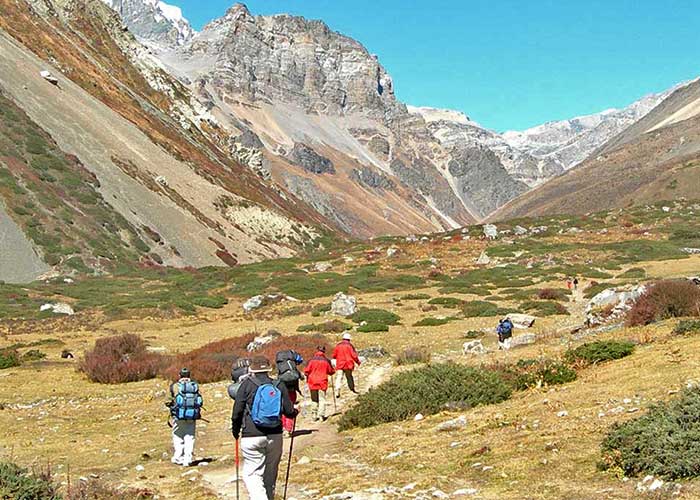
- Sun hat or scarf
- Light balaclava or warm fleece hat
- Cotton t-shirts or thermals
- Fleece jacket
- Waterproof jacket
- Down jacket
- Lightweight cotton pants (long)
- Waterproof pants
- Thin inner socks
- Thick, warm wool hiking socks
- Comfortable hiking boots
Accessories
- Sleeping bag rated to -10°C +
- Trekking bag (Rucksack)
- Large plastic bags (for keeping items dry inside trek bag)
- Trekking poles (optional, recommended)
- Water bottle or camel bag
Miscellaneous
- Medicines: We recommend you bring your regular medicines; we will provide a first aid kit from our side.
- Light-weighted Towel
- Swiss Knife
- Passport and extra passport photos
- Water Purifying Iodine Tablets, Drop or Sterilizer
Fixed Departures
- 06/02/2024 2-10 Yes $1700 $1445 Book
- 29/02/2024 2-10 Yes $1700 $1445 Book
- 03/03/2024 2-10 Yes $1700 $1445 Book
- 15/03/2024 2-10 Yes $1700 $1445 Book
- 21/04/2024 2-10 Yes $1700 $1445 Book
Related Trips
You will also like …
- View Details
- Enquire Now
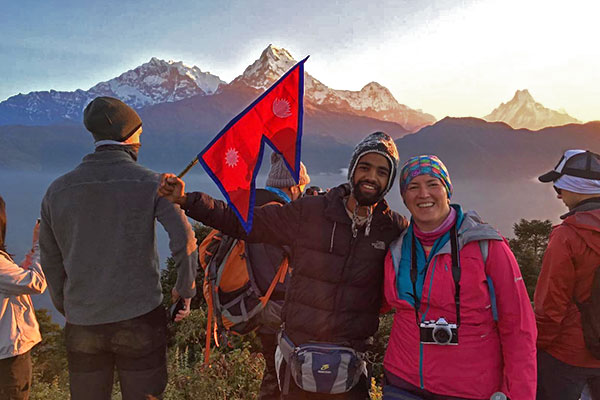
Ghorepani Poon Hill Trek
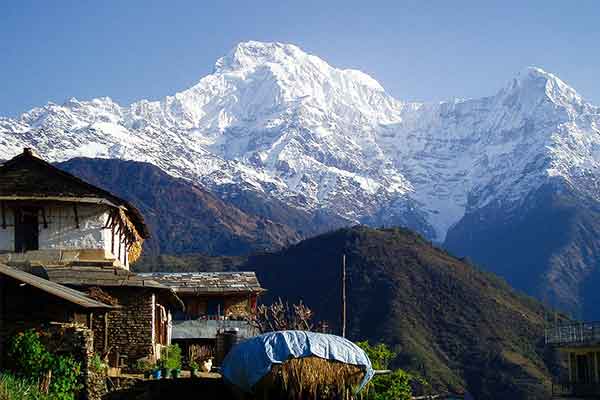
Ghandruk Trek
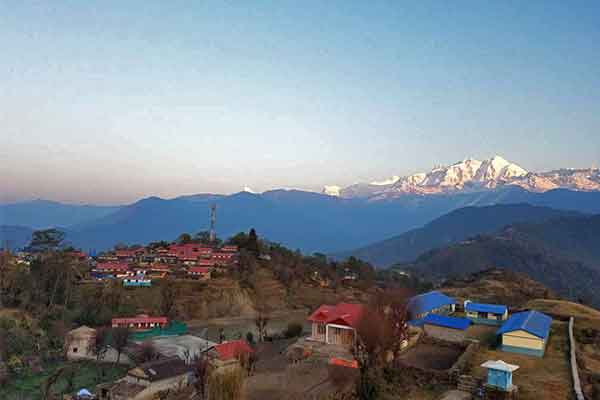
Ghale Gaun Homestay
- Leisurely Plus
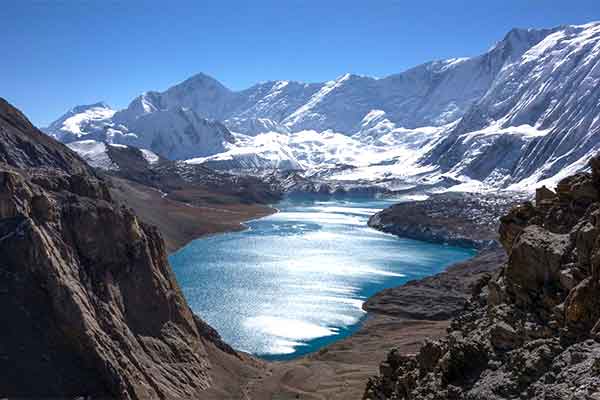
Annapurna Round Tilicho Lake plus Poon Hill Trek
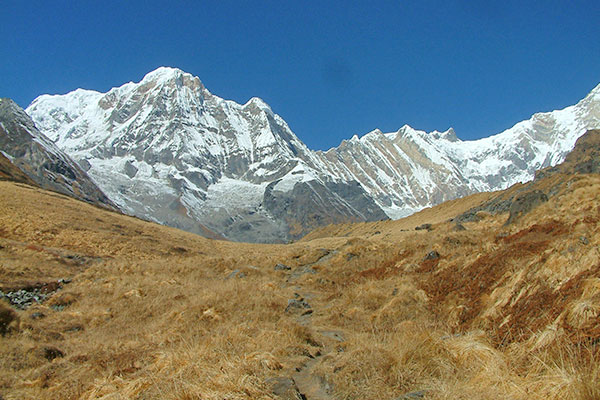
Annapurna Base Camp Trek
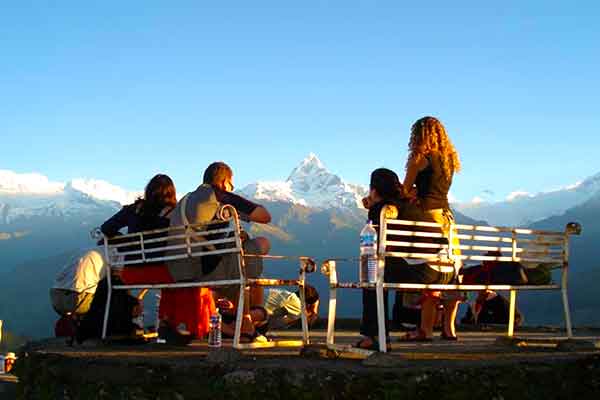
Around Pokhara Day Hiking
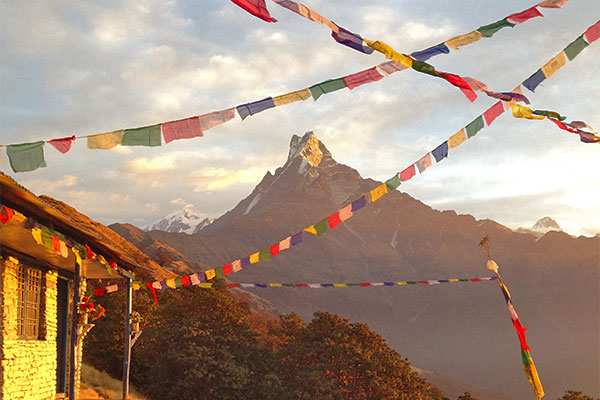
Mardi Himal Base Camp Trek
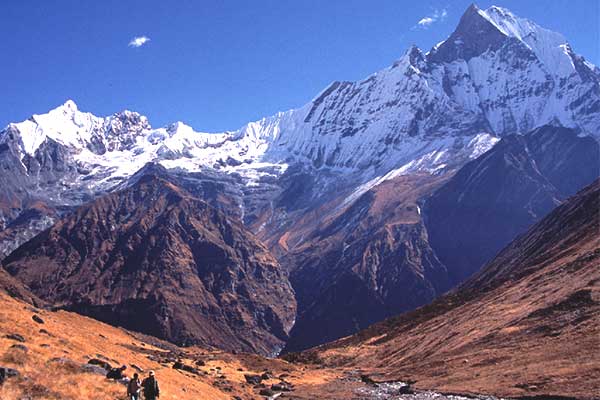
Machhapuchhre Model Trek
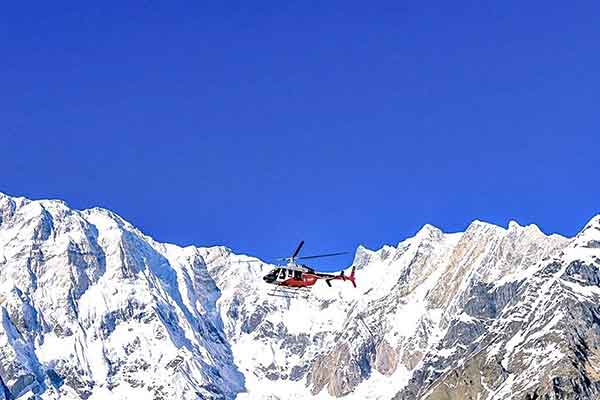
Nepal Helicopter Tour in Pokhara
Clients review.
What our customers say about us
Not too Cold.nice scenery through Mountain villages.delicious food Dhal bat
Nice trek for Nepal newcomers 8days Not too Hard.guide Krishna Was very helpful and we hat good time.luckily no rain at that time
Full recommendation
We had an excellent trip with Nepal Mountain Trekkers. They were really helpful and took plenty of time to discuss the perfectly individual trek with us in advance. Even during the trip we were always able to make adjustments depending on how we felt. Our guide TB was always friendly, entertaining and knew the area very well. Even after the trek in the afternoon he showed us the monasteries and explained the religions to us. When we did not feel well, he bought medication for us. He always took care of us, asked whether we needed additional blankets during the night, whether we wanted some tea in the afternoon and was flexible when to start the trek in the morning etc. His motto was: “Everything is possible.” Thank you very much for everything again!
Friendly company to deal with and very attentive to details.
Suman has lots of experience and can organise trips anywhere in Nepal for beginners right through to high altitude treks. Chirring (the guide on my trek in Manaslu) was fantastic..very supportive and patient with me – it was a pleasure trekking with him. I definitely recommend using this company. I also recommend the hotel next door (Hotel Green Horizon), which is good value and has friendly staff.
Annapurna Circuit + Tilichio Lake
We had a really good trekking trip (Annapurna Circuit + Tilichio Lake + Poon Hill) with Nepal Mountain Trekkers. Accommodation, organization and support was always good and fast. The trek is beautiful.
Unfortunately my boyfriend got sick on the way but with the help of our guide Pralad we could still manage to do Tilichio Lake and Thorong La Pass (but had sadly to skip Poon Hill). Thus, Nepal Mountain Trekkers reorganized our final days in Pokhara. Thank you for that! We had lovely holidays in this wonderful country and would book again with Nepal Mountain Trekkers!
Utterly fantastic
Highly, highly recommend NMT! I’m delighted to say that Suman started as a guide and after a month of treks and trips in Nepal, ended as a friend. My wife and I landed in Kathmandu having done research but not booked anything and Suman took us through all the options and routes for various regions before joining us on two treks – one in Kathmandu valley and one on the Annapurna Circuit. Suman was amazing to trek with, taught us some Nepali and even invited us to spend Christmas in his home with his family which was lovely. I’ll be returning to Nepal and will be delighted to see Suman and the team again!
Highly, highly recommend NMT! I’m delighted to say that Suman started as a guide and after a month of treks and trips in Nepal, ended as a friend. My wife and I landed in Kathmandu having done research but not booked anything and Suman took us through all the options and routes for various regions before joining us on two treks – one in Kathmandu valley and one on the Annapurna Circuit.
Suman was amazing to trek with, taught us some Nepali and even invited us to spend Christmas in his home with his family which was lovely.
I’ll be returning to Nepal and will be delighted to see Suman and the team again!
Unforgettable – Annapurna Circuit Trek
I had the pleasure to spend 4 weeks in Nepal and this fantastic trip left me with so much colorful and inspiring memories which was clearly the merit of Ramesh and his amazing team. It is therefore not difficult to recommend Nepal Mountain Trekkers – from the first contact over a customized and detailed planning to an individual and heartfelt care onsite, everything was professional and 100% customer-oriented. I enjoyed every moment of my stay and had a wonderful time with my guide Sansib (Min) and my porter Radjendra. They all bring in so much heart, passion and willingness to make your stay unforgettable and get prepared, they will become a part in your heart pretty soon. I miss their positive energy and relaxed manner to handle things! Keep on your fantastic work and I am looking forward to seeing you any time soon.
Annapurna region 8 Day Trek
TB at Nepal Mountain Trekkers was fantastic, nothing was too much trouble, when we decided to change our trek at the last minute he had it organized in no time. He is very knowledgeable and professional and knows all the Treks in Nepal, so if you are thinking of a trek in Nepal TB at Nepal Mountain Trekkers is your man. He was always looking out for our wellbeing, making sure we weren’t ill and we were eating enough. A fantastic experience all round.
Annapurna trek (Poon Hill, Ghandruk and Dhampus)
I had an adventure of a life time in Nepal with Nepal Mountain Trekkers. The company was very professional and their staff were amazing especially Suman Gurung our guide. Suman was outstanding. I highly recommend this company to you
Hervorragende Agentur, die alles möglich macht
Im November 2017 wollte ich mit einer Freundin wieder einmal nach Manang im Annapurna Gebiet trekken, um dort eine von uns unterstützte Boarding School zu besuchen. Ramesh hatte schon den dafür notwendigen Plan ausgearbeitet. Aber die Knieprobleme meiner Begleiterin machten es unmöglich. Kurzer Hand plante Ramesh um, besorgte uns den umsichtigen Fahrer Heris und den Guide Daljit und organisierte uns einen Homestay-Aufenthalt, der für uns ein Erlebnis wurde. Ich habe mit Ramesh einen Menschen kennnengelernt, der zuverlässing und verbindlich alles möglich macht. Wie er verfügen auch seine “Jungs” über großes Wissen, was Kultur und Natur des Landes angeht. Er ist ein überaus verantwortungsvoller und engagierter Mensch, der sich um seine Crew und die Menschen in seinem Heimatdorf kümmert. Im März 2019 besuchte ich schließlich wieder einmal Nepal, wurde wie immer von der Trekkingagentur abgeholt und zum Hotel Horizon gebracht, ein familiär geführtes Hotel, welches ich empfehlen kann. Wie immer stand uns Ramesh mit Rat und Tat zur Seite. Ich habe in jeder Hinsicht mit ihm und seinen Leuten die besten Erfahrungen gemacht und plane bereits meine nächste Trekkingtour mit ihm. Seine raschen Antworten mit maßgeschneiderten Vorschlägen erleichtern die Vorstellung und Planung von dem, was möglich ist. In den Händen seiner Agentur ist man bestens aufgehoben.
Amazing Annapurna Trekking Experience!
I did the Annapurna Circuit in October/November 2018 and had an amazing time! Nepal is by far the most beautiful country I’ve traveled so far and Nepal Mountain Trekkers made this trip an even better experience! Krishna has been a perfect guide who did not only ensure my safety in the mountains but also taught me a lot about flora and fauna as well as country and culture! I highly recommend him as a guide as well as the company, who puts great emphasis on travelers’ wellbeing and an authentic travel experience. A special thank you to Ramesh for his kindness and for organising the trip as well as to Krishna – I look forward to coming back to Nepal!
Amazing trip
Did a excursion at the Annapurna area with a friend.The agency was really great, helpful and i didnt have to worry about anything..they arranged all. Highly recommended!!! Ramesh was great..thank u for the experience!!
Perfekte Agentur für perfektes Trekking
Nachdem ich mit dem Trekking Agentur „Nepal Mountain Trekkers“ bereits die Touren Langtang – Helambu sowie Annapurna Basecamp (Bewertung s. 2016) gemacht habe, war im Spätherbst 2017 der Annapurna Circuit dran, den ich mit zwei Freunden aus Amerika gegangen bin. Natürlich habe ich auch diesen Trek von Ramesh Dhakal, dem Inhaber der Agentur , vorbereiten lassen und gleich auch meinen vertrauten Guide Krishna für diese Zeit reserviert. Warum eine so relativ einfache Trekkingtour über ein Agentur buchen, wird sich so mancher fragen. Aus meiner Sicht ist es absolut vorteilhaft jedes Trekkingunternehmen in Nepal über eine Agentur zu organisieren und die „ Nepal Mountain Trekkers“ kann ich nur wärmstens empfehen. Man wird in jeglicher Hinsicht fachkundig und als Freund betreut, sämtliche organisatorischen Dinge werden im Vorfeld zuverlässig erledigt und dadurch spart man sich viel Zeit für persönliche Interessen. Des weiteren ist ein Guide wie Krishna unterwegs eine unschätzbare Hilfe. Er konnte uns sehr viel Interessantes über die verschiedenen Gegenden auf der Strecke, über die Menschen und über die Natur erzählen das man sonst einfach nicht mitbekommt oder erfährt. Er kennt auch Wegstrecken die nicht allgemein bekannt sind und sollte es Probleme geben, so hilft er mit Rat und Tat. Einer meiner Freunde hatte zum Beispiel im Thorong Base Camp ein gesundheitliches Problem, das wir aber dank seiner Hilfe in den Griff bekommen haben. Ganz herzlichen Dank nochmals an Ramesh und vor allem an Krishna. Mit seiner ruhigen und umsichtigen Art hat er uns ein unvergessliches Trekkingerlebnis in einer wunderschönen Landschaft ermöglicht.
Josef Maurus
Trek annapurna circuit, 11 days..
Recently completed a trek in the annapurnas, Besisham, Manang, Muktinah, Jomson. Took 11 days. I organised it while in Kathmandu through Nepal Mountain trekkers ( easy to find, office in front of horizon hotel). Ramesh was great giving me a competitive and detailed quote,a lot cheaper than organising back in Australia. All organised on the spot and we left next morning. He even organised my luggage to be transfered to Pokhra. Everything promised was delivered and my porter-guide Krishna was fantastic. I would highly recommend this company.
En dehors des sentiers battus
J’ai découvert cette agence de Trekking par hasard et je n’ai vraiment pas été déçu. Je voulais faire un trek pour découvrir la culture local en dehors des habituels treks très (trop) fréquentés et ils m’ont proposé un trek sur mesure correspondant vraiment à ma demande. Je suis parti seul avec un guide vraiment très sympathique et professionnel qui est devenu un ami. Ce trek ma fait découvrir la culture du Népal. Nous dormions chez l’habitant et j’ai pu ainsi découvrir le mode de vie et les coutumes des Népalais. Je n’ai pas vu un seul touriste pendant les 6 jours de mon trek et les personnes rencontrées étaient vraiment accueillantes et intriguées par ma présence. Rien à voir avec le contact ressentie lors des treks sur les sentiers classiques des Annapurna par exemple. Je recommande vivement cette agence sérieuse qui propose des treks à la découverte du Népal authentique.
Alexandre P
Great trekking company and hotel.
Mr. Ramesh Dhakal is very helpful and friendly professional. Even though we were not his clients he gave us plenty of great advices and tips for our Annapurna Circuit Trek. We met him in Kathmandu where we stayed in his hotel Horizon, which is such a lovely place to stay. Although the hotel is in the centre of Thamel, it is very quiet and clean with amazing garden for breakfasts and hangouts. Since we decided that our next Nepal trip will be using their services again, we can highly recommend both Nepal Mountain Trekkers and hotel Horizon.
Annapurna Circuit 12 days
I met Mr. Suman Gurung last time I was in Nepal in 2014. At that time he organized a tour around the country for me and my girlfriend but we didn’t do any trekking. We agreed to plan it for the next visit and it happened this year. I addressed Mr. Suman Gurung in prior to book my trekking. Trekking was a bit hard physically but fulfilled with a lots of fun, good lessons and gorgeous views of the nature. My guide Mr. Gurung proved to be an expert and proficient in his job. I highly recommend you to do trekking with him.
Annapurna Circuit
The trek was just perfect. Mr. Ramesh Dhakal is a very friendly and helpful guide with perfect english. His hotel Horizon is berfect base for all kind of treks.
Nepal Mountain Trekkers
We met Mr. Ramesh Dhakal during our Annapurna Circuit Trek. He was very helpful and very kind, even though we were not his clients. He gave us a lot of helpful advices and we met him also in Kathmandu at hotel Horizon, which is such a nice place to stay. Although the hotel is in the centre of Thamel, it is very quiet and very nice and clean. We highly recommend Nepal Mountain Trekkers and hotel Horizon.
WE ARE ASSOCIATED WITH
SEND US A MESSAGE
- Dates and prices

Hike the Annapurna Circuit in Nepal
Since opening its trails to foreigners in 1977, the Annapurna Circuit has been enticing hikers with promise of larger-than-life adventure. With over 100 miles of dense forests, terraced rice fields and dramatic high-altitude walks through the Himalayas, this is one of the most awe-inspiring long-distance treks in the world.
Undertake an epic 15-day journey full of dazzling biodiversity and epic views of the Nepal Himalayas. As you reach the end of the trail, you’ll learn to appreciate the small things in life and understand why so many consider this trek a life-changing experience.

A journey through jungle and clouds
Coursing through the very heart of Nepal, between the towering peaks of the Annapurna Range, the Circuit takes you through four distinct regions and their richly diverse ecosystems.
As you begin your journey from Kathmandu, you’ll visit ancient Buddhist temples and sacred Hindu sites before reaching the starting point in Besisahar.
En route to Pisang, witness the landscape changing from wild banana trees and wet rice terraces to dense alpine forests. Enjoy the views of Annapurna II, IV, and Tilicho until you cross Gunsang, where sub-tropical meadows turn into a chilly alpine environment.
- ANCIENT KINGDOMS
- SACRED SITES
- COLORFUL VILLAGES
- DIVERSE LANDSCAPES
- EXOTIC WILDLIFE

On the edge of the Tibetan Plateau
Immerse yourself in local culture.
The Annapurna Circuit is a pilgrimage along the sacred trails of the Nepali people. Overflowing with history, its remote villages and monasteries display the religious and cultural intertwining of Hinduism and Buddhism. Life has remained almost unchanged here for centuries.
At around 18,000 feet, you’ll reach the pinnacle of the trek—the mythical Thorong La Pass. Enjoy the sweeping views of Mt. Dhaulagiri and the restricted lands of Upper Mustang below.
As you descend, the trail will take you to Muktinath—a sacred pilgrimage site and one of the world’s highest temples.

A life-changing experience awaits

Find bliss in the heart of the Himalayas
Friendships are forged on the trail.
Join a group of adventurous people on a trek through breathtaking nature and quaint locales brimming with life.
From one fascinating landmark and finger-licking delicacy to another, you’ll bond over your mutual admiration for the wonders of Nepal—and the challenge of reaching them.

LEARN TO APPRECIATE THE LITTLE LUXURIES
One of the key reasons for hiking the Circuit counterclockwise are the numerous teahouses scattered along the trail. These traditional symbols of Nepal are both oases of respite and indispensable resting spots that help you acclimatize to the local elevation.
They may not be the Hilton—the higher the altitude, the more basic the lodging—but after a long day of hiking, they’ll seem like it. Factor in the world-class hospitality and they’re like a gift from the heavens!

The Kathmandus and don’ts of hiking in Nepal
One thing Nepal really knows is how to keep its hikers full. The Annapurna region is renowned for its varied, healthy diet ranging from the invigorating Dal Bhat, to baked goods, and even Yak burgers! Just remember: if you’re respectful and open-minded, you’ll receive tenfold in return.
Moreover, try to make a positive impact on the trail. Hundreds of hikers traverse the Annapurna Circuit at the same time, which makes proper waste management even more critical. When done right, traveling can an enriching experiences both for you and the local community.
- TEAHOUSE NETWORK
- WELCOMING LOCALS
- TRADITIONAL CUISINE
- TIBETAN TEMPLES
- ASTONISHING VIEWS

Your guides
Trek Central are a team of young, energetic, and hardworking professionals, helping people from across the globe to experience and explore Nepal — one of the most spectacular natural and cultural destinations in the world. They have been working in this field for more than 6 years with a new vision and direction.
At the core of their business lies a genuine passion to make a difference in the world. They are dedicated to creating a positive impact and actively supporting the local communities we engage with.
Trek Central Nepal is an official member of the Nepal Tourism Board (NTB), Trekking Agents Association of Nepal (TAAN), Kathmandu Environment Education Project (KEEP), and many more local tourism bodies.

More trips like this
Trekking the manaslu circuit in nepal, hike the classic trails of patagonia, hike and sail the mythical faroe islands, hiking the alta via route in the dolomites, hiking iceland’s volcanic trails.

Your guides will welcome you at the Tribhuvan International Airport and take you to your accommodation in Kathmandu. Get some rest and join your group for a welcome dinner at the finest restaurant in the city and taste the delicious Nepali cuisine. Your guides will brief you about the trip details, go over the itinerary and take you back to your hotel. Don’t let the excitement stop you from sleeping — you will need your energy for the next 15 days!
Meals : Dinner Accommodation : Hotel in Kathmandu Altitude : 1300 m/ 4264 ft

Your guides will pick you up after breakfast and drive you to Jagat, a village situated at an altitude of around 1,300 meters (4,265 feet). Your adventure begins with an 8-hour drive through deep gorges as you trace the Trisuli River westwards. You will pass through the small town of Mugling where the Trisuli and Marshyangdi rivers meet before you reach Jagat, where you’ll spend the night. E xplore the village and s pend the night at a lodge.
Driving : 8-9 hours Meals : Breakfast, lunch, dinner Accommodation : Guesthouse in Jagat Altitude : 1300 m/ 4264 ft

After breakfast, begin your hiking portion of the trip in Jagat and set out to reach the village of Dharapani (6375 ft/1943 m). Start your trek by following the path over a suspension bridge into the woods. You will have a steep climb towards the settlement of Sattale but you’ll enjoy good views of the mountain peaks along the way. From here, the path leads you to the entrance to the Manang district. Today’s trip is filled with beautiful natural beauties like waterfalls and riverbeds that seemingly appear roughly every 200 meters , green villages decorated with terrace farms and sloping birch forests. You will also pass beneath the Kaani, a decorated gate arch painted with the traditional colors of the Buddhist prayer flags. Finally, you will reach Dharapani, where you’ll spend the night.
Hiking : 5-6 hours Meals : Breakfast, lunch, dinner Accommodation : Guesthouse at Dharapani Altitude : 1860 m/ 6102 ft

Today you’ll hike along a mule track dotted with hot springs until you reach the village of Timang. Walk along a slanting trail leading to a ridgeline with amazing views of the surrounding peaks. Enjoy the vistas of the Manaslu Peak, the Annapurna II, and many others before you continue trekking along the path. After you pass by villages like Thanchowk and Koto, you will finally reach your destination for the day, Chame.
Hiking : 5-6 hours Meals : Breakfast, lunch, dinner Accommodation : Guesthouse at Chame Altitude : 2670 m/ 8758 ft

Following the Marshyangdi River along the Pinewoods, you will reach the village of Telekhu via Brathang. From there, it is a gradual trek uphill towards Dhukur Pokhari, surrounded by amazing Himalayan views. You’ll have the opportunity to see the landscape transform from wet rice terraces to dense alpine forests until you reach the town of Pisang. Enjoy the amazing views of Annapurna II and Pisang Peak.
Hiking : 5-6 hours Meals : Breakfast, lunch, dinner Accommodation : Guesthouse at Pisang Altitude : 3200 m/ 10,496 ft

Today’s adventure is filled with amazing woodlands that are home to a wide variety of birds and jungle fowls. The pathway follows the hillocks towards the Humde Airport in Manang via the village of Bhraka where houses are built in the Tibetan style, with stacks of stones and thatch roofs. Along the way, you can also come across many Gumbas on the outer ridges of the settlements, and panoramic views of the mountain peaks. Finally, the path takes you to the famous village of Manang.
Hiking : 7-8 hours Meals : Breakfast, lunch, dinner Accommodation : Guesthouse at Manang Altitude : 3540 m/ 11,611 ft

This day is reserved for acclimatization. You can enjoy a leisurely exploration of the village today; Manang is situated in the broad valley of the Marshyangdi River that presents amazing views of the Annapurna Mountain Range. The Marshyangdi River flows towards the village’s east, and towards the north of the village lies the Chulu Peak.
Meals : Breakfast, lunch, dinner Accommodation : Guesthouse at Manang

Wake up, pack up your bags and get ready to hit the road again. Make sure you eat — a hearty breakfast is a must on the Annapurna Circuit! Today you’ll hike up to Yak Kharka. The hike will be long but the views will keep entertaining you. Wander along the paths uphill to the area of Tanki Manang and see how the locals live. Pass through tight alleyways making your way out of civilization and towards the end, prepare for a steep uphill portion. The second portion of the hike will be easier with some incline and beautiful swinging bridges along the way. You will notice animals, most notably yaks and horses, and finally, in the late afternoon, you’ll reach Yak Kahrka.
Hiking : 5 hours Meals : Breakfast, lunch, dinner Accommodation : Guesthouse in Yak Kharka Altitude : 4050 m/13,287 ft

At this point, the lower temperatures inform you that you’re nearing the top. From Yak Kharka, you will be trekking through the rocky-strewn oblique and rough terrains towards the foothill of the mountain pass, the Thorong Phedi. The Thorong Base Camp presents amazing views of the mountains, surrounded by terrace fields and sheer cliffs that are often climbed by the Himalayan Thar. Overnight stay at the guesthouse at Thorong Base Camp.
Hiking : 4-5 hours Meals : Breakfast, lunch, dinner Accommodation : Thorong Base Camp Altitude : 4450 m/ 14,596 ft

This will be one of the more challenging days of the tour. Wake up early in the morning and make your way steadily uphill. You will pass by goat herds and enjoy mesmerizing views of the entire Mount Annapurna and Manaslu massif as well as the valley below. After so many days of hiking, you will finally reach the 5416 m/17,769 ft Thorung La Base Camp. After reaching the top, descend to Muktinath in the historic Mustang Valley.
Hiking : 8-9 hours Meals : Breakfast, lunch, dinner Accommodation : Guesthouse at Muktinath Altitude : 3760 m/ 12,333 ft

Today you will pass through villages on your way to Jomsom, take a walk downhill and then along the bank of Kaligandaki river and face the strong winds on your way to your destination. As you hike through Kagbeni Village (the gateway of Upper Mustang trek), head downhill towards Ekle Bhatti and finally you’ll reach Jomsom. Take a rest and prepare for your night stay at the teahouse there.
Hiking : 4-5 hours Meals : Breakfast, lunch, dinner Accommodation : Teahouse Altitude : 2720 m/ 8922 ft

The traditional route of the Jomsom Muktinath trek has been supplanted by motorable roads extending from Muktinath to Tatopani. Traveling by private jeep to Tatopani, you can relish the spectacular vistas of cascading waterfalls and traverse between the towering peaks of Mount Annapurna and Dhaulagiri. Upon arrival in Tatopani, indulge in a rejuvenating bath in the natural hot springs, followed by an overnight stay in comfortable teahouse accommodations.
Driving : 4 hours Meals : Breakfast, lunch, dinner Accommodation : Teahouse

Start off the day following the Annapurna route, crossing the bridge and walking towards Gharkholagaon. Pass through Ganesh temple and reach Ghara. The walk ahead will take you through Sikha, Chitre and then finally to Ghorepani, where you’ll spend the night
Hiking : 7-8 hours Meals : Breakfast, lunch, dinner Accommodation : Lodge in Ghorepani Altitude : 2860 m/ 9381 ft

Today you’ll head off to Poon Hill early in the morning and reach Pokhara in the evening. Wake up early in the morning and start taking an uphill climb towards the top of the hill — it might seem difficult but it will all be worth it once you see the magnificent sunrise from the top. Enjoy the amazing sunrise along with a view of stunning snow-capped peaks(Mt.Dhaulagiri, Mt.Nilgiri south, Mount Annapurna south, Himchuli, Mt.Fishtail, Mt.Annapurna IV, Mt.Annapurna II, and many other) and take a few photos before you head back to Ghorepani. Reenergize with a hearty breakfast and move towards Nayapul which brings you to the end of the Annapurna Circuit Trek. Your group and guides will take a standard tourist bus ride to Pokhara. You’ve spent the last week on your feet, so use this time to recuperate and get some needed rest. You can either roam around in the lakeside, spend some time alone or enjoy your time with the rest of the crew members and share your experiences so far.
Hiking : 3 hours Driving : 5 hours Meals : Breakfast Accommodation : Hotel in Pokhara

Pack up your bags and head back to Kathmandu. Muse over the exciting trek you had and enjoy a long drive through Nepal. At Kathmandu, your guides will organize a farewell dinner to celebrate the successful completion of the trek and prepare for final departure.
Driving : 6-7 hours Meals : Breakfast, dinner Accommodation : Hotel in Kathmandu

Today is your final day in Nepal — get ready for the departure and take a few last photos before you head for the airport. Your guides can drop you off at the Tribhuvan International Airport. Exchange final greetings and wishes with your group and guides and have a pleasant journey home.

Secure the dates you want with a 30% deposit for this year or 10% deposit for next year. Pick your preferred dates without the risk of your bucket list adventure selling out!
Read about our cancellation policy on our FAQ page.
Book early-bird for the coming year, and secure your spots on time.
Hop on a 15min call with our adventure expert and let us know about your expectations. Whether you want to join a group or go on a fully private experience, we are here to make it happen.
What you get on this adventure:
- An experienced, certified mountain guide with extensive knowledge of the area and a local Nepali certified guide
- Sightseeing tour in Kathmandu
- Transportation from and to the airport
- Kathmandu to Besisahar by private car/van
- Besisahar to Jagat by local private Jeep
- Jomsom to Pokhara domestic flight
- Pokhara private car/van for pick up
- Pokhara to Kathmandu domestic flight
- Hotel accommodations with breakfast in Kathmandu and Pokhara
- Teahouse and mountain hut accommodations with all meals for the duration of the hike
- 1 hour trekkers massage / yoga after the trip completion
- First aid medical kit
- Local sim card
- Company duffel bag, t-shirt, and trekking map
- Down jackets and sleeping bags (upon request)
- Government taxes
- Porter services
- Trekking permits
What’s not included:
- International flight to/from Kathmandu
- Lunches and dinners in Kathmandu
- Luggage transportation for the duration of the hike
- Personal mountain gear
- Guide gratuities
- Trip insurance
Hiking the Annapurna Circuit is a challenging undertaking, and it requires excellent physical fitness .
If you want to fully enjoy your trip to Nepal, you should be able to hike distances exceeding 13 miles (20 km) for multiple consecutive days on steep, rocky, and slippery terrain with over 3,200 ft (1,000 m) of elevation gain. A lot of the hiking will be done in high altitudes , so some experience dealing with high elevation is recommended. Keep in mind that you’ll also be carrying a loaded daypack for the entirety of the 12 days of hiking and that the weather in the Annapurna Circuit can be unpredictable. Given the variable weather conditions, it is strongly advised to bring high-quality waterproof mountain gear.
Every 1000 m/ 3,200 ft you travel above sea level makes aerobic exercise 10% harder. You’ll spend all of the Annapurna Circuit hiking above 3,000 m!
Here are a few tips on do’s and don’ts for adapting to high altitude and avoiding altitude sickness :
- Do not eat heavy food the day before traveling to Kathmandu.
- Make sure you drink between 6-8 glasses of water the days before your trip and during your hike through Annapurna.
- Once you arrive at your accommodation, lie down a few minutes before going out to explore the area.
- Once you are ready to go out and explore the area, try not to become agitated climbing stairs or walking fast. The best thing is to enjoy every corner of Kathmandu with calm and respect.
You should also try to include cardio and strength training in your schedule. Cardio means getting your heart rate up by doing things like running, cycling, skipping and burpees. Strength training means using resistance, weights or your body weight to grow your muscles. The fitter you are, the less oxygen your muscles need to move — something invaluable in low-oxygen environment.
If possible, do some training hikes at high altitudes before heading to Nepal. This will prepare you for the increased strain placed on your body when engaging in high-altitude trekking.
Yes. Embarking on the Annapurna Circuit trek without a porter is an invigorating choice and your guides will provide 1 porter per 2 participants to help with the load. The weight limit for your luggage is 33 pounds or 15 kg . Remember that your luggage will be carried by your porter but you are required to carry a day-pack (with your valuables or anything important) on your own. We also suggest that you pack only what is necessary.
In Nepal it is mandatory to travel with a local certified guide. Your local English-speaking guides have been a travel agency for many years and they are familiar with the area. T hey also have an official and professional mountain guiding education and all the gear you’ll need along the way.
Suitcases or duffel bags are not allowed on this tour as you will be hiking with the backpack. If you want to bring extra clothing and luggage in a suitcase or duffel bag, you will have to leave them in the city.
Ensure that all items fit securely within your backpack without anything protruding, keeping everything dry during the hike. The recommended maximum weight for your backpack is 15 kg/ 33 lbs , with an optimal limit around 8kg/17.6lbs. The quantities listed for specific items are indicative and based on guides’ recommendations.
Here’s a list of personal equipment you need to bring:
- Backpack or duffle bag (50-70 L/3000-4500 cubic inches, can be used for an airplane carryon)
- A small daypack/backpack for carrying your valuables, should have good shoulder padding
- Large duffle bag — optional
- Valid passport & passport scanned photocopies
- Visa (easy to obtain on arrival)
- 2 passport-sized photos for your permits
- Sleeping bag with comfort temperature of -15°C to -20°C / 5°F to -4°F
- Fleece sleeping bag liner — optional
- Waterproof bag for your clothes
- Headlamp with extra batteries and bulbs
- Sunglasses with UV protectio
- Swimsuit and towel
- Personal toiletries
- Personal first-aid kit (make sure to take all you need with you)
- Camera — optional
- Watch or alarm clock
- Hiking poles — highly recommended
- Water bottle and thermos
- Large Ziplocs
- Small personal first-aid kit (simple and light) — first-aid tape, Band-Aids, alcohol-free wipes for cuts, personal medications, etc.
- Tissue /toilet roll
- Anti-bacterial hand wash
- Skin blister repair kit
- Anti-diarrhea pills (Imodium) — one pack
- Anti-altitude sickness pills: Diamox or Acetylzolamide
- One small bottle cough and/or cold medicine
- One course antibiotics for chest infection
- One course antibiotics for stomach infection
- One small bottle of water purification tablets (needs to contain silver-ions & chlorine) or a water filter or UV sterilizer
- Extra pair of prescription glasses, contact lens supplies
- Medium-sized quick drying towel
Here’s a list of clothing you need to bring:
- Waterproof hiking boots with a sturdy sole
- Waterproof jacket & pants (GoreTex recommended, 1)
- Bandana or head scarf, also useful for dusty conditions
- Warm hat that covers your ears (wool or synthetic)
- Polypropylene shirts (1 half sleeve and 2 long sleeves)
- Light and expedition weight thermal tops
- Fleece wind-stopper jacket or pullover
- Waterproof (preferably breathable fabric) shell jacket and pants
- Down vest and/or jacket — optional
- Gore-Tex jacket with hood, waterproof and breathable
- Hiking pants (1-2)
- Short sleeve t-shirts (3-5)
- Long sleeve t-shirts (1-2)
- Hiking shorts (1)
- Hiking trousers (1)
- Lightweight thermal bottoms (1)
- Fleece or wool trousers (1)
- Non-cotton underwear briefs
- Thin, lightweight inner socks
- Heavy poly or wool socks
- Cotton socks for free time — optional
- Gaiters (winter only), optional, “low” ankle high version
- Hiking boots with spare laces (sturdy soles, water resistant, ankle support, “broken in”)
- Trainers or running shoes and/or sandals
- Lightweight poly-liner gloves
- Lightweight wool or fleece gloves
Please do not bring sleeping pills as they are a respiratory depressant. Due to the difficult terrain, it’s highly recommended to bring good quality mountain gear. Your guides will contact you about any additional equipment at the time of contracting the trip.
Group sizes and prices:
- For this adventure, the max client-to-guide ratio is 5:1, while groups usually consist of 10 hikers and 2 guides. The cost does not decrease as the group grows.
- There will be 1 porter for every 2 participants.
Annapurna Circuit trek can be arranged for larger groups. Contact us to make arrangements.
Min. age requirements:
- If you are older than 18, you’re good to go.
- Minors older than 16 may be permitted to join the hike on a case-by-case basis, but must be in the presence of a parent or legal guardian.
- This tour isn’t appropriate for children and minors under 16 years old.
If your group has hikers under the age of 18, contact us prior to booking to make arrangements.
From the moment you step on the trail, you won’t have to worry about food, as all meals, tea and coffee are included—no matter how many cups or how many pots you want to drink! Your guide’s goal is to keep you hydrated at all costs to avoid the altitude sickness and (of course) to have the tranquility of not needing to pay extra money for something as basic as an extra cup of tea.
The accommodation used is always the best possible. In Kathmandu, you will stay at one of the best hotels in town. On the trail, you’ll stay in teahouses, local ones with the best services (rooms, food & facilities) so you can really rest and enjoy after the daily treks.
For set dates, secure your spot with a 30% deposit due upon booking. The remaining 70% of the amount is paid the latest 3 months (90 days) prior to departure.
Secure your spot for the following season with a 10% deposit! This tour gets sold out very quickly, but with early-bird booking, you’ll be the first one to know. Pick the month that suits you best and we’ll let you know once the dates are live—don’t risk missing out on your bucket list adventure!
- Only 10% of the total amount should be paid as a deposit upon booking. This deposit is non-refundable, but can be transferred to another 57hours adventure any time in case the dates don’t suit you.
- Once the dates are set, you can confirm your booking by the end of this year by paying another 20% of the total amount.
- The final balance is due 3 months (90 days) prior to departure.
- Once the trip has been confirmed, your chosen cancellation policy applies.
Tour confirmations are typically sent out 2 months before the start date to ensure all logistical arrangements are in place. For the same reasons, Clients are required to book at least 2 months in advance to secure their spot on the tour.
If you want to formally cancel your participation, the following cancellation policy applies:
- 100% of the price of the trip is refundable before the group is guaranteed
- 50% of the tour price is refundable if canceled 59 days or more before departure, once the trip has been confirmed
- 25% of the tour price is refundable if canceled 30-59 days before departure
- 0% of the tour price is refundable if canceled 0-29 days before departure
All cancellations must be made by e-mail. You can read more about our Terms of service here .
To get to the Annapurna Circuit in Nepal, most people fly into Tribhuvan International Airport in Kathmandu.
Once you and your guide agree on the details of your itinerary, they will arrange for your pickup at the airport and transfer you to your accommodation in Kathmandu. After that, all you have to do is stay safe and have fun on this Nepal trekking tour!
Your guide provides transfers with local vans from Kathmandu to the beginning to the trail, and the last day for going back to the capital. Transportation also include two domestic flights for coming back to Kathmandu, so the group spend less time on the road and more time enjoying and resting once the hike is over. Your guide also offer private transfer from/to the airport in case you arrive by yourself so you do not need to share the transfer with someone that it’s not in your group.
With us, it’s all play and no work for you! 57hours is an open platform that connects you with trained and certified outdoor adventure professionals all over the world. Using our tech-savvy, we make it super easy to find and book adventures worth tackling, with guides worth booking, all gathered from the first-hand experiences of the locals who adventure in these amazing locations.
57hours is committed to providing safe outdoor adventure experiences. We require all guides using our platform to have a COVID-19 safety plan and to make the details of that plan accessible to travelers. In most cases, group sizes will be reduced, guides will avoid overcrowded locations, and other safety measures will be met depending on the location and activity.
We also expect clients to respect local regulations and take measures to protect themselves, their guides, and the communities they’re traveling to. For more information on COVID-19 measures in the Annapurna Circuit, Nepal, please refer to the US Embassy’s foreign travel advice for Nepal.
Please contact us if you have any questions or require further information. We are happy to provide you with the most up-to-date information!
You will receive mail confirmation.
Our guides will contact you as soon as new dates get added or a spot gets freed up.
In the meantime
Choose a currency
- USD - $ US Dollar
- EUR - € Euro
- AUD - AU$ Australian Dollar
- CAD - CA$ Canadian Dollar
- GBP - £ British Pound Sterling
- CHF - CHF Swiss Franc
- JPY - ¥ Japanese Yen
- SGD - S$ Singapore Dollar
- HKD - HK$ Hong Kong Dollar
- DKK - Dkr Danish Krone
- NOK - Nkr Norwegian Krone
- SEK - Skr Swedish Krona

Username or E-Mail
Forget Password?
Do not have an account?
After creating an account, you'll be able to track your payment status, track the confirmation and you can also rate the tour after you finished the tour.
Already a member?
- Trekking and Hiking
- Climbing and Expedition
- Cultural and Historical Tours
- Nature and Wildlife
- Religious and Spiritual Tours
- Cycling and Mountain Biking
- Multiple Activities
- Adventure Sports
- Voluntourism
- ACTIVE ADVENTURES
- EXTREME ADVENTURES
- LUXURY TOUR
- Family Holiday
- MULTIPLE COUNTRY
- SCHOOL TRAVEL
- ECO FRIENDLY
- Why Himalayan Glacier?
- Awards and Recognitions
- Latest Trip Review
- Travel Blog

- TREKKING AND HIKING
- CLIMBING AND EXPEDITION
- CULTURAL AND HISTORICAL TOURS
- NATURE AND WILDLIFE
- RELIGIOUS AND SPIRITUAL TOURS
- CYCLING AND MOUNTAIN BIKING
- MULTIPLE ACTIVITIES
- ADVENTURE SPORTS
- VOLUNTOURISM
- Nepal Travel Guide
- Nepal Travel FAQs
- Tibet Travel Guide
- Tibet Travel FAQs
- Bhutan Travel Guide
- Bhutan Travel FAQs
- India Travel Guide
- India Travel FAQs
- Tanzania Travel Guide
- Tanzania Travel FAQs
- Multiple Country
+1-410-307-0007
- Plan Your Trip
Annapurna Circuit Trek - 17 Days
Adding item to wishlist requires an account
Already a member.
Username or E-mail
Don't have an account? Create one.
Embark on the fantastic Annapurna Circuit Trek with our hand-picked itinerary that takes you around the entire Annapurna massif reaching the zenith at Thorong La Pass (5,416m/17,769ft). We will walk on the Annapurna circuit trek, regardless the difficulty level, through the world’s deepest Kali Gandaki gorge with Mt. Annapurna I rising to 8,091m (26,545ft) to the east and Mt. Dhaulagiri hovering at 8,167m (26,795ft) to the west! We savor the fabulous mountain views from Poon Hill during our Annapurna circuit trek in the best season during spring and fall (autumn), and discover the diverse region. Furthermore, Annapurna Circuit Trek also takes us to Manang, Jomsom and the Muktinath regions that allow us to get acquainted with the diverse Nepalese landscape and culture.

- Kali Gandaki Gorge: Traverse through the world’s deepest gorge, surrounded by the Dhaulagiri and Annapurna peaks.
- Thorong La Pass: Reach one of the highest passes in the world.
- Mountain Panorama: Witness panoramic views of Annapurna, Dhaulagiri, Manaslu, Gangapurna, and other peaks while trekking.
- Cultural Diversity: Encounter diverse ethnic groups such as Gurungs, Thakalis, and Manangis while experiencing their cultures, traditions, and hospitality.
- Muktinath Temple: A sacred pilgrimage site revered by both Hindus and Buddhists.
- Manang Village: Explore the unique Tibetan Buddhist culture, picturesque monasteries, and traditional architecture.
Around 2-3 weeks with 6-8 hours walk daily up and down the hills. It reaches up to the altitude of 5,500 m / 18,050 feet requiring at least 3 months’ fitness preparation prior to the trek.
Outline Itinerary
Trip itinerary, arrival in kathmandu.
On arrival at Kathmandu International Airport, a representative from Himalayan Glacier will pick us up and escort us to our designated hotel. In the afternoon, we may take rest or visit Himalayan Glacier’s office. In the evening, there will be a welcome dinner hosted by Himalayan Glacier. For dinner, you will be served authentic Nepalese cuisine which will introduce you to the country’s food culture. Overnight in Kathmandu.
Maximum Altitude
Accommodation, kathmandu: sightseeing and trek preparation.
Today after breakfast we start a guided tour to several of the most historical and spiritual attractions in Kathmandu which are also listed as UNESCO World Heritage sites. We visit the historic Durbar Square, the sacred Hindu temple of Pashupatinath, the famous ‘Monkey Temple’ (Swayambhunath) and Buddhist shrine (Bouddhanath), which is also one of the largest stupas in the world. At noon, we get our equipment checked by our climbing leader, get introduced to fellow participants, and discuss our trip at Himalayan Glacier’s office. Overnight in Kathmandu.
Drive to Chame
We start our journey into the hills on a winding road along the Trishuli River. On the way we admire terraced farms and beautiful huts. After reaching a juncture at Mugling, we move straight ahead towards Pokhara. At Dumre, we leave the previous trail and head north to Besisahar. It is about 173 km from Kathmandu to Besisahar over black-topped road. From Besisahar, the road gets quite rough for about 65 km, which takes roughly 5-6 hours . En route, we will cross small villages like Khudi, Bulbule, Syange, Jagat, Tal, and Dharapani. Overnight in Chame.
Trek from Chame to Pisang
Today after breakfast, we pass through a very dense forest that will bring us to the dramatic curved rock face rising 1500m from the river basin. We will reach Bhratang Village, which is famous for its apple farms. Next, we traverse through a steep trail on the Marshyangdi Valley to reach Paungda Danda, a massive sloping rock face that rises over 5,000 ft. (1,500m) above the trail. After passing this last bit of rock, the valley opens up with majestic vistas at Dhukur Pokhari. From here, we trek for a while before reaching Pisang where we spend the night. Overnight in Pisang.
Travel Distance:
Pisang to ngawal.
The walk from lower Pisang to upper Pisang is a bit steep but offers wonderful views. We traverse on a nice easy track from upper Pisang reaching a mani wall and crossing a swing bridge to reach Ghyaru Village. From here, the trail starts descending downhill on a easy pace until we reach Ngawal, which seems to be quite a larger village and a happening place. We will stop for a little break at a beautiful monastery in the middle of the village before heading to our hotel in the center of the town next to the large monastery. Overnight in Ngawal.
Ngawal to Manang
Early in the morning, we head out of Ngawal descending down an extremely steep trail that takes us straight down into the valley floor. The landscapes change so quickly as we head towards Humde. Roughly in about two hours, we reach Humde and make a short break. From Humde, we walk towards Braka without any undulating trails but just few potholes. After a quick break in Braka, we head on the path to Manang, which is easy along the road. The scenery around the valley is stunning with snow-capped peaks around us. The crowd at Manang is abundant as it is quite a happening town. Overnight in Manang.
Manang: Acclimatization day
In order to keep fit on the trails that follow, we keep ourselves busy today with a short hike to either one from Bhojo Gumba, Gangapurna Lake, Ice Lake or Melereppa Cave. If we have the energy, we can even hike to Vraga Village where we can visit the Himalayan Rescue Association which will give us some idea about Acute Mountain Sickness (AMS). Overnight in Manang.
Manang to Yak Kharka
Today, we leave Manang village on a trail crossing a stream, then climbing to Tenki village. We further continue to climb out of the Marshyangdi Valley turning northwest up the valley of Jarsang Khola. Passing a few pastures and a scrub of juniper trees, the trail passes ahead to a small village of Ghunsa, which is a cluster of flat mud roofs just below the trailhead. After crossing a small river on a wooden bridge passing through meadows and an ancient old Mani wall, we reach Yak Kharka. Overnight in Yak Kharka.
Yak Kharka to Thorong Phedi
It is an uphill walk to Thorang Phedi. After walking for some time we cross a suspension bridge and reach Ledar village. We ascend furthermore and pass through towering cliffs before reaching Thorang Phedi, the last village before Thorong La pass. On this trip we are rewarded with one of the best views of Mt. Gundang, Mt. Syagang, Thorung Peak and Mt. Khatungkan. The word Phedi in Nepalese is referred to as the foot of a mountain. Overnight in Thorong Phedi. Overnight in Thorang Phedi.
Thorong Phedi to Muktinath via Thorong La pass
Crossing Thorong La pass, one of the highest passes in the world, will be our ultimate objective today. We get up around three in the morning and walk up the mountain. When we finally make it to the top, we realize that our journey was worth it. We can take a few photos before heading to Muktinath Valley at the foot of the Thorong La pass. Overnight in Muktinath.
Muktinath to Tatopani
From Muktinath, we will board on a 4WD private vehicle that will lead us to Tatopani after driving about 3 hours. On reaching Tatopani, we will relax in our lodge or go out to have a dip in the waters of the hot springs. Overnight in Tatopani.
Tatopani to Ghorepani
We leave the Kali Gandaki and head up the Ghar Khola valley. The trail leads us through a terraced farmland with mountains all around. We pass through the villages of Shikha and Chitre before reaching a beautiful rhododendron forest. When in bloom the rhododendron trees with its average height of up to 100″ will be covered with pink or red flowers. Walking further we reach Ghorepani, a beautiful village located at a ridge top. Overnight in Ghorepani.
Ghorepani to Poon Hill to Tadapani
To catch the sunrise over the Himalayas, we make an early morning climb along the steep trail to the viewpoint of Poon Hill (3,210m/10,529ft), the most popular trekking destination of the Annapurna region. It is also a great viewpoint to enjoy the amazing views of Mustang, Pokhara and more than 20 of the highest mountains including the close-up views of the Annapurna and Dhaulagiri ranges. The snowy peaks of the high mountains loom above and around us glowing in the morning light. After taking photographs, we return back to Gorepani. After breakfast, we head east and climb a nearby ridge. We descend through rhododendron forests, pass by spectacular waterfalls and reach Tadapani to spend the night.
Tadapani to Ghandruk
From Tadapani, we make a steep descent through the dense and dark forest. This part of the trek will be through a thick forest of old rhododendron trees. When the rhododendron trees are in bloom, these forests actually turn into amazing gardens. By afternoon, depending upon the season of travel, we also get to enjoy cherry blossoms in bloom on the slopes on the other side of the ravine. After trekking a few more minutes, we enter the village of Ghandruk, a slope settlement with stone houses mostly inhabited by the Gurung people. Here, we enjoy the stunningly close-up towering views of Fishtail, Annapurna South, and Hiunchuli mountains.
Ghandruk to Pokhara
After breakfast in Ghandruk, we will board on our private vehicle that will take us to Pokhara after a drive of about two hours. On arrival in Pokhara, we will check in at our hotel and rest for a while. In the afternoon, we will embark for a half-day sightseeing Pokhara tour. Overnight in Pokhara.
Fly from Pokhara to Kathmandu
After breakfast, we say goodbye to the beautiful lake city of Pokhara and catch a flight to Kathmandu. On arrival in Kathmandu, we will check in at our hotel room and relax for a while. We may enjoy the remaining day in leisure or catch up on some last-minute shopping or explore any landmarks that we might have missed earlier. In the evening, Himalayan Glacier will host a farewell dinner to celebrate the successful completion of our journey. Overnight in Kathmandu.
Final departure
Our adventure in Nepal comes to an end today! A Himalayan Glacier representative will escort us to the airport approximately 3 hours before our scheduled flight. If we wish to extend our holidays in Nepal, then we may request Himalayan Glacier to organize other adventurous activities for a few more days, or head back to our home country with plenty of memories to cherish!
Not satisfied with this itinerary?
Are you interested in planning a Custom Trip now? It takes only 2 minutes!
- Local Guide & Support Staffs
- Meals in the Mountain
- Guaranteed Departures
- No Booking Fee
For Your Information, International flights aren’t included. Rooms are usually shared by two people unless you request a private room. Also, you can upgrade to better hotels in the mountain and even in the cities. For your customized services, please specify during the booking process or contact our Destination & Products Specialist.
During our trek, we can enjoy authentic Nepalese food as well the more common international cuisine (Tibetan, Continental, Italian, Indian, etc.). Breakfast and dinner will be provided from the teahouse or from a lodge menu where we spend the night whereas lunch will be provided on the way to the next destination. All meals including breakfast, lunch and dinner, will be provided during trekking while only breakfast will be available in Kathmandu and Pokhara. There will also be welcome and farewell dinners.
We will be accommodated in 3-star hotels in Kathmandu and Pokhara; and teahouses during the trek. We will be staying in Yatri Suites & Spa or similar in Kathmandu and Mt. Kailash Resort in Pokhara. All accommodations are on twin-shared basis. Single supplement will be served on request and will cost an additional USD 370. Himalayan Glacier will arrange rooms with attached washrooms; however, teahouses in some places only have shared washing and toilet facilities. Also note that single rooms are readily available in Kathmandu, Pokhara and the trekking regions at lower elevation but it might be difficult to find them at higher elevations.
Experience Required
The Annapurna Circuit trek is a moderate trek suitable for passionate walkers who have the ability to walk at least 5-7 hours a day with a light day pack. Walking in high altitude is more physically demanding than walking in lower altitudes; however, if we are in excellent health with average physical fitness and have a positive attitude, self-confidence and strong determination, we can accomplish this trek successfully. Exercising and jogging regularly for some weeks prior to the trip is a good idea to enhance our strength and stability. Past hiking experience would be an asset but no technical skill is required for this trip. It is vital for participants with pre-existing medical conditions such as heart, lung, and blood diseases to consult their doctor before taking the trip. It is also advised that you inform Himalayan Glacier of any conditions before booking the trek to minimize the risks of altitude sickness.
Acclimatization
All of Himalayan Glacier's treks are planned with high degree of awareness of AMS (Acute Mountain Sickness), also known as altitude sickness. Going up at higher altitude too fast causes a medical condition serious enough to kill. We understand that for a safe trek, it is essential to allow sufficient time for acclimatization. Sensible planning is therefore required to minimize the risk of AMS. Himalayan Glacier's itineraries are designed to prevent AMS as much as possible. But, it is important to remember that some visitors are more vulnerable than others. Your guides and porters will do their every bit in assisting you during the entire trek.
DATES & PRICES
All our published dates are guaranteed departures. If the dates don’t match with your travel plans, we are more than happy to create your desired date. Let us know what kind of trip you are looking for and our travel experts will help plan your tailor-made trips in your dream destination.
Availability
September 2024, october 2024, november 2024, december 2024, proceed booking, or continue as guest.
Q1 : How difficult is the Annapurna Circuit Trek?
Q2 : what is the best time of year to do the annapurna circuit trek, q3 : is my trip departure guaranteed, q4 : what if i cancel the trip, do i get my refund, q5 : who are my guides, q6 : where am i sleeping at night - annapurna region, what other travelers says, related trips.

Hike to Machu Picchu and Rainbow Mountain

Salkantay Trek and Inca Trail Hike

Hiking the Inca Trail to Machu Picchu
Annapurna circuit trek - 17 days, why himalayan glacier, 98% success rate.
Precise planning with first-hand knowledge defining our high success rate
Local Leaders & Guides
Exclusively trained, trusted and tested local leaders and guides at your service
Tailor Made Trip
Tailor-make any trip hassle-free based on what you’re looking for
Recommended on

Planning a Trip?
We have a pool of travel experts working in this industry for more than a decade. Consult to get started.
- Skip to primary navigation
- Skip to main content
- Skip to primary sidebar
- Skip to footer

Halfway Anywhere
The Annapurna Circuit in 54 Photos
By Mac 2 Comments
The Annapurna Circuit is one of Nepal’s best-known and most-traveled treks. That said, it can be difficult to know what to expect on the circuit if you’ve never been to Nepal before – especially when a lot of information out there is coming from trekking companies who simply want to sell you things.
I’ve put together a collection of photos to help convey what an Annapurna Circuit trek looks like. Despite my having some misgivings about the trek, it’s still a beautiful part of the world and an impressive mountain to (nearly) circumnavigate. If anything is missing from these photos that you would like to see included.

You'll Like These Too:

Share this post:
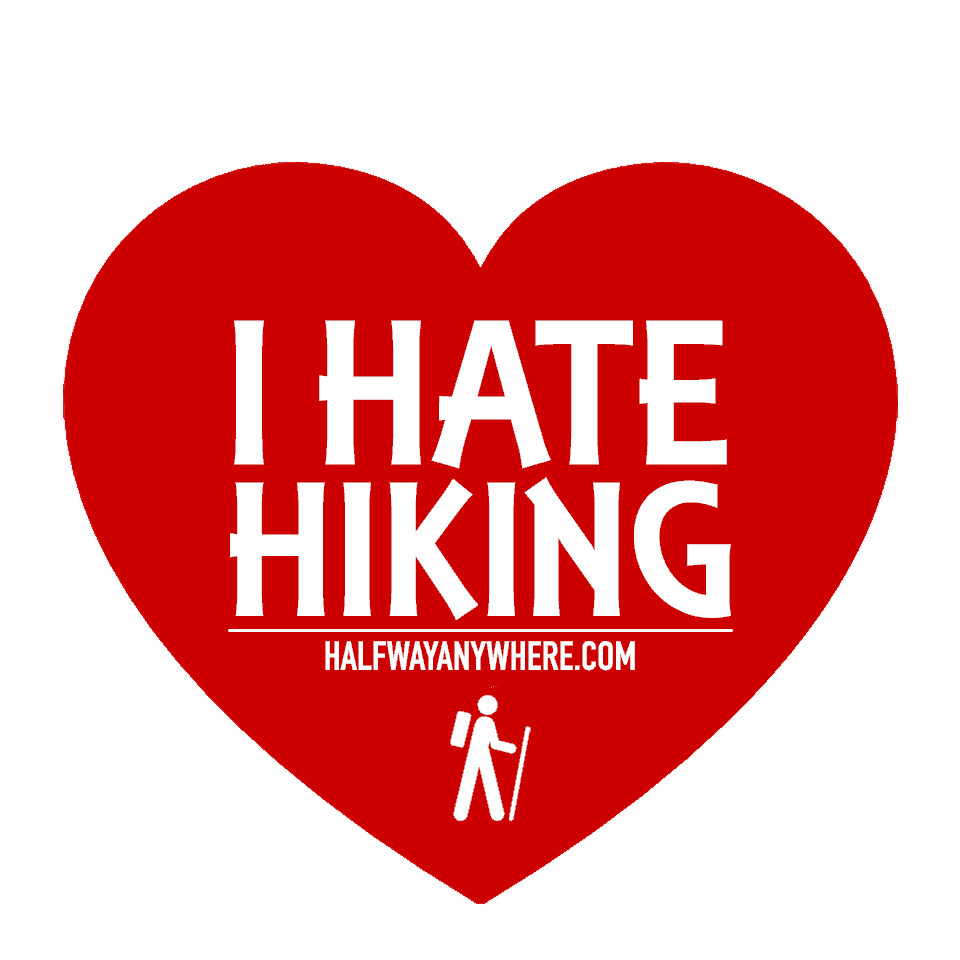

Annapurna Circuit Trekking
- 11 Breakfast
Accomodation
- 1 night twin sharing hotel accommodation in Pokhara
- 10 nights twin sharing tea house/lodge accommodation during the trek
Cost Details
5,416m/17,764ft
Optimal Season
February, March, April, May, September, October, November, December
Transporation
Daily activity.
5 - 6 hours Walking
Ask the Expert

Salbin Basnet
This is probably one of the world's most awe-inspiring treks, and since 1977 has been one of Nepal’s classics. A complete circuit of the Annapurna range.Our route takes you through a fascinating variety of landscapes and cultures, from the sub-tropical lower Marsyangdi Valley where Hindu (Gurung and Thakali) settlements dominate to the predominately Buddhist areas of the northern arid semi-desert Tibetan Plateau. The contrast could not be more dramatic or diverse.
Along the Marsyangdi Khola, on easy trails and suspension bridges, through rice terraces and forests, you will slowly gain altitude and acclimatize in preparation for the ascend towards the arid semi-desert with stunning and extremely up-close views of snowy and glaciated high peaks including Annapurnas II, III and IV. This remote area lies in a rain shadow formed by the Annapurnas and the landscape supports little in the way of forests apart from pine, juniper and scrub rhododendron. Thus, it is huge glacial moraines abound, etched deeply by wind erosion into fantastic pillars. The crossing of the Thorung La Pass at 5,416m is one of the highlights of this trek, where we are rewarded with breathtaking scenery.
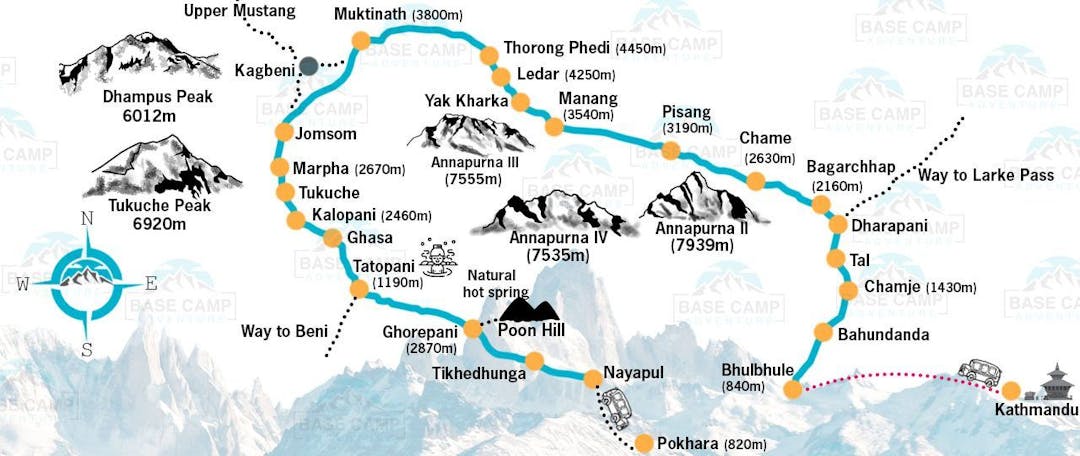
- Spectacular views of the numerous 7,000+m peaks of the complete Annapurna massif
- Crossing one of Nepal’s highest trekking passes, Thorung La Pass at 5,416m
- Soak up the main cultures of Nepal Hinduism and Buddhism, climbing through subtropical scenery to arid wilderness desert
- Spectacular aerial views of the Annapurna Range
- Things to Do
- Restaurants
- Vacation Rentals
- Travel Stories
- Rental Cars
- Add a Place
- Travel Forum
- Travelers' Choice
- Help Center
Annapurna circuit - Ethical Trekking Nepal
- Asia
- Nepal
- Western Region
- Gandaki Zone
- Pokhara
- Pokhara - Things to Do
- Ethical Trekking Nepal
Krishna and his team were fantastic! We had a party of 14 college students and his team did an... read more
Krishna offered us different options but we decided to do a half day trip and paragliding. We... read more
Annapurna circuit
I enjoyed the Annapurna circuit trek very much. This was my third trek with Ethical trekking and everything was taken care of in a professional way. Nothing prepares you for altitude, but my guide Nigma was always helping me with advice and encouragment. I look forward to my next trek with Ethical trekking. James
Krishna and his team were fantastic! We had a party of 14 college students and his team did an excellent job pointing out sites, answering our questions about the villages, farms, and Nepali customs. The dal bhat lunch was very tasty and plenty of food. Krishna also arranged for transportation back to Pokhara, as we were staying in Dhampus. Strongly recommended Ethical Trekking for any outdoor activities! Plus, Krishna is a great guy and fun to talk to!

Krishna offered us different options but we decided to do a half day trip and paragliding. We went to Sarangkot to look at the sunrise and walked up to Australien camp. Magnificent view! Our guide explained us a lot of things and showed us also a temple, the Tibetan refugee camp and two nice and typical Nepalese places to eat. Also the paragliding was fantastic. I was nervous but the „pilot“ explained it very well and was very indulgent with me! I’m so glad we booked at Krishna’s. He offered us Bothe for a reasonable price. I would do both again! Greetings from Germany 🙌🏼

Together with Yem (guide) and Keshap (porter) we did the Mardi Himal trekking. We started at Phedi, a lower point to get more of a challenge the first day, which was a perfect choice for us! They completely took care of us along the journey, including making desserts for us from fruits they brought. We walked further one day to go to a lodge with a hot shower. The view at Mardi Himal base camp was breathtaking. Tip; it’s fine to determine what route you want to do upon arrival. I emailed back and forth ultimately going for another route when talking in real life at the office.
it is without a doubt one of my best mountain hiking experiences, the organization by Ethical Trekking was really perfect and the guide Shambu was incredible. I recommend 100%

I had an amazing experience with Ethical Trekking. Krishna was helpful in planning the trip and Yam was our amazing guide. Yam was friendly, took amazing pictures and also felt like we made a friend in him as he showed us around Pokhara and motivated us to hike. The views we saw were breathtaking. I plan to go back this year and call Krishna to plan our next trip. Thank you for such a wonderful time.

Passing Thru Travel
The 10 Best Treks in Nepal’s Majestic Mountains 2024
Posted: February 21, 2024 | Last updated: February 21, 2024
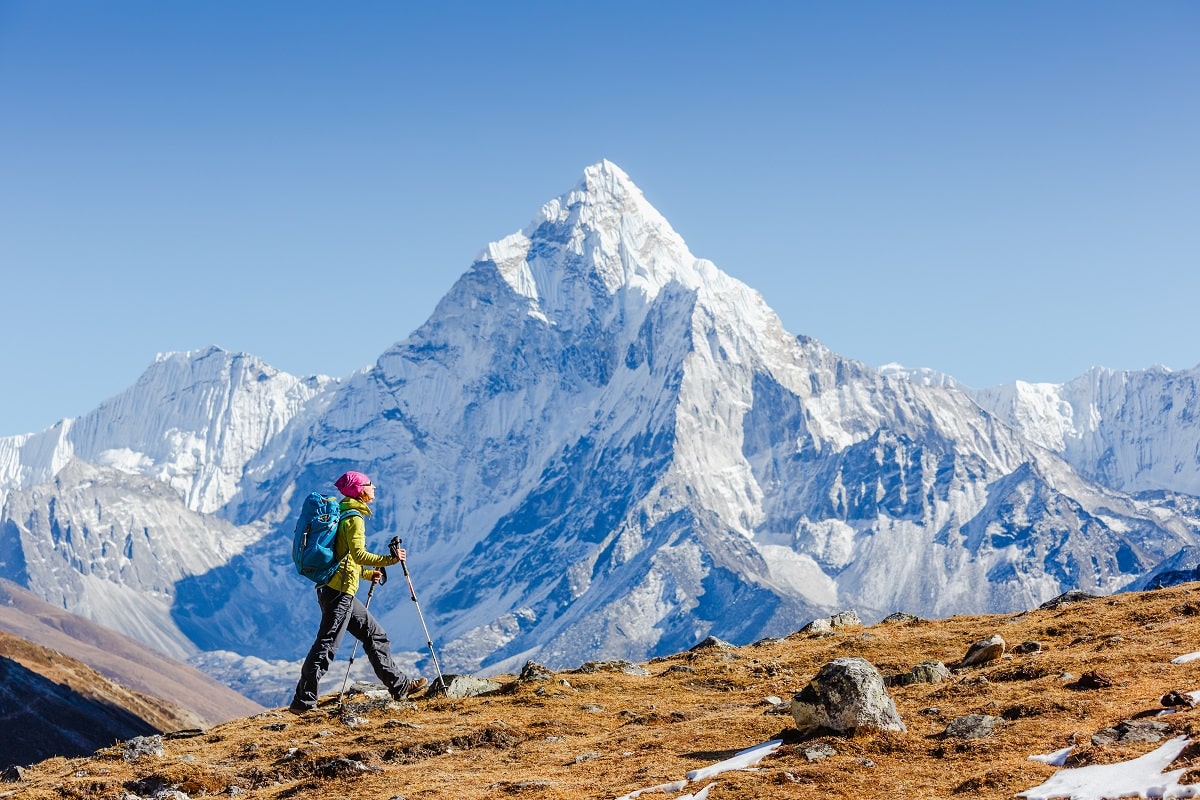
Nestled between the towering peaks of the Himalayas, Nepal is a land of unparalleled natural beauty and a haven for trekkers. From the iconic Everest Base Camp to the serene trails of the Annapurna region, Nepal’s mountains offer a diverse array of trekking experiences, each more awe-inspiring than the last. This guide will take you through 10 of Nepal’s most majestic mountain destinations, providing insights and practical advice for your trekking adventure.
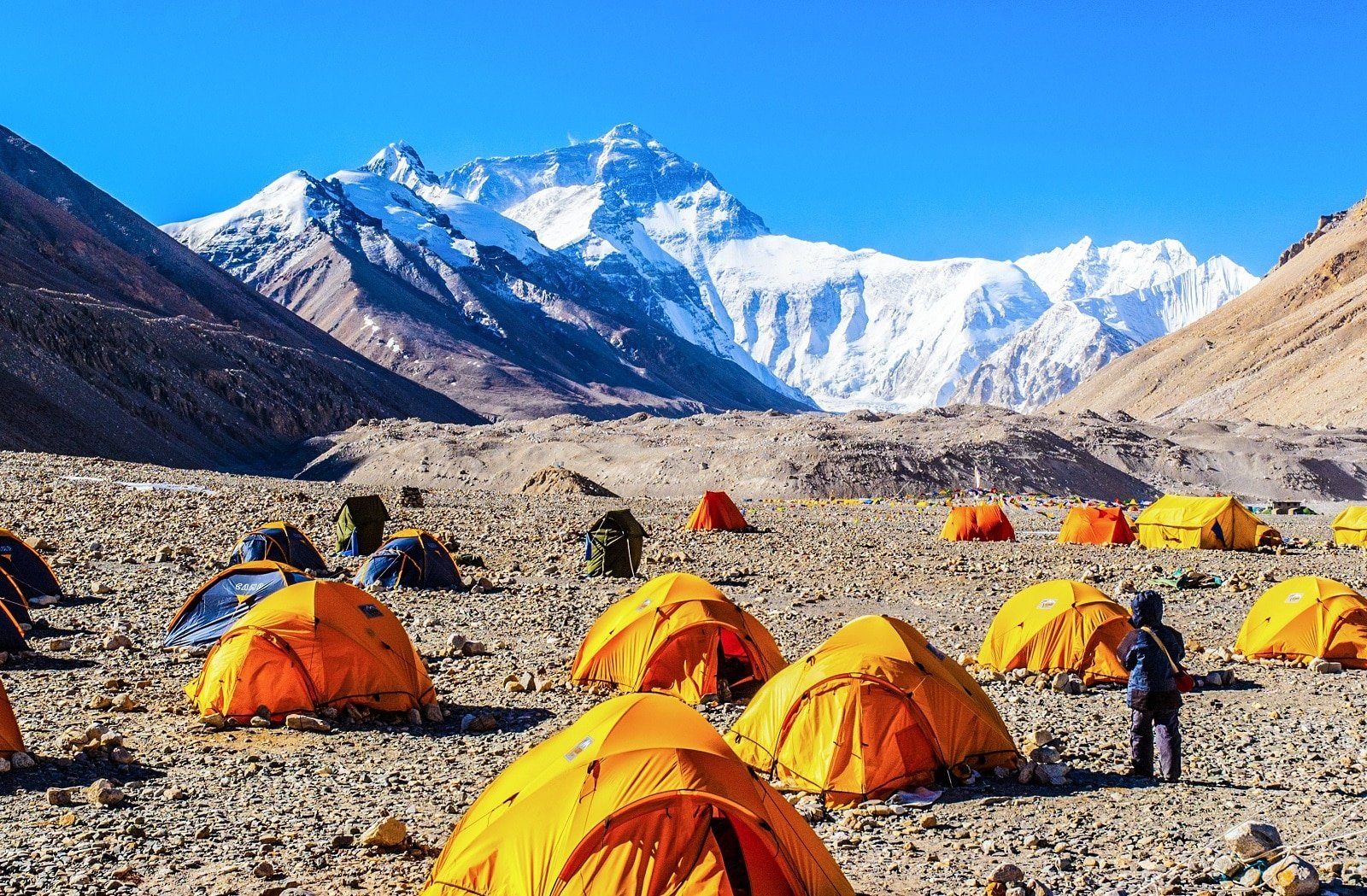
1. Everest Base Camp
Embarking on the Everest Base Camp trek, you’ll journey through the heart of the Himalayas, where the world’s highest peaks, including Everest, Lhotse, and Nuptse, tower above. Starting with a thrilling flight to Lukla, the trek takes you through traditional Sherpa villages, Buddhist monasteries, and along the Dudh Kosi River. The route is challenging yet rewarding, with acclimatization days in Namche Bazaar and Dingboche. The final ascent to Base Camp offers a stunning view of the Khumbu Icefall, making all the effort worthwhile.
Insider’s Tip: Acclimatize properly to avoid altitude sickness.
When To Travel: Pre-monsoon (March to May) or post-monsoon (September to November).
How To Get There: Fly to Lukla from Kathmandu and start your trek from there.
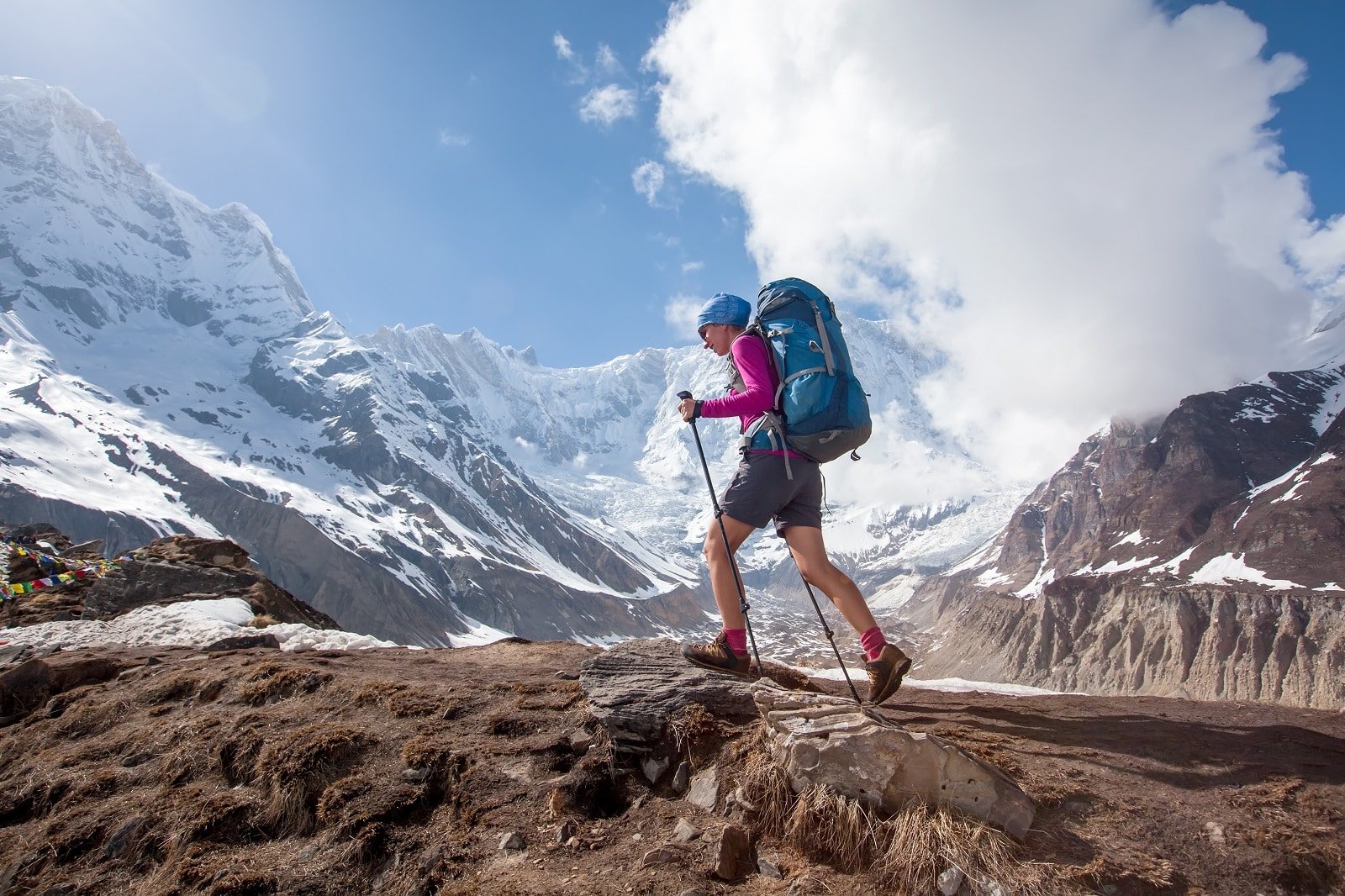
2. Annapurna Circuit
The Annapurna Circuit is a classic trek that takes you around the majestic Annapurna massif. This journey offers a remarkable diversity of landscapes, from the subtropical jungle of the Marshyangdi Valley to the arid, Tibetan-like terrain of the Upper Mustang. Crossing the Thorong La Pass, the trek’s highest point, is a challenging but exhilarating experience. The trek also allows for cultural immersion in the mountain communities of the Gurung and Manangi people.
Insider’s Tip: Take side trips to the ice lakes or Tilicho Lake for additional stunning views.
When To Travel: March to May and October to November for the best weather conditions.
How To Get There: The trek typically starts in Besisahar or Bhulbhule, accessible by road from Kathmandu or Pokhara.
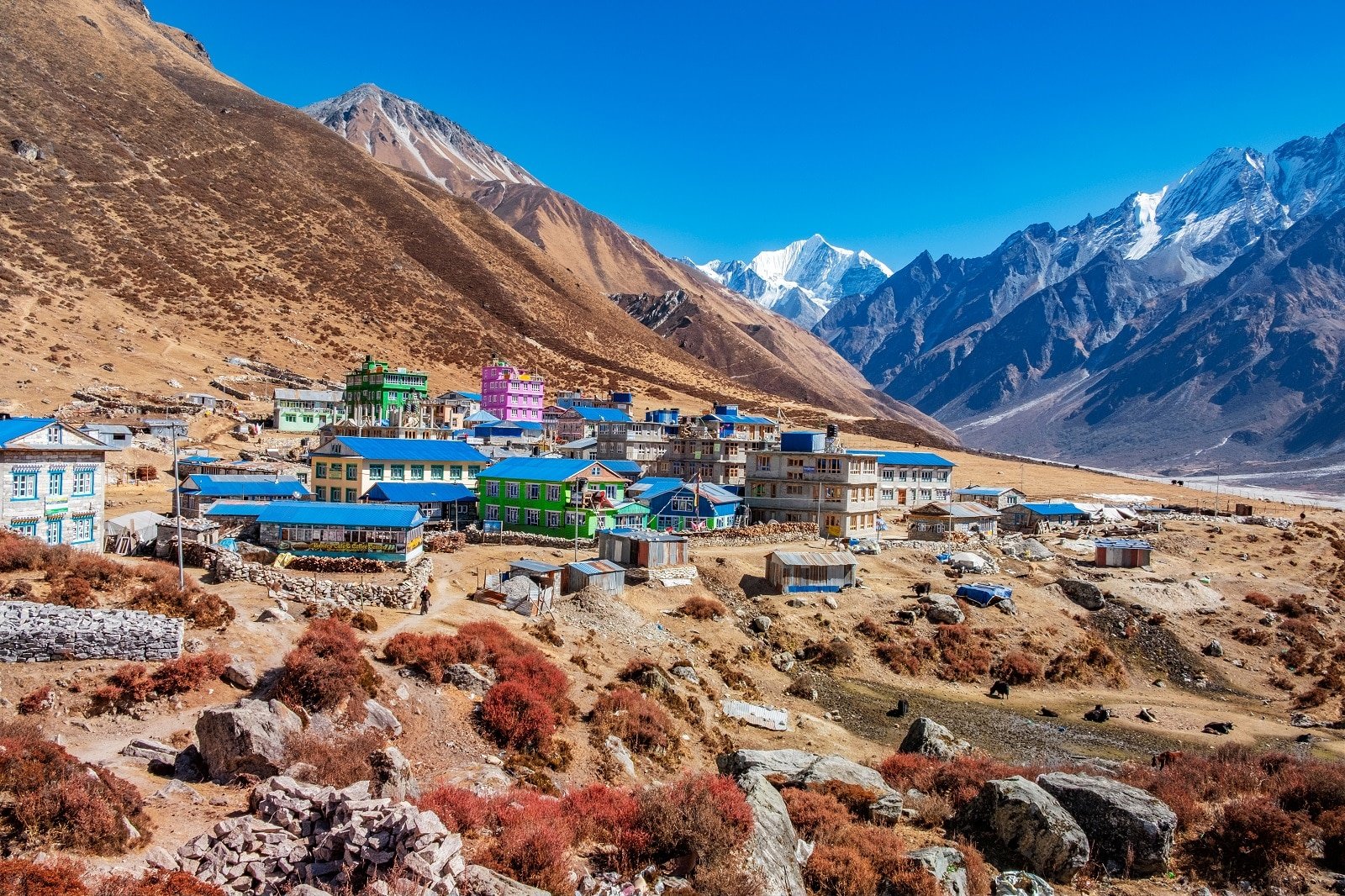
3. Langtang Valley
The Langtang Valley trek offers a quieter, more intimate Himalayan experience. It begins with a drive to Syabrubesi and a trek through forests, pastures, and traditional villages. The valley provides close-up views of Langtang Ri and Langtang Lirung. The trek also includes a visit to Kyanjin Gompa, a significant Buddhist monastery, and an optional climb to Tserko Ri for panoramic mountain vistas. This region was heavily affected by the 2015 earthquake, and trekking here supports local recovery efforts.
Insider’s Tip: Extend your trek to Gosaikunda Lake for a spiritual experience.
When To Travel: March to May and September to November for clear skies and pleasant temperatures.
How To Get There: Drive to Syabrubesi from Kathmandu, the starting point of the trek.
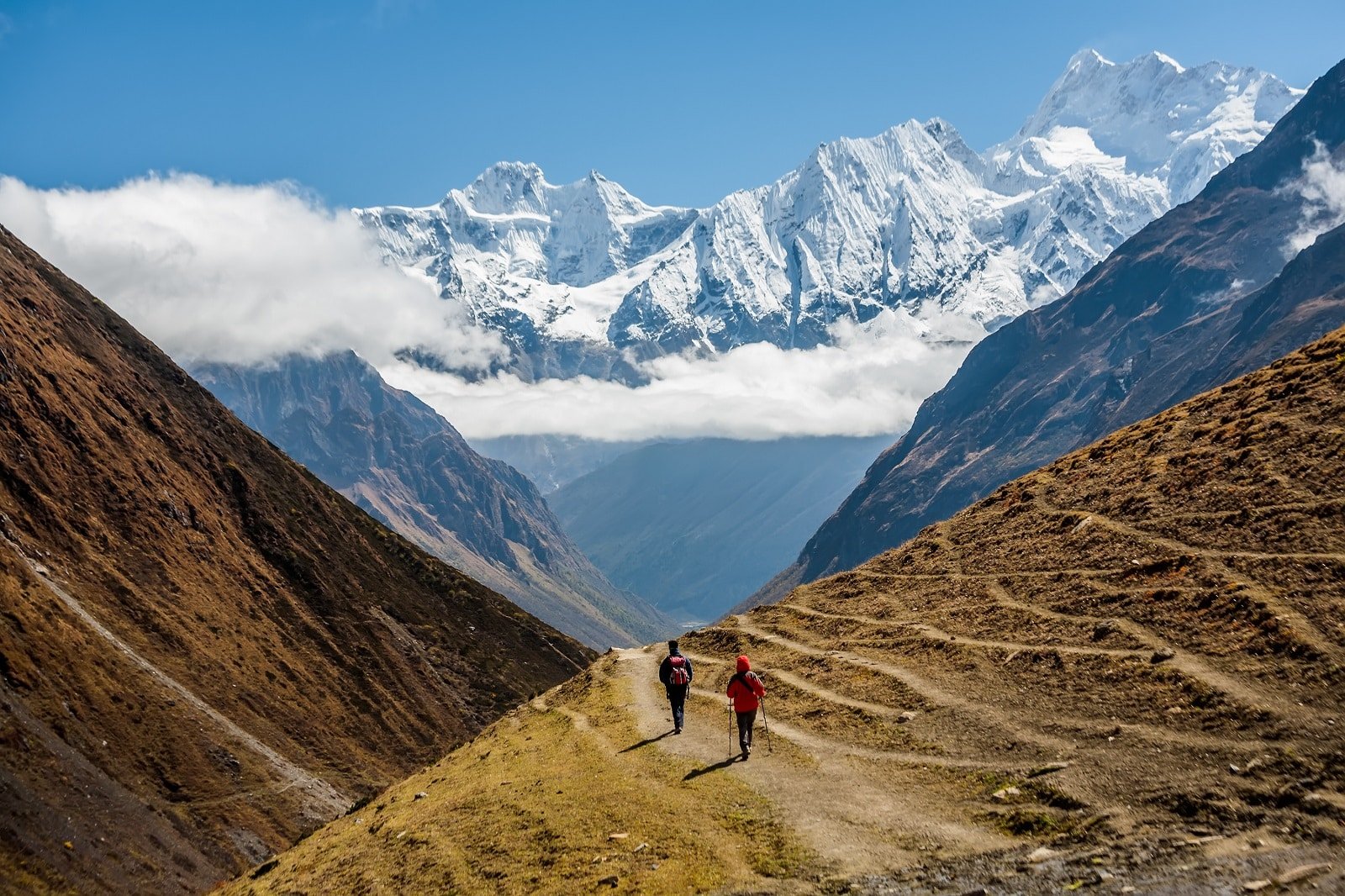
4. Manaslu Circuit
The Manaslu Circuit trek circles the majestic Manaslu, the world’s eighth-highest peak. This trek is less crowded than its more famous counterparts. It offers a look into the untouched natural beauty and culture of the Nepali Himalayas. The trek involves crossing the Larkya La Pass and traverses through Budhi Gandaki Valley, known for its mix of Hindu and Tibetan Buddhist villages. The circuit is a challenging trek, blending cultural richness and scenic splendor.
Insider’s Tip: Ensure you have a guide, as the Manaslu trek requires special permits.
When To Travel: March to May and September to November are ideal.
How To Get There: The trek starts at Arughat or Soti Khola, which can be reached by bus or jeep from Kathmandu.
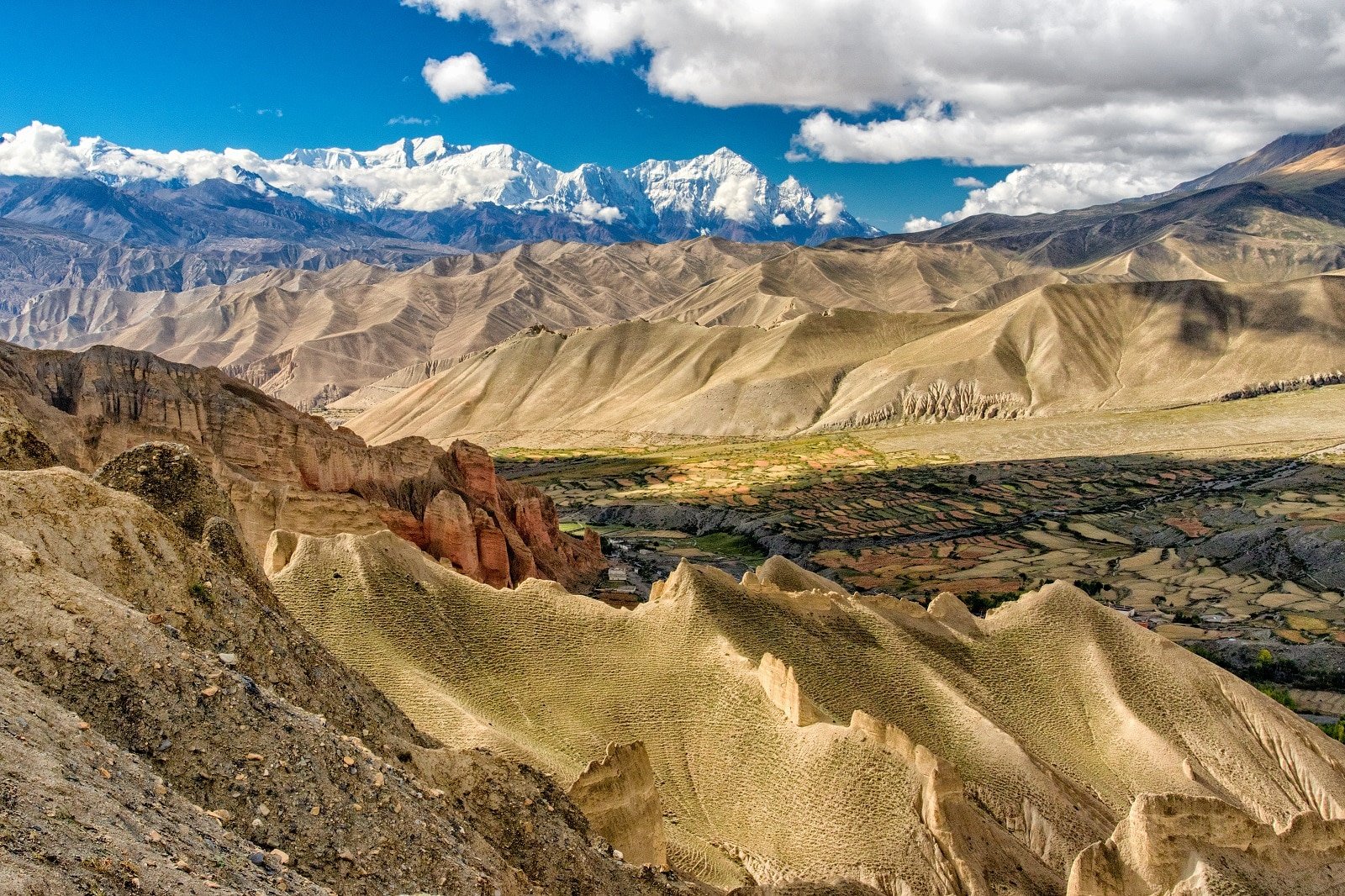
5. Upper Mustang
Trekking in Upper Mustang takes you to a region that was once an independent kingdom. The landscape here is more desert-like, characterized by eroded canyons and colorful stratified rock formations. Lo Manthang, the walled capital, is a highlight, with its monasteries and royal palace. This area is culturally and geographically more akin to Tibet, offering a unique trekking experience distinct from the rest of Nepal.
Insider’s Tip: Visit the ancient monasteries and the royal palace in Lo Manthang. Stay at the beautiful Shinta Mani Mustang.
When To Travel: May to October, as the region lies in the rain shadow area.
How To Get There: Fly or drive to Jomsom, then trek or drive to Lo Manthang.
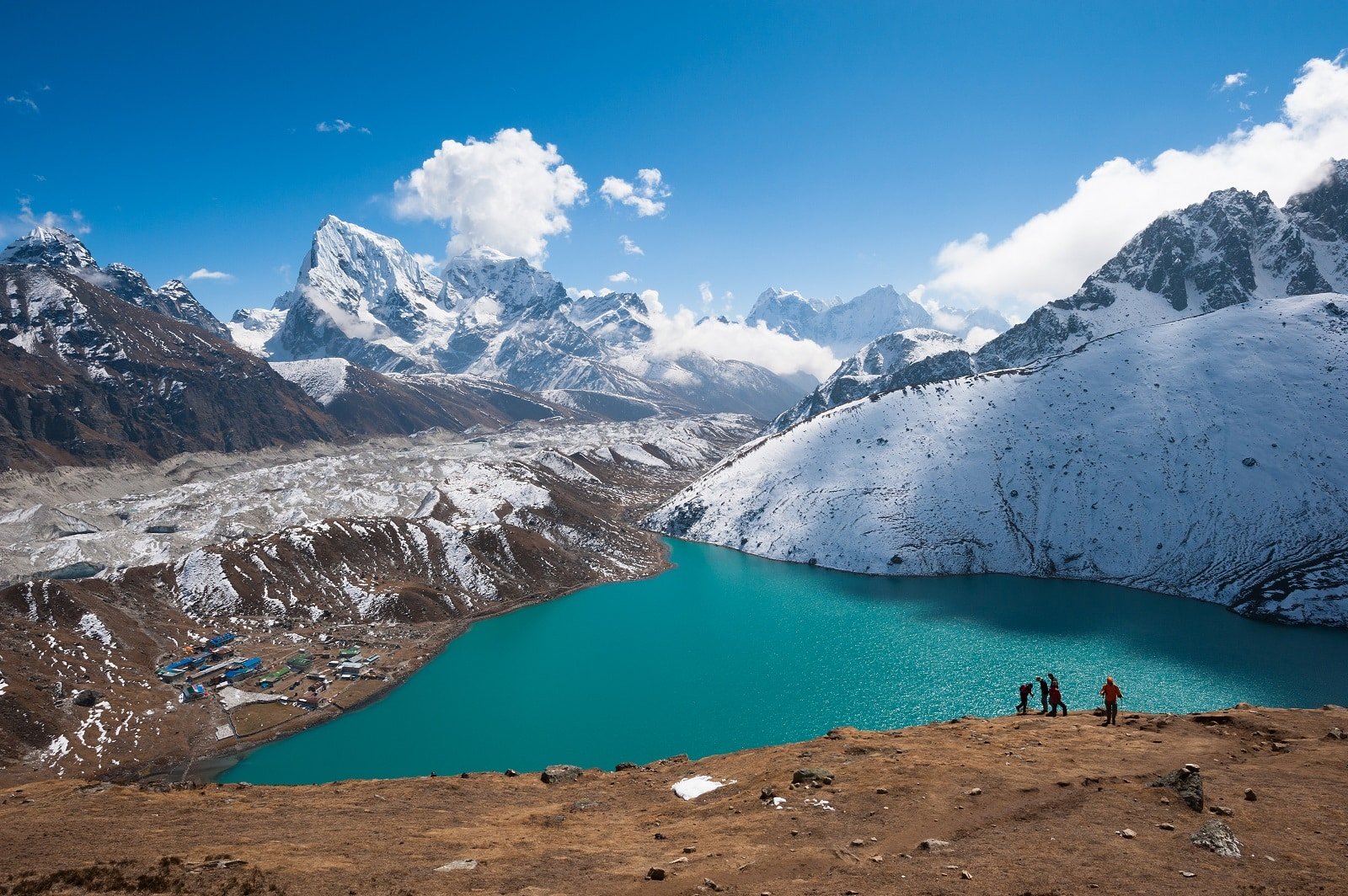
6. Gokyo Lakes
The Gokyo Lakes trek is a fantastic alternative to the Everest Base Camp trek, taking you to a series of stunning high-altitude lakes in the Gokyo Valley. The trek is less crowded and provides spectacular views of Everest and surrounding mountains. Climbing Gokyo Ri offers one of the best viewpoints in the Everest region. The trek passes through Sherpa villages, offering insight into the local culture.
Insider’s Tip: Trek during the full moon for spectacular night views of the mountains.
When To Travel: March to May and September to November for the best weather.
How To Get There: Similar to Everest Base Camp, fly to Lukla and follow a different trail.

7. Poon Hill
The Poon Hill trek is ideal for those looking for a shorter hike in the Annapurna region. It’s known for offering some of the most spectacular mountain views, especially at sunrise from Poon Hill itself. The trek passes through rhododendron forests and Gurung villages, giving you a chance to experience the culture of the central Himalayan region. The trek starts and ends in Nayapul, a short drive from Pokhara.
Insider’s Tip: Carry enough cash, as there are no ATMs on this route.
When To Travel: October to November and March to April for clear skies and good weather.
How To Get There: The trek starts from Nayapul, which is a short drive from Pokhara.
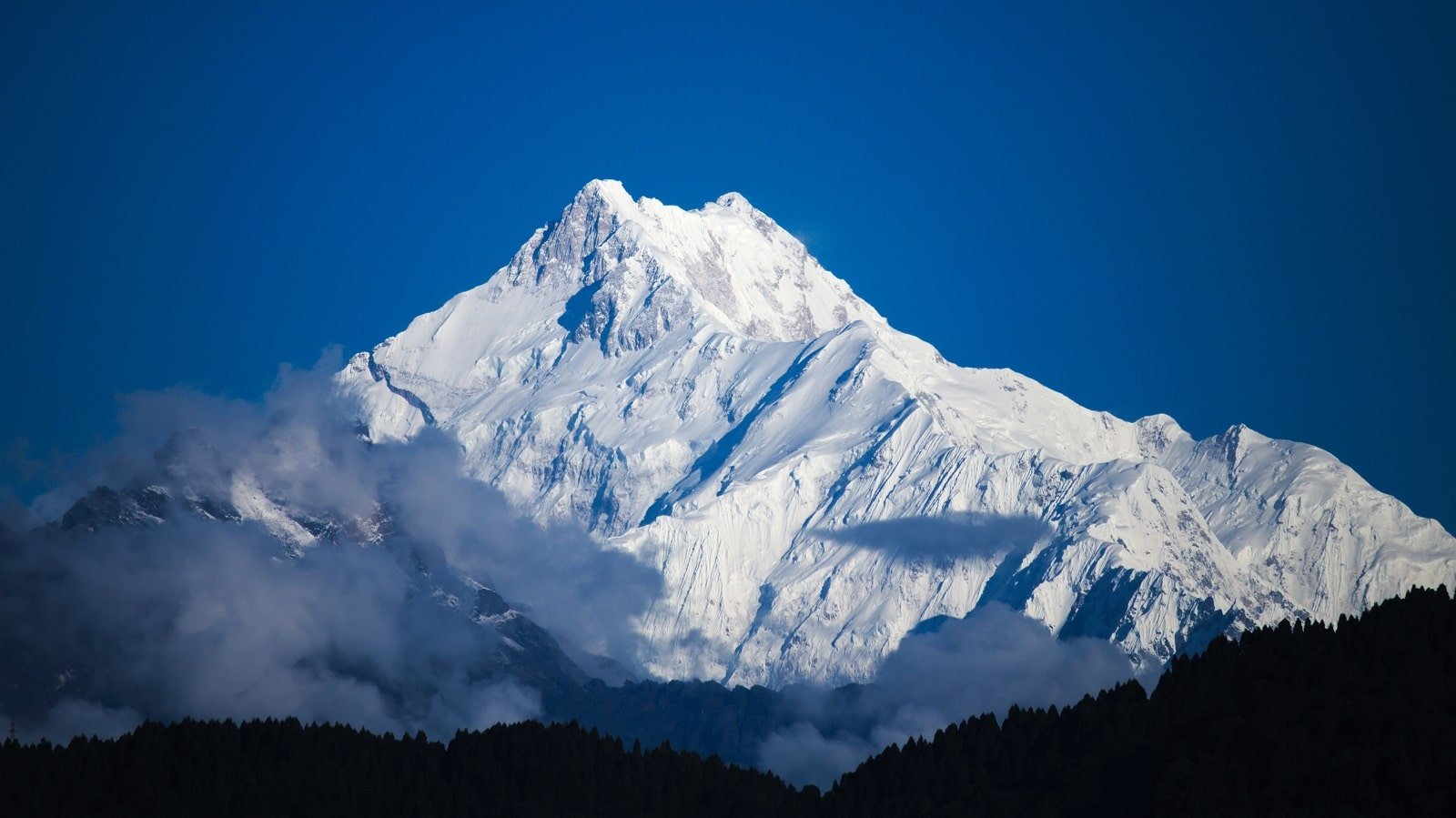
8. Kanchenjunga Base Camp
The Kanchenjunga Base Camp trek is a challenging and adventurous journey to the base of the world’s third-highest mountain. This remote trek offers stunning views of Kanchenjunga and a chance to experience pristine wilderness. The trek passes through diverse ecosystems, traditional villages, and high alpine terrain. It’s a trek for those seeking solitude and unspoiled nature.
Insider’s Tip: Be prepared for basic accommodations and facilities, as this is a less developed trekking route.
When To Travel: March to May and September to November for stable weather.
How To Get There: Fly or drive to Bhadrapur, then drive to Taplejung, the starting point of the trek.
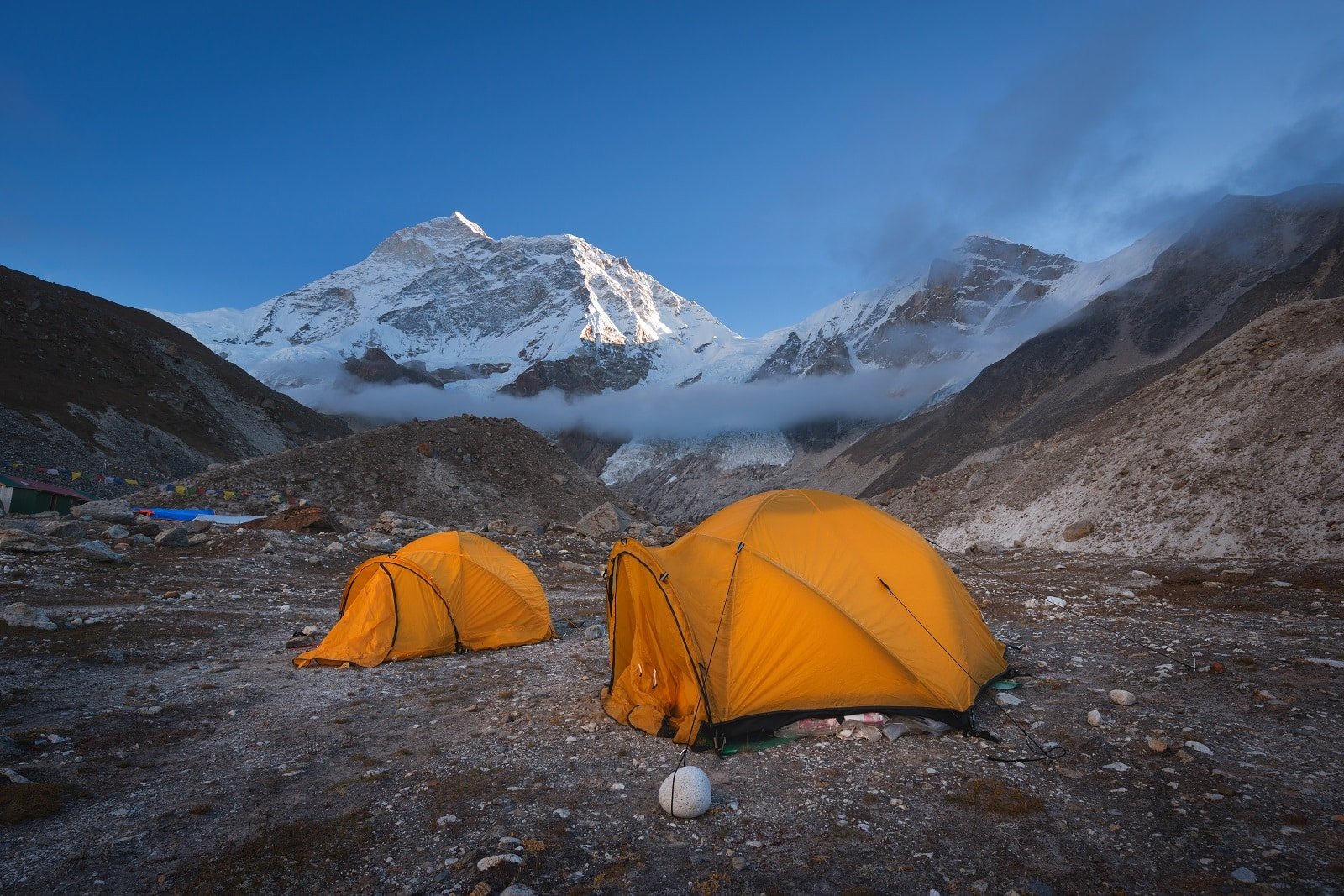
9. Makalu Base Camp
The Makalu Base Camp trek is a challenging journey to the base of Mount Makalu, the world’s fifth-highest mountain. This trek takes you through some of Nepal’s most remote and wild areas, offering stunning views of the eastern Himalayas. The Makalu Barun National Park, through which the trek passes, is a biodiversity hotspot with a rich variety of flora and fauna.
Insider’s Tip: Be physically and mentally prepared for a challenging trek with basic facilities.
When To Trave: Pre-monsoon and post-monsoon periods for the best conditions.
How To Get There: Fly to Tumlingtar from Kathmandu, then drive to Num, the starting point of the trek.
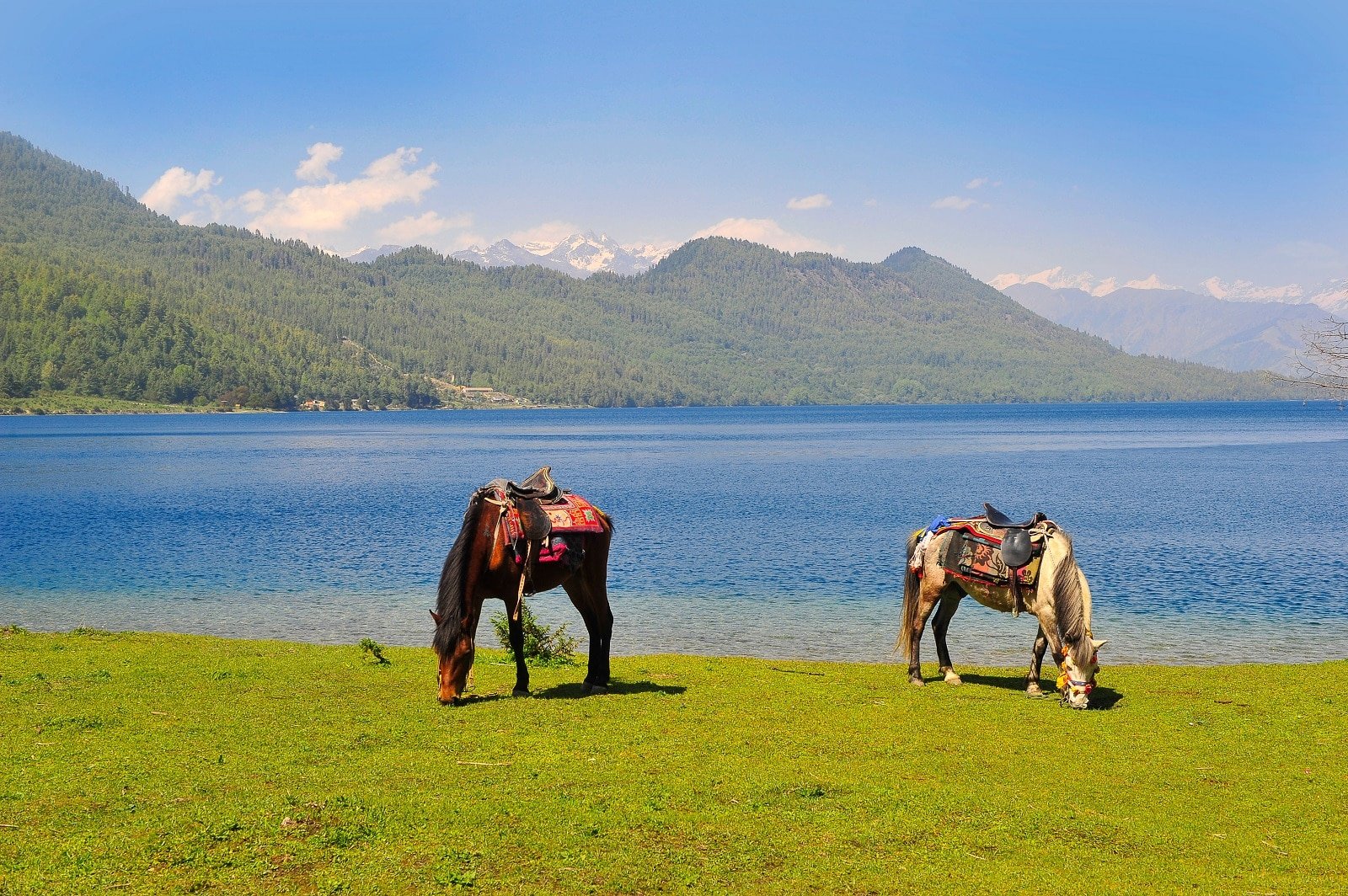
10. Rara Lake
Trekking to Rara Lake offers a serene experience away from the more popular trekking routes. Rara, the largest lake in Nepal, is known for its clear blue waters and scenic beauty. The trek to the lake is an adventure in itself, passing through remote Jumla and Mugu districts. The area around the lake, Rara National Park, is home to a variety of wildlife and offers tranquility unmatched in other parts of Nepal.
Insider’s Tip: Visit the nearby Rara National Park for a chance to see unique wildlife.
When To Travel: September to October and April to May for the best trekking conditions.
How To Get There: Fly to Nepalgunj from Kathmandu, then to Jumla, from where the trek to Rara Lake starts.
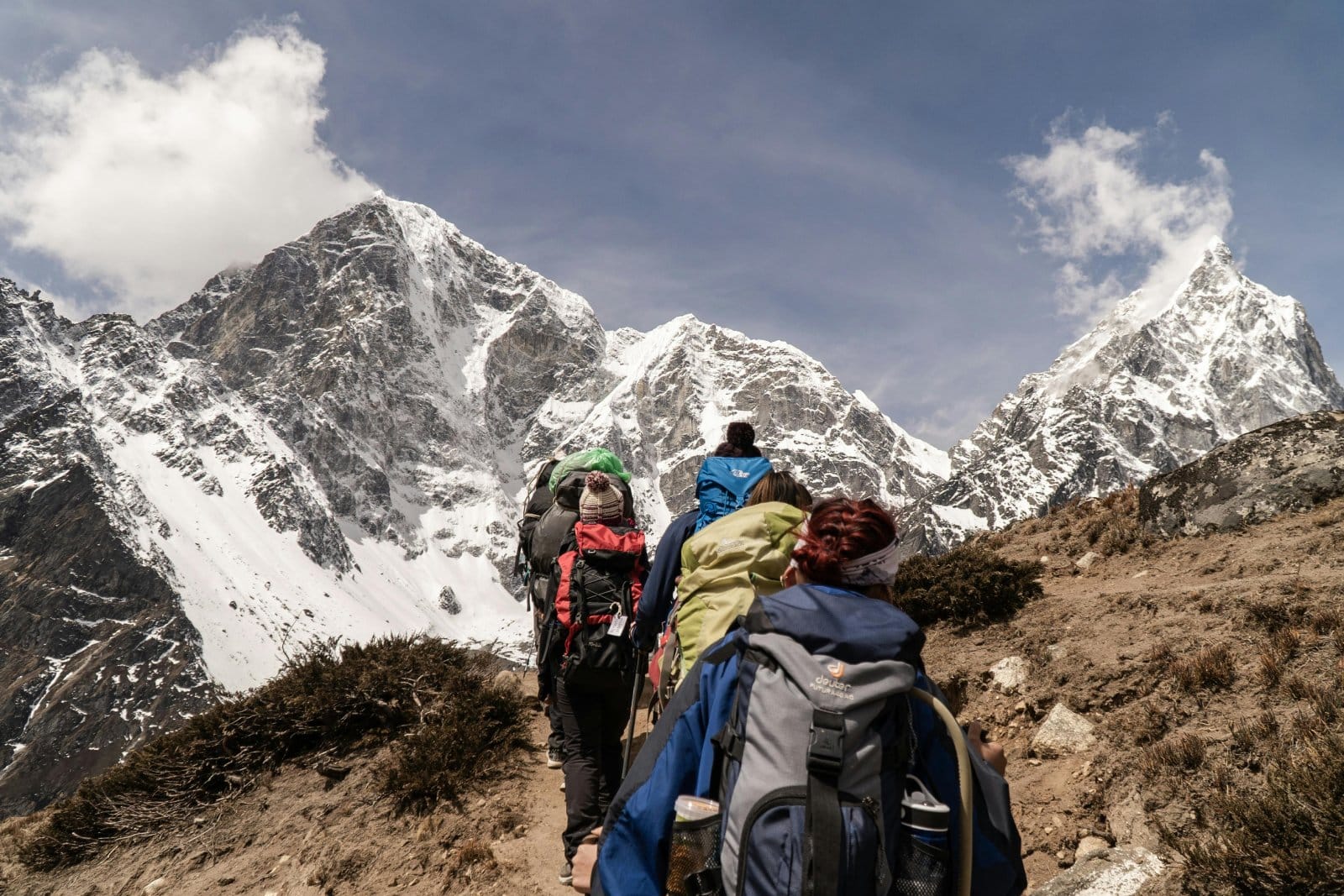
The Bottom Line
Trekking in Nepal is more than a physical journey; it explores some of the most majestic landscapes on Earth. Each destination offers its unique charm, from the world-renowned Everest Base Camp to the tranquil trails of Rara Lake. As you trek through these mountains, you’ll not only witness breathtaking vistas but also immerse yourself in the rich culture and hospitality of the Nepali people. Pack your bags, lace up your boots, and prepare for an adventure that will leave you with memories to last a lifetime.
More Articles Like This…
Barcelona: Discover the Top 10 Beach Clubs
2024 Global City Travel Guide – Your Passport to the World’s Top Destination Cities
Exploring Khao Yai 2024 – A Hidden Gem of Thailand
The post The 10 Best Treks in Nepal’s Majestic Mountains 2024 was republished on Passing Thru with permission from The Green Voyage .
Featured Image Credit: Shutterstock / Olga Danylenko.
For transparency, this content was partly developed with AI assistance and carefully curated by an experienced editor to be informative and ensure accuracy.
More for You
US Ally Spots Chinese Ship Armed With 'Autocannon'
Therapists Say These 6 Common Habits Are Fueling Your Anxiety
Here’s How Long You Should Walk Every Day to Keep Your Heart Healthy
Certain old $2 bills are worth thousands of dollars
Inside the plans for Titanic II – and what it’s going to look like
'Miracle' weight-loss drugs could have reduced health disparities. Instead they got worse
Explorer Reveals Ernest Shackleton's Perfectly Preserved 116 Year Old Hut In The Antarctic
I moved from California to Tennessee for my husband's job. We can finally save money, but it's been a major culture shock.
John Oliver Laughs at 'Cluelessness' of CNN Host Pointing Out 1860s Were Bad for Women - to a Black Man
Your Blood Type Affects Your Risk of Early Stroke, Scientists Discover
I did 30 lateral raises every day for 2 weeks — here's the results
Look: Turkish series 'Thank You, Next' coming to Netflix in May
Anheuser-Busch has ‘learned their lesson’: Former exec Anson Frericks
No, frequent hair trims won't make your hair grow faster. But here's what does.
This Small South Carolina Island Has 10 Miles of Pristine Beaches and One of the Best Resorts in the State
The health condition many women are getting diagnosed with after COVID
I Lost 100lbs by Following 4 Rules
First major wildfire of 2024 raging near popular tourist destination
Verizon $100M class-action settlement: How to submit your claim
Pushups are an efficient, full-body exercise — but don't make this 1 mistake

IMAGES
VIDEO
COMMENTS
Day 18: Trek from Tadapani (2,710 meters) to Naya Pul (1,070 meters) via Gandruk and then catch a short bus ride back to Pokhara. Please Note: From Muktinath onwards the classic Annapurna Circuit has been severely impacted by the road that joins Jomsom to Muktinath.
The Annapurna Circuit trek was once the most popular tea house trek in Nepal. In about a month it was possible to walk around the Annapurna mountain peaks. This trek was famous for its ethnic villages, natural beauty and easy access from Kathmandu or Pokhara. But the Annapurna Circuit trek has changed tremendously in recent years.
The Annapurna Circuit is a trek within the mountain ranges of central Nepal. The total length of the route varies between 160-230 km (100-145 mi), depending on where motor transportation is used and where the trek is ended. This trek crosses two different river valleys and encircles the Annapurna Massif. The path reaches its highest point at ...
Annapurna Circuit Trek is a popular classic trek of Nepal. Each year, more than 60,000 trekkers come for this trek from all around the globe. In this trek, you encircle the Annapurna massif and cover between 110-130 miles by walking.
It's one of the world's classic long-distance hiking trails, and still one of Nepal's most popular treks. The Annapurna Circuit, a 12 to 21-day route that begins in the lush green villages of the Himalayan foothills.Taking trekkers over the 5,416m Thorong La Pass and down to the Tibetan-influenced temples and communities of the Mustang Valley.
The Annapurna Circuit and Beyond: Ultimate Guide to Hiking in Nepal (2024) Until 1951, Nepal was off-limits for foreign travellers; a secretive, isolated kingdom kept under wraps from outsiders…. But a change of regime gave birth to a new era of travel, and Nepal has remained a magnet for intrepid adventurers for over 70 years.
The Annapurna Circuit Trek is undoubtedly one of the most extraordinary and unparalleled experiences a trekker can avail themselves of. With an extensive length of 160-230 km that covers four distinct districts, comprising Lamjung, Myagdi, Manang, and Mustang, this trekking route stands out as the most preferred circuit through the diverse natural vegetation, cultural beliefs, landscape ...
An important 2023 update for the Annapurna Circuit trek. According to the new regulations that will take place on the 1st of April 2023, it's compulsory for all international trekkers to have a licensed guide for hiking most routes in Nepal including the Annapurna Circuit. The change was made just a couple of weeks before the start of the season.
What Is the Annapurna Circuit? Located in central Nepal, the Annapurna Circuit is a long-distance trekking route that begins in the town of Besisahar and ends in Birethanti, encircling much of the Annapurna Massif along the way. The trail's namesake mountain is amongst the tallest in the world, standing some 8091 meters (26,545 ft) in height.
Trek through the incredible Annapurna region and be awed by the Nepalese Himalayas. These snow-capped peaks, mist-shrouded valleys, isolated communities and remote monasteries will inspire those with a bold spirit and a yearning for a definitive nature experience. Reach altitudes of more than 5000 metres, discover the ancestral traditions of ...
Days required: 10-13 days. Total Incline: 8000 meters. Total Decline: 7000 meters. The highest point on the trek: The two highest points on the trek are Tilicho Lake (4,919m) and the Thorong La Pass (5,416m). Difficulty: The difficulty of the Annapurna Circuit Trek depends a lot on how many days you have.
Annapurna Circuit Trek. For scenery and cultural diversity, this has long been considered the best trek in Nepal and one of the world's classic walks. It follows the Marsyangdi Valley to the north of the main Himalayan range and crosses a 5416m pass to descend into the dramatic desert-like, Tibetan-style scenery of the upper Kali Gandaki Valley.
Annapurna circuit trek or Annapurna circuit hike generally starts at Ngadi Bazaar. Nowadays there is a road so you can shorten your itinerary up to 10 days which is very minimum. As long as the trek moves on you will enjoy the spectacular view of the Mt Manaslu Range and Mt Manaslu 8,153 M (from Dharapani to Chame).
Since the trail opened in 1977, most trekkers have followed an Annapurna Circuit itinerary that begins in Besishahar and heads in an anti-clockwise direction over the Thorong-La Pass and down into the Jomsom Valley. The main reason for this is acclimatisation. When following the trail anti-clockwise, you have almost 2 whole weeks of ...
The Annapurna Circuit Trek is the most famous trekking circuit in Nepal. With some of the tallest mountains on Earth, tumbling glaciers and an incredible variety of landscapes, this trek represents everything what trekking in Nepal is about. It takes more than two weeks to circumnavigate the Annapurna Massif while staying in cozy tea houses.
The view of the Annapurna Mountain Range from Upper Pisang, Annapurna Circuit Trek Day 5 Manang to the Ice Lakes (4,650 m) and Back. Manang was my last stop in the Annapurna Circuit Trek because even though I wanted to visit Tilcho Lake and conquer the Thorung-La Pass I was short on time and I didn't acclimatize properly in my rush to see the best Annapurna viewpoints with my limited time.
J oin The Explorer's Passage for one of the most extraordinary treks on the planet: the Annapurna Circuit. Stay at local tea houses as you follow this ancient Himalayan trade route, climbing through jungle-like terrain and rice fields, past canyons and waterfalls, and trekking among snowy peaks at Thorung La pass (17,768 feet / 5,415 meters ...
The route of the Annapurna Circuit Trek involves crossing Thorong La Pass at 5,416m/17,770ft which is a great challenge and will provide rewarding memories that will last forever. Overview of Annapurna Circuit Trek. We embark on Annapurna Circuit Trek after you enjoy some sightseeing around the culturally rich Kathmandu valley. Initially, we ...
The Annapurna Circuit is a pilgrimage along the sacred trails of the Nepali people. Overflowing with history, its remote villages and monasteries display the religious and cultural intertwining of Hinduism and Buddhism. Life has remained almost unchanged here for centuries. At around 18,000 feet, you'll reach the pinnacle of the trek—the ...
Trek on the exhilarating Annapurna circuit trail, reach Thorong La pass and cross the world's deepest Kali Gandaki gorge. Embark on the fantastic Annapurna Circuit Trek with our hand-picked itinerary that takes you around the entire Annapurna massif reaching the zenith at Thorong La Pass (5,416m/17,769ft). We will walk on the Annapurna circuit ...
Annapurna Circuit trek in central Nepal climbs to an altitude of 5,400m through Thorung La pass, one of the highest trekking passes in the world, below peaks...
The Annapurna Circuit is one of Nepal's best-known and most-traveled treks. That said, it can be difficult to know what to expect on the circuit if you've never been to Nepal before - especially when a lot of information out there is coming from trekking companies who simply want to sell you things. I've put together a collection of ...
This is probably one of the world's most awe-inspiring treks, and since 1977 has been one of Nepal's classics. A complete circuit of the Annapurna range.Our route takes you through a fascinating variety of landscapes and cultures, from the sub-tropical lower Marsyangdi Valley where Hindu (Gurung and Thakali) settlements dominate to the predominately Buddhist areas of the northern arid semi ...
Ethical Trekking Nepal: Annapurna circuit - See 708 traveler reviews, 1,611 candid photos, and great deals for Pokhara, Nepal, at Tripadvisor.
The Annapurna Circuit is a classic trek that takes you around the majestic Annapurna massif. This journey offers a remarkable diversity of landscapes, from the subtropical jungle of the ...
If you are doing Annapurna Circuit Trek, it takes you through 5416m Thorong Pass. The preferrable option if you are looking for more variation would be to do the Annapurna Circuit that takes around 12-16 days depending upon the itinerary and side trips to Tilicho Lake (4916m) from Manang. Please ensure you start atleast from Jagat.
6 likes, 1 comments - nepal_mountain_trek_guideApril 14, 2024 on : "The Annapurna Circuit Trek is a popular trek famous for deep gorges, high mountain passes (Thorong La Pass), fantastic viewpoints, and ho ...
Nar Phu Trek. is one of the iconic treks of Know more about the trekking cost, trek route, ABC trek itinerary and relevant trek. Nar Phu Valley Trek Nar Phu Valley With Annapurna Circuit. Remote trek to Nar Phu and Annapurna Region. Nar Phu Valley Trekking with Annapurna circuit. Nar Phu Valley Trek Nar Phu Valley With Annapurna Circuit, 60% OFF.